The document describes a textbook on mathematical modeling that covers modeling with all types of differential equations, including ordinary, partial, delay, and stochastic equations. It is a comprehensive textbook that addresses modeling techniques used in analysis. It incorporates MATLAB and Mathematica and includes examples and exercises that can be used for projects. The book is intended for engineers, scientists, and others who use modeling of discrete and continuous systems.
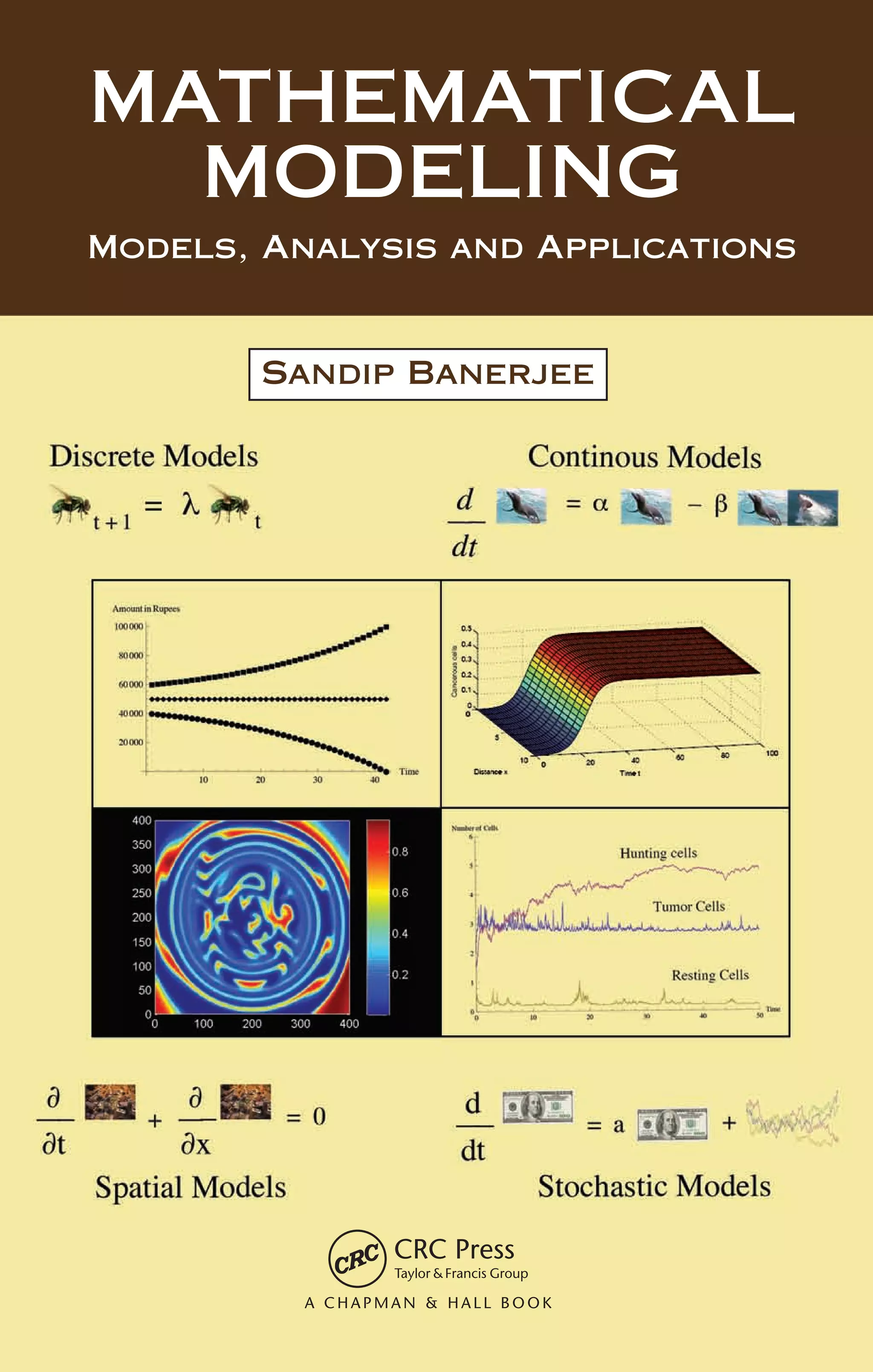
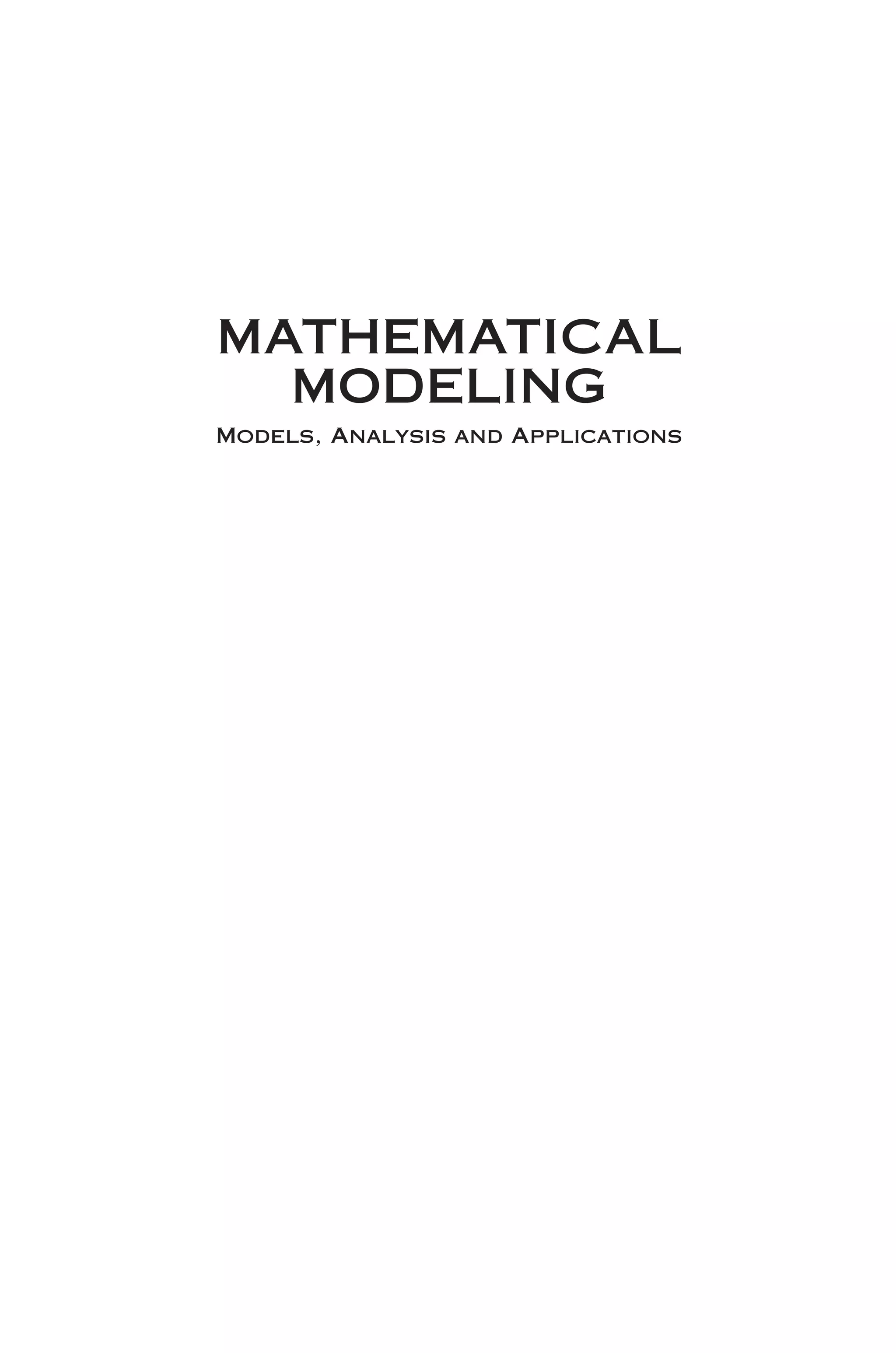

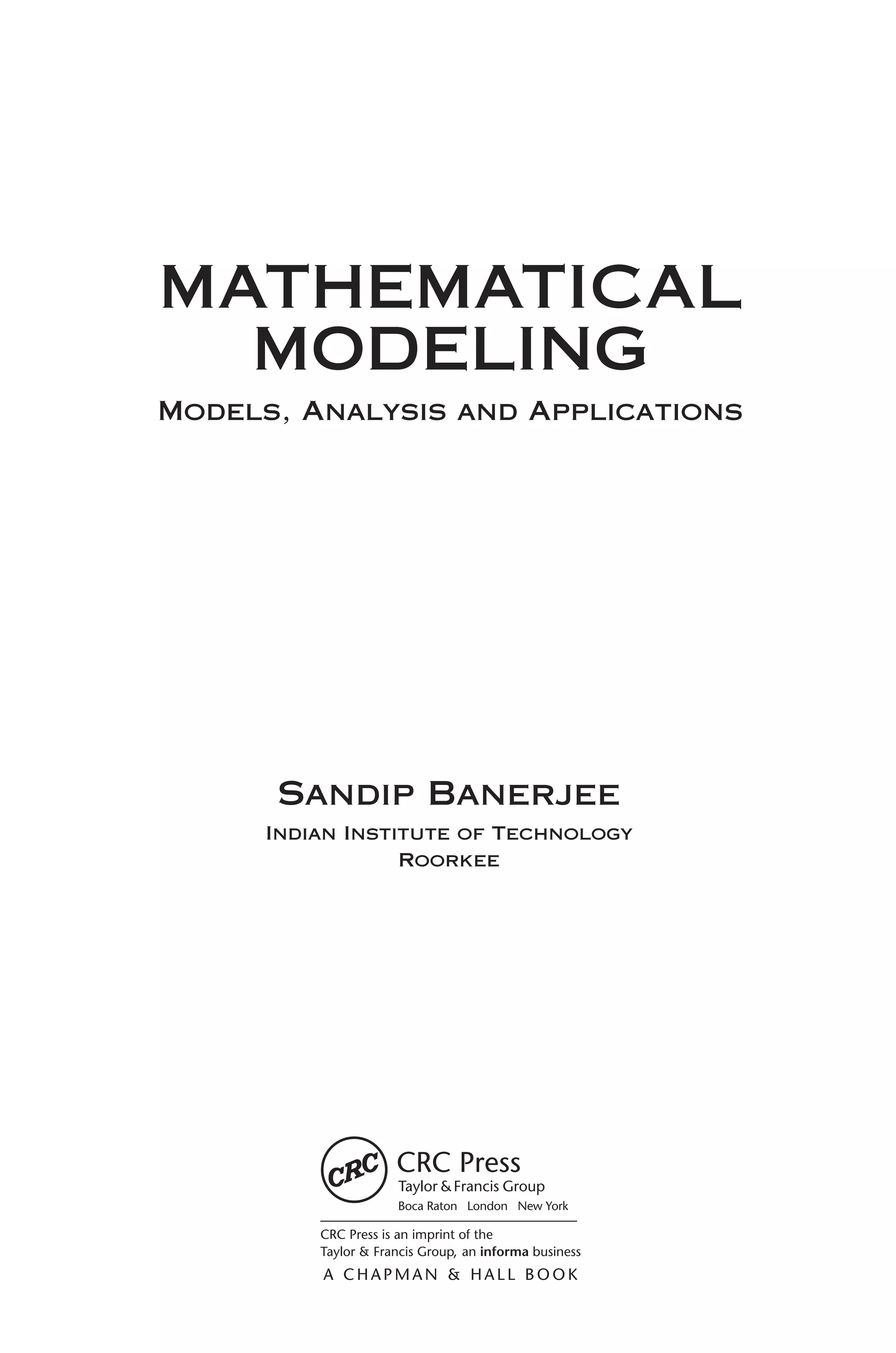
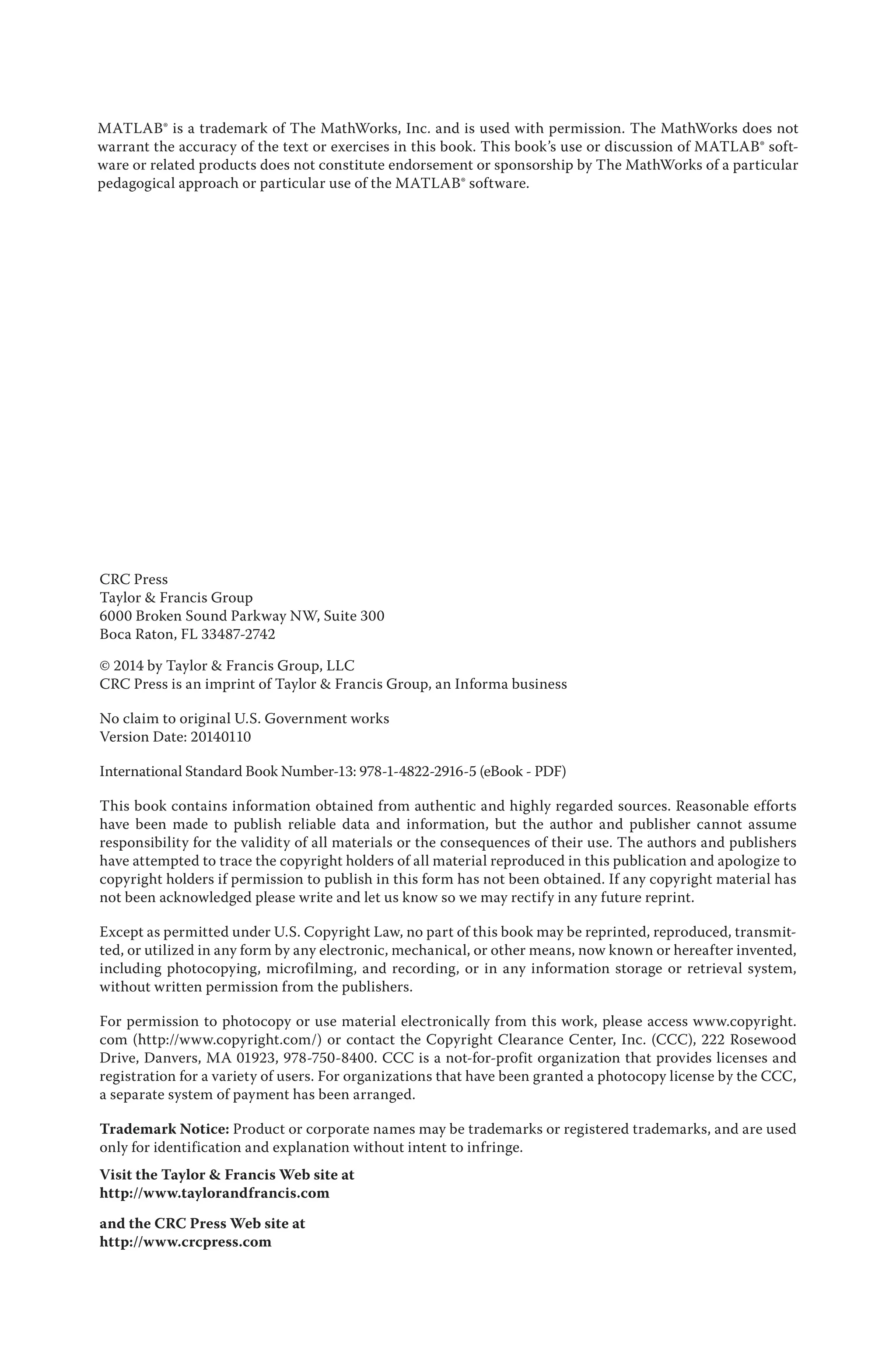


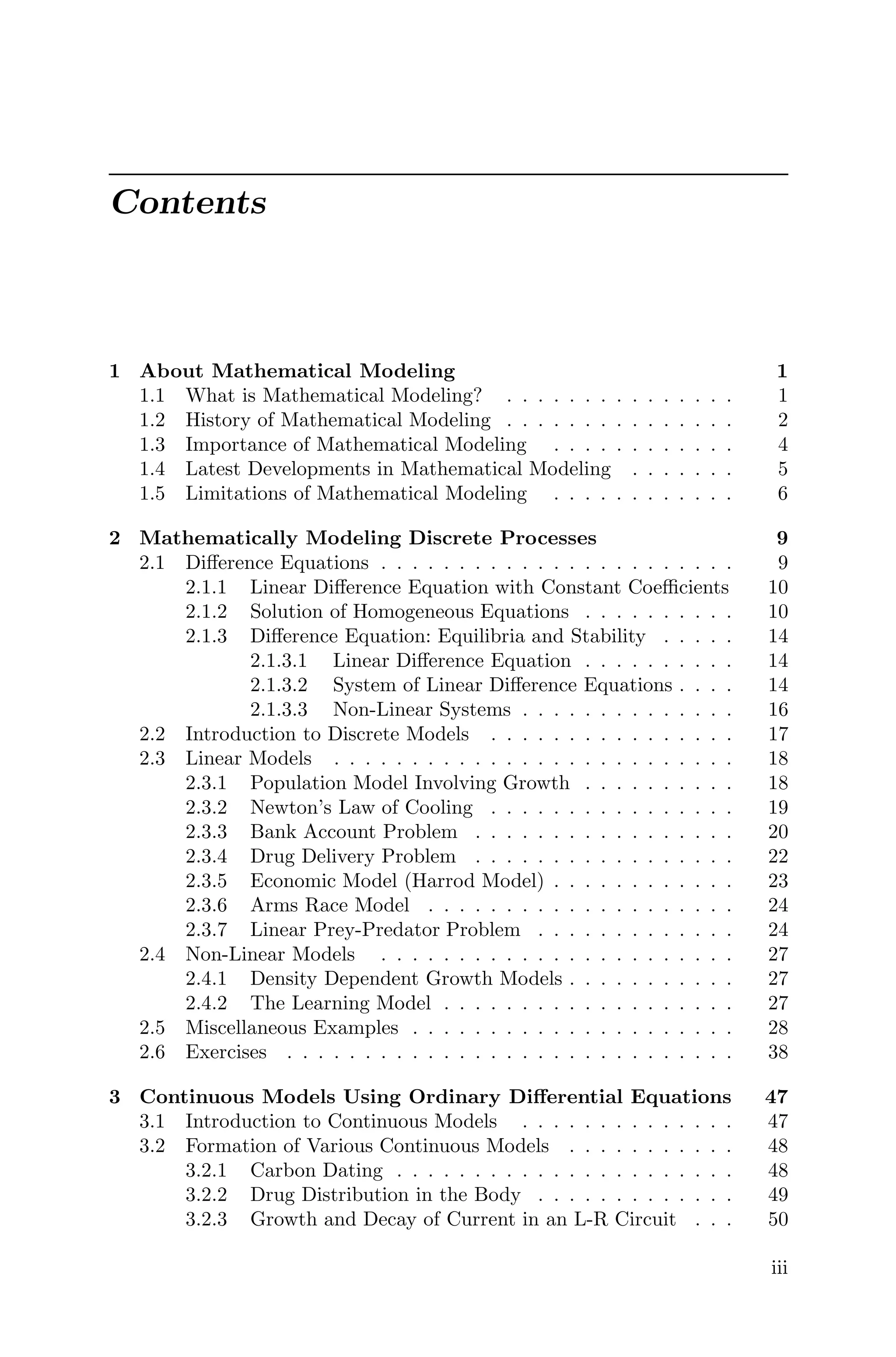
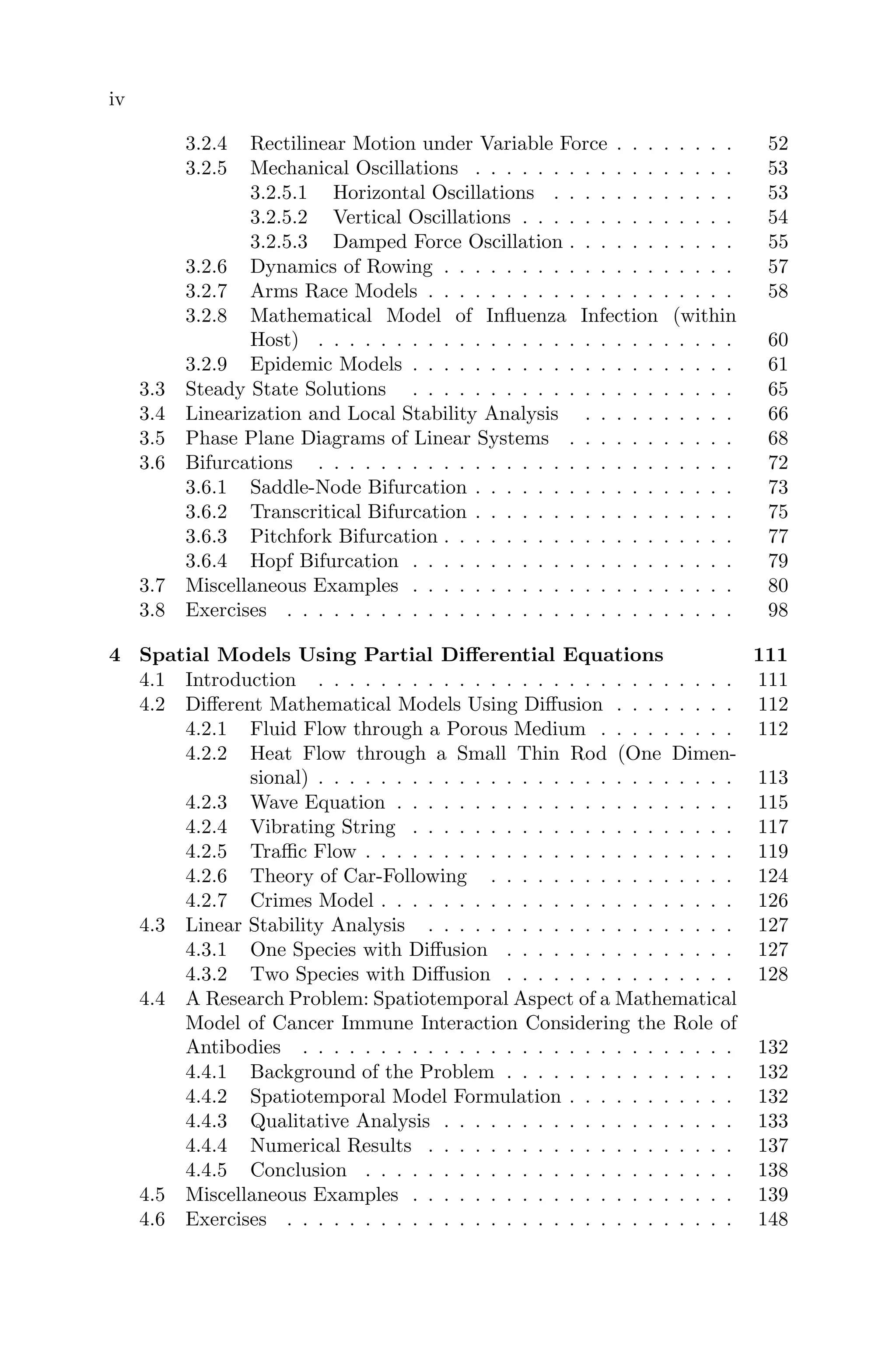
![v
5 Modeling with Delay Differential Equations 153
5.1 Introduction . . . . . . . . . . . . . . . . . . . . . . . . . . . 153
5.2 Different Models Using Delay Differential Equations . . . . . 154
5.2.1 Delayed Protein Degradation . . . . . . . . . . . . . . 154
5.2.2 Football Team Performance Model . . . . . . . . . . . 155
5.2.3 Breathing Model . . . . . . . . . . . . . . . . . . . . . 156
5.2.4 Housefly Model . . . . . . . . . . . . . . . . . . . . . . 157
5.2.5 Shower Problem . . . . . . . . . . . . . . . . . . . . . 158
5.2.6 Two-Neuron System . . . . . . . . . . . . . . . . . . . 159
5.3 Linear Stability Analysis . . . . . . . . . . . . . . . . . . . . 160
5.3.1 Linear Stability Criteria . . . . . . . . . . . . . . . . . 161
5.4 Miscellaneous Examples . . . . . . . . . . . . . . . . . . . . . 163
5.4.1 A Research Problem: Immunotherapy with Interleukin-
2, a Study Based on Mathematical Modeling [8] . . . . 171
5.4.1.1 Background of the Problem . . . . . . . . . . 171
5.4.1.2 The Model . . . . . . . . . . . . . . . . . . . 173
5.4.1.3 Positivity of the Solution . . . . . . . . . . . 175
5.4.1.4 Linear Stability Analysis with Delay . . . . . 175
5.4.1.5 Estimation of the Length of Delay to Preserve
Stability . . . . . . . . . . . . . . . . . . . . 178
5.4.1.6 Numerical Results . . . . . . . . . . . . . . . 181
5.4.1.7 Conclusion . . . . . . . . . . . . . . . . . . . 182
5.5 Exercises . . . . . . . . . . . . . . . . . . . . . . . . . . . . . 184
6 Modeling with Stochastic Differential Equations 191
6.1 Introduction . . . . . . . . . . . . . . . . . . . . . . . . . . . 191
6.1.1 Probability Space . . . . . . . . . . . . . . . . . . . . . 192
6.1.2 Stochastic Process . . . . . . . . . . . . . . . . . . . . 193
6.1.2.1 Wiener Process (Brownian Motion) . . . . . 194
6.1.3 Stochastic Differential Equation (SDE) . . . . . . . . . 195
6.1.4 Gaussian White Noise . . . . . . . . . . . . . . . . . . 195
6.1.5 Stochastic Stability . . . . . . . . . . . . . . . . . . . . 195
6.2 Some Stochastic Models . . . . . . . . . . . . . . . . . . . . . 196
6.2.1 Stochastic Logistic Growth . . . . . . . . . . . . . . . 196
6.2.2 Heston Model . . . . . . . . . . . . . . . . . . . . . . . 197
6.2.3 Resistor-Inductor-Capacitor(RLC) Electric Circuit with
Randomness . . . . . . . . . . . . . . . . . . . . . . . 197
6.2.4 Two Species Competition Model . . . . . . . . . . . . 199
6.3 A Research Problem: Cancer Self-Remission and Tumor Stabil-
ity - A Stochastic Approach [116] . . . . . . . . . . . . . . . 200
6.3.1 Background of the Problem . . . . . . . . . . . . . . . 200
6.3.2 The Deterministic Model . . . . . . . . . . . . . . . . 202
6.3.3 Equilibria and Local Stability Analysis . . . . . . . . . 203
6.3.4 Biological Implications . . . . . . . . . . . . . . . . . . 205
6.3.5 The Stochastic Model . . . . . . . . . . . . . . . . . . 206](https://image.slidesharecdn.com/mathematicalmodelingmodelsanalysisandapplicationspdfdrive-211127122602/75/Mathematical-modeling-models-analysis-and-applications-pdf-drive-10-2048.jpg)
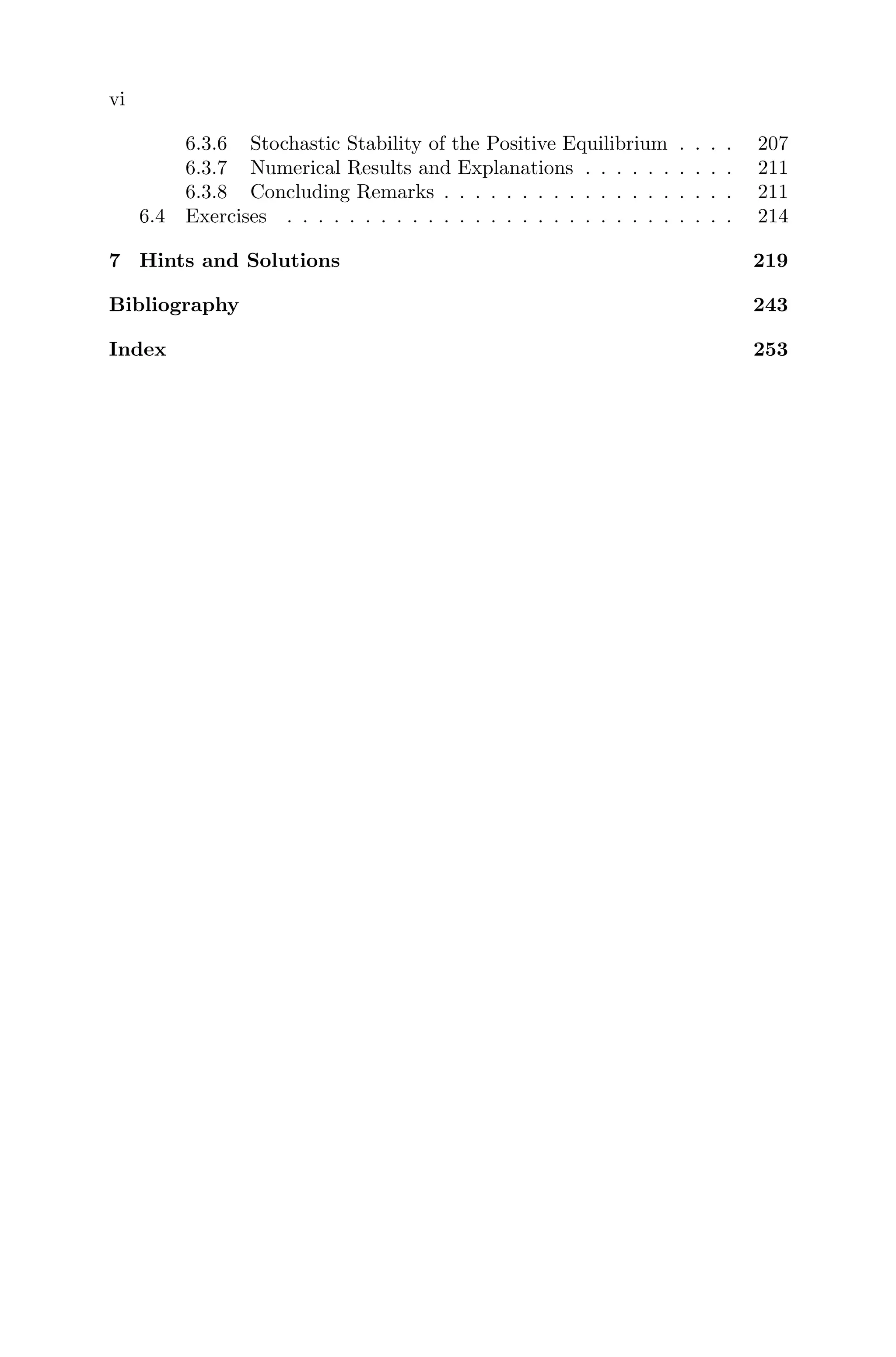
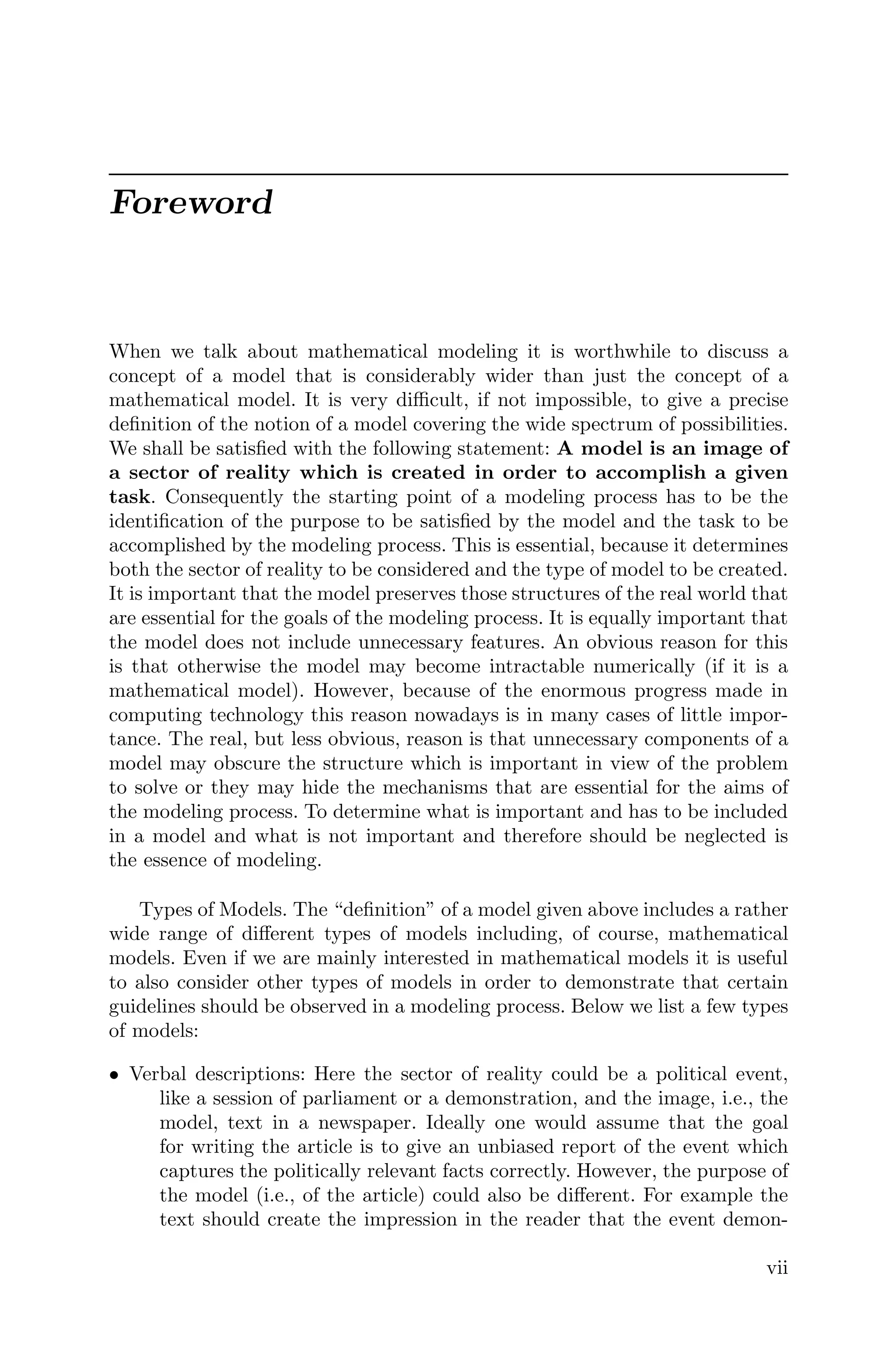
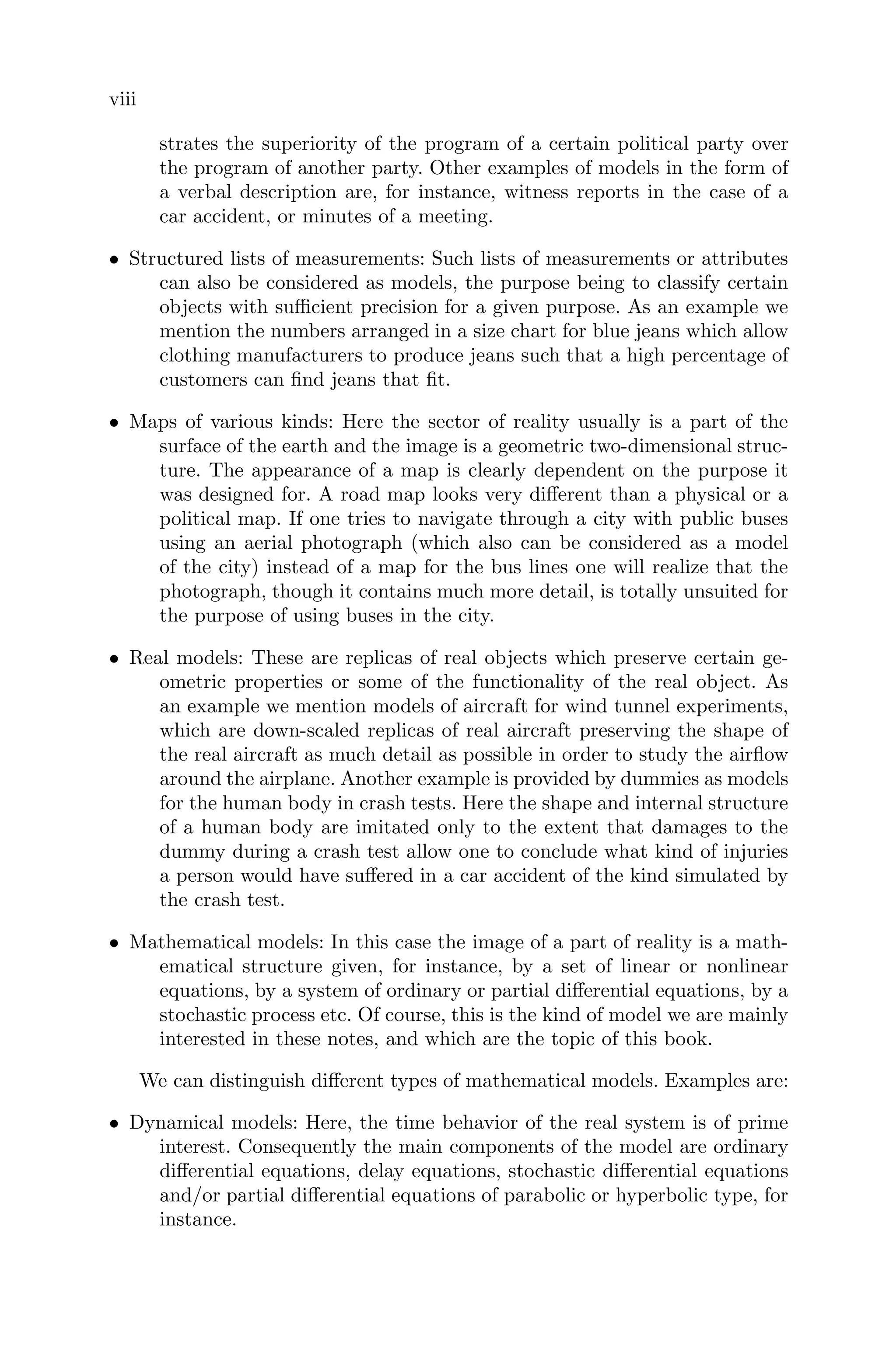
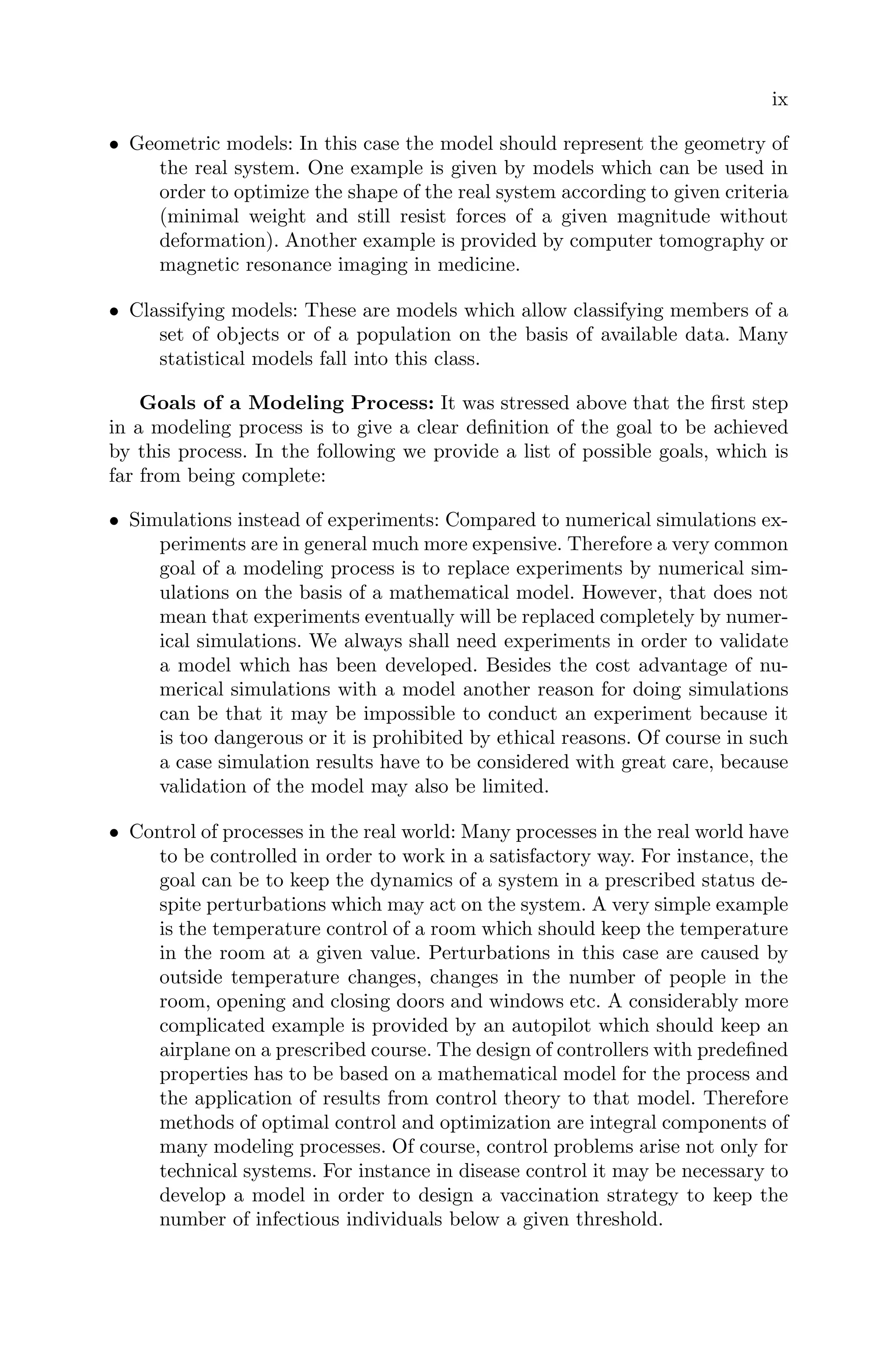
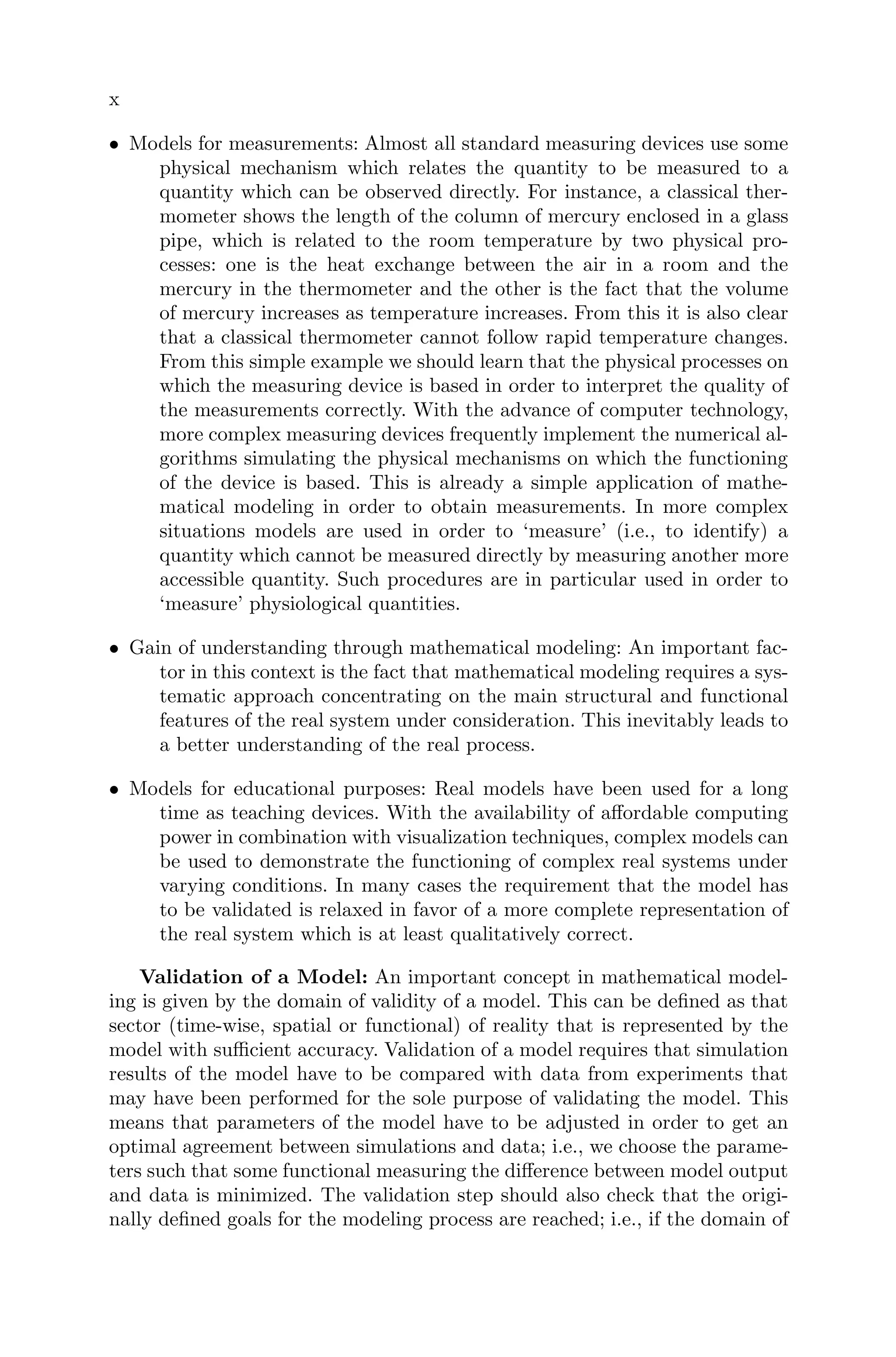
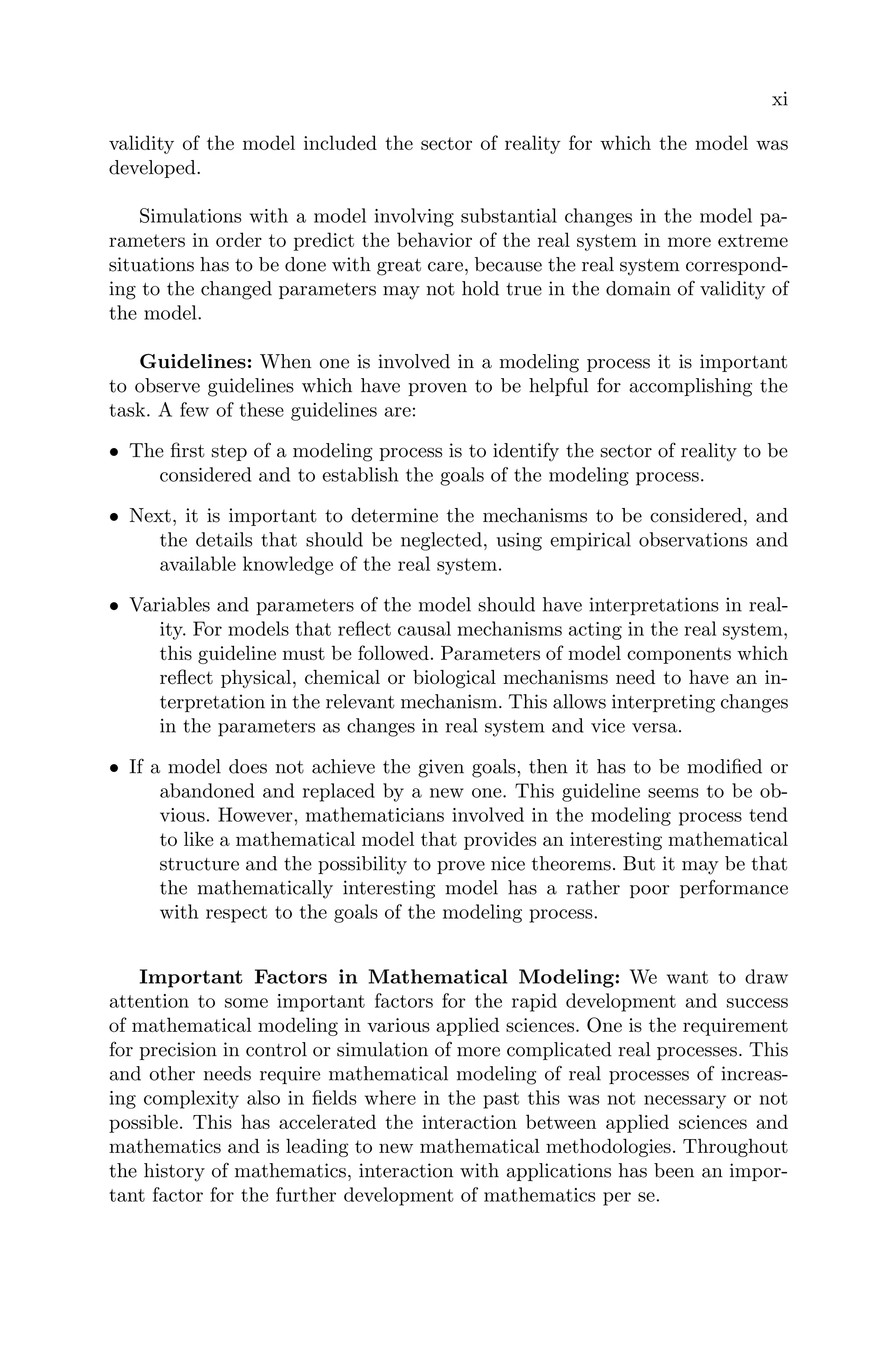
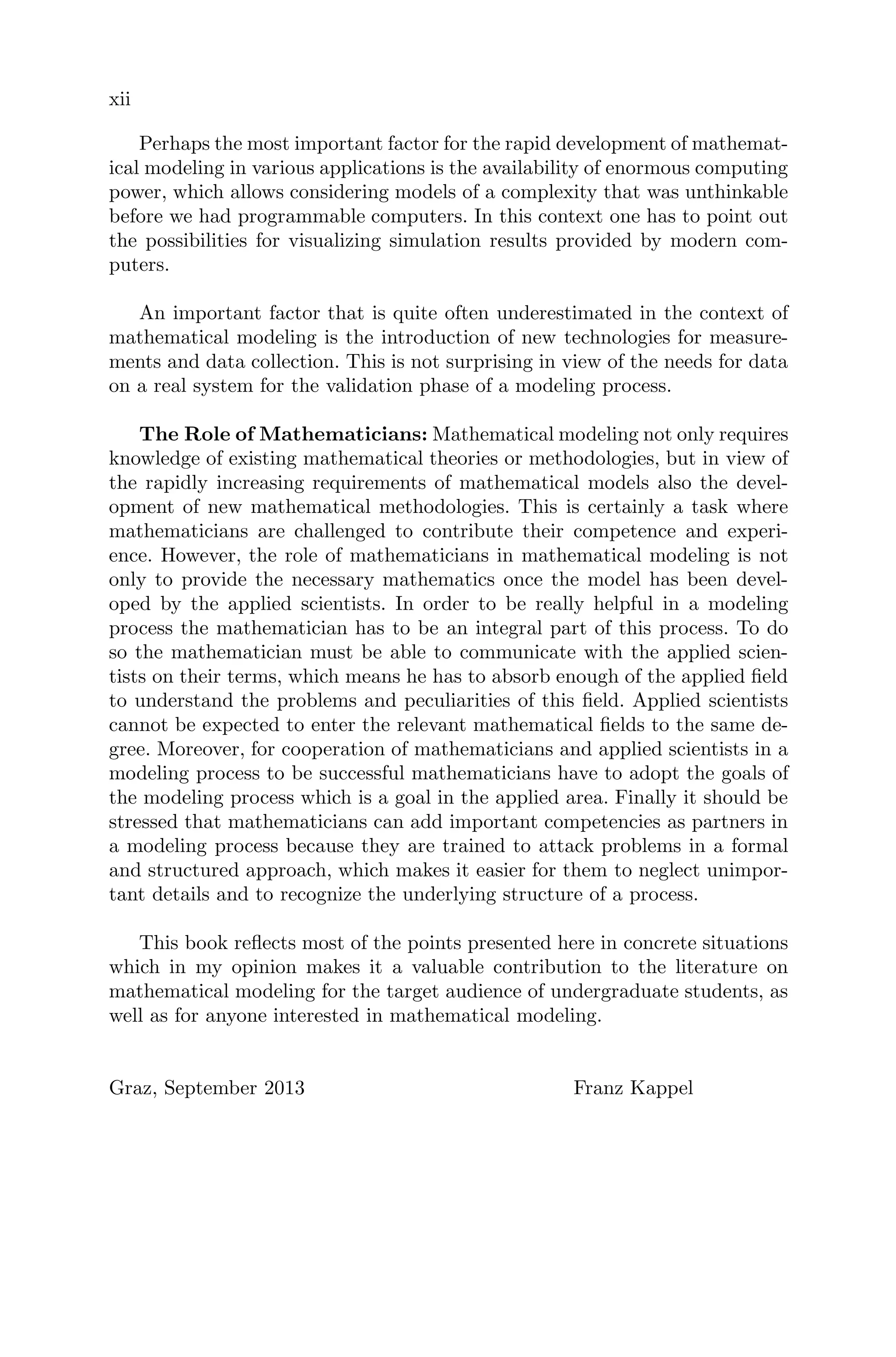
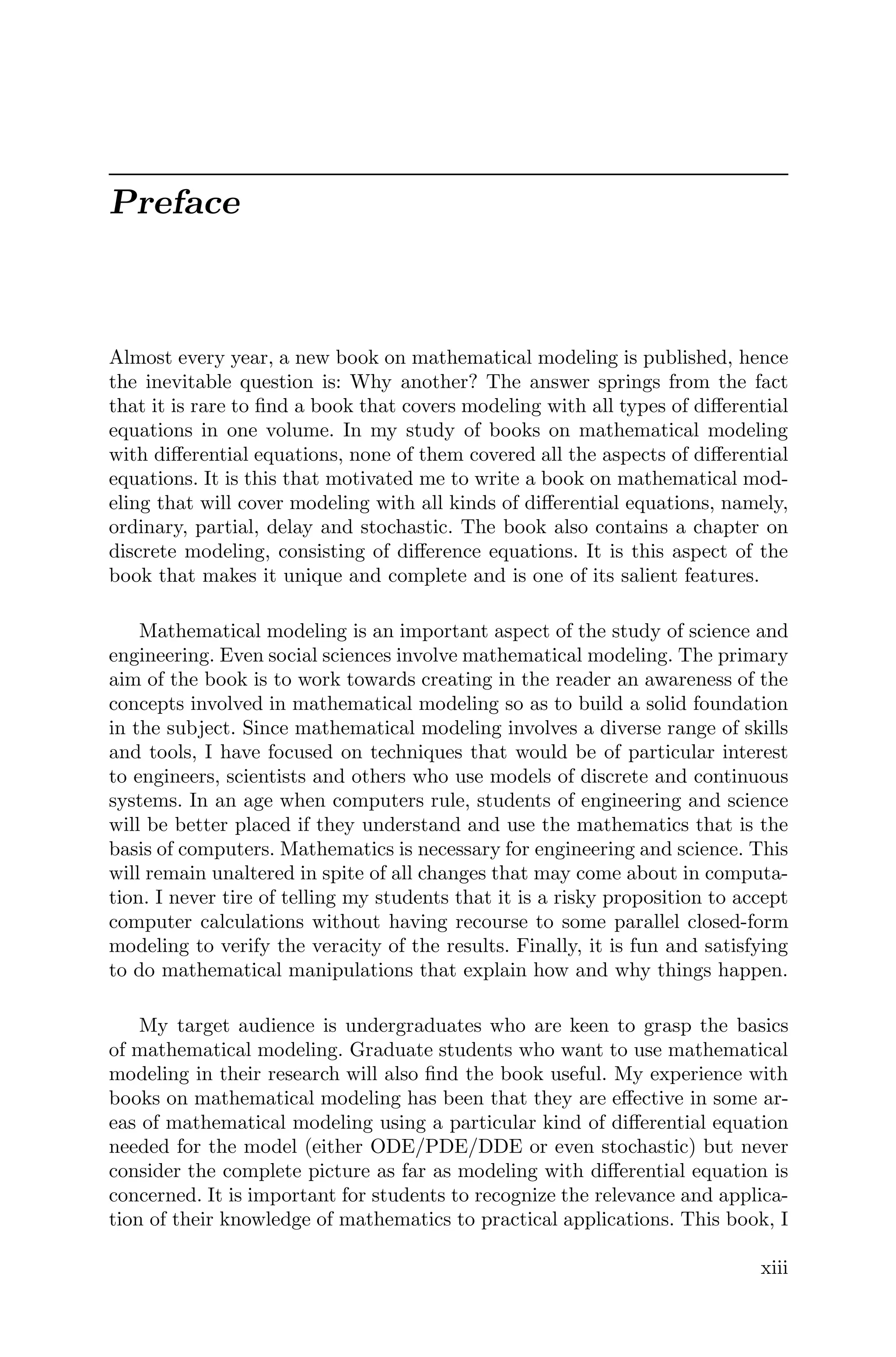
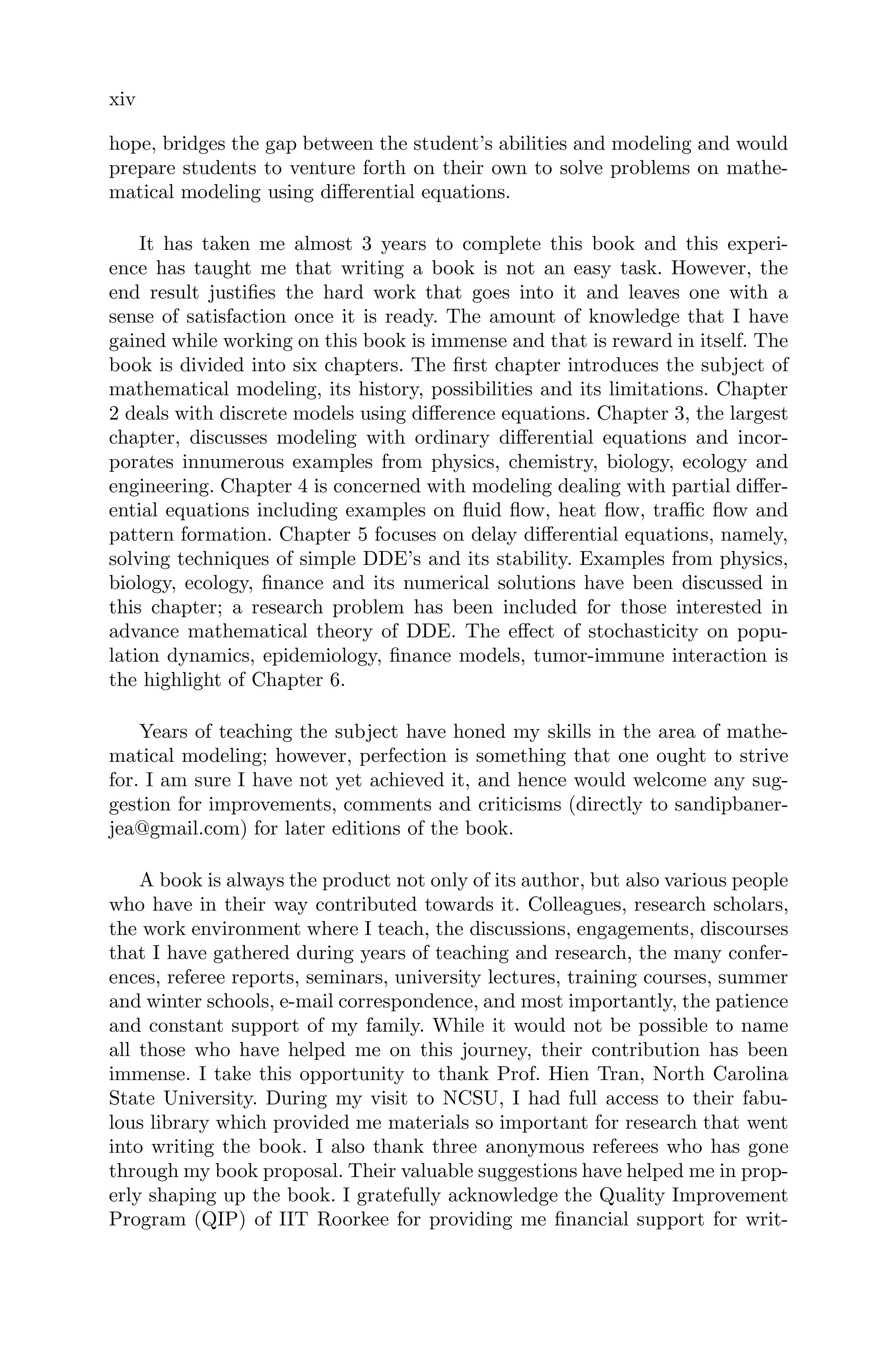
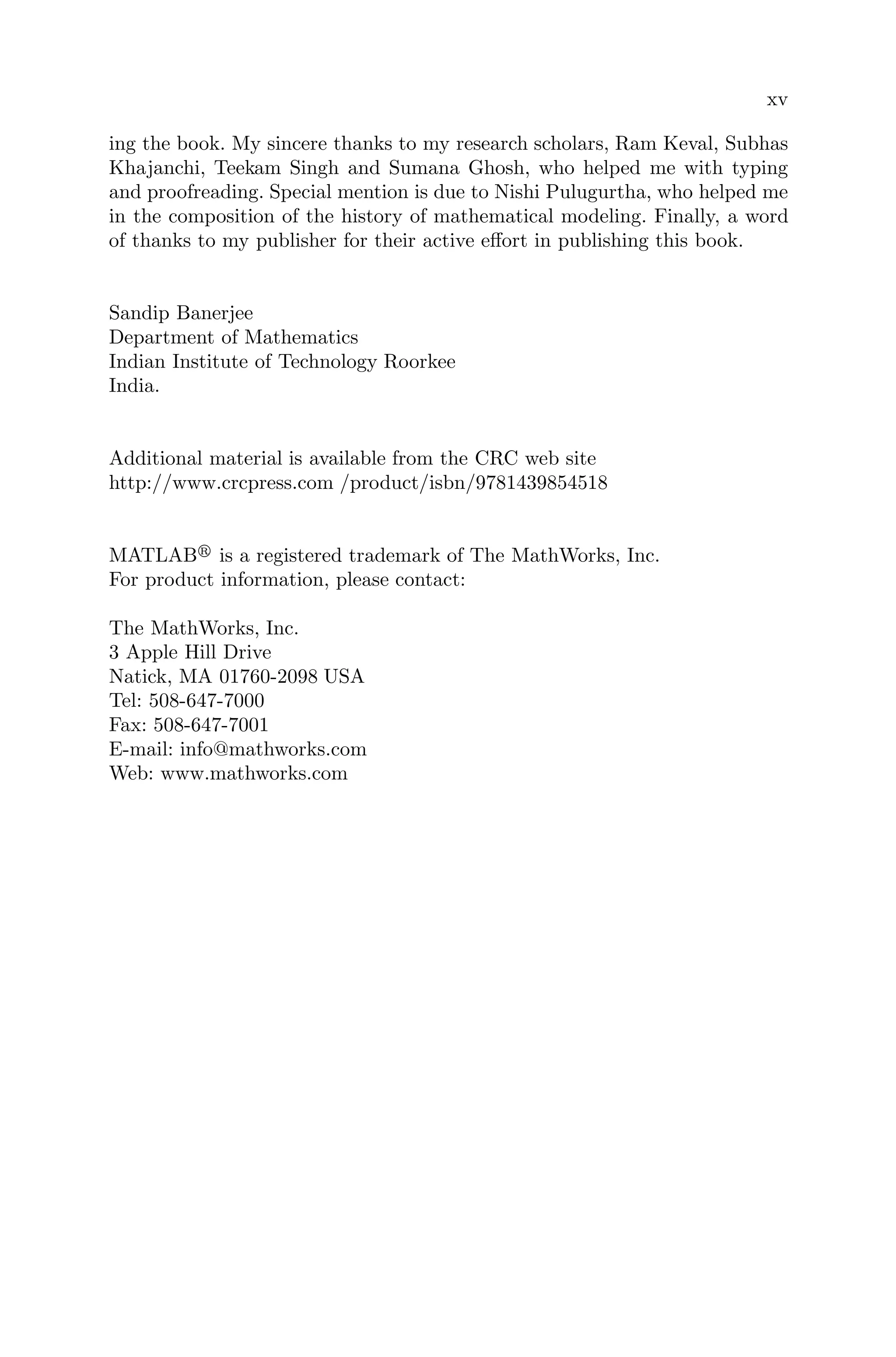

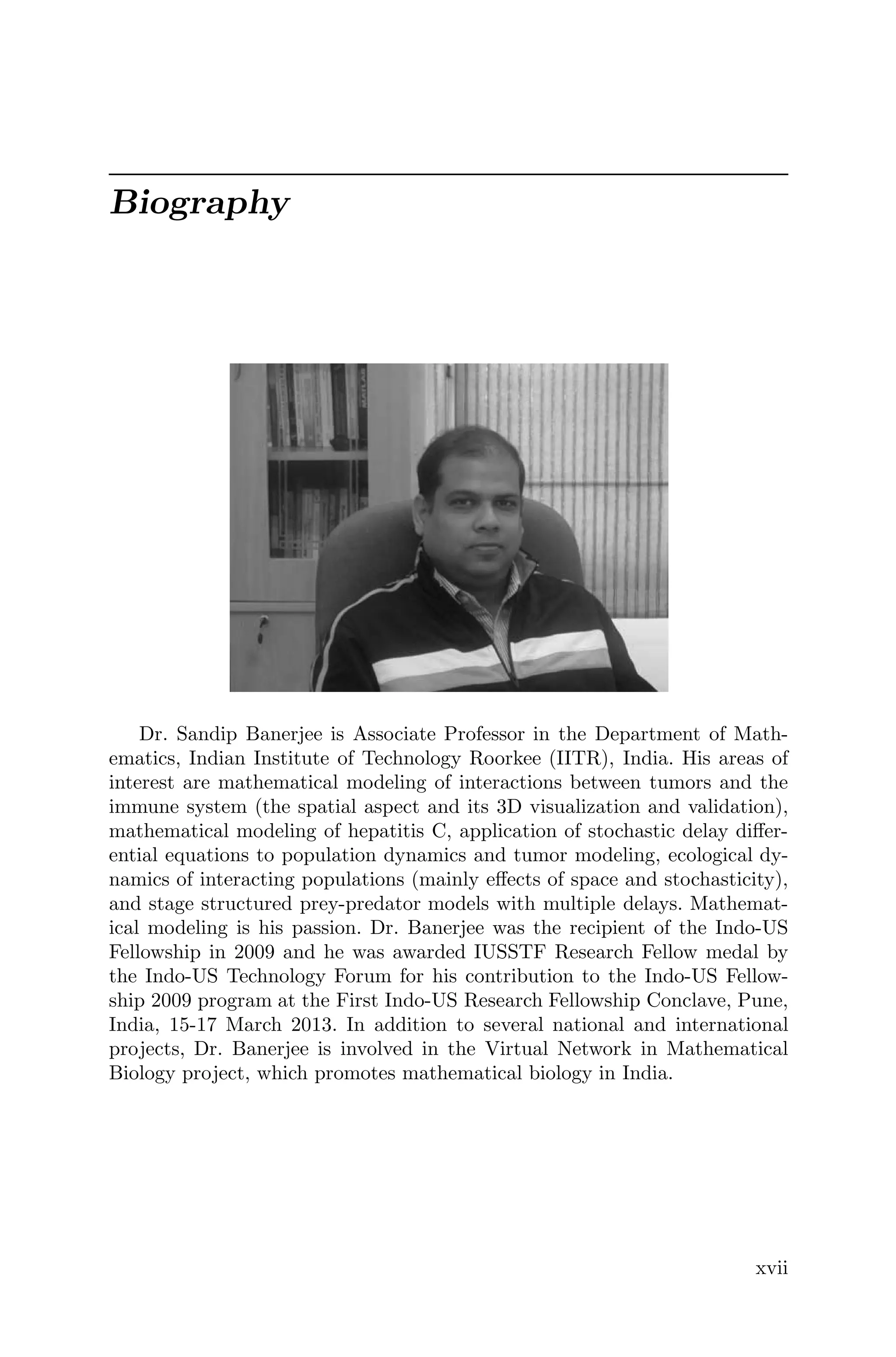

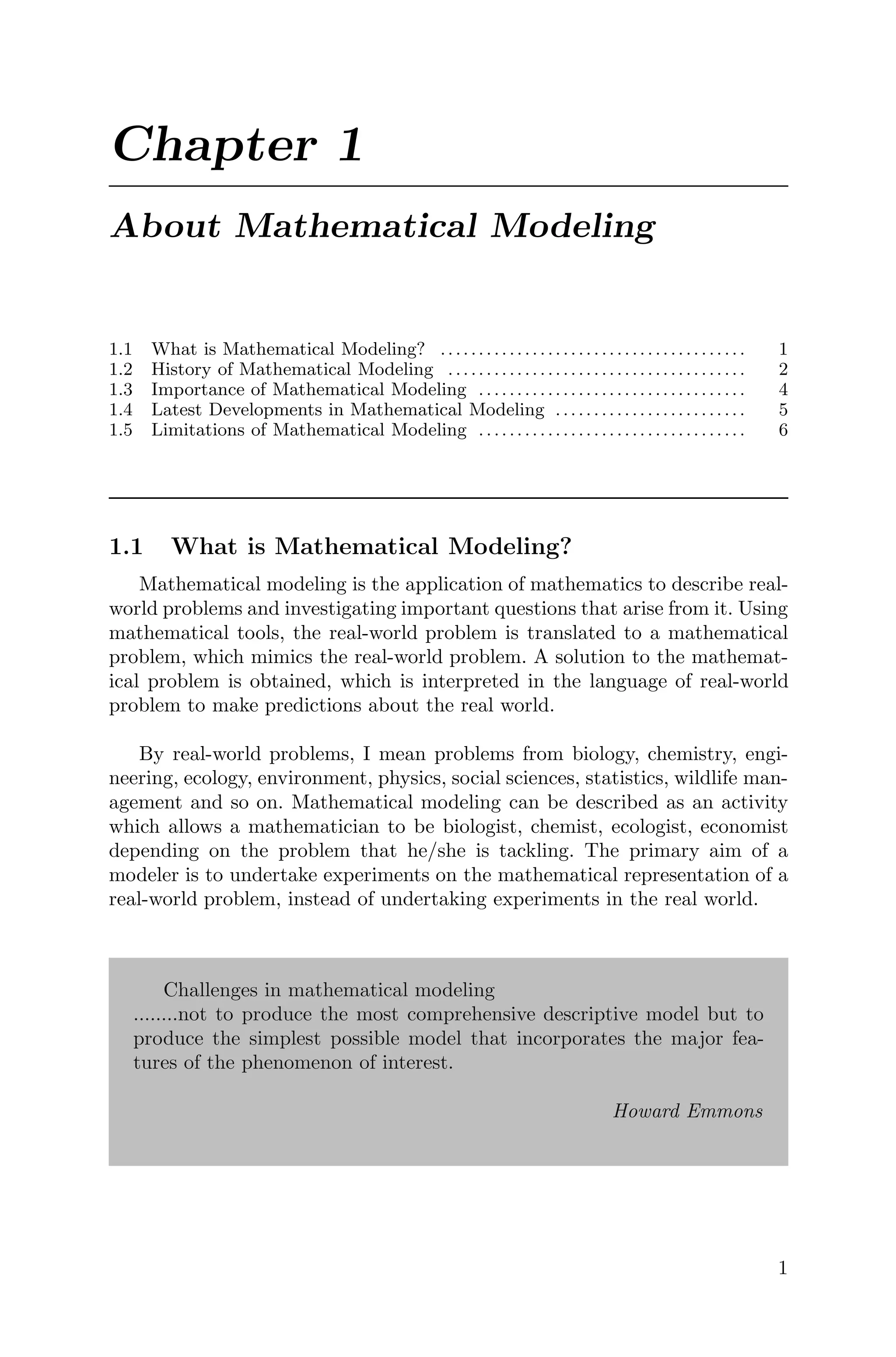
![2 Mathematical Modeling: Models, Analysis and Applications
1.2 History of Mathematical Modeling
Modeling (from Latin modellus) is a way of handling reality. It is the ability
to create models that distinguish human beings from other animals. Models
of real objects and things have been in use by human beings since the Stone
Age as is evident in cave paintings. Modeling became important in the Ancient
Near East and Ancient Greek civilizations. It is writing and counting numbers
which were the first models. Two other areas where modeling was used in its
preliminary forms are astronomy and architecture. By the year 2000 BC, the
three ancient civilizations of Babylon, Egypt and India had a good knowledge
of mathematics and used mathematical models in various spheres of life [117].
In Ancient Greek civilization, the development of philosophy and its close
relation to mathematics contributed to a deductive method, which led to
probably the first instance of mathematical theory. From about 600 BC, ge-
ometry became a useful tool in analyzing reality. Thales predicted the solar
eclipse of 585 BC and devised a method for measuring heights by measuring
the lengths of shadows using geometry. Pythagoras developed the theory of
numbers, and most importantly initiated the use of proofs to gain new re-
sults from already known theorems. Greek philosophers Aristotle, Eudoxus,
and others contributed further and in the next 300 years after Thales, geom-
etry and other branches of mathematics developed further. The zenith was
reached by Euclid of Alexandria who in Circa 300 BC wrote The Elements, a
veritable collection of almost all branches of mathematics known at the time.
This work included, among others, the first precise description of geometry
and a treatise on number theory. It is for this that Euclid’s books became
important for the teaching of mathematics for many hundreds of years, and
around 250 BC Eratosthenes of Cyrene used this knowledge to calculate the
distances between the Earth and the Sun, the Earth and the Moon and the
circumference of the Earth using a geometric model.
A further step in the development of mathematical models was taken up
by Diophantus of Alexandria in about 250 AD, who, in his book Arithmetica,
developed the beginnings of algebra based on symbolism and the idea of a
variable. In the field of astronomy, Ptolemy, influenced by Pythagoras’ idea of
describing celestial mechanics by circles, developed a mathematical model of
the solar system using circles to predict the movement of the sun, the moon,
and the planets. The model was so accurate that it was used until the early
seventeenth century when Johannes Kepler discovered a much more simple
and superior model for planetary motion in 1619. This model, with later re-
finements done by Newton and Einstein, is in use even today.
Mathematical models are used for real-world problems and are hence im-](https://image.slidesharecdn.com/mathematicalmodelingmodelsanalysisandapplicationspdfdrive-211127122602/75/Mathematical-modeling-models-analysis-and-applications-pdf-drive-25-2048.jpg)
![About Mathematical Modeling 3
portant for human development. Mathematical models were developed in
China, India and Persia as well as in the Western world. One of the most
famous Arabian mathematicians was Abu Abd-Allah ibn Musa Al-Hwārizmī,
who lived in the late eighth century [117]. Interestingly, his name still survives
in the word algorithm. His well known books are de numero Indorum (about
the Indian numbers - today called Arabic numbers) and Al-kitab al-muhtasar
fi hisāb al-ǧ abr wa’lmuqābala (a book about the procedures of calculation
balancing) [117]. Both these books contain mathematical models and prob-
lem solving algorithms for use in commerce, survey, and irrigation. The term
algebra was derived from the title of his second book.
In the Western world, it was only in the sixteenth century that mathe-
matics and mathematical models developed. The greatest mathematician in
the Western world after the decline of the Greek civilization was Fibonacci,
Leonardo da Pisa (ca. 1170-ca. 1240). The son of a merchant, Fibonacci made
many journeys to the Orient, and familiarized himself with mathematics as it
had been practiced in the Eastern world. He used algebraic methods recorded
in Al-Hwārizmī’s books to improve his trade as a merchant. He first realized
the great practical advantage of using the Indian numbers over the Roman
numbers which were still in use in Europe at that time. His book Liber Abaci,
first published in 1202, began with a reference to the ten ‘Indian figures’ (0,
1, 2,..., 9), as he called them. 1202 is an important year since this is the year
that saw the number zero being introduced to Europe. The book itself was
meant to be a manual of algebra for commercial use. It dealt in detail with
arithmetical rules using numerical examples which were derived from practical
use, such as their applications in measure and currency conversion.
The painter Giotto (1267-1336) and the Renaissance architect and sculp-
tor Filippo Brunelleschi (1377-1446) are responsible for the development of
geometric principles. In the later centuries many more and varied mathemati-
cal principles were discovered and the intricacy and complexity of the models
increased. It is important to note that despite the achievements of Diophant
and Al-Hwārizmī, the systematic use of variables was invented by Vieta (1540-
1603) [117]. In spite of all these developments it took many years to realize
the true role of variables in the formulation of mathematical theory. It also
took time for the importance of mathematical modeling to be completely un-
derstood. Physics and its application to nature and natural phenomena is a
major force in mathematical modeling and its further development. Later eco-
nomics became another area of study where mathematical modeling began to
play a major role.](https://image.slidesharecdn.com/mathematicalmodelingmodelsanalysisandapplicationspdfdrive-211127122602/75/Mathematical-modeling-models-analysis-and-applications-pdf-drive-26-2048.jpg)
![4 Mathematical Modeling: Models, Analysis and Applications
1.3 Importance of Mathematical Modeling
A mathematical model, as stated, is a mathematical description of a real
life situation. So, if a mathematical model can reflect or mimic the behavior
of a real life situation, then we can get a better understanding of the system
through proper analysis of the model using appropriate mathematical tools.
Moreover, in the process of building the model, we discover various factors
which govern the system, factors which are most important to the system and
that reveal how different aspects of the system are related.
The importance of mathematical modeling in physics, chemistry, biology,
economics and even industry cannot be ignored. Mathematical modeling in
basic sciences is gaining popularity, mainly in biological sciences, economics
and industrial problems. For example, if we consider mathematical model-
ing in the steel industry, many aspects of steel manufacture, from mining to
distribution, are susceptible to mathematical modeling. In fact, steel com-
panies have participated in several mathematics-industry workshops, where
they discussed various problems and obtained solution through mathematical
modeling - problems involving control of ingot cooling, heat and mass transfer
in blast furnaces, hot rolling mechanics, friction welding, spray cooling and
shrinkage in ingot solidification, to mention a few [91]. Similarly, mathemati-
cal modeling can be used
(i) to study the growth of plant crops in a stressed environment,
(ii) to study mRNA transport and its role in learning and memory,
(iii) to model and predict climate change,
(iv) to study the interface dynamics for two liquid films in the context of or-
ganic solar cells,
(v) to develop multi-scale modeling in liquid crystal science and many more.
For gaining physical insight, analytical techniques are used. However, to
deal with more complex problems, numerical approaches are quite handy. It
is always advisable and useful to formulate a complex system with a simple
model whose equation yields an analytical solution. Then the model can be
modified to a more realistic one that can be solved numerically. Together with
the analytical results for simpler models and the numerical solution from more
realistic models, one can gain maximum insight into the problem.](https://image.slidesharecdn.com/mathematicalmodelingmodelsanalysisandapplicationspdfdrive-211127122602/75/Mathematical-modeling-models-analysis-and-applications-pdf-drive-27-2048.jpg)
![About Mathematical Modeling 5
1.4 Latest Developments in Mathematical Modeling
Mathematical modeling is an area of great development and research. In re-
cent years, mathematical models have been used to validate hypotheses made
from experimental data, and at the same time the designing and testing of
these models has led to testable experimental predictions. There are impres-
sive cases in which mathematical models have provided fresh insight into bi-
ological systems, physical systems, decision making problems, space models,
industrial problems, economical problems and so forth. The development of
mathematical modeling is closely related to significant achievements in the
field of computational mathematics.
Consider a new product being launched by a company. In the development
process, there are critical decisions involved in its launch such as timing, de-
termining price, launch sequence, etc. Experts use and develop mathematical
models to facilitate such decision making. Similarly, in order to survive market
competition, cost reduction is one of the main strategies for a manufacturing
plant, where a large amount of production operation costs are involved. Proper
layout of equipment can result in a huge reduction in such costs. This leads to
dynamic facility layout problem for finding equipment sites in manufacturing
environments, which is one of the developing areas in the field of mathematical
modeling [122].
Mathematical modeling also intensifies the study of potentially deadly flu
viruses from mother nature and bio-terrorists. Mathematical models are also
being developed in optical sciences [6], namely, diffractive optics, photonic
band gap structures and wave guides, nutrient modeling, studying the dynam-
ics of blast furnaces, studying erosion, and prediction of surface subsidence.
In geosciences, mathematical models have been developed for talus. Talus
is defined by Rapp and Fairbridge [103] as an accumulation of rock debris
formed close to mountain walls, mainly through many small rockfalls. Hiroyuki
and Yukinori [90] have constructed a new mathematical model for talus devel-
opment and retreat of cliffs behind the talus, which was later applied to the
result of a field experiment for talus development at a cliff composed of chalk.
They developed the model which was in agreement with the field observations.
There has been tremendous development in the interdisciplinary field of
applied mathematics in human physiology in the last decade, and development
continues. One of the main reasons for this development is the researcher’s im-
proved ability to gather data, whose visualization have much better resolution
in time and space than just a few years ago. At the same time, this devel-
opment also constitutes a giant collection of data as obtained from advanced](https://image.slidesharecdn.com/mathematicalmodelingmodelsanalysisandapplicationspdfdrive-211127122602/75/Mathematical-modeling-models-analysis-and-applications-pdf-drive-28-2048.jpg)
![6 Mathematical Modeling: Models, Analysis and Applications
measurement techniques. Through statistical analysis, it is possible to find
correlations, but such analysis fails to provide insight into the mechanisms
responsible for these correlations. However, when it is combined with mathe-
matical modeling, new insights into the physiological mechanisms are revealed.
Mathematical models are being developed in the field of cloud computing
to facilitate the infrastructure of computing resources in which large pools of
systems (or clouds) are linked together via the internet to provide IT services
(for example, providing secure management of billions of online transactions)
[25]. Development of mathematical models are also noticed
(i) in the study of variation of shielding gas in GTA welding,
(ii) for prediction of aging behavior for Al-Cu-Mg/Bagasse Ash particular
composites,
(iii) for public health decision making and estimations,
(iv) for developing of cerebral cortical folding patterns which have fascinated
scientists with their beauty and complexity for centuries,
(v) to predict sunflower oil expression,
(vi) in the development of a new three dimensional mathematical ionosphere
model at the European Space Agency/European Space Operators Centre,
(vii) in battery modeling or mathematical description of batteries, which plays
an important role in the design and use of batteries, estimation of battery pro-
cesses and battery design. These are some areas where mathematical modeling
plays an important role. However, there are many more areas of application.
1.5 Limitations of Mathematical Modeling
Sometimes although the mathematical model used is well adapted to the
situation at hand, it may give unexpected results or simply fail. This may
be an indication that we have reached the limit of the present mathematical
model and must look for a new refinement of the real-world or a new the-
oretical breakthrough [10]. A similar type of problem was addressed in [6],
which deals with Moire theory, involving the mathematical modeling of the
phenomena that occur in the superposition of two or more structures (line
gratings, dot screens, etc.), either periodic or not.
In mathematical modeling, more assumptions must be made, as infor-
mation about real-world systems become less precise or harder to measure.
Modeling becomes a less precise endeavor as it moves away from physical
systems towards social systems. For example, modeling an electrical circuit
is much more straightforward than modeling human decision making or the
environment. Since physical systems usually do not change, reasonable past](https://image.slidesharecdn.com/mathematicalmodelingmodelsanalysisandapplicationspdfdrive-211127122602/75/Mathematical-modeling-models-analysis-and-applications-pdf-drive-29-2048.jpg)
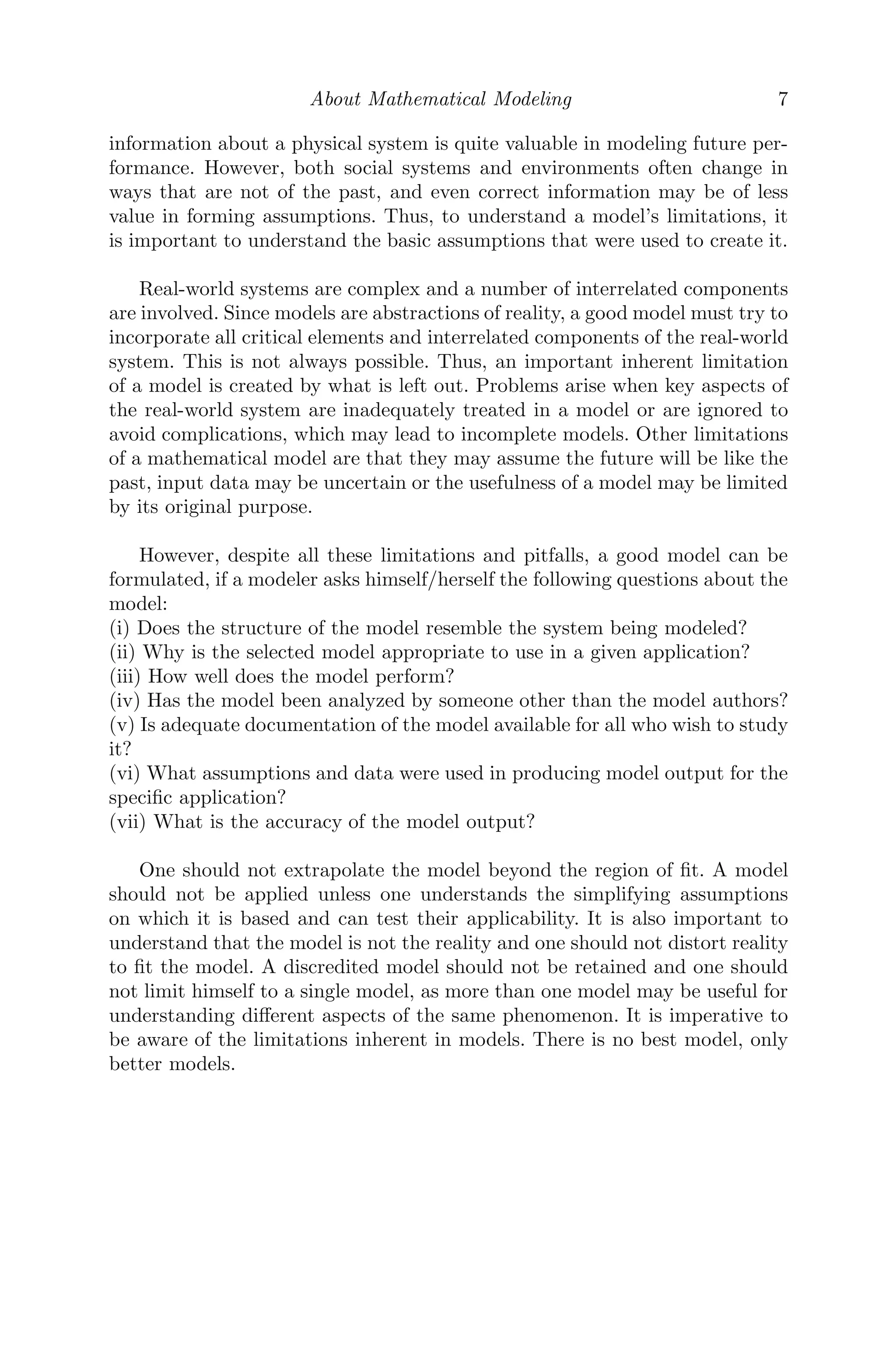

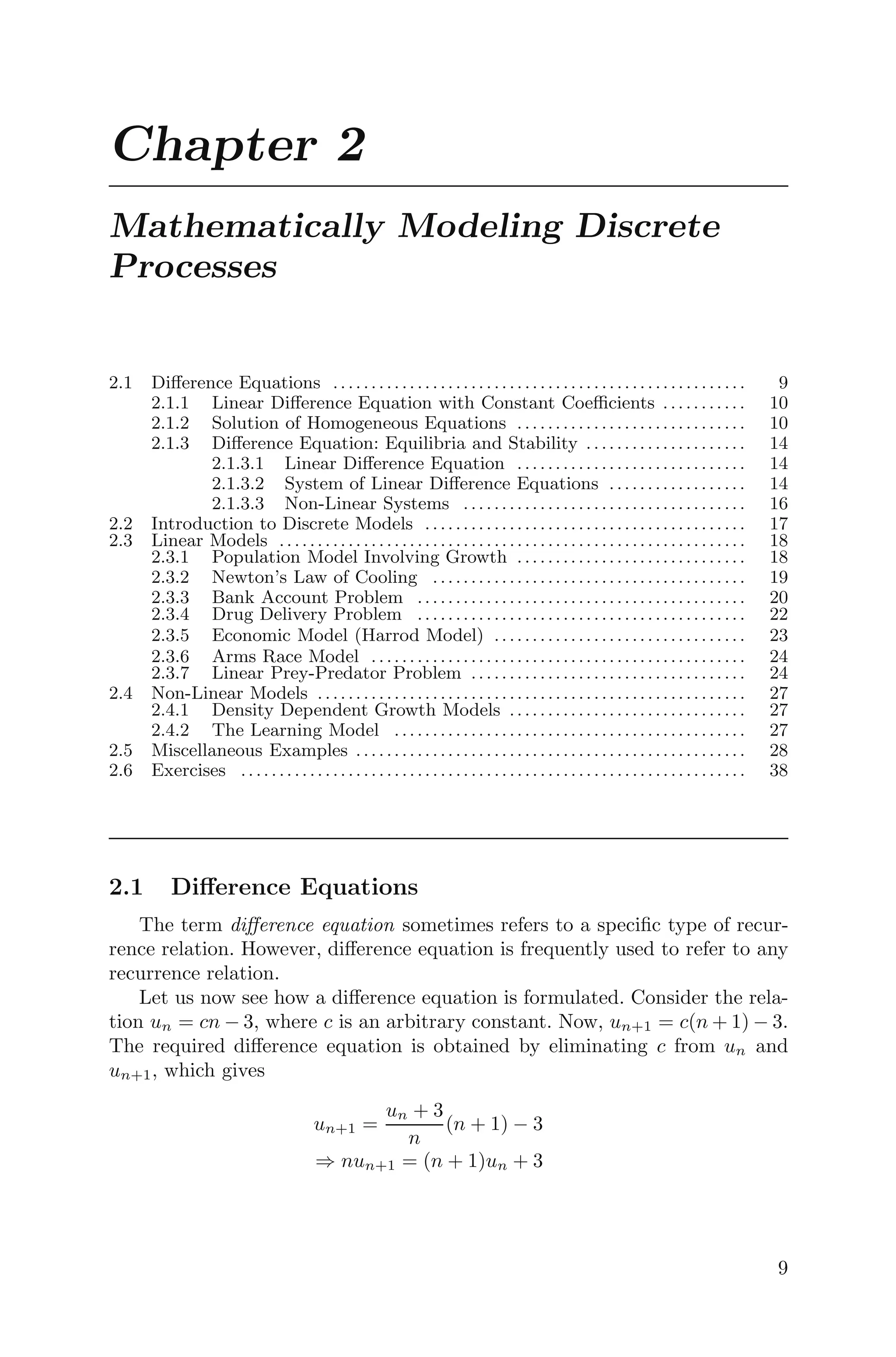
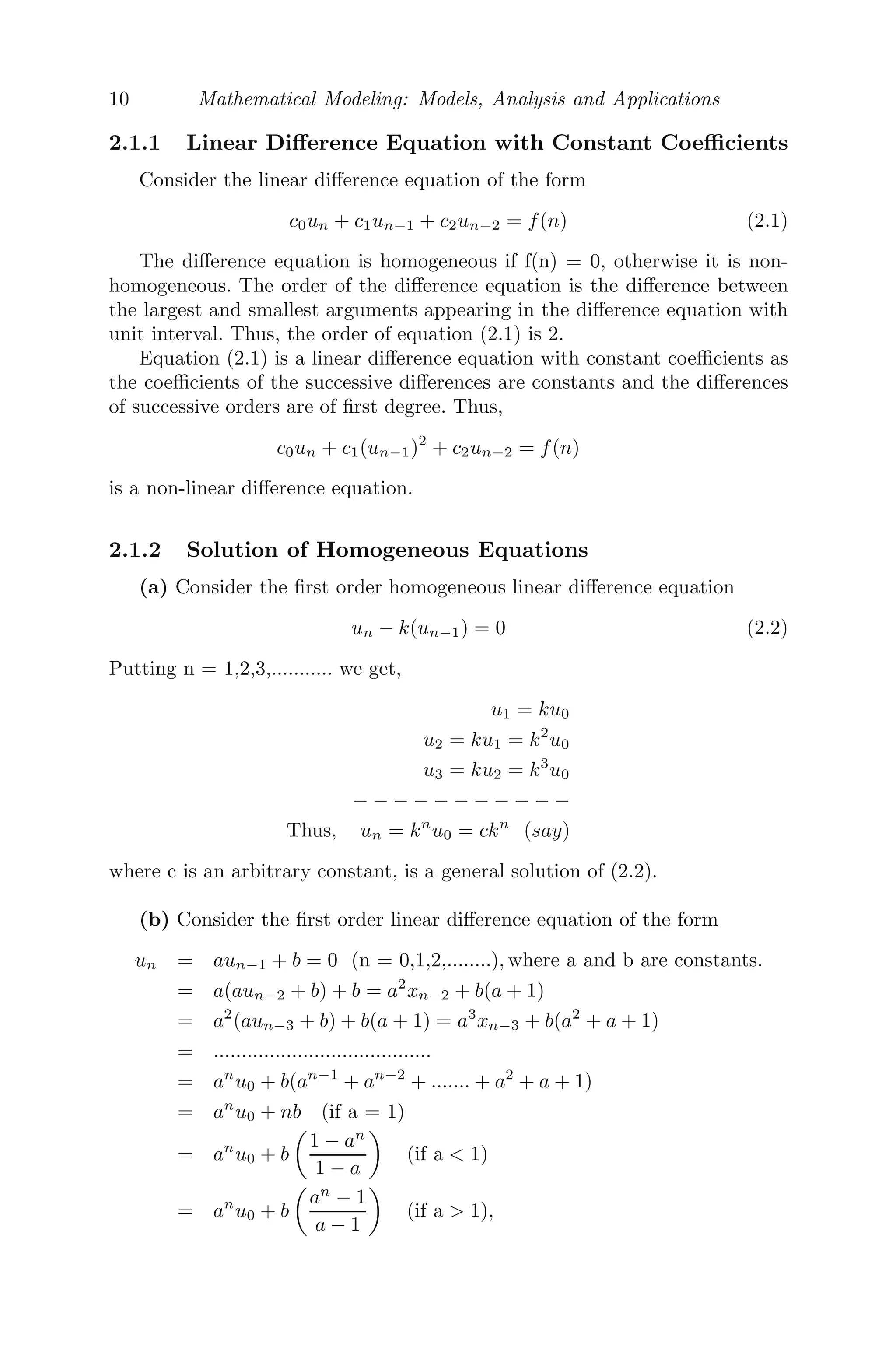
![Mathematically Modeling Discrete Processes 11
which is the required solution of the first order linear difference equation
un = aun−1 + b
(c) Consider the second order homogeneous linear difference equation
a0un + a1un−1 + a2un−2 = 0 (2.3)
Assuming the solution of the form un = ckn
(c = 0) and putting it in
(2.3), we get,
a0k2
+ a1k + a2 = 0
⇒ a0k2
+ a1k + a2 = 0 (since, cn
= 0),
which is called the auxiliary equation.
(i) If the auxiliary equation has two distinct real roots, m1 and m2 (say),
then,
c1mn
1 + c2mn
2
is the general solution of (2.3), and c1 and c2 are arbitrary constants.
(ii) If the roots of the auxiliary equation are real and equal, m1 = m2 = m
(say), then,
(c1 + c2n)mn
is the general solution of (2.3), and c1 and c2 are arbitrary constants.
(iii) If the auxiliary equation has imaginary roots (which occur in conju-
gate pairs), α + iβ and α − iβ (say), then,
rn
(c1 cos nθ + c2 sin nθ)
is the general solution of (2.3), r =
α2 + β2 and θ = tan−1
(β
α ), and c1 and
c2 are arbitrary constants.
Note: Solutions for non-homogeneous equations can be obtained by partic-
ular integral methods, undetermined coefficients, Z-Transform, Laplace Trans-
form etc. Interested readers can look into [27, 43, 80] for detailed information.
Example 2.1.1 Obtain the difference equation by eliminating the arbitrary
constants from un = A2n
+ B(−3)n
.
Solution: Given,
un = A2n
+ B(−3)n
⇒ un+1 = A2n+1
+ B(−3)n+1
⇒ un+2 = A2n+2
+ B(−3)n+2](https://image.slidesharecdn.com/mathematicalmodelingmodelsanalysisandapplicationspdfdrive-211127122602/75/Mathematical-modeling-models-analysis-and-applications-pdf-drive-34-2048.jpg)
![12 Mathematical Modeling: Models, Analysis and Applications
Therefore,
un+1 = 2A2n
− 3B(−3)n
un+2 = 4A2n
+ 9B(−3)n
Solving, we get
A =
3un+1 + un+2
102n
and B =
un+2 − 2un+1
15(−3)n
Thus, the required difference equation is
un =
3un+1 + un+2
10
+
un+2 − 2un+1
15
⇒ un+2 + un+1 − 6un = 0.
Example 2.1.2 Find un if u0 = 0, u1 = 1 and un+2 + 16un = 0.
Solution: Let un = kn
(k = 0) be a solution of un+2 + 16un = 0, then the
required auxiliary equation is
k2
+ 16 = 0
⇒ k = ±4i
The general solution is
un = c1(4i)n
+ c2(−4i)n
= 4n
[c1einπ/2
+ c2e−inπ/2
]
= 4n
[A1 cos(nπ/2) + A2 sin(nπ/2)]
where A1 and A2 are arbitrary constants. Now, u0 = 0 and u1 = 1 implies
A1 = 0 and A2 = 1
4 . Therefore,
un = 4n−1
sin(nπ/2)
is the required solution.
Note: The solutions of homogeneous linear difference equations with con-
stant coefficients are composed of linear combinations of the basic expressions
of the form un = ckn
. The qualitative behavior of the basic solution will
depend on the real values of k, namely, on the four possible ranges [26]:
k ≥ 1, k ≤ −1, 0 k 1, − 1 k 0
For k ≥ 1, the solution un = ckn
becomes unbounded as n increases;
for 0 k 1, kn
goes to zero as n increases, hence un decreases; for −1](https://image.slidesharecdn.com/mathematicalmodelingmodelsanalysisandapplicationspdfdrive-211127122602/75/Mathematical-modeling-models-analysis-and-applications-pdf-drive-35-2048.jpg)
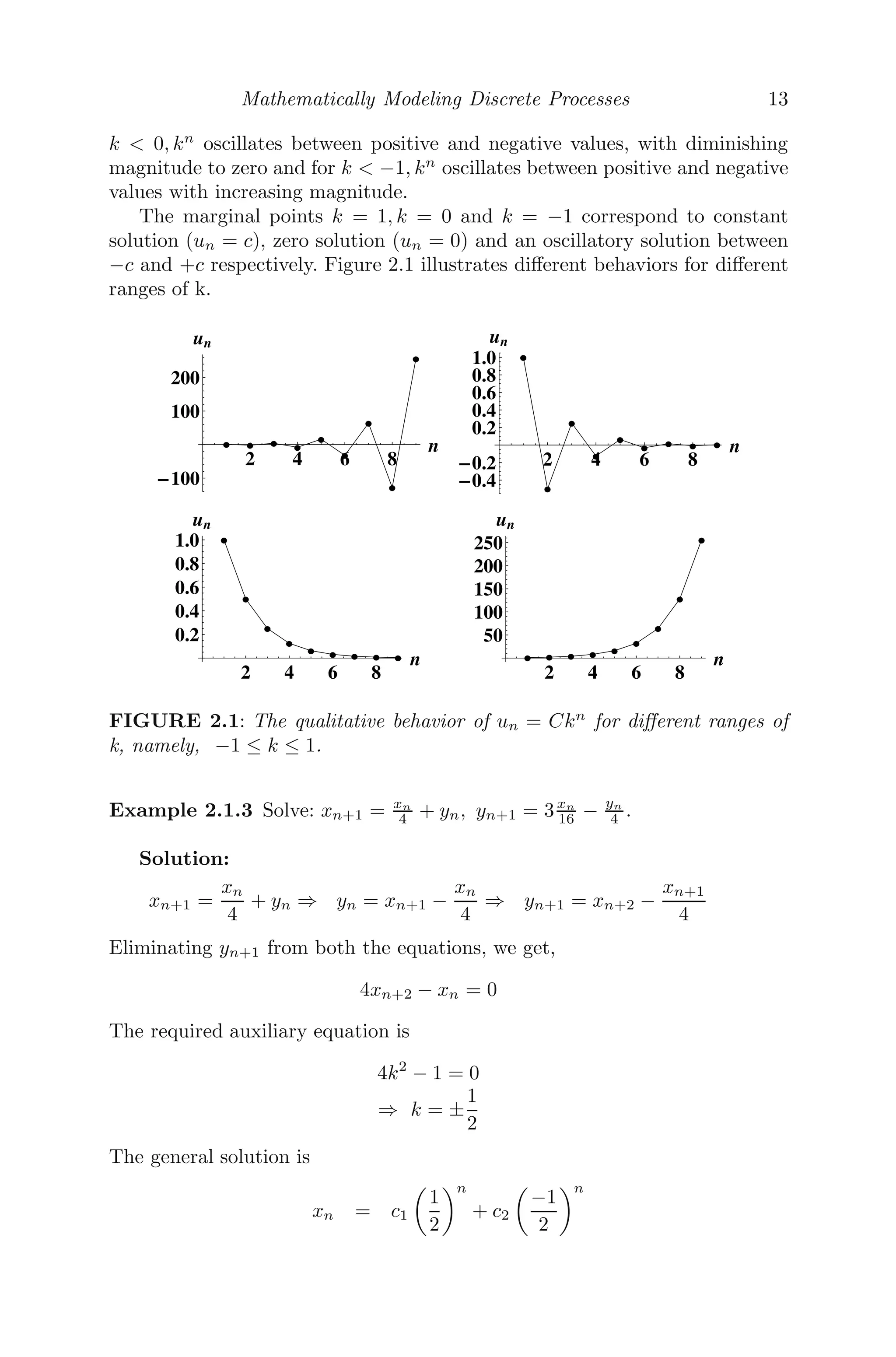
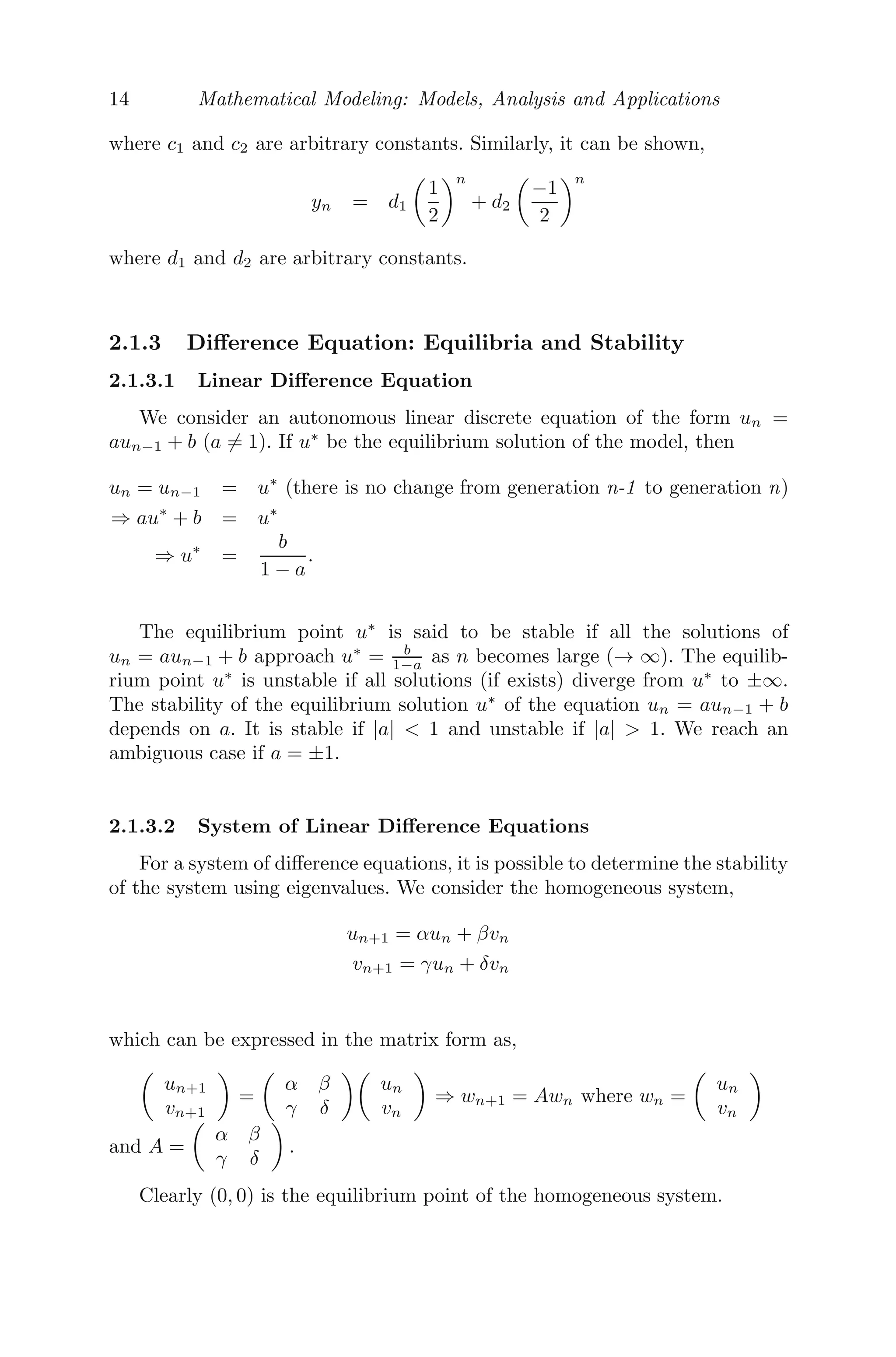
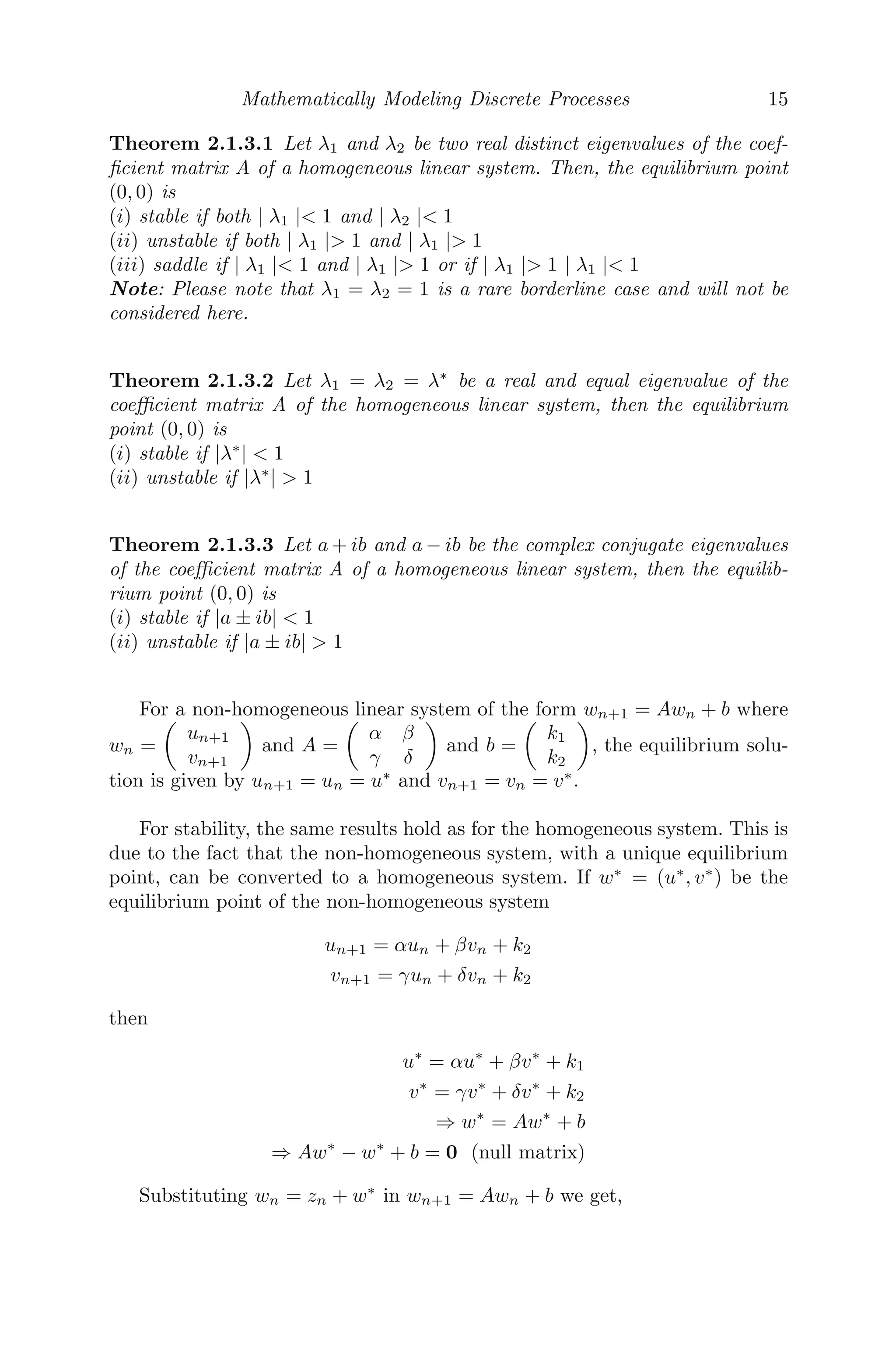
![16 Mathematical Modeling: Models, Analysis and Applications
zn+1 + w∗
= A(zn + w∗
) + b
⇒ zn+1 = Azn + Aw∗
− w∗
+ b
⇒ zn+1 = Azn (since Aw∗
− w∗
+ b = 0),
which is a homogeneous system, whose stability has already been discussed.
2.1.3.3 Non-Linear Systems
Non-linear difference equations are to be handled with special techniques
and cannot be solved by simply setting un = kn
. Here, we shall not discuss
about the solutions of non-linear difference equations but focus on the quali-
tative behaviors, namely, steady state and stability.
In the context of difference equations, x∗
is the steady state solution (equi-
librium solution) of the non-linear difference equation
xn+1 = f(xn), if xn+1 = xn = x∗
that is, there is no change from generation n to generation (n+1).
By definition, the steady state solution is stable if for 0, ∃ a δ 0 such
that |x0 − x∗
| δ implies that for all n 0, |fn
(x0) − x∗
| . The steady
state solution is asymptotically stable if, in addition, limx→∞ xn = x∗
holds.
Once we have obtained the steady state solution, we look into its stability,
that is, given some value xn close to x∗
, does xn tends towards x∗
or move
away from it? To address this issue, we give a small perturbation to the system
about the steady state x∗
. Mathematically, this means replacing xn by x∗
+ n,
where n is small. Then,
xn+1 = f(xn)
⇒ x∗
+ n+1 = f(x∗
+ n)
≈ f(x∗
) + nf
(x∗
) (by Taylor series expansion)
= x∗
+ nf
(x∗
)
Since x∗
is the equilibrium solution, x∗
= f(x∗
), which implies
n+1 ≈ nf
(x∗
) (2.4)
The solution of (2.4) will decrease if |f
(x∗
)| 1 and increase if |f
(x∗
)|
1 [80].
Theorem 2.1.3.4 The steady state solution x∗
of xn+1 = f(xn) is stable if
|f
(x∗
)| 1 and unstable if |f
(x∗
)| 1](https://image.slidesharecdn.com/mathematicalmodelingmodelsanalysisandapplicationspdfdrive-211127122602/75/Mathematical-modeling-models-analysis-and-applications-pdf-drive-39-2048.jpg)
![Mathematically Modeling Discrete Processes 17
The stability analysis of a non-linear discrete system of the form un+1 =
f(un, vn) and vn+1 = g(un, vn) near the equilibrium point (u∗
, v∗
) can be
determined by linearizing the system about the equilibrium point.
Theorem 2.1.3.5 Let (u∗
, v∗
) be an equilibrium solution of non-linear sys-
tems un+1 = f(un, vn) and vn+1 = g(un, vn) and A is the corresponding
matrix of partial derivatives given by A =
fx(u∗
, v∗
) fy(u∗
, v∗
)
gx(u∗
, v∗
) gy(u∗
, v∗
)
, then
(u∗
, v∗
) is stable if each eigenvalue of A has modulus less than 1 and unstable
if one of the eigenvalues of A has modulus greater than 1 [80].
2.2 Introduction to Discrete Models
In discrete models, the state variables change only at a countable num-
ber of points in time. These points in time are the ones at which the event
occurs/change in state. Thus, in discrete time modeling, there is a state tran-
sition function which computes the state at the next time instant given the
current state and input. The changes are really discrete in many situations
which occur at well defined time intervals. Moreover, in many cases, the data
are usually discrete rather than continuous. Hence, due to the limitations of
the available data, we may be compelled to work with the discrete model,
even though the underlying model is continuous.
Consider a sequence a1, a2, a3, ..........., an, ........ .
Let the differences an+1 − an = constant = k (say), for the sequence, then
an − an−1 = an−1 − an−2 = an−2 − an−3 = ........... = a2 − a1 = k
⇒ an = an−1 + k
= an−2 + 2k
= an−3 + 3k
....................
= a1 + (n − 1)k
Thus, an is a linear function of n and is called a linear model.](https://image.slidesharecdn.com/mathematicalmodelingmodelsanalysisandapplicationspdfdrive-211127122602/75/Mathematical-modeling-models-analysis-and-applications-pdf-drive-40-2048.jpg)

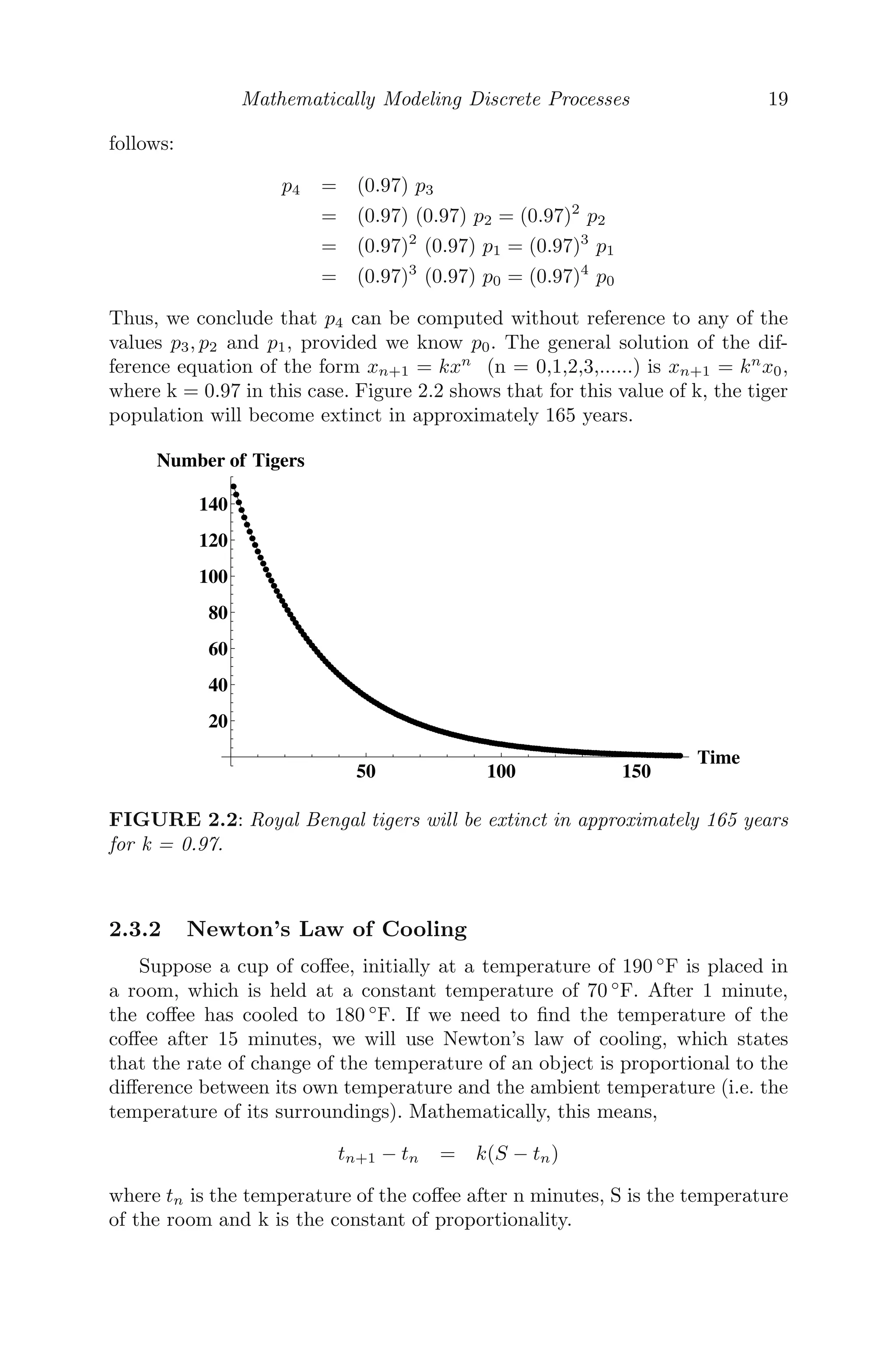
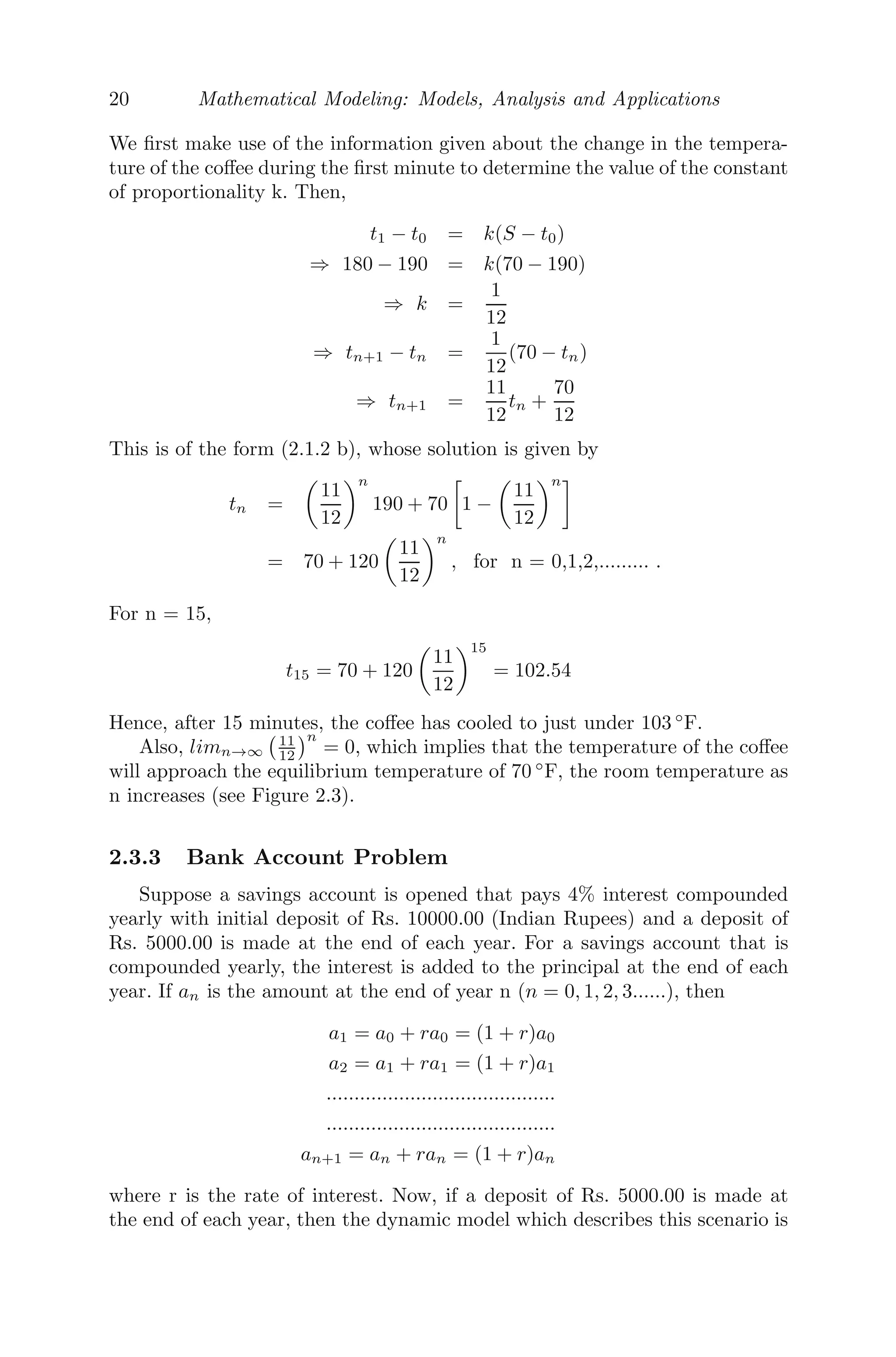
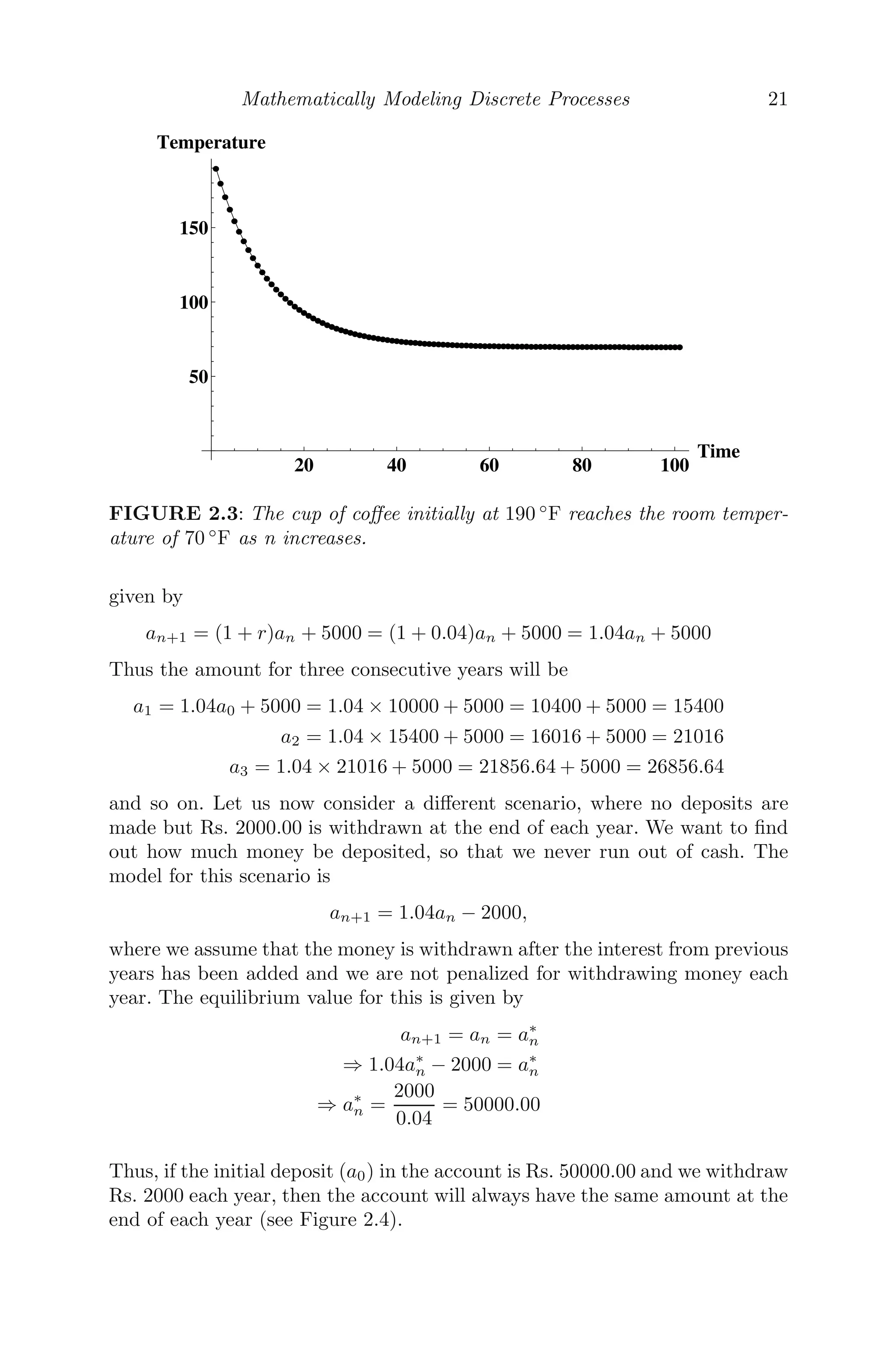
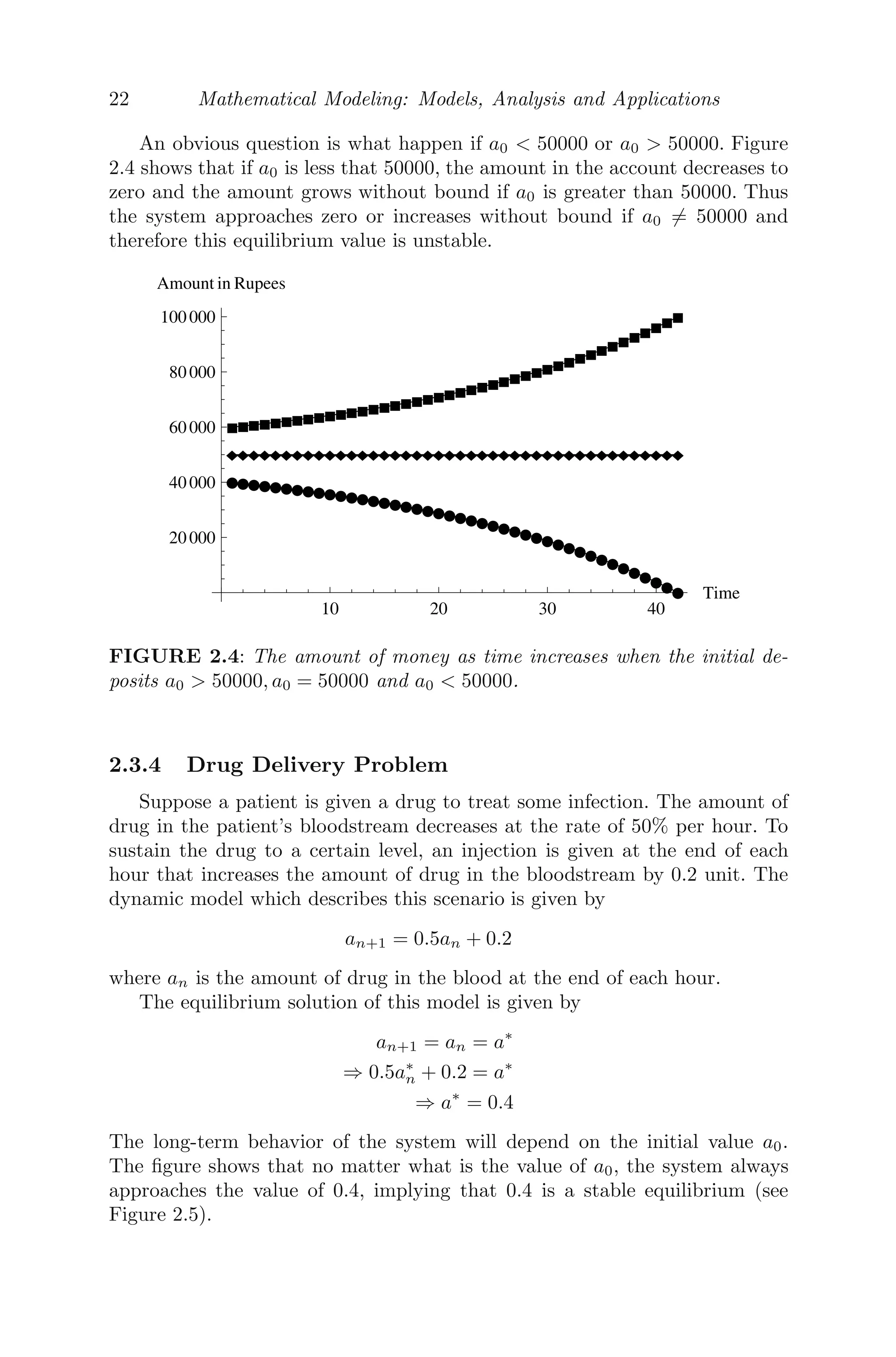
![Mathematically Modeling Discrete Processes 23
5 10 15
Time
0.2
0.4
0.6
0.8
1.0
Drug amount in the blood
FIGURE 2.5: The amount of drug in a patient’s bloodstream always reaches
the steady state value 0.4, independent of the initial value a0, implying a stable
equilibrium.
2.3.5 Economic Model (Harrod Model)
The Harrod model [89], which was developed in the 1930s, gives some in-
sight into the dynamics of economic growth. The model aims to determine
an equilibrium growth rate for the economy. Let Gn be the Gross Domestic
Product (GDP) on national income, which is one of the primary indicators to
determine a country’s economy and S(n) and I(n) be the savings and invest-
ment of the people. The Harrod model assumed that in a country people’s
savings depend on GDP or national income, that is, savings is a constant
proportion of current income, which implies
Sn = aGn (a 0) (2.6)
Harrod further assumed that the investment made by the people depends on
the difference between the GDP of the current year and the last year, that is,
In = b (Gn − Gn−1) , b a (2.7)
Finally, the Harrod model assumed that all the savings made by the people
are invested, that is,
Sn = In (2.8)
From (2.6), (2.7) and (2.8), we obtain
b (Gn − Gn−1) = Sn = a Gn
⇒ Gn =
b Gn−1
b − a
, whose solution is
Gn = G(0)
b
b − a
n](https://image.slidesharecdn.com/mathematicalmodelingmodelsanalysisandapplicationspdfdrive-211127122602/75/Mathematical-modeling-models-analysis-and-applications-pdf-drive-46-2048.jpg)
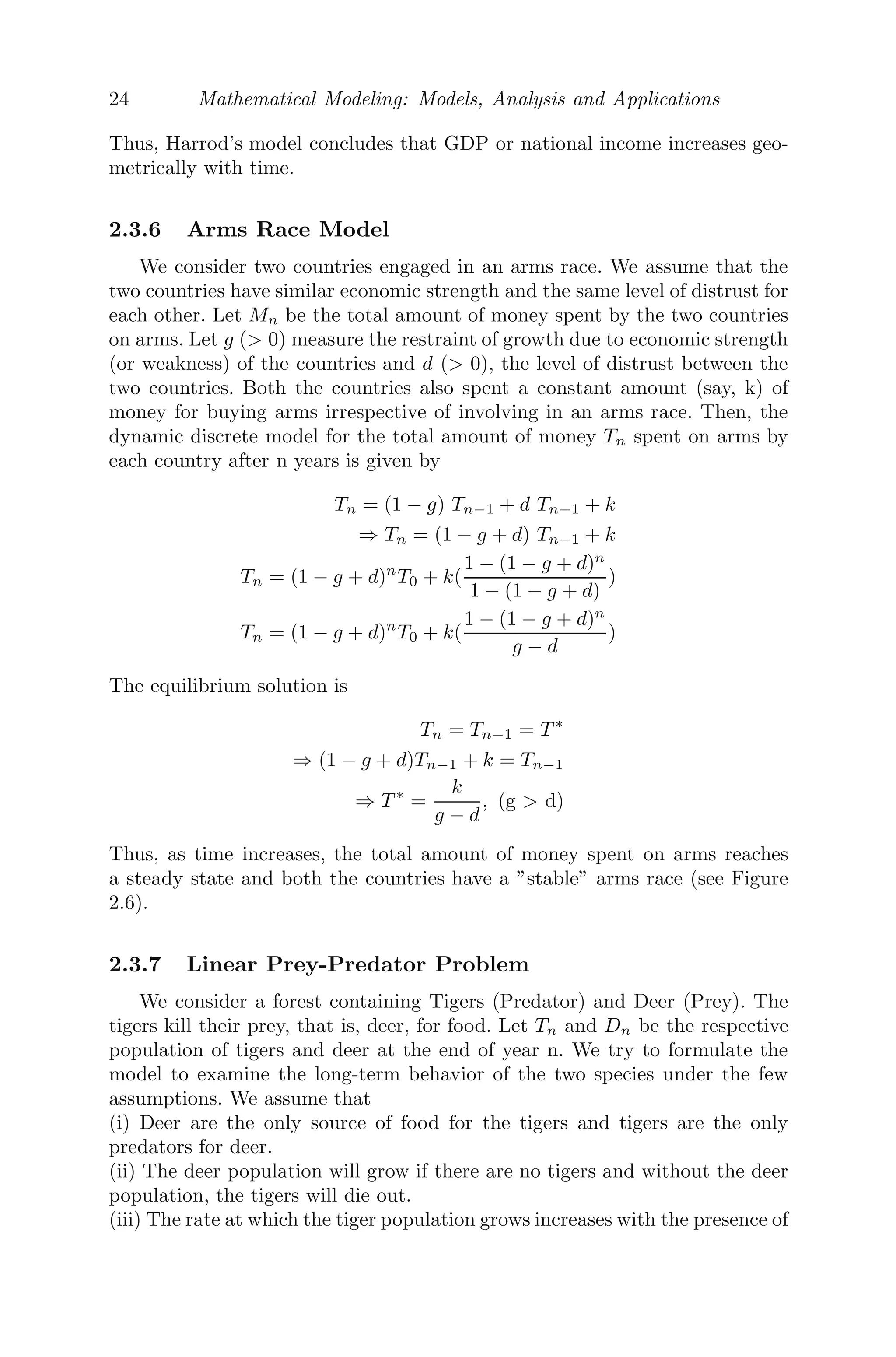
![Mathematically Modeling Discrete Processes 25
5 10 15 20
Time
50
100
150
200
Amount Spent in Crores
FIGURE 2.6: The amount of money spent by both the countries on arms
reaches a steady state value with increasing time. Parameter values g = 0.6,
d = 0.1 and k = 100.
the deer population and the rate at which the deer population grows decreases
with the presence of the tiger population.
Under these assumptions, the dynamic model for this scenario is given by
[2]
ΔTn = Tn+1 − Tn = −αTn + βDn
ΔDn = Dn+1 − Dn = γDn − δTn
where ΔTn and ΔDn are the rates of change in the tiger and deer populations
respectively and α, β, γ and δ are positive constants, 0 α, γ 1. Re-writing
them, we get the two dimensional linear discrete dynamical system as
Tn+1 = (1 − α)Tn + βDn ≡ f1(Tn, Dn)
Dn+1 = −δTn + (1 + γ)Dn ≡ f2(Tn, Dn)
Here, α is the rate at which the tigers die if no deer are available for food
and β is the rate at which the tiger population grows when the food (deer) is
available. Similarly, the deer population grows at a rate γ when no tigers are
around and decreases at a rate δ in the presence of a tiger population.
(0, 0) is the only equilibrium point. For stability, we calculate the Jacobian
matrix at (0,0), given by
1 − α β
−δ 1 + γ
.
The eigenvalues of the Jacobian matrix are 2 − α + γ −
(α + γ)2 − 4αβ
and 2 − α+ γ +
(α + γ)2 − 4αβ. For stability, both the eigenvalues must be
numerically less than 1, that is,
|2 − α + γ −
(α + γ)2 − 4αβ| 1 and |2 − α + γ +
(α + γ)2 − 4αβ| 1](https://image.slidesharecdn.com/mathematicalmodelingmodelsanalysisandapplicationspdfdrive-211127122602/75/Mathematical-modeling-models-analysis-and-applications-pdf-drive-48-2048.jpg)
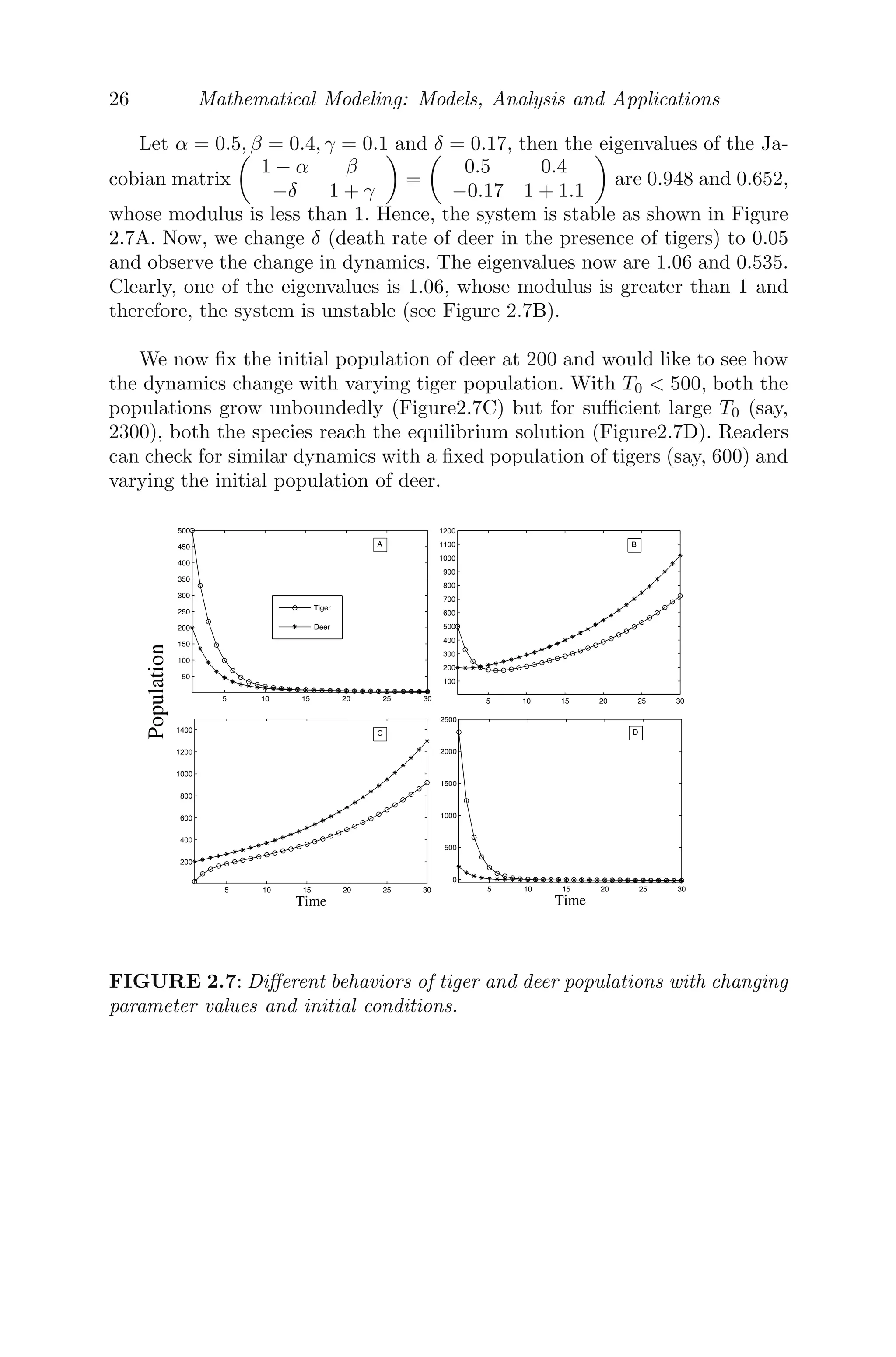
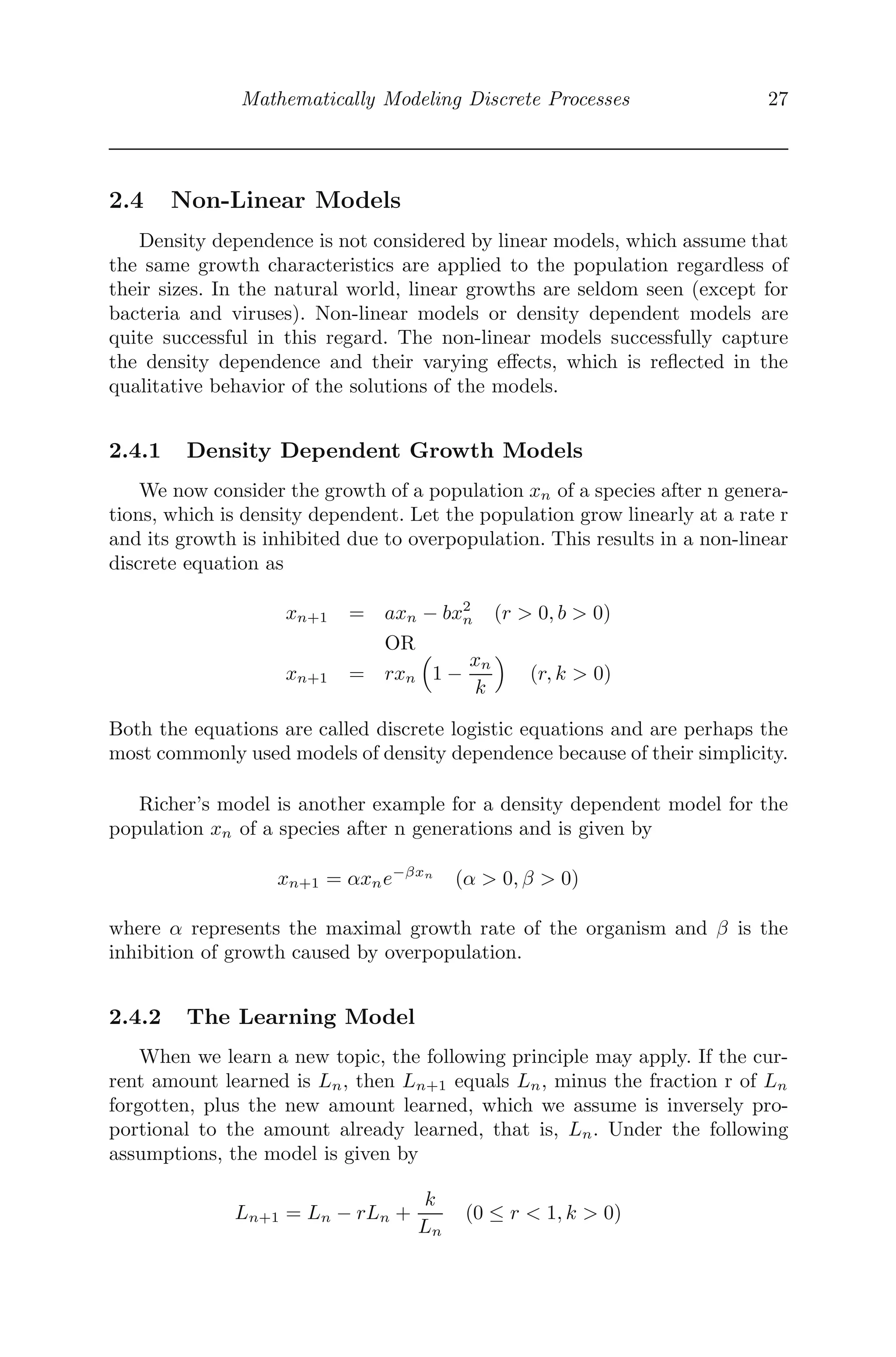

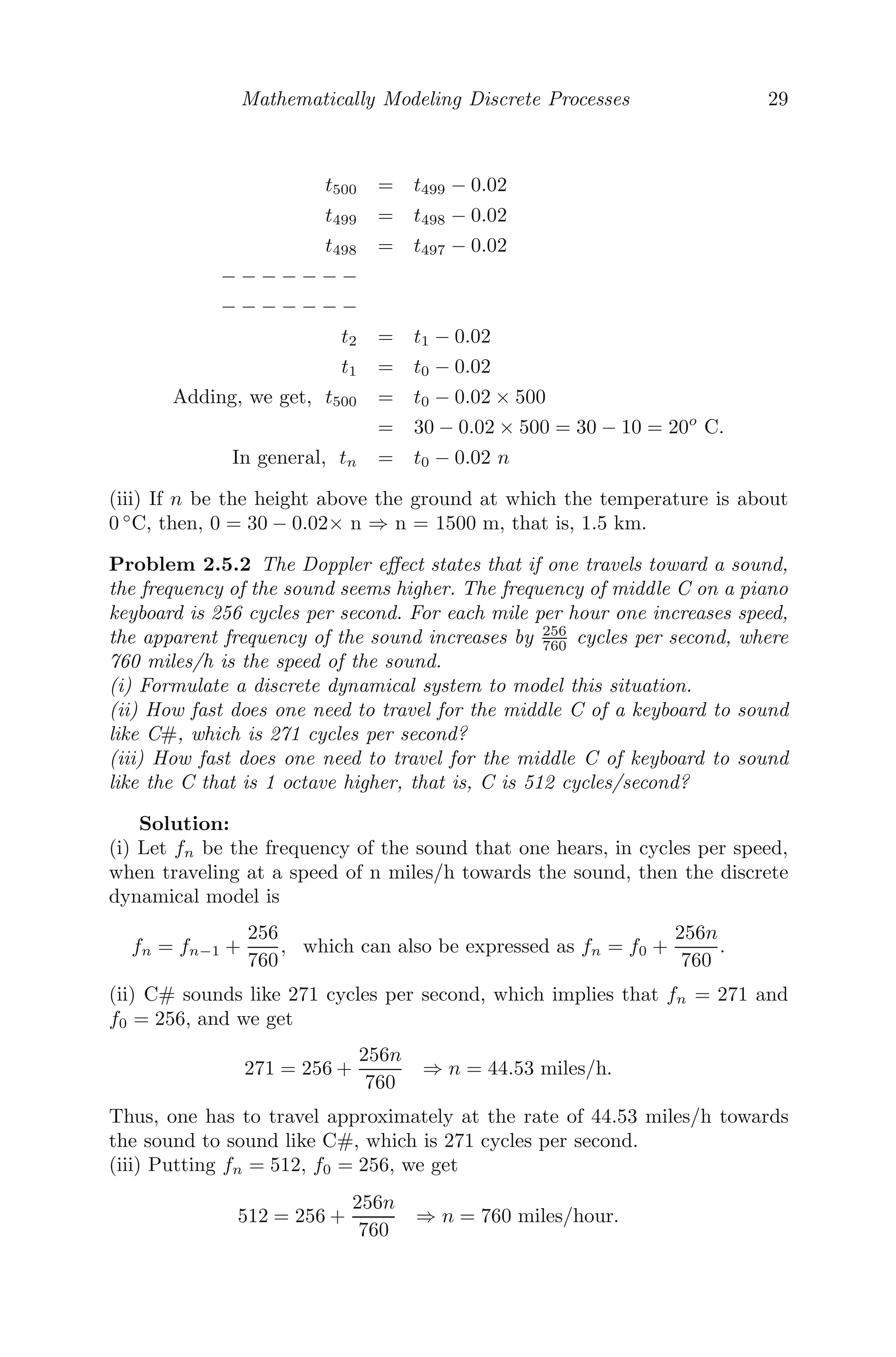
![30 Mathematical Modeling: Models, Analysis and Applications
This shows that one needs to travel at the speed of sound for the middle C of
a keyboard to sound like the C that is 1 octave higher.
Problem 2.5.3 Let Un and Vn be the total amount of pollutant in lakes A
and B respectively, in year n, and that 38% of the pollutant from lake A and
13% of the pollutant from lake B are removed every year. Also, the pollutant
that is removed from lake A is added to lake B due to the flow of water from
lake A to lake B. Also it is assumed that 3 tons of pollutant are directly added
to lake A and 9 tons of pollutant are added to lake B [115].
(i) Develop a discrete dynamical system from the above information. Find the
equilibrium points and state whether they are stable or not.
(ii) Suppose it is determined that an equilibrium level of a total of 10 tons
of pollutant in lake A and a total of 30 tons in lake B would be acceptable.
What restrictions should be placed upon the total amounts of pollutants that
are added directly, so that these equilibria can be achieved?
Solution: From the schematic diagram (see Figure 2.8), the discrete dy-
namical system is formulated as
FIGURE 2.8: The schematic diagram of Problem 2.5.3, where Un and Vn
are the total amount of pollutant in lakes A and B respectively, in year n.
Un = Un−1 − 0.38Un−1 + 3
Vn = Vn−1 + 0.38Un−1 − 0.13Vn−1 + 9,
where Un and Vn are the total amounts of pollutants in lake A and lake B
respectively, in year n. The equilibrium point is obtained by solving](https://image.slidesharecdn.com/mathematicalmodelingmodelsanalysisandapplicationspdfdrive-211127122602/75/Mathematical-modeling-models-analysis-and-applications-pdf-drive-53-2048.jpg)
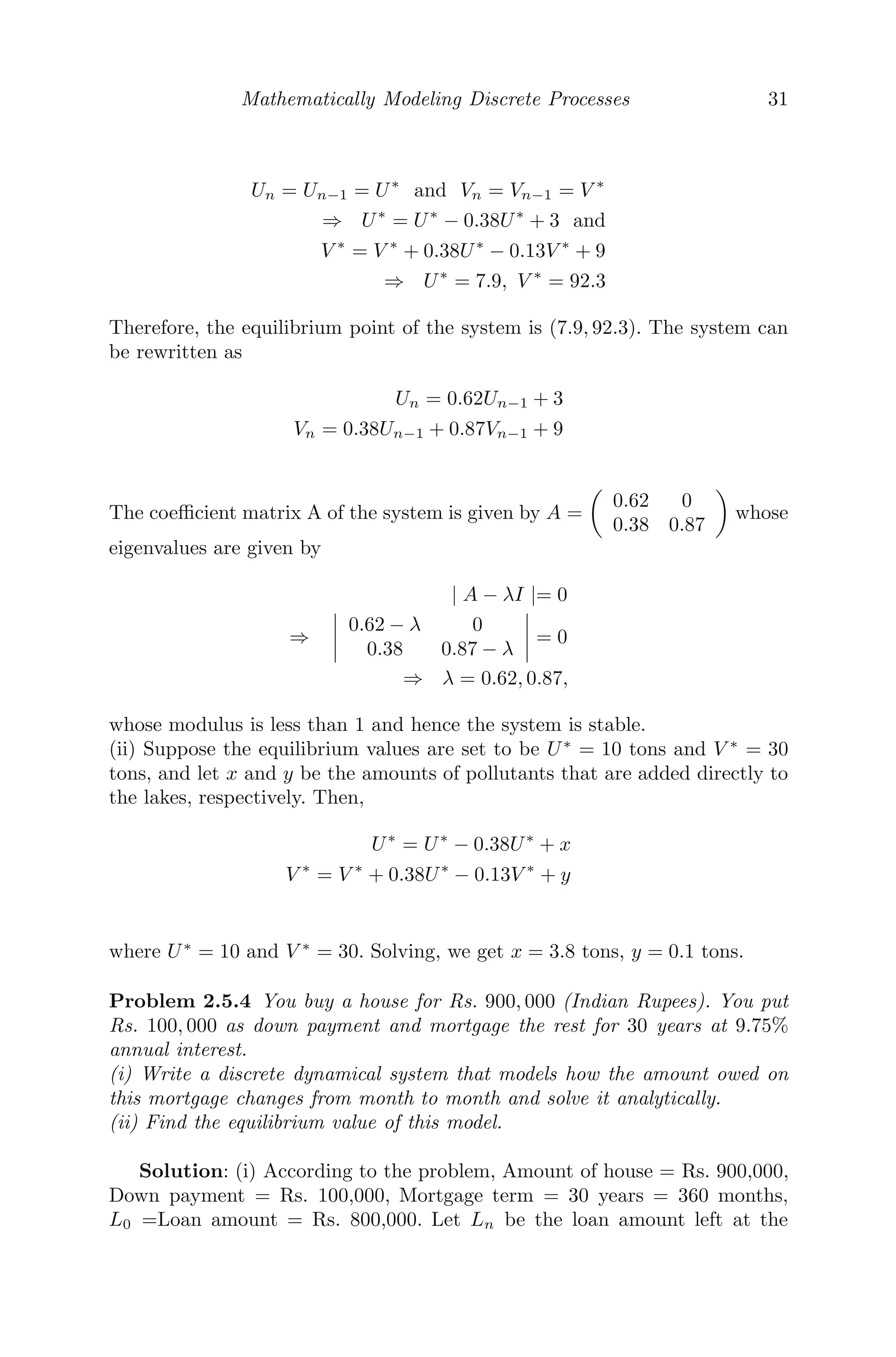
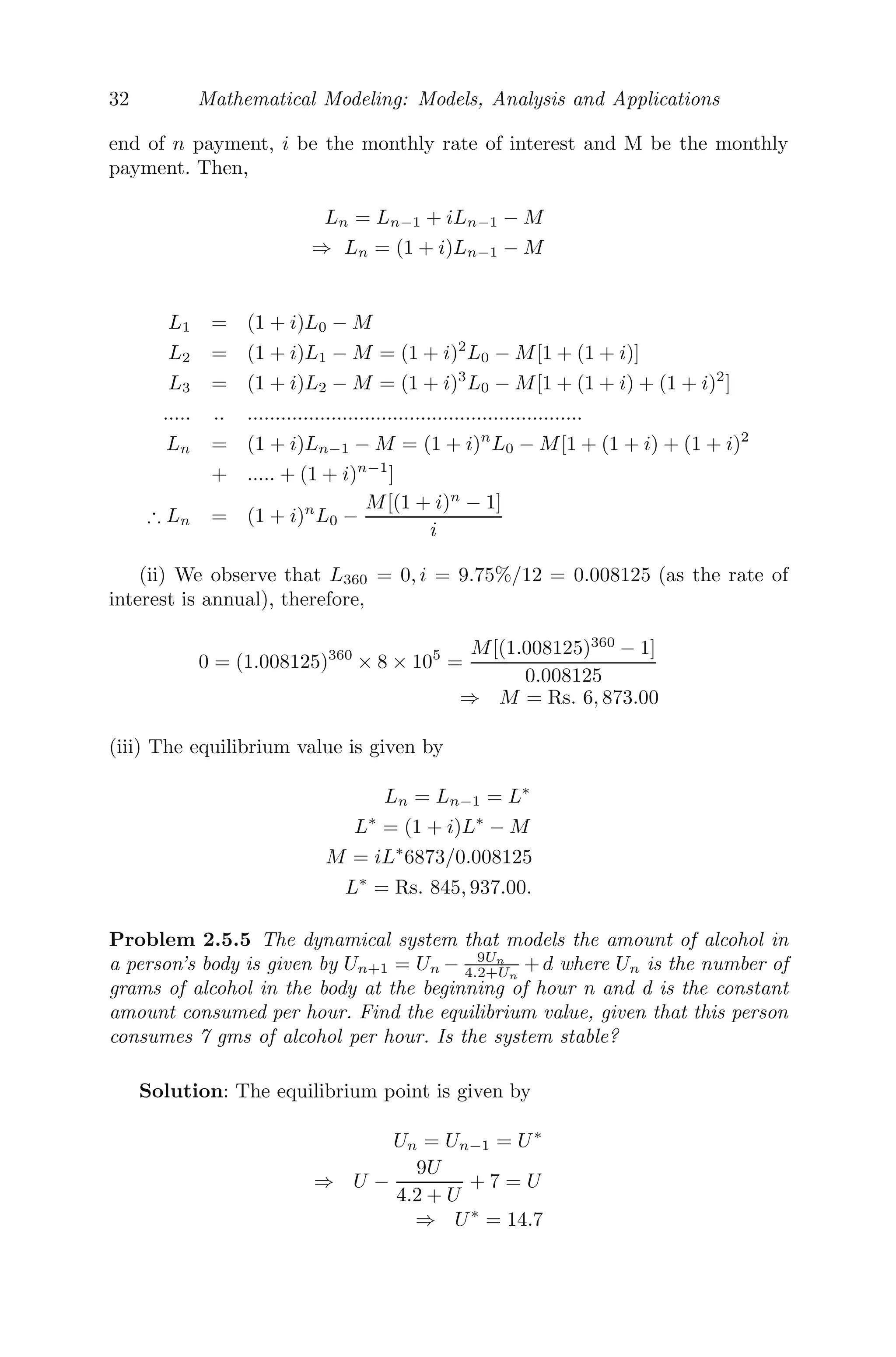
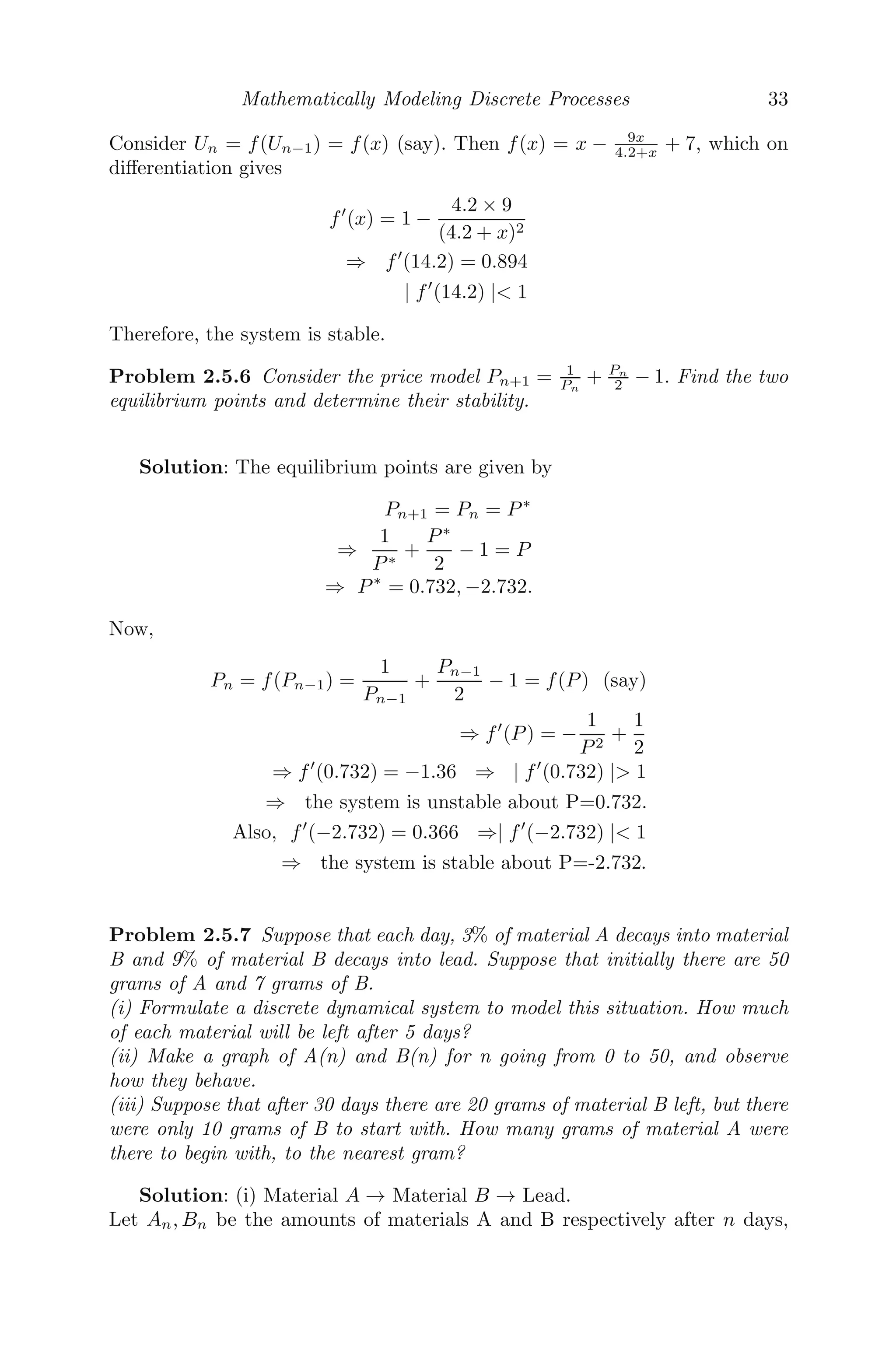


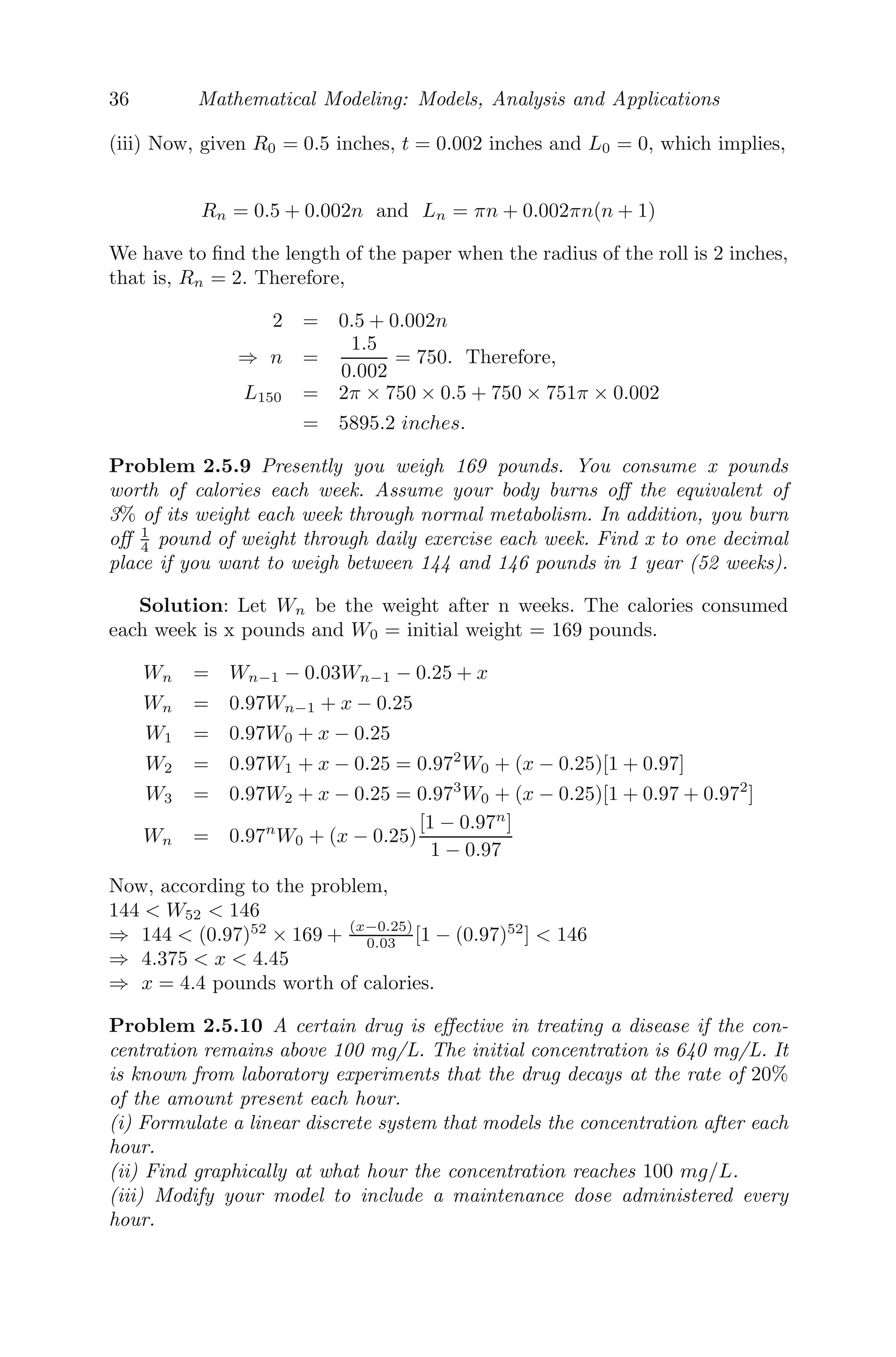
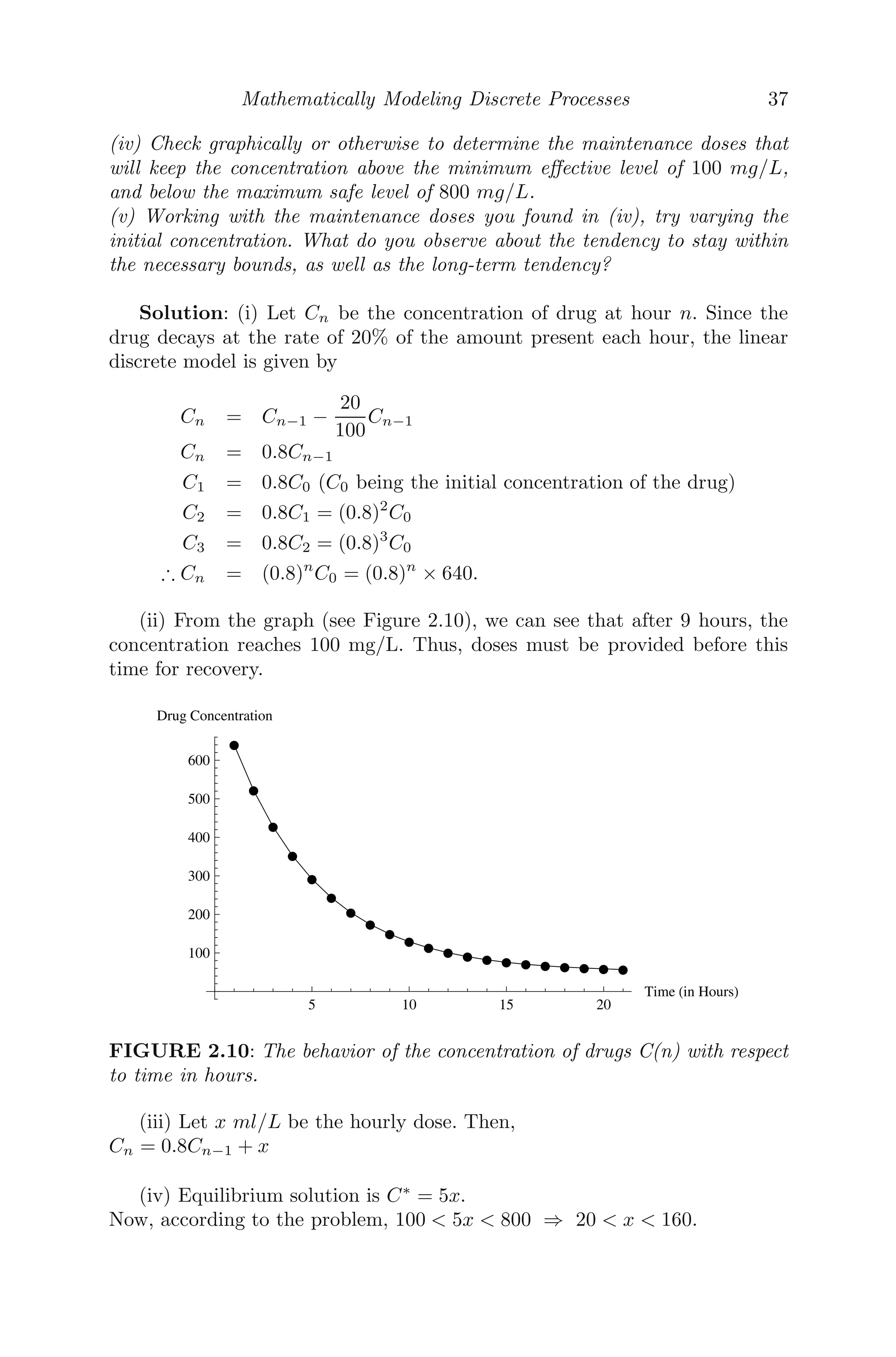

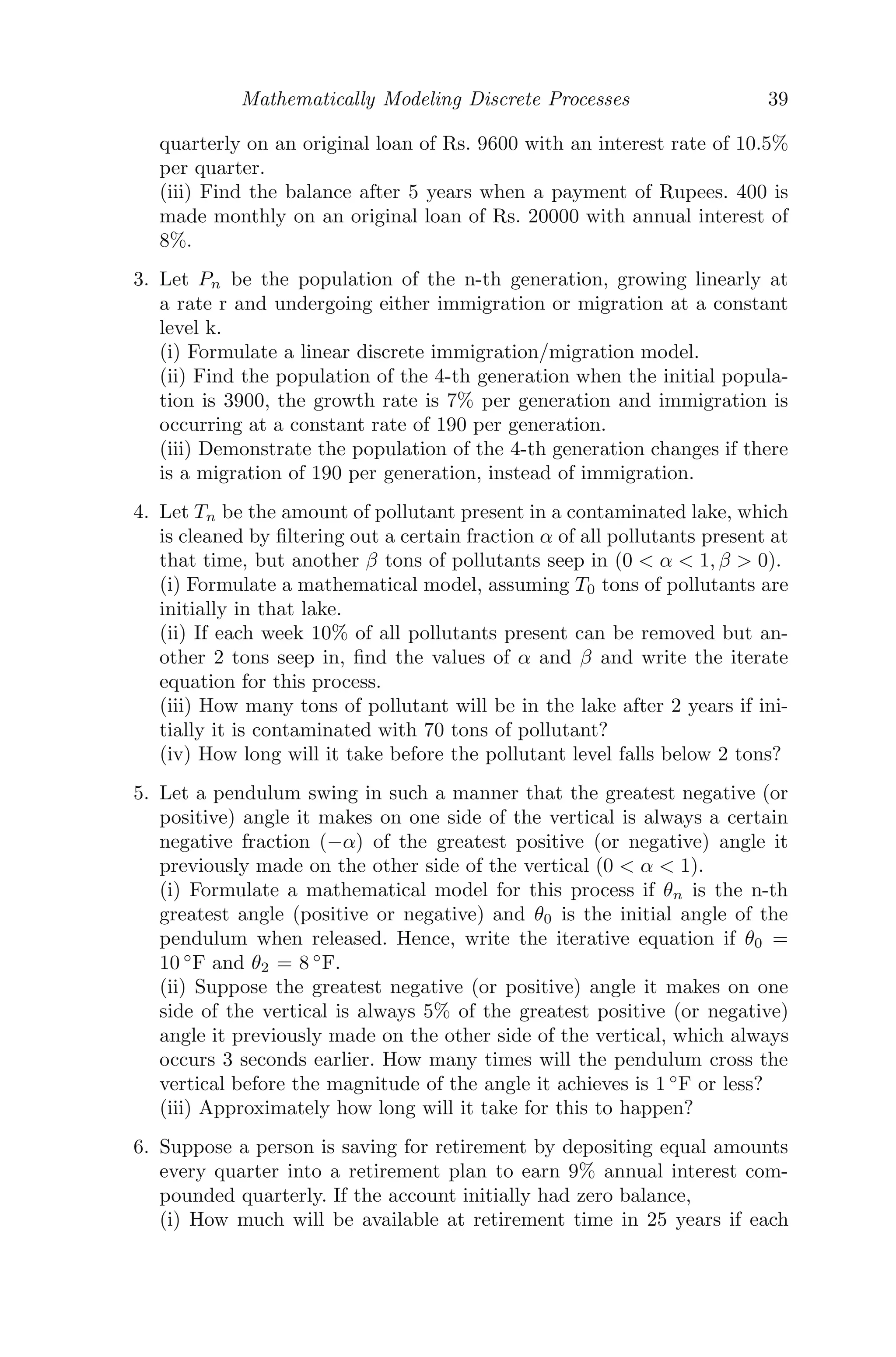
![32 Mathematical Modeling: Models, Analysis and Applications
end of n payment, i be the monthly rate of interest and M be the monthly
payment. Then,
Ln = Ln−1 + iLn−1 − M
⇒ Ln = (1 + i)Ln−1 − M
L1 = (1 + i)L0 − M
L2 = (1 + i)L1 − M = (1 + i)2
L0 − M[1 + (1 + i)]
L3 = (1 + i)L2 − M = (1 + i)3
L0 − M[1 + (1 + i) + (1 + i)2
]
..... .. ............................................................
Ln = (1 + i)Ln−1 − M = (1 + i)n
L0 − M[1 + (1 + i) + (1 + i)2
+ ..... + (1 + i)n−1
]
∴ Ln = (1 + i)n
L0 −
M[(1 + i)n
− 1]
i
(ii) We observe that L360 = 0, i = 9.75%/12 = 0.008125 (as the rate of
interest is annual), therefore,
0 = (1.008125)360
× 8 × 105
=
M[(1.008125)360
− 1]
0.008125
⇒ M = Rs. 6, 873.00
(iii) The equilibrium value is given by
Ln = Ln−1 = L∗
L∗
= (1 + i)L∗
− M
M = iL∗
6873/0.008125
L∗
= Rs. 845, 937.00.
Problem 2.5.5 The dynamical system that models the amount of alcohol in
a person’s body is given by Un+1 = Un − 9Un
4.2+Un
+d where Un is the number of
grams of alcohol in the body at the beginning of hour n and d is the constant
amount consumed per hour. Find the equilibrium value, given that this person
consumes 7 gms of alcohol per hour. Is the system stable?
Solution: The equilibrium point is given by
Un = Un−1 = U∗
⇒ U −
9U
4.2 + U
+ 7 = U
⇒ U∗
= 14.7](https://image.slidesharecdn.com/mathematicalmodelingmodelsanalysisandapplicationspdfdrive-211127122602/75/Mathematical-modeling-models-analysis-and-applications-pdf-drive-63-2048.jpg)
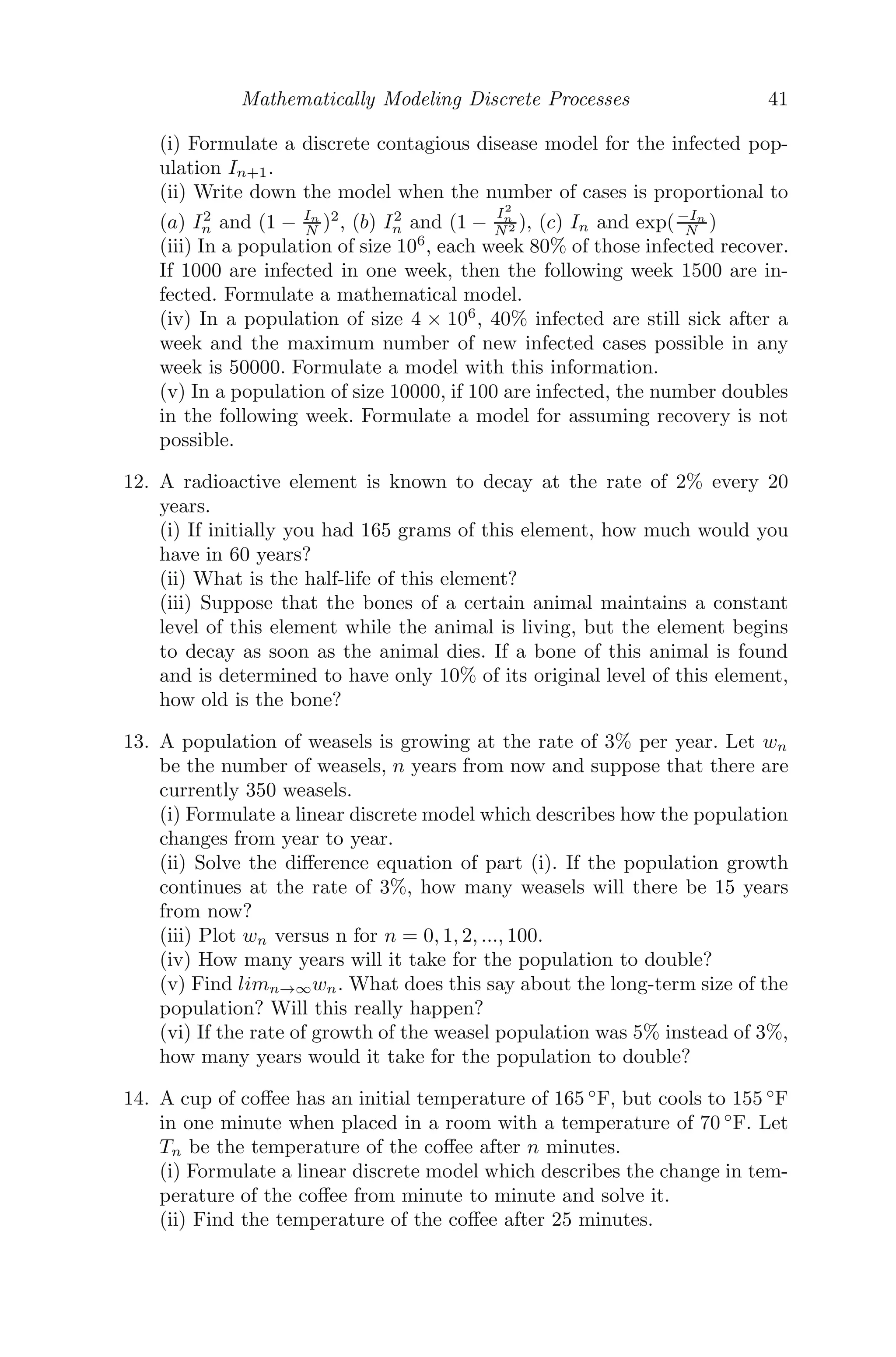
![34 Mathematical Modeling: Models, Analysis and Applications
A0, B0− be the amounts of materials A and B initially present and a, b are
the rates of decay of A and B. Then, according to the problem, we get
An = An−1 − aAn−1
Bn = Bn−1 − bBn−1 + aAn−1
An = (1 − a)An−1
A1 = (1 − a)A0
A2 = (1 − a)A1 = (1 − a)2
A0
A3 = (1 − a)A2 = (1 − a)3
A0
∴ An = (1 − a)n
A0
B1 = (1 − b)B0 + aA0
B2 = (1 − b)B1 + aA1 = [(1 − b)2
B0 + a(1 − b)A0] + a(1 − b)A0
B3 = (1 − b)B2 + aA2 = (1 − b)3
B0 + a(1 − b)2
A0 + a(1 − a)(1 − b)A0
+ a(1 − a)2
A0
Bn = (1 − b)2
B0 + aA0[(1 − b)n−1
+ (1 − b)n−2
(1 − a) + ... + (1 − a)n−1
]
Bn = (1 − b)n
B0 +
a[(1 − b)n
− (1 − a)n
]
a − b
Given a = 3%, b = 9%, A0 = 50 g, B0 = 7 g. Therefore, after 5 days the
amounts of material that will be left are
A5 = (0.97)5
50 = 42.949 g
B5 = (0.91)5
× 7 +
0.03 × 50(0.975
− 0.915
)
0.06
= 10.24 g.
(ii) From Figure 2.9, it is clear that material A slowly decreases, whereas
material B increases till n = 20 and then slowly decreases.
(iii) Here, a = 0.03, b = 0.09, B30 = 20 and B0 = 10
B30 = (1 − 0.09)30
× 10 +
0.03 × A0(0.9730
− 0.9130
)
0.06
= 20
A0 = 113.51 ≈ 114 g.
Problem 2.5.8 Suppose you have a roll of paper, such as paper towels. Let
the radius of the cardboard core be 0.5 inches. Suppose the paper is 0.002 inches
thick. Let r(n) represent the radius, in inches, of the roll when the paper has
been wrapped around the core n times. Let l(n) be the total length of the paper
when it is wrapped about the core n times. Note that r(0)=0.5 and l(0)=0.
Remember, the circumference of a circle is given by c = 2πr.
(i) Develop a dynamical system for r(n) in terms of r(n-1).
(ii) Develop a dynamical system for l(n) in terms of r(n-1) and l(n-1).
(iii) What is the length of paper on the roll when it has a radius of 2 inches?](https://image.slidesharecdn.com/mathematicalmodelingmodelsanalysisandapplicationspdfdrive-211127122602/75/Mathematical-modeling-models-analysis-and-applications-pdf-drive-65-2048.jpg)

![36 Mathematical Modeling: Models, Analysis and Applications
(iii) Now, given R0 = 0.5 inches, t = 0.002 inches and L0 = 0, which implies,
Rn = 0.5 + 0.002n and Ln = πn + 0.002πn(n + 1)
We have to find the length of the paper when the radius of the roll is 2 inches,
that is, Rn = 2. Therefore,
2 = 0.5 + 0.002n
⇒ n =
1.5
0.002
= 750. Therefore,
L150 = 2π × 750 × 0.5 + 750 × 751π × 0.002
= 5895.2 inches.
Problem 2.5.9 Presently you weigh 169 pounds. You consume x pounds
worth of calories each week. Assume your body burns off the equivalent of
3% of its weight each week through normal metabolism. In addition, you burn
off 1
4 pound of weight through daily exercise each week. Find x to one decimal
place if you want to weigh between 144 and 146 pounds in 1 year (52 weeks).
Solution: Let Wn be the weight after n weeks. The calories consumed
each week is x pounds and W0 = initial weight = 169 pounds.
Wn = Wn−1 − 0.03Wn−1 − 0.25 + x
Wn = 0.97Wn−1 + x − 0.25
W1 = 0.97W0 + x − 0.25
W2 = 0.97W1 + x − 0.25 = 0.972
W0 + (x − 0.25)[1 + 0.97]
W3 = 0.97W2 + x − 0.25 = 0.973
W0 + (x − 0.25)[1 + 0.97 + 0.972
]
Wn = 0.97n
W0 + (x − 0.25)
[1 − 0.97n
]
1 − 0.97
Now, according to the problem,
144 W52 146
⇒ 144 (0.97)52
× 169 + (x−0.25)
0.03 [1 − (0.97)52
] 146
⇒ 4.375 x 4.45
⇒ x = 4.4 pounds worth of calories.
Problem 2.5.10 A certain drug is effective in treating a disease if the con-
centration remains above 100 mg/L. The initial concentration is 640 mg/L. It
is known from laboratory experiments that the drug decays at the rate of 20%
of the amount present each hour.
(i) Formulate a linear discrete system that models the concentration after each
hour.
(ii) Find graphically at what hour the concentration reaches 100 mg/L.
(iii) Modify your model to include a maintenance dose administered every
hour.](https://image.slidesharecdn.com/mathematicalmodelingmodelsanalysisandapplicationspdfdrive-211127122602/75/Mathematical-modeling-models-analysis-and-applications-pdf-drive-67-2048.jpg)
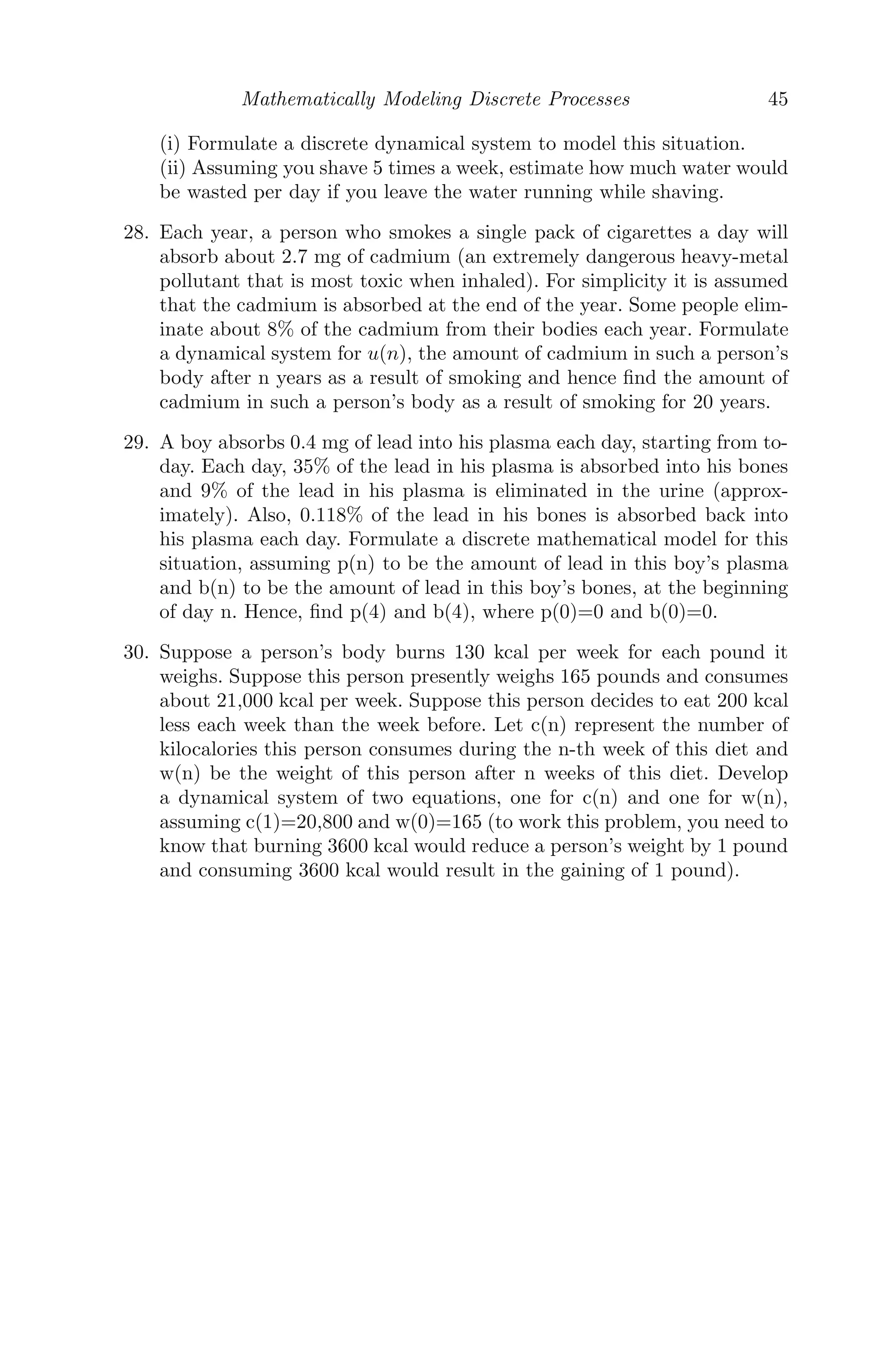

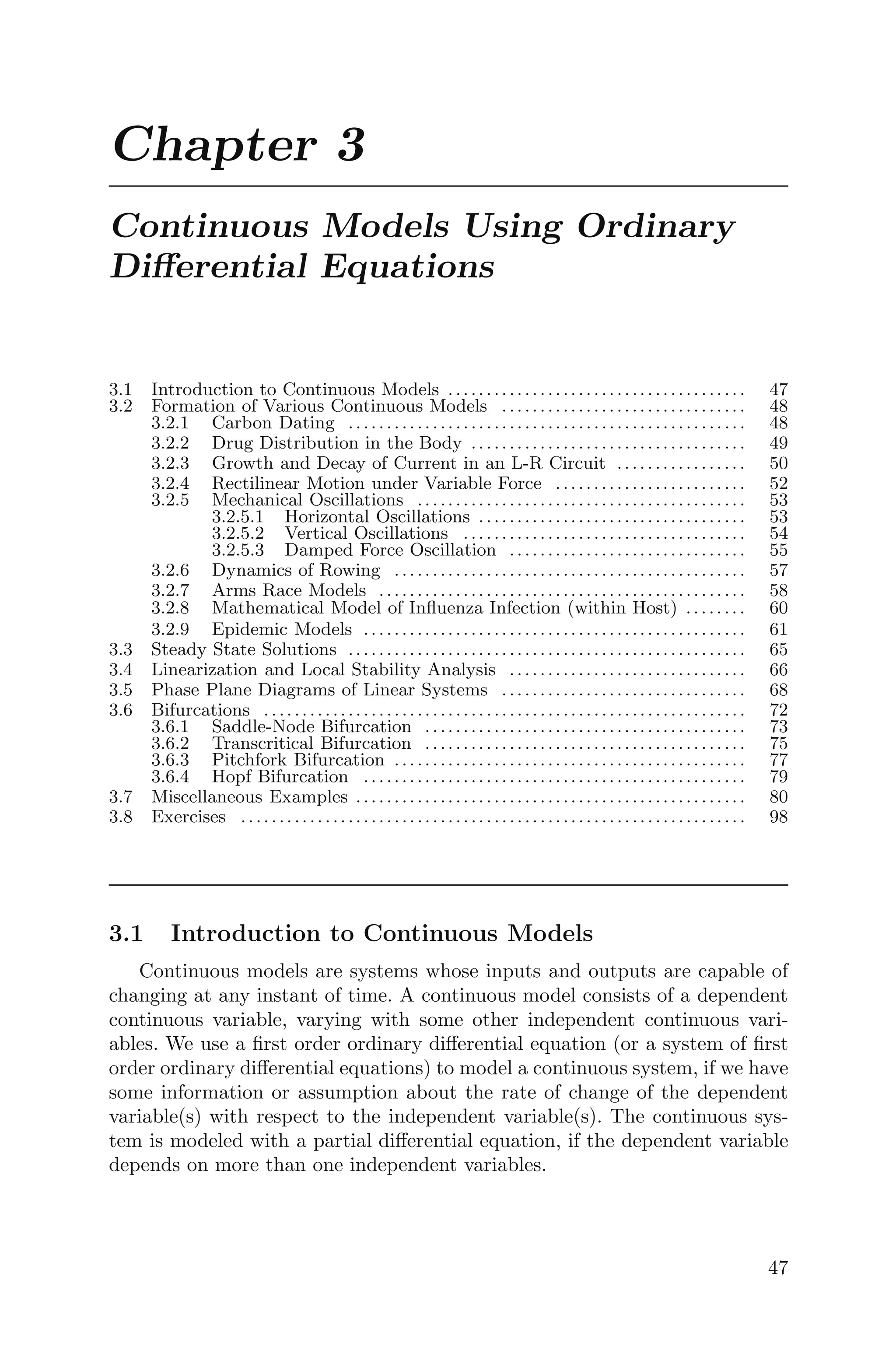

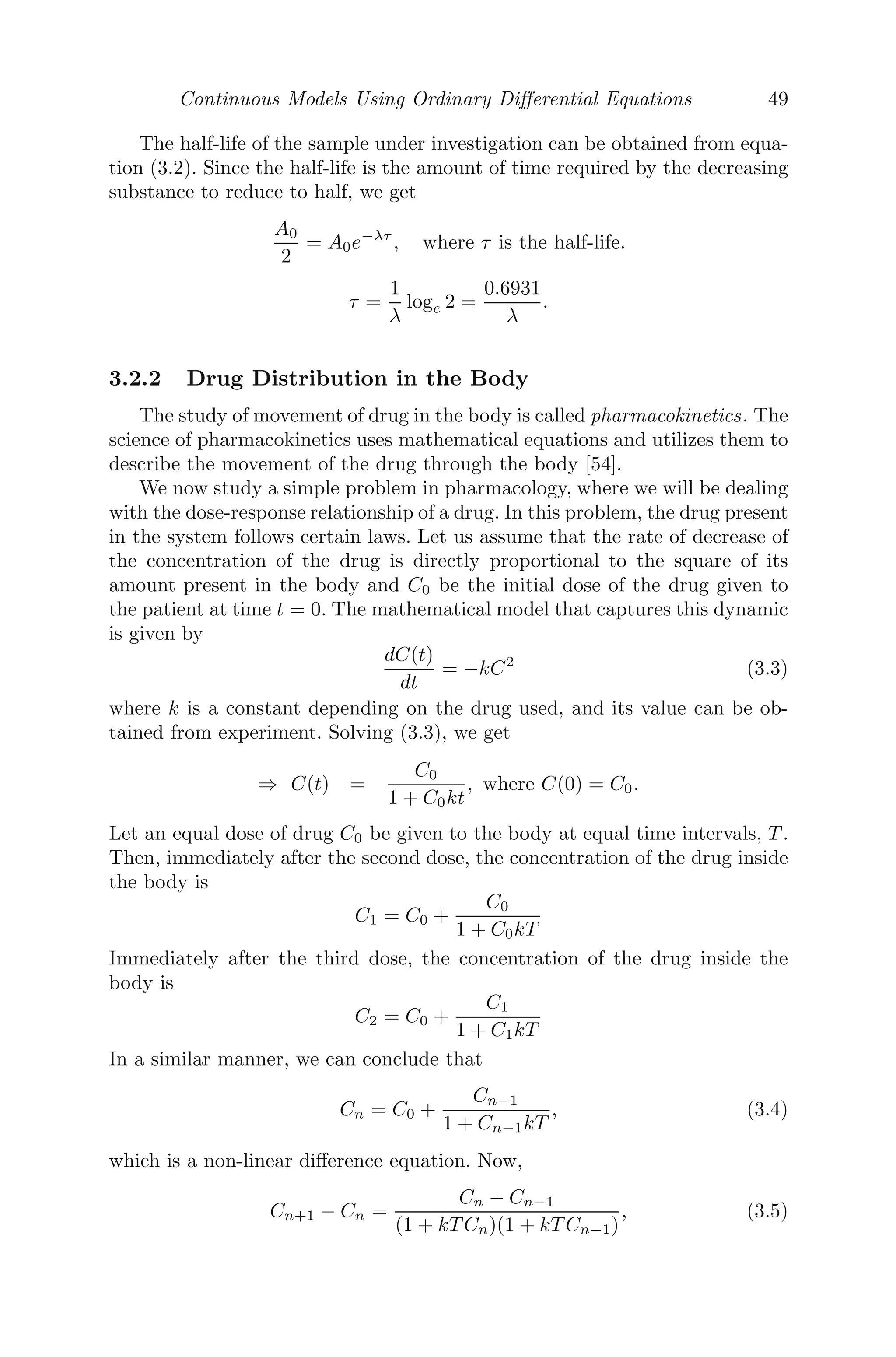
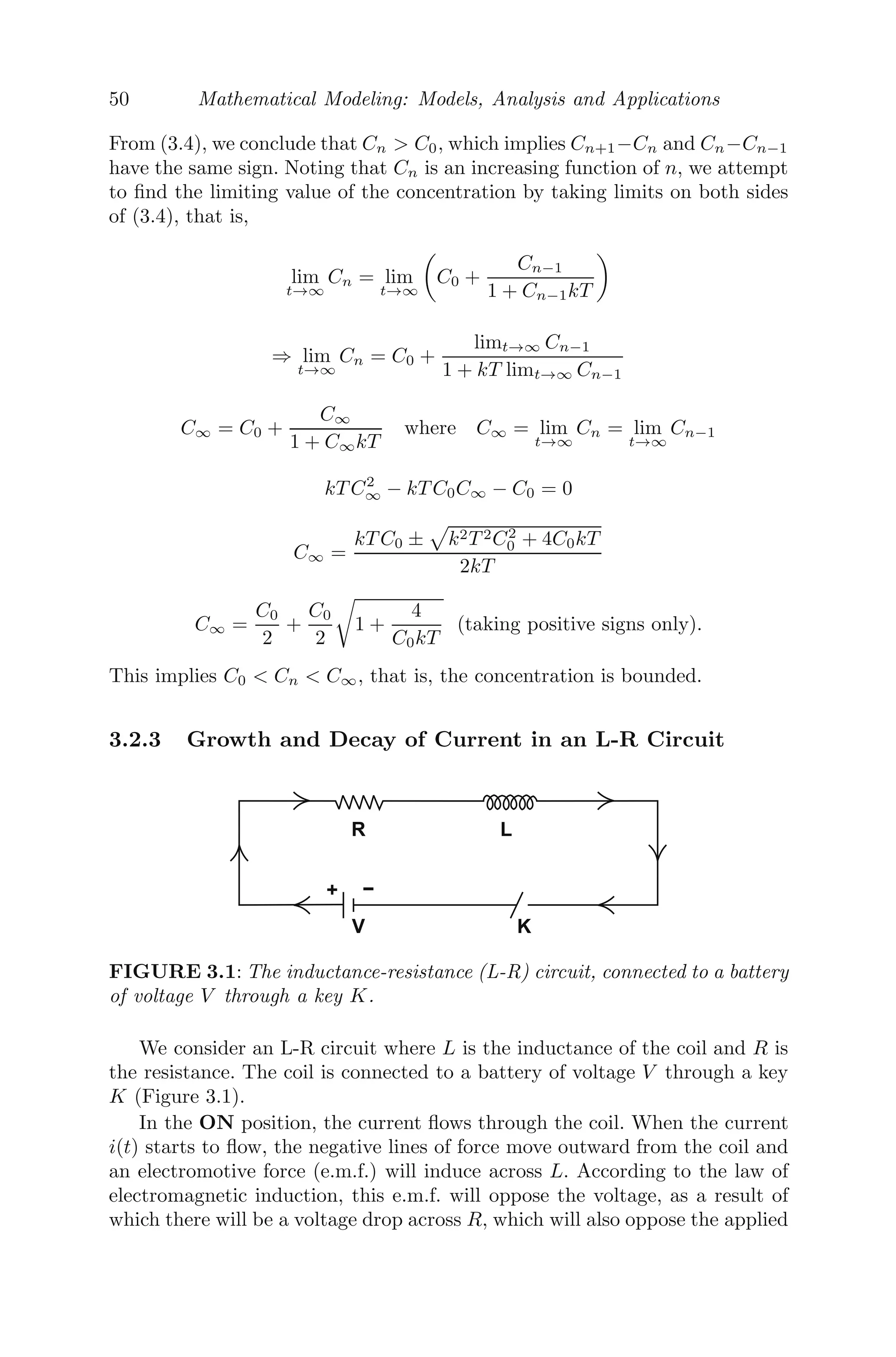
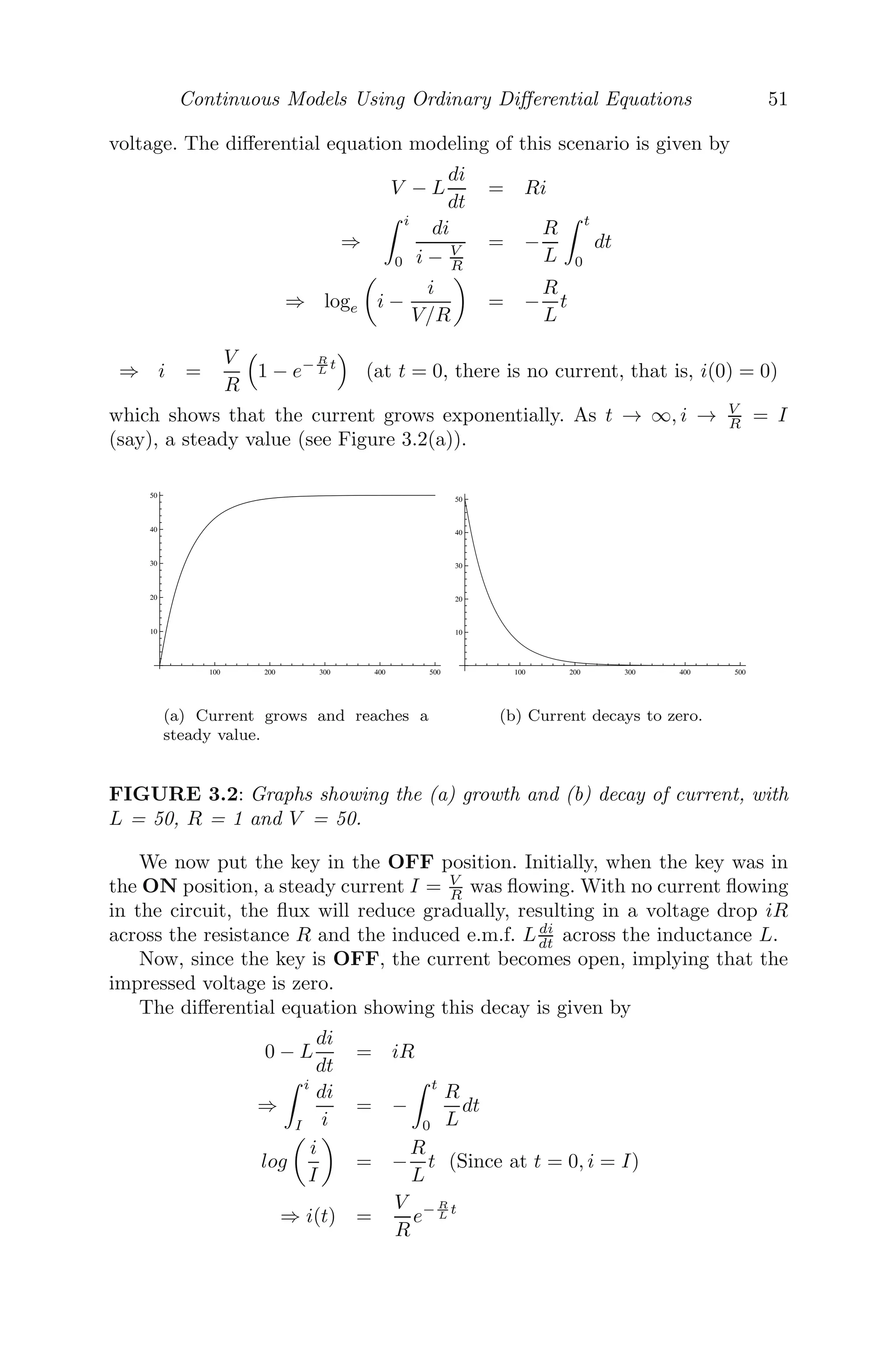
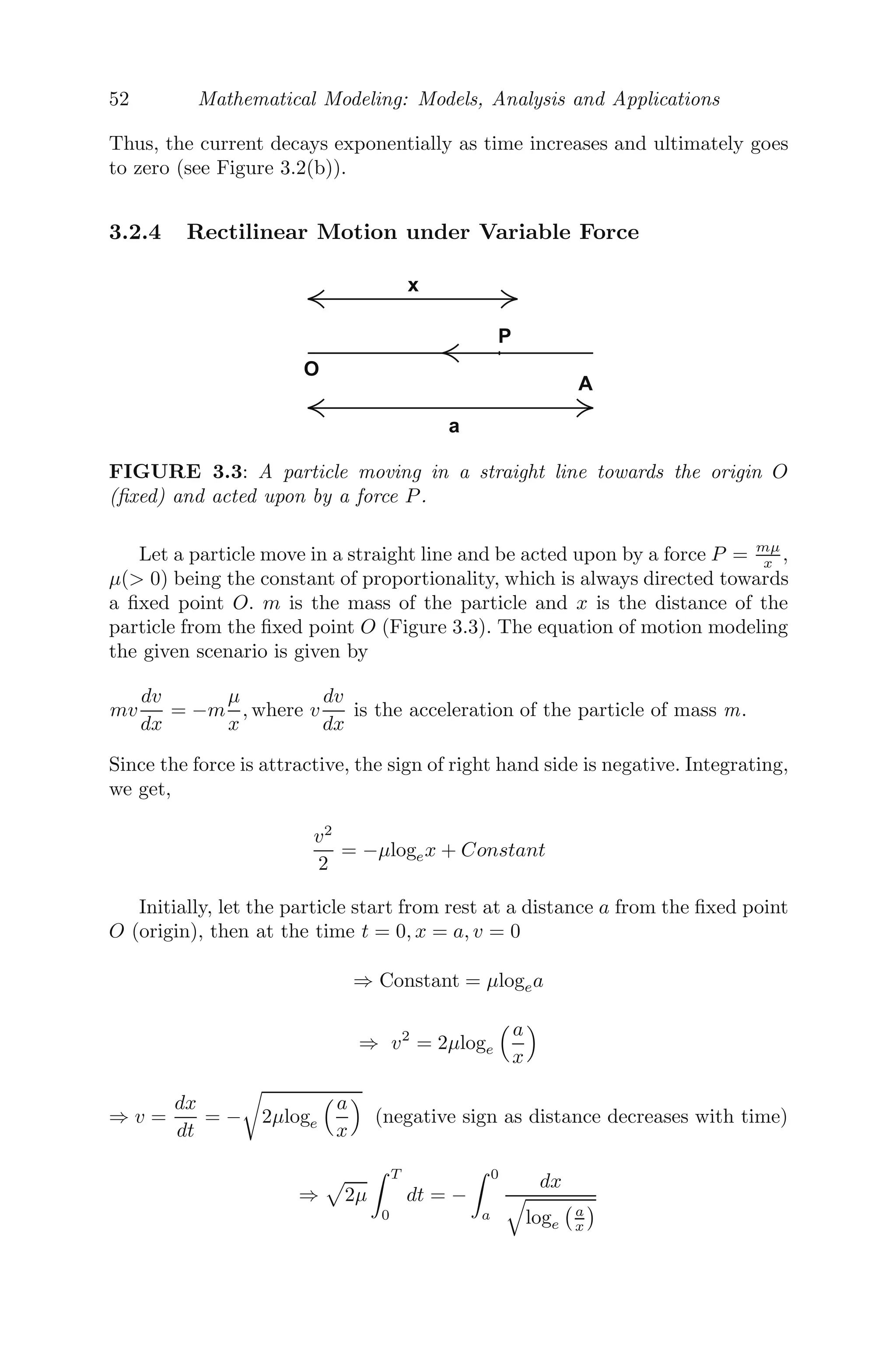
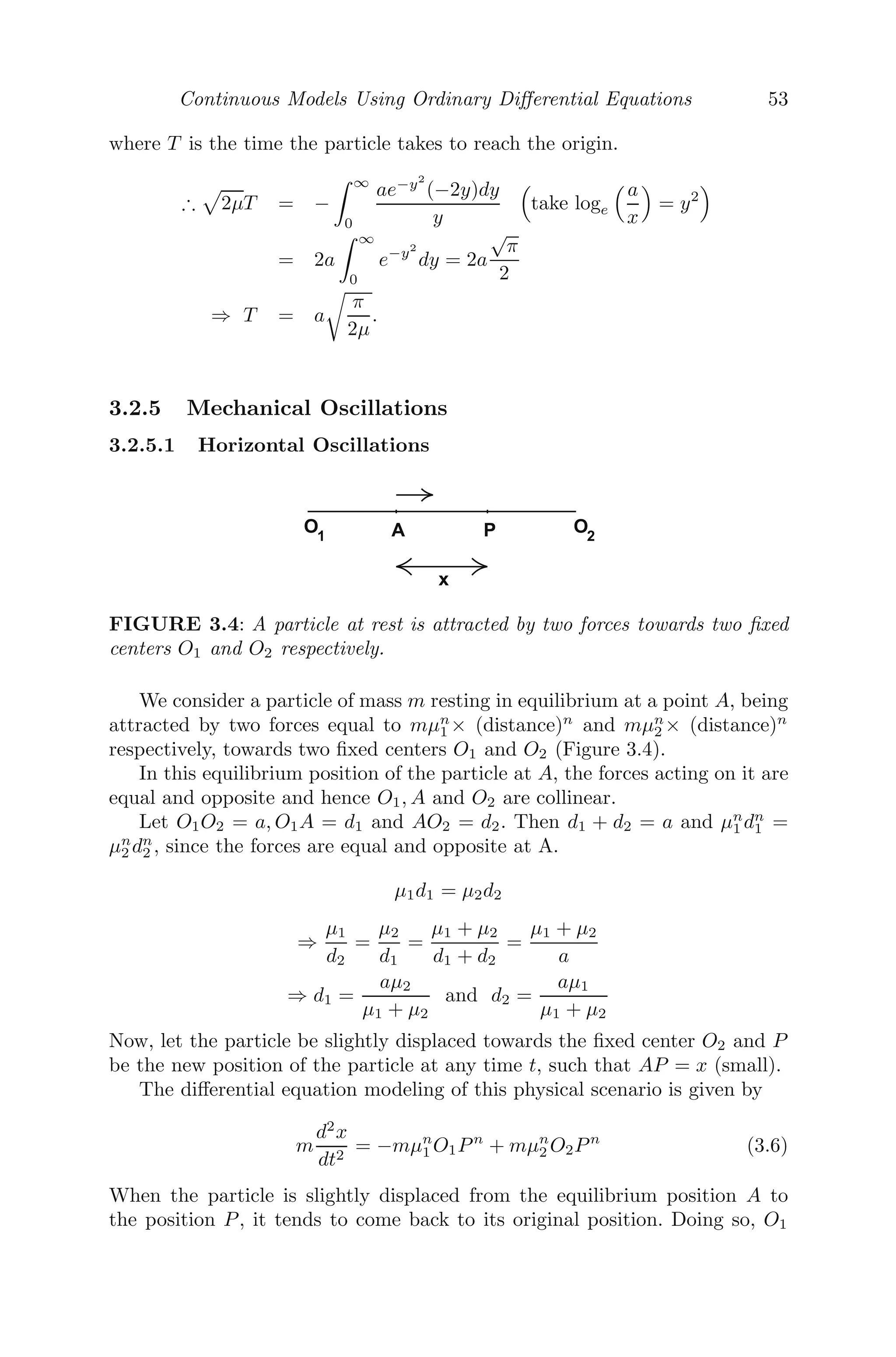
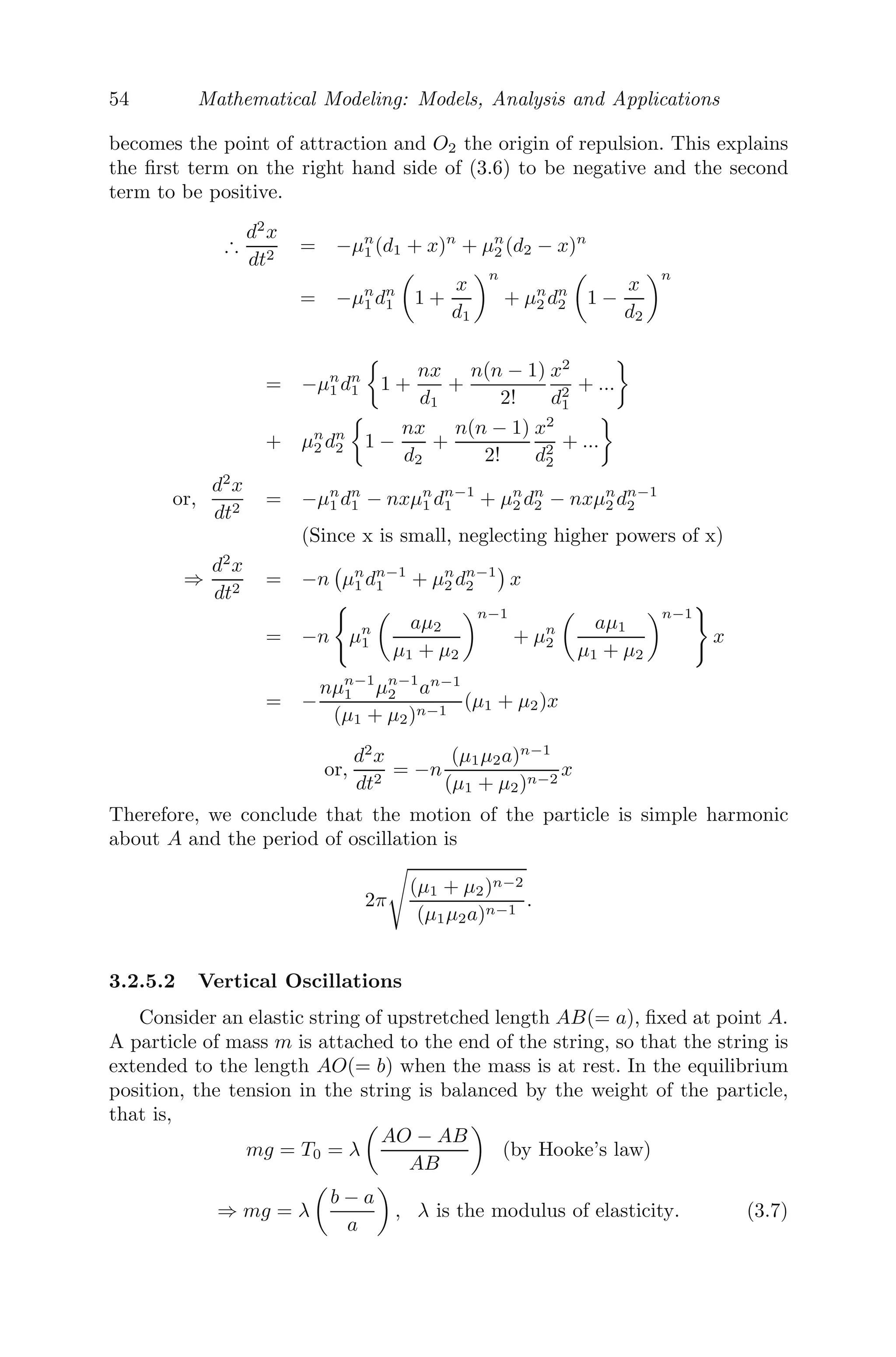
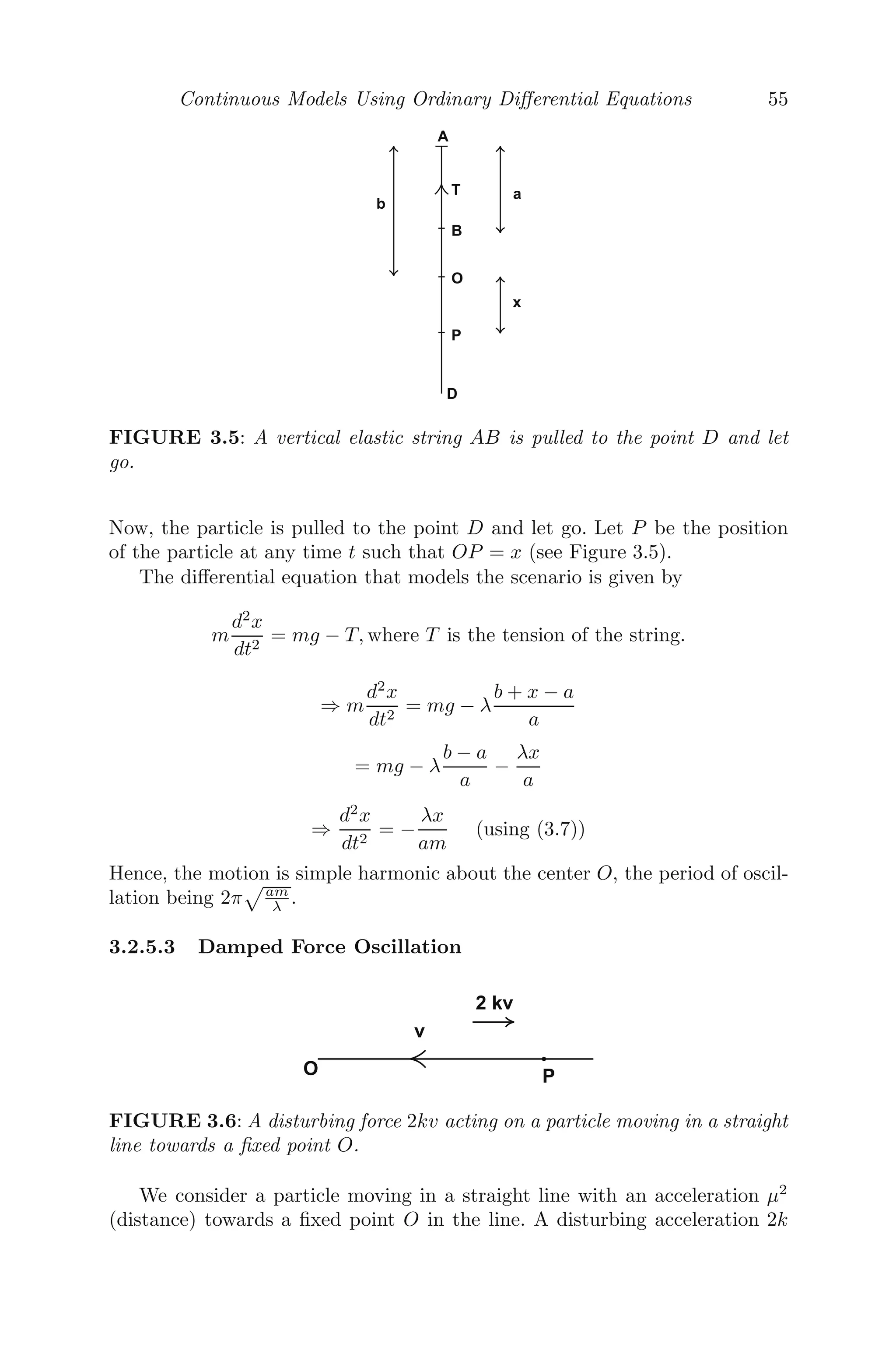
![48 Mathematical Modeling: Models, Analysis and Applications
3.2 Formation of Various Continuous Models
3.2.1 Carbon Dating
Carbon dating (Carbon 14 dating) is a method, developed by W.F. Libby
at the University of Chicago in 1947 [76], that can be used to accurately
date archaeological samples to determine the ages of plant (wood fossil) or
any material which got its carbon from air. Carbon 14 (C14
), a radioactive
isotope of carbon, is a result of constant bombardment by radiation from the
sun in the atmosphere. During this bombardment, neutrons hit nitrogen 14
atoms and transmute them to carbon.
In a living organism, the absorption rate of C14
balances the disintegration
rate of C14
. When the organism dies and the body is preserved, it does not
absorb C14
but disintegration continues. As mentioned before, C14
is radioac-
tive in nature and has a half-life (the time taken by a substance undergoing
decay to decrease to half) of 5730 years. Scientists use this information. The
method of carbon dating involves measuring the strength of C14
archaeolog-
ical samples or fossils and then comparing it with the expected strength of
C14
in the atmosphere, to calculate the accurate age.
Suppose an archaeological sample was found whose age needs to be deter-
mined. Let A(t) be the amount of C14
present in the sample at any time t,
then
dA
dt
= −λA (following radioactive decay law) (3.1)
where λ is the decay constant of the sample.
Integrating, we get,
A(t) = A0e−λt
,
where A0 = A(0) is the amount of C14
present in the sample when it was dis-
covered. From equation (3.1), we can obtain the present ratio of disintegration
of C14
in the archaeological sample, given by
M(t) = −
dA
dt
= λA0e−λt
⇒
M(t)
M(0)
= e−λt
, M(0) = λA0,
being the original rate of disintegration.
⇒ t =
1
λ
log
M(0)
M(t)
. (3.2)
From (3.2), we can determine the age, provided we can measure M(t) and
M(0). M(0) should be equal to the rate of disintegration of C14
in a compa-
rable amount of archaeological sample or fossil (living wood).](https://image.slidesharecdn.com/mathematicalmodelingmodelsanalysisandapplicationspdfdrive-211127122602/75/Mathematical-modeling-models-analysis-and-applications-pdf-drive-79-2048.jpg)
![Continuous Models Using Ordinary Differential Equations 49
The half-life of the sample under investigation can be obtained from equa-
tion (3.2). Since the half-life is the amount of time required by the decreasing
substance to reduce to half, we get
A0
2
= A0e−λτ
, where τ is the half-life.
τ =
1
λ
loge 2 =
0.6931
λ
.
3.2.2 Drug Distribution in the Body
The study of movement of drug in the body is called pharmacokinetics. The
science of pharmacokinetics uses mathematical equations and utilizes them to
describe the movement of the drug through the body [54].
We now study a simple problem in pharmacology, where we will be dealing
with the dose-response relationship of a drug. In this problem, the drug present
in the system follows certain laws. Let us assume that the rate of decrease of
the concentration of the drug is directly proportional to the square of its
amount present in the body and C0 be the initial dose of the drug given to
the patient at time t = 0. The mathematical model that captures this dynamic
is given by
dC(t)
dt
= −kC2
(3.3)
where k is a constant depending on the drug used, and its value can be ob-
tained from experiment. Solving (3.3), we get
⇒ C(t) =
C0
1 + C0kt
, where C(0) = C0.
Let an equal dose of drug C0 be given to the body at equal time intervals, T .
Then, immediately after the second dose, the concentration of the drug inside
the body is
C1 = C0 +
C0
1 + C0kT
Immediately after the third dose, the concentration of the drug inside the
body is
C2 = C0 +
C1
1 + C1kT
In a similar manner, we can conclude that
Cn = C0 +
Cn−1
1 + Cn−1kT
, (3.4)
which is a non-linear difference equation. Now,
Cn+1 − Cn =
Cn − Cn−1
(1 + kT Cn)(1 + kT Cn−1)
, (3.5)](https://image.slidesharecdn.com/mathematicalmodelingmodelsanalysisandapplicationspdfdrive-211127122602/75/Mathematical-modeling-models-analysis-and-applications-pdf-drive-80-2048.jpg)
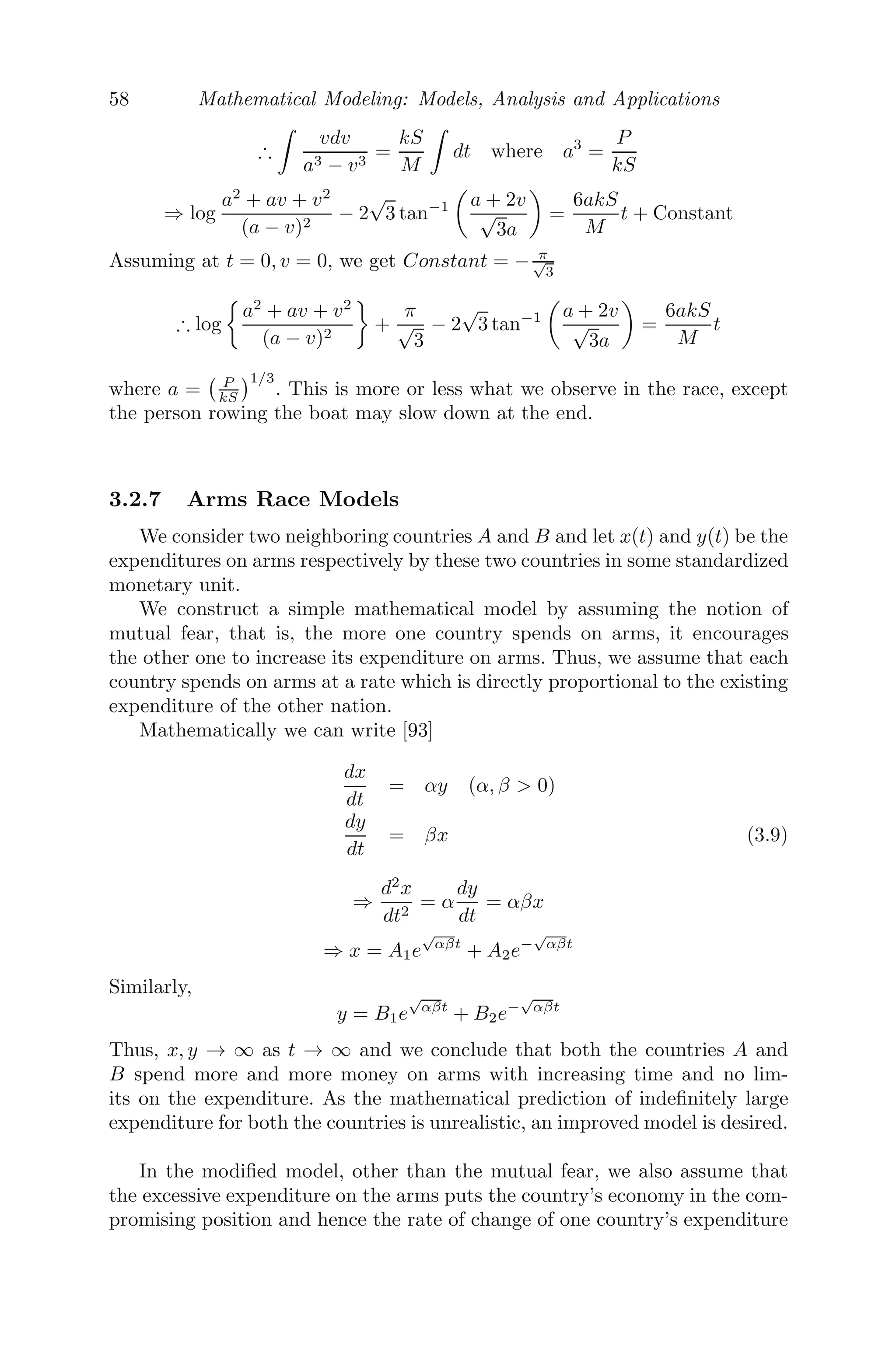
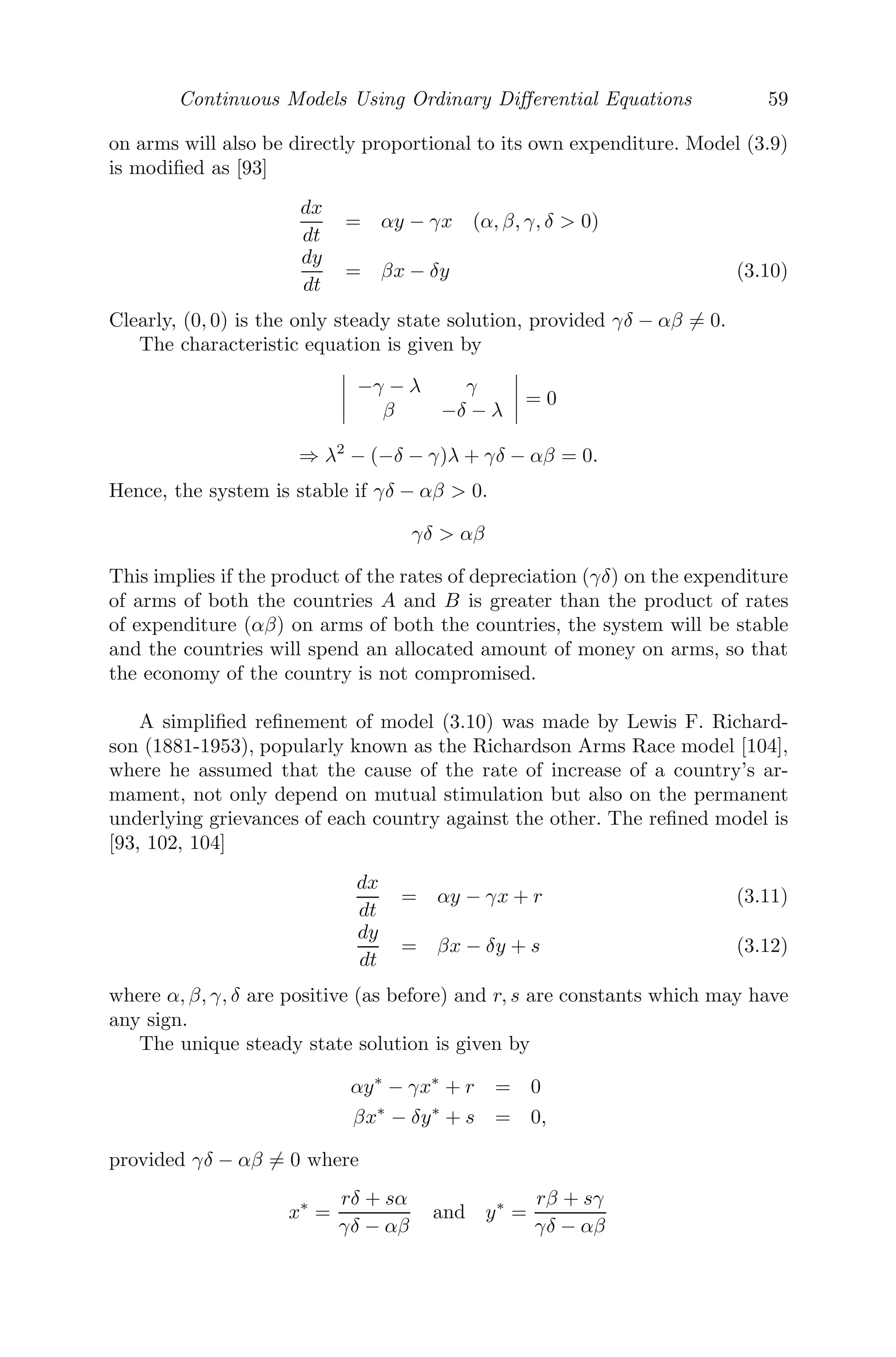

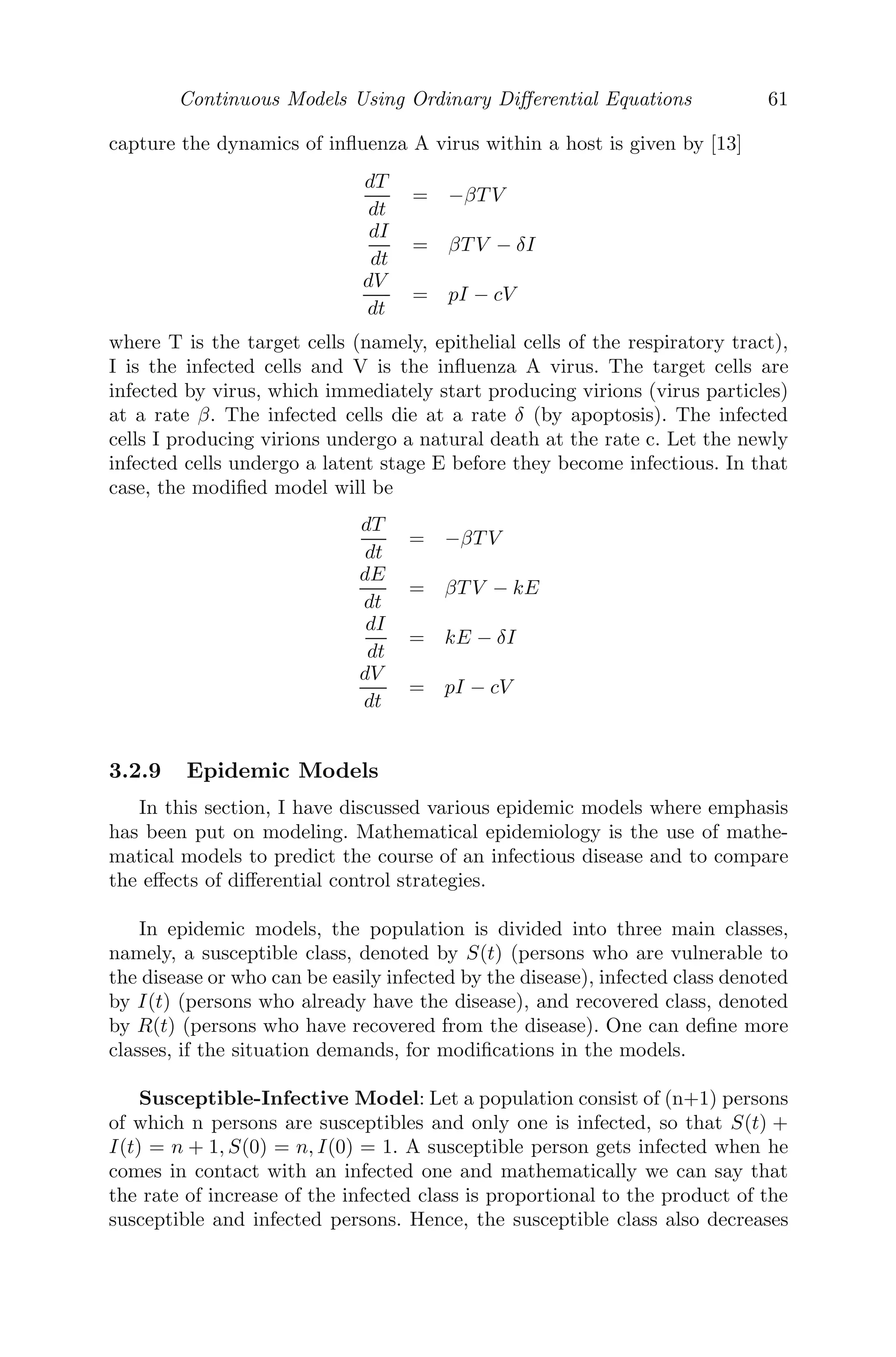
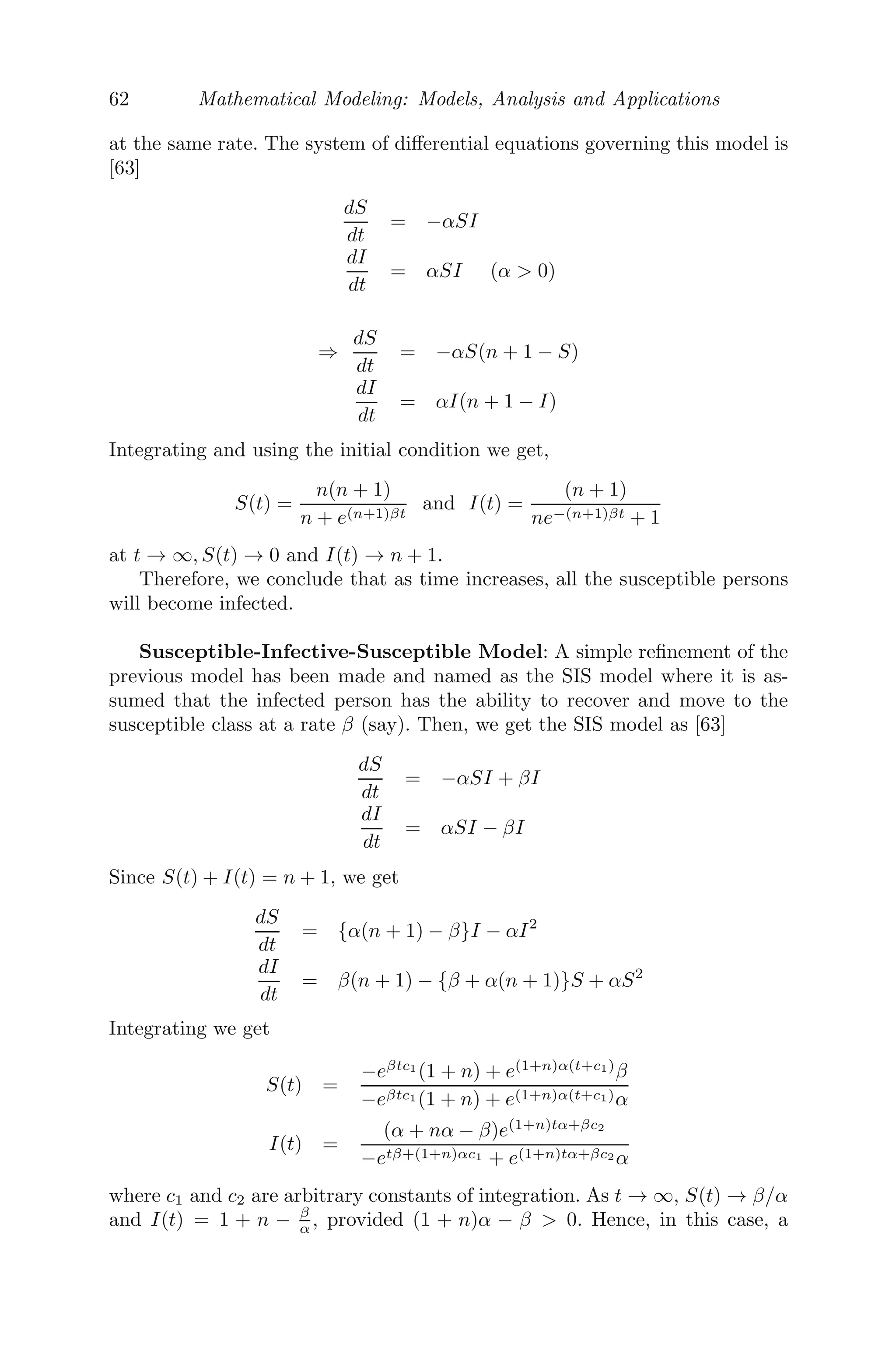
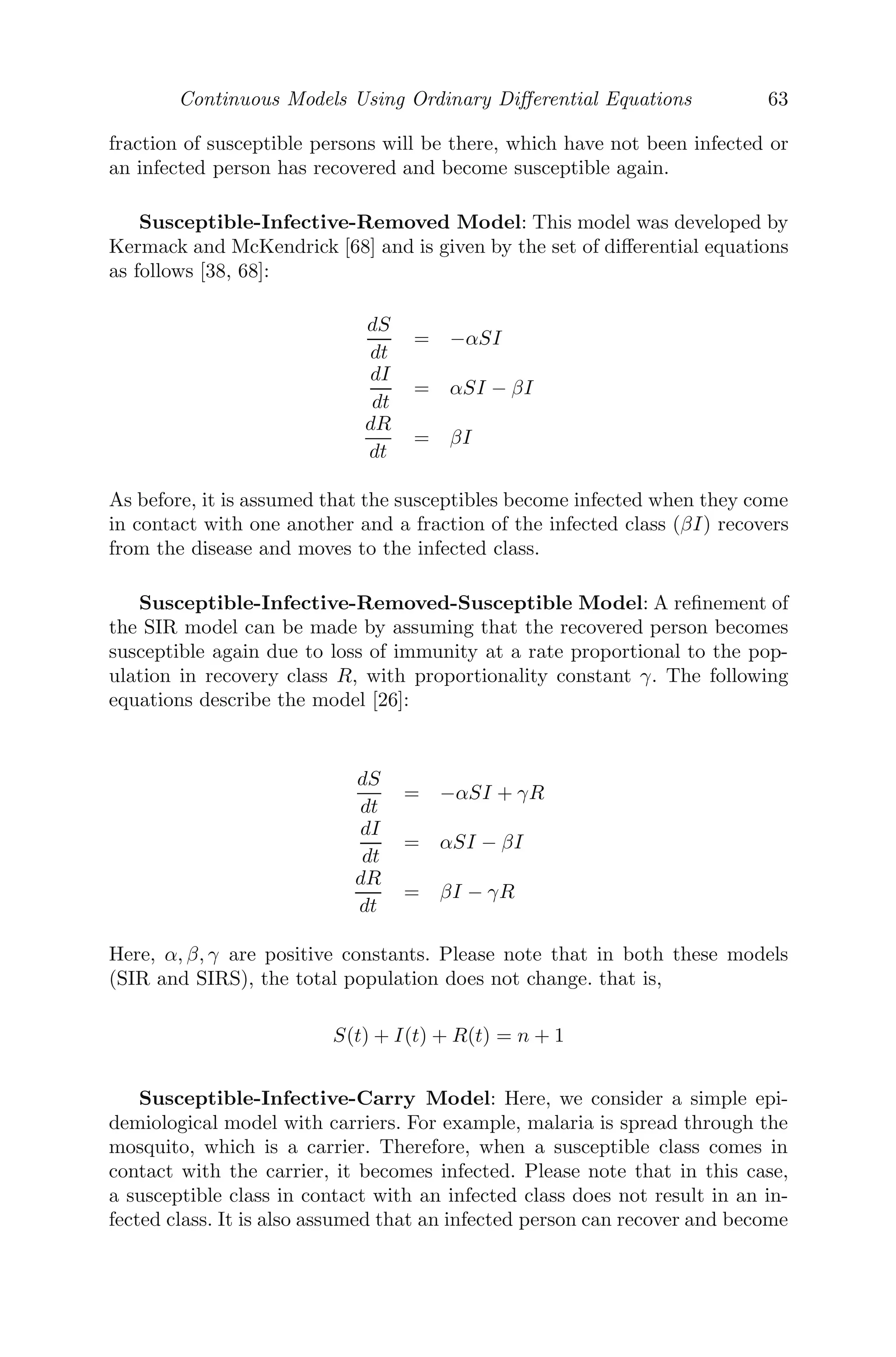
![56 Mathematical Modeling: Models, Analysis and Applications
(velocity)(μ k) also acts on the particle along with a periodic additional
acceleration F cos(bt) [49] (see Figure 3.6).
The equation of motion that models the scenario is given by
d2
x
dt2
= −μ2
x − 2k
dx
dt
+ F cos(bt).
Let x = Aemt
(A = 0) be a trial solution of
d2
x
dt2
+ 2k
dx
dt
+ μ2
x = 0,
then the required auxiliary equation is
m2
+ 2mk + μ2
= 0 ⇒ m = −k ±
k2 − μ2
= −k ± i
μ2 − k2 (μ k)
Complimentary function is e−kt
A cos(
μ2 − k2t + ε1) and the particular in-
tegral is given by
1
D2 + 2Dk + μ2
F cos(bt) = F
D2
− 2Dk + μ2
(D2 + μ2)2 − 4D2k2
cos(bt)
= F
(μ2
− b2
) cos(bt) + 2kb sin(bt)
(μ2 − b2)2 + 4k2b2
= B cos(bt − ε2)
where B =
F
(μ2 − b2)2 + 4k2b2
and tan ε2 =
2kb
μ2 − b2
Therefore, the general solution is
x = Ae−kt
cos(
μ2 − k2t + ε1) + B cos(bt − ε2) (3.8)
From (3.8), it is concluded that motion is the resultant of two oscillations,
namely, the free oscillation (first part) and forced oscillation (second part).
The arbitrary constants A and B can be obtained from the initial conditions.
From the expression (3.8), it is clear that the amplitude of free oscillation
decreases with time t because of the factor e−kt
and ultimately vanishes for
large t. However, the amplitude of the forced oscillation persists as there is no
diminishing factor, whose period of oscillation is 2π
b . This is also evident from
Figure 3.7.
Special Case: If the period of forced oscillation is equal to the period
of free oscillation, that is, 2π
b = 2π
μ ⇒ b = μ, then the amplitude of the
forced oscillation is B = F
2kb . If k is small, then the amplitude of the forced
oscillation is very large. This is the reason why a group of soldiers marching
on a bridge are ordered to fall out. While marching in groups, the period of
forced vibration may be equal to the natural period of the bridge structure.
Then a large amplitude of vibration may be generated, which may cause the
bridge to crack and fall down.](https://image.slidesharecdn.com/mathematicalmodelingmodelsanalysisandapplicationspdfdrive-211127122602/75/Mathematical-modeling-models-analysis-and-applications-pdf-drive-87-2048.jpg)
![Continuous Models Using Ordinary Differential Equations 57
50 100 150 200 250
0.5
0.5
1.0
FIGURE 3.7: A motion which is the resultant of two oscillations, namely,
a free oscillation and a forced one.
3.2.6 Dynamics of Rowing
In rowing a boat, a person tries to push the boat forward against the water
using the oar and thereby exerts a force, known as tractive force. We denote
that force by T . Also, as the boat moves forward, the water adjacent to the
sides of the boat exerts a force, resulting in losing its speed. We call this force
a drag force and denote it by D. If v(t) be the velocity of the boat at any time
t, then the equation of motion is given by [53]
M
dv
dt
= T − D
Let us now assume that the person has entered a race and let P be the effective
power that the person can sustain for the entire length he has to row. Then,
from physics, we get
P = T × v (effective power = Tractive force × velocity)
Also, from fluid dynamics, the drag force is proportional to the square of the
velocity and to the surface area in contact with the water (wetted surface
area). Thus,
D = kv2
S
where S is wetted surface area and k is the constant of proportionality. Thus,
the model showing the dynamics of rowing is given by [53]
M
dv
dt
=
P
v
− kv2
S
=
P − kv3
S
v
=
ks( P
kS − v3
)
v](https://image.slidesharecdn.com/mathematicalmodelingmodelsanalysisandapplicationspdfdrive-211127122602/75/Mathematical-modeling-models-analysis-and-applications-pdf-drive-88-2048.jpg)
![58 Mathematical Modeling: Models, Analysis and Applications
∴
vdv
a3 − v3
=
kS
M
dt where a3
=
P
kS
⇒ log
a2
+ av + v2
(a − v)2
− 2
√
3 tan−1
a + 2v
√
3a
=
6akS
M
t + Constant
Assuming at t = 0, v = 0, we get Constant = − π
√
3
∴ log
a2
+ av + v2
(a − v)2
+
π
√
3
− 2
√
3 tan−1
a + 2v
√
3a
=
6akS
M
t
where a =
P
kS
1/3
. This is more or less what we observe in the race, except
the person rowing the boat may slow down at the end.
3.2.7 Arms Race Models
We consider two neighboring countries A and B and let x(t) and y(t) be the
expenditures on arms respectively by these two countries in some standardized
monetary unit.
We construct a simple mathematical model by assuming the notion of
mutual fear, that is, the more one country spends on arms, it encourages
the other one to increase its expenditure on arms. Thus, we assume that each
country spends on arms at a rate which is directly proportional to the existing
expenditure of the other nation.
Mathematically we can write [93]
dx
dt
= αy (α, β 0)
dy
dt
= βx (3.9)
⇒
d2
x
dt2
= α
dy
dt
= αβx
⇒ x = A1e
√
αβt
+ A2e−
√
αβt
Similarly,
y = B1e
√
αβt
+ B2e−
√
αβt
Thus, x, y → ∞ as t → ∞ and we conclude that both the countries A and
B spend more and more money on arms with increasing time and no lim-
its on the expenditure. As the mathematical prediction of indefinitely large
expenditure for both the countries is unrealistic, an improved model is desired.
In the modified model, other than the mutual fear, we also assume that
the excessive expenditure on the arms puts the country’s economy in the com-
promising position and hence the rate of change of one country’s expenditure](https://image.slidesharecdn.com/mathematicalmodelingmodelsanalysisandapplicationspdfdrive-211127122602/75/Mathematical-modeling-models-analysis-and-applications-pdf-drive-89-2048.jpg)
![Continuous Models Using Ordinary Differential Equations 59
on arms will also be directly proportional to its own expenditure. Model (3.9)
is modified as [93]
dx
dt
= αy − γx (α, β, γ, δ 0)
dy
dt
= βx − δy (3.10)
Clearly, (0, 0) is the only steady state solution, provided γδ − αβ = 0.
The characteristic equation is given by](https://image.slidesharecdn.com/mathematicalmodelingmodelsanalysisandapplicationspdfdrive-211127122602/75/Mathematical-modeling-models-analysis-and-applications-pdf-drive-90-2048.jpg)
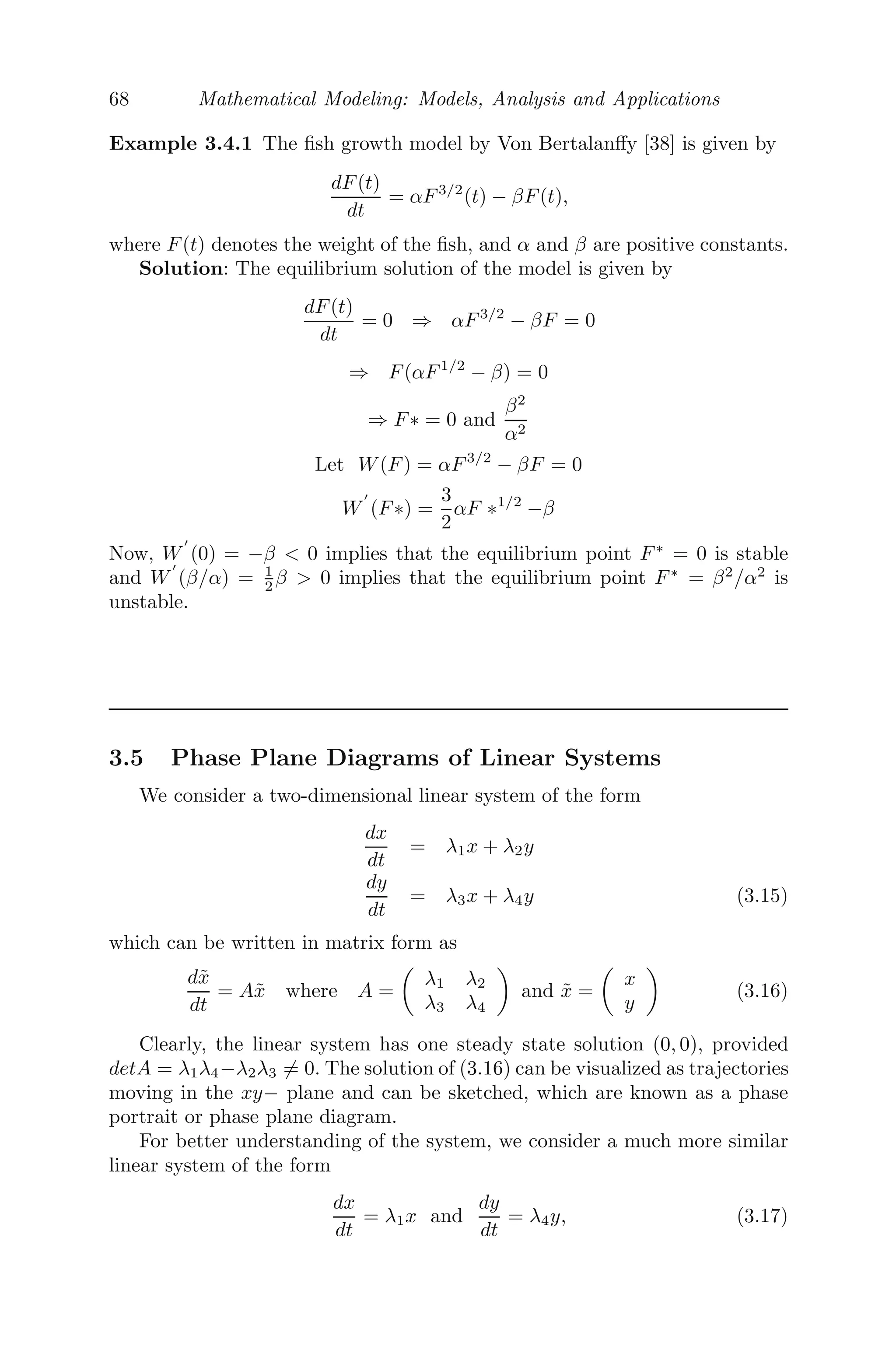
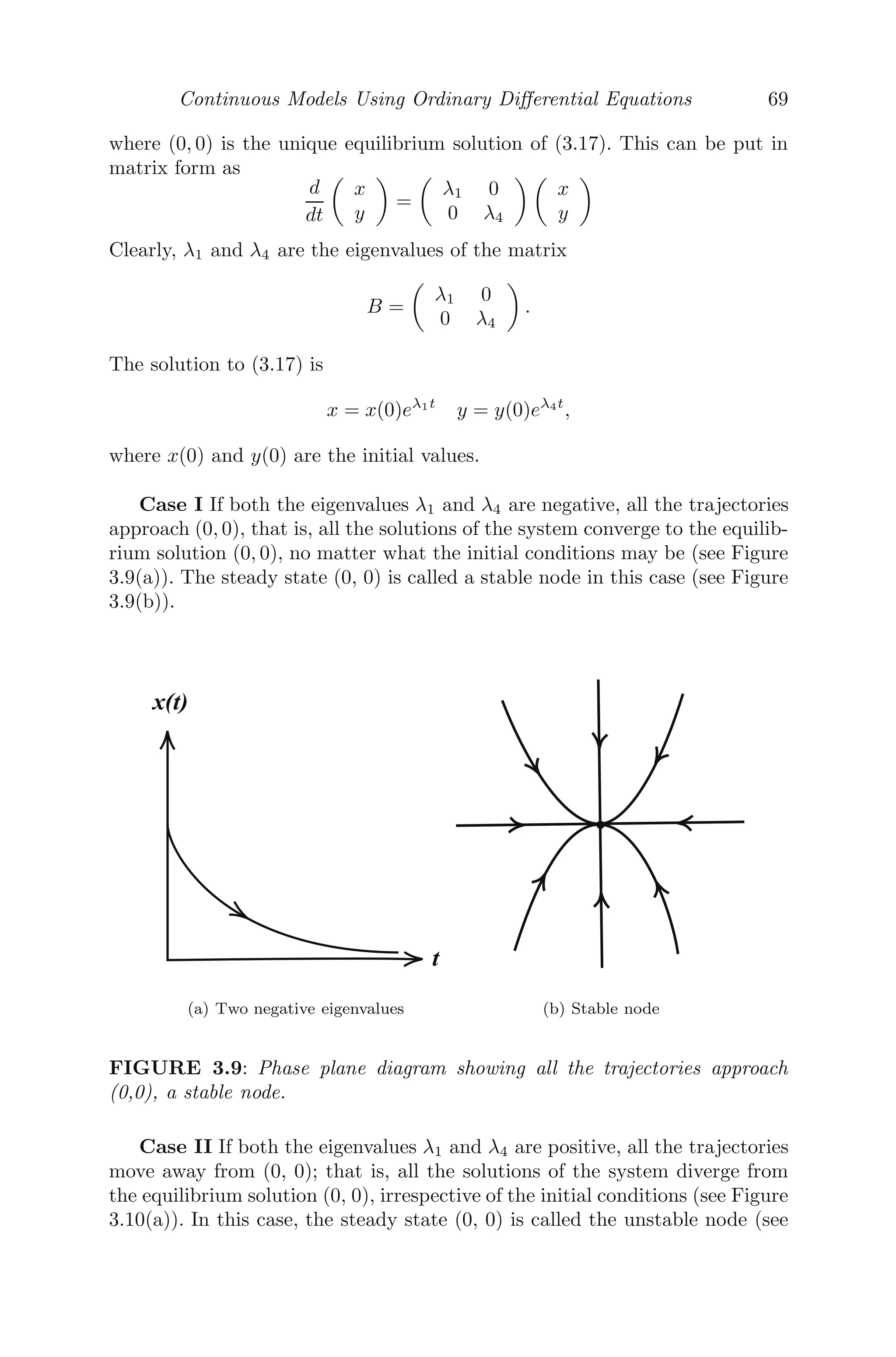
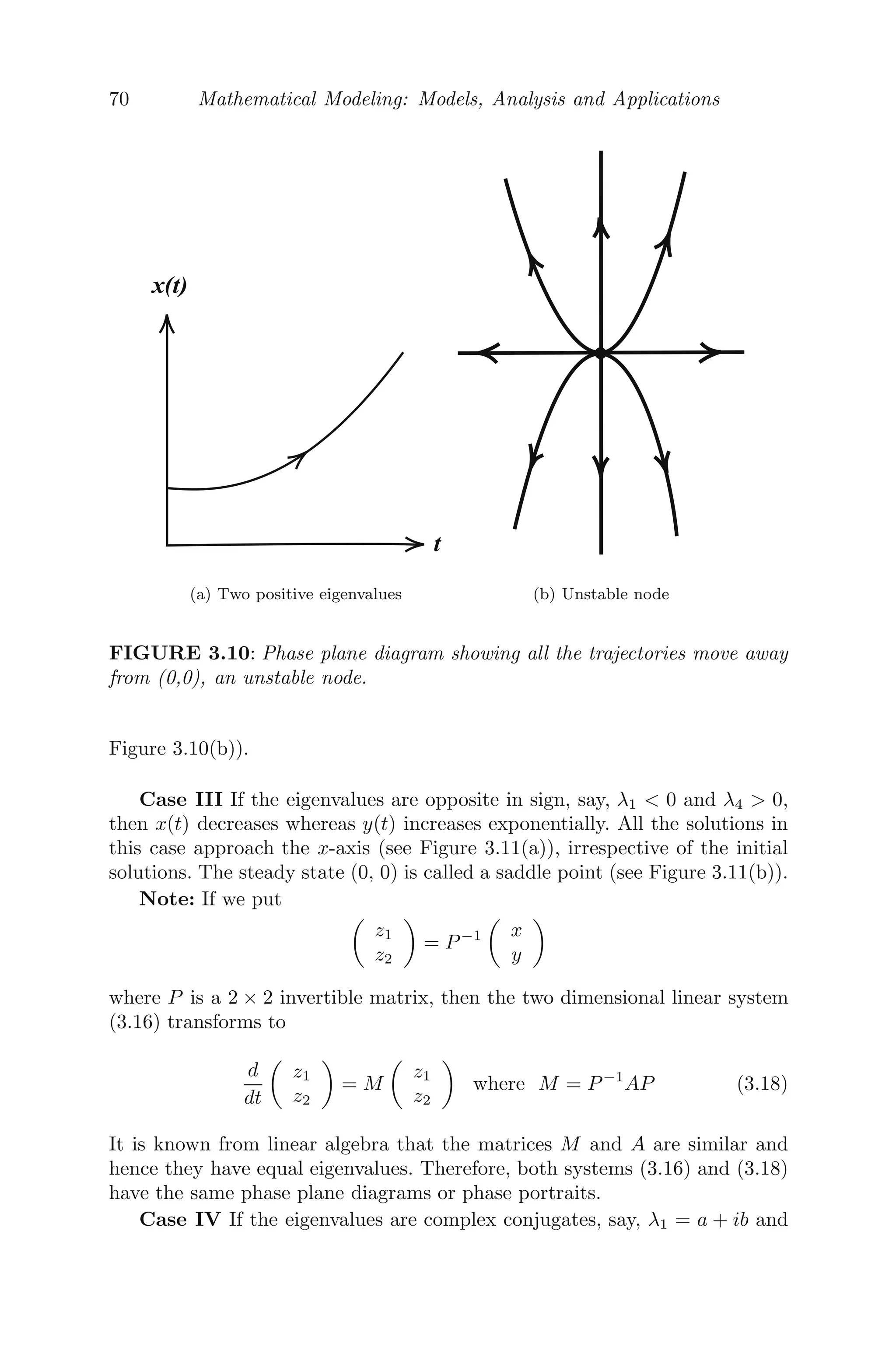

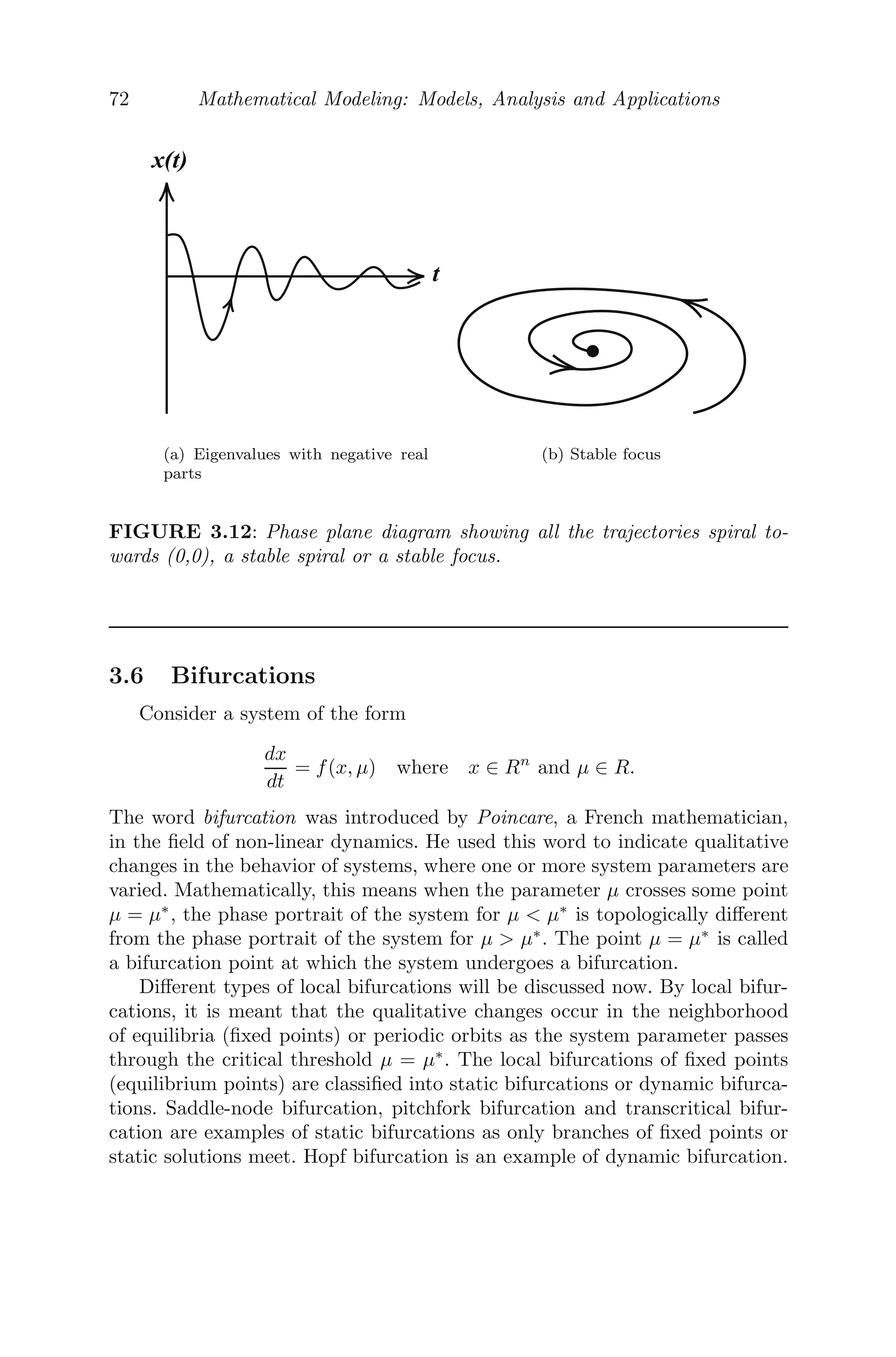
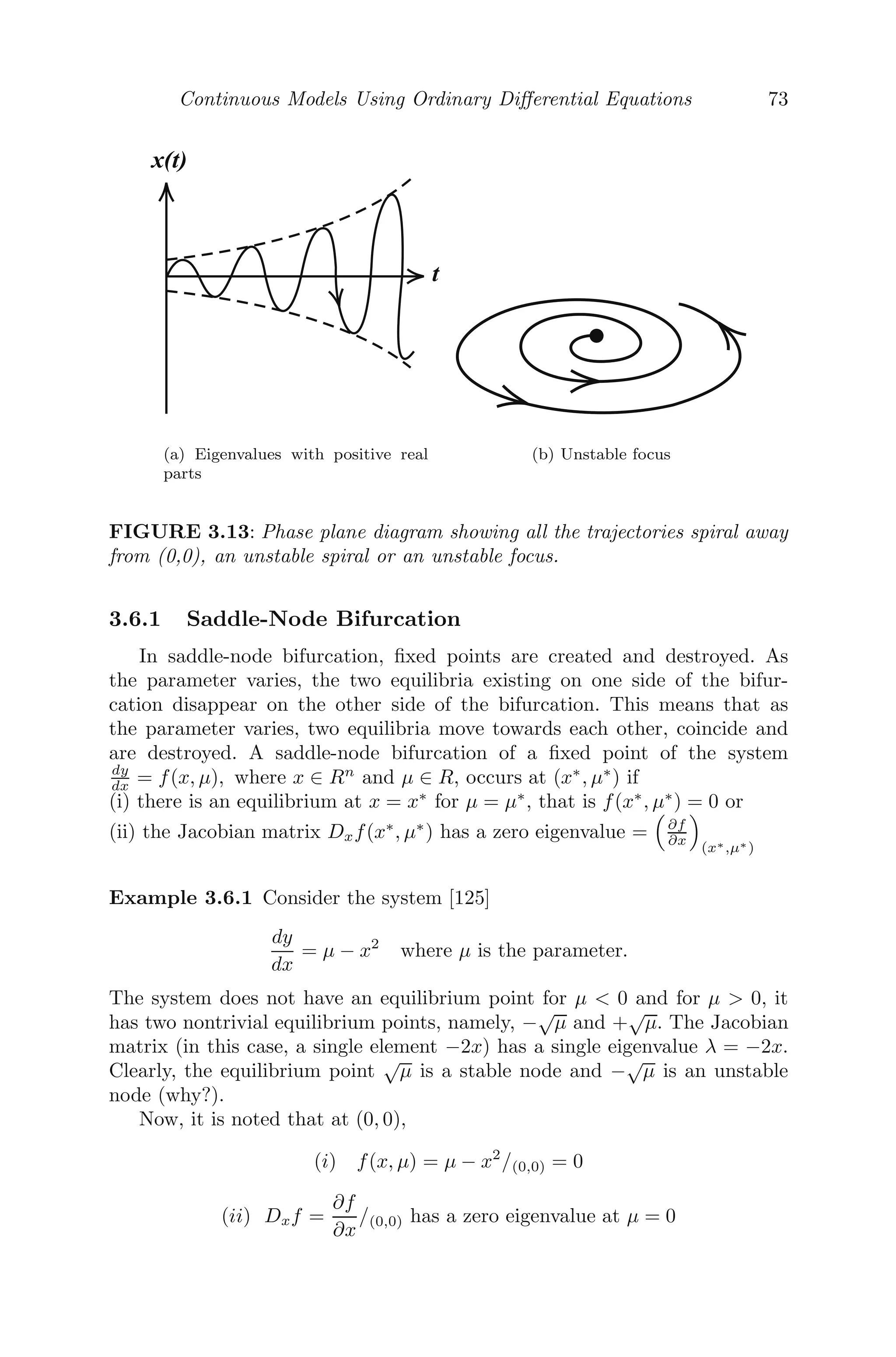
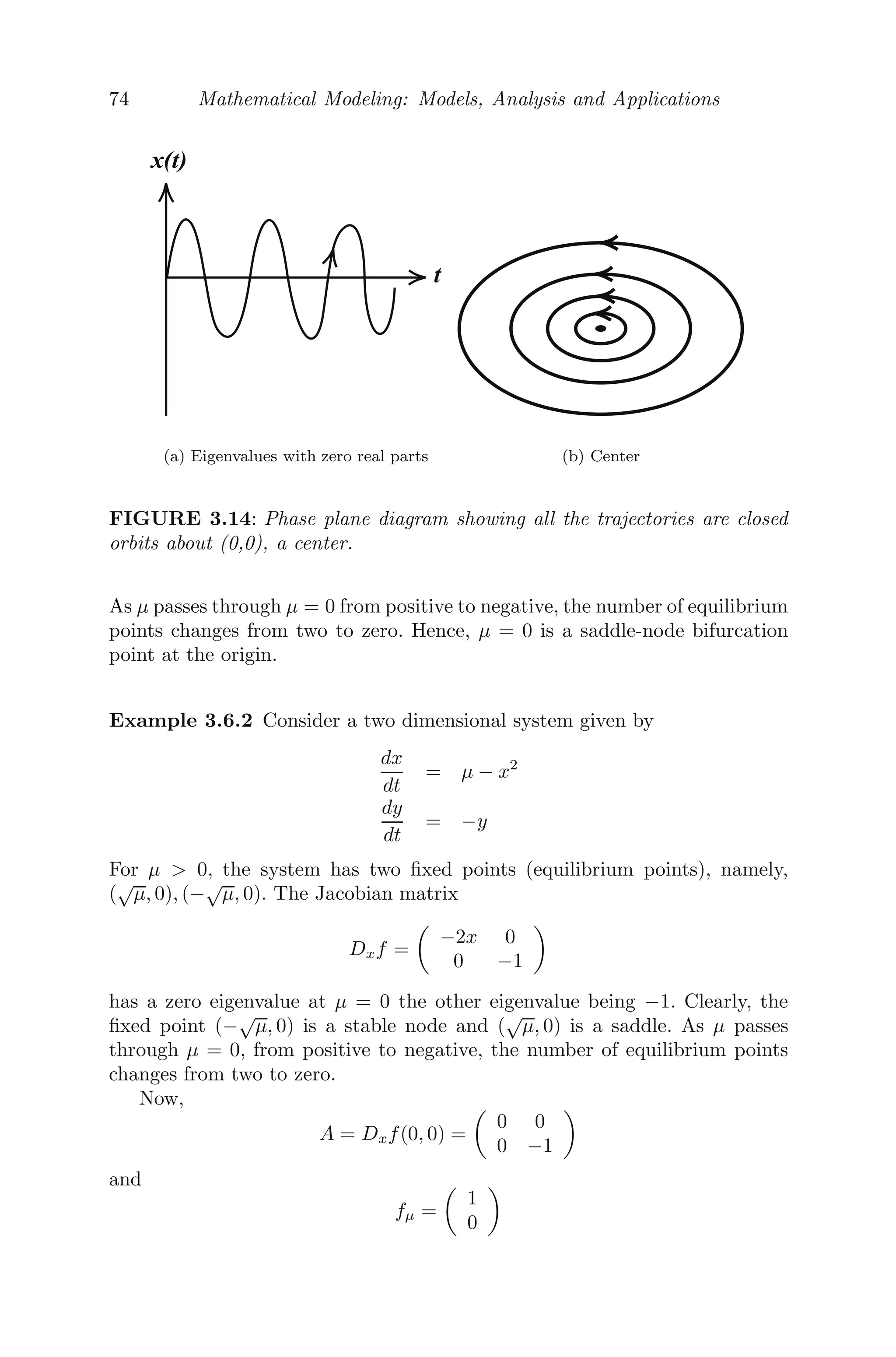
![= 0
⇒ λ2
− (−δ − γ)λ + γδ − αβ = 0.
Hence, the system is stable if γδ − αβ 0.
γδ αβ
This implies if the product of the rates of depreciation (γδ) on the expenditure
of arms of both the countries A and B is greater than the product of rates
of expenditure (αβ) on arms of both the countries, the system will be stable
and the countries will spend an allocated amount of money on arms, so that
the economy of the country is not compromised.
A simplified refinement of model (3.10) was made by Lewis F. Richard-
son (1881-1953), popularly known as the Richardson Arms Race model [104],
where he assumed that the cause of the rate of increase of a country’s ar-
mament, not only depend on mutual stimulation but also on the permanent
underlying grievances of each country against the other. The refined model is
[93, 102, 104]
dx
dt
= αy − γx + r (3.11)
dy
dt
= βx − δy + s (3.12)
where α, β, γ, δ are positive (as before) and r, s are constants which may have
any sign.
The unique steady state solution is given by
αy∗
− γx∗
+ r = 0
βx∗
− δy∗
+ s = 0,
provided γδ − αβ = 0 where
x∗
=
rδ + sα
γδ − αβ
and y∗
=
rβ + sγ
γδ − αβ](https://image.slidesharecdn.com/mathematicalmodelingmodelsanalysisandapplicationspdfdrive-211127122602/75/Mathematical-modeling-models-analysis-and-applications-pdf-drive-98-2048.jpg)
![60 Mathematical Modeling: Models, Analysis and Applications
The characteristic equation is
λ2
− (−γ − δ)λ + γδ − αβ = 0.
Case I γδ − αβ 0, r 0, s 0. In this case, the system is stable. This
means both the countries spent on arms in a strategic manner so that the
economy of the country is not compromised.
Case II γδ − αβ 0, r 0, s 0. In this case, though the system
is stable, the equilibrium solution becomes negative. However, expenditures
cannot be negative in reality. Suppose (x0, y0) 0 be the initial expenditures,
then x(t) → x∗
and y(t) → y∗
at t → ∞ and for that it has to pass through
zero values. Thus, as x(t) becomes zero, (3.12) reduces to
dy
dt
= −δy + s
⇒ y(t) =
δ
s
+ C1e−δt
Since s 0, y(t) decreases till it reaches the value zero. A similar argument
is valid for x(t). Thus, in this case, both the countries will stop spending on
arms and then this will result in a complete disarmament [63].
Case III γδ − αβ 0, r 0, s 0. In this case, one of the countries has
overcome the grievance (s 0). The system is stable with positive equilibrium
solution if δr + αs 0 and βr + γs 0(s 0). The system approaches
an equilibrium value which is less than the previous cases when both r, s
0. That means when one country has overcome the grievance and started
spending less on armaments, this will have an effect on the other country,
who will also start spending less in order to develop mutual goodwill [63].
Case IV γδ − αβ 0, r 0, s 0. The system becomes unstable, which
will lead to a runaway arms race (x → ∞, y → ∞) as one of the eigenvalues
is positive and the other is negative.
Case V γδ −αβ 0, r 0, s 0. The system is unstable but equilibrium
solution is positive. Though one of the eigenvalues is positive and the other
is negative, there is a possibility of disarmament as well as a runaway arms
race, depending on the initial expenditure on arms by both the countries [63].
3.2.8 Mathematical Model of Influenza Infection (within
Host)
An influenza A infection has the propensity to cause occasional pandame-
cis with potentially high death tolls. Initial infection affects only the upper
respiratory tract and the upper divisions of bronchi. However, in a severe case,
the infection will spread to the lower lungs. A basic mathematical model to](https://image.slidesharecdn.com/mathematicalmodelingmodelsanalysisandapplicationspdfdrive-211127122602/75/Mathematical-modeling-models-analysis-and-applications-pdf-drive-99-2048.jpg)
![Continuous Models Using Ordinary Differential Equations 61
capture the dynamics of influenza A virus within a host is given by [13]
dT
dt
= −βT V
dI
dt
= βT V − δI
dV
dt
= pI − cV
where T is the target cells (namely, epithelial cells of the respiratory tract),
I is the infected cells and V is the influenza A virus. The target cells are
infected by virus, which immediately start producing virions (virus particles)
at a rate β. The infected cells die at a rate δ (by apoptosis). The infected
cells I producing virions undergo a natural death at the rate c. Let the newly
infected cells undergo a latent stage E before they become infectious. In that
case, the modified model will be
dT
dt
= −βT V
dE
dt
= βT V − kE
dI
dt
= kE − δI
dV
dt
= pI − cV
3.2.9 Epidemic Models
In this section, I have discussed various epidemic models where emphasis
has been put on modeling. Mathematical epidemiology is the use of mathe-
matical models to predict the course of an infectious disease and to compare
the effects of differential control strategies.
In epidemic models, the population is divided into three main classes,
namely, a susceptible class, denoted by S(t) (persons who are vulnerable to
the disease or who can be easily infected by the disease), infected class denoted
by I(t) (persons who already have the disease), and recovered class, denoted
by R(t) (persons who have recovered from the disease). One can define more
classes, if the situation demands, for modifications in the models.
Susceptible-Infective Model: Let a population consist of (n+1) persons
of which n persons are susceptibles and only one is infected, so that S(t) +
I(t) = n + 1, S(0) = n, I(0) = 1. A susceptible person gets infected when he
comes in contact with an infected one and mathematically we can say that
the rate of increase of the infected class is proportional to the product of the
susceptible and infected persons. Hence, the susceptible class also decreases](https://image.slidesharecdn.com/mathematicalmodelingmodelsanalysisandapplicationspdfdrive-211127122602/75/Mathematical-modeling-models-analysis-and-applications-pdf-drive-100-2048.jpg)
![62 Mathematical Modeling: Models, Analysis and Applications
at the same rate. The system of differential equations governing this model is
[63]
dS
dt
= −αSI
dI
dt
= αSI (α 0)
⇒
dS
dt
= −αS(n + 1 − S)
dI
dt
= αI(n + 1 − I)
Integrating and using the initial condition we get,
S(t) =
n(n + 1)
n + e(n+1)βt
and I(t) =
(n + 1)
ne−(n+1)βt + 1
at t → ∞, S(t) → 0 and I(t) → n + 1.
Therefore, we conclude that as time increases, all the susceptible persons
will become infected.
Susceptible-Infective-Susceptible Model: A simple refinement of the
previous model has been made and named as the SIS model where it is as-
sumed that the infected person has the ability to recover and move to the
susceptible class at a rate β (say). Then, we get the SIS model as [63]
dS
dt
= −αSI + βI
dI
dt
= αSI − βI
Since S(t) + I(t) = n + 1, we get
dS
dt
= {α(n + 1) − β}I − αI2
dI
dt
= β(n + 1) − {β + α(n + 1)}S + αS2
Integrating we get
S(t) =
−eβtc1
(1 + n) + e(1+n)α(t+c1)
β
−eβtc1 (1 + n) + e(1+n)α(t+c1)α
I(t) =
(α + nα − β)e(1+n)tα+βc2
−etβ+(1+n)αc1 + e(1+n)tα+βc2 α
where c1 and c2 are arbitrary constants of integration. As t → ∞, S(t) → β/α
and I(t) = 1 + n − β
α , provided (1 + n)α − β 0. Hence, in this case, a](https://image.slidesharecdn.com/mathematicalmodelingmodelsanalysisandapplicationspdfdrive-211127122602/75/Mathematical-modeling-models-analysis-and-applications-pdf-drive-101-2048.jpg)
![Continuous Models Using Ordinary Differential Equations 63
fraction of susceptible persons will be there, which have not been infected or
an infected person has recovered and become susceptible again.
Susceptible-Infective-Removed Model: This model was developed by
Kermack and McKendrick [68] and is given by the set of differential equations
as follows [38, 68]:
dS
dt
= −αSI
dI
dt
= αSI − βI
dR
dt
= βI
As before, it is assumed that the susceptibles become infected when they come
in contact with one another and a fraction of the infected class (βI) recovers
from the disease and moves to the infected class.
Susceptible-Infective-Removed-Susceptible Model: A refinement of
the SIR model can be made by assuming that the recovered person becomes
susceptible again due to loss of immunity at a rate proportional to the pop-
ulation in recovery class R, with proportionality constant γ. The following
equations describe the model [26]:
dS
dt
= −αSI + γR
dI
dt
= αSI − βI
dR
dt
= βI − γR
Here, α, β, γ are positive constants. Please note that in both these models
(SIR and SIRS), the total population does not change. that is,
S(t) + I(t) + R(t) = n + 1
Susceptible-Infective-Carry Model: Here, we consider a simple epi-
demiological model with carriers. For example, malaria is spread through the
mosquito, which is a carrier. Therefore, when a susceptible class comes in
contact with the carrier, it becomes infected. Please note that in this case,
a susceptible class in contact with an infected class does not result in an in-
fected class. It is also assumed that an infected person can recover and become](https://image.slidesharecdn.com/mathematicalmodelingmodelsanalysisandapplicationspdfdrive-211127122602/75/Mathematical-modeling-models-analysis-and-applications-pdf-drive-102-2048.jpg)
![64 Mathematical Modeling: Models, Analysis and Applications
susceptible again. The following equations describe the model [26]
dS
dt
= −αSC + βI
dI
dt
= αSC − βI
dC
dt
= −γC
Epidemic Model of Influenza: The Kermac-McKendrick model, which
is the basic SIR model, is considered suitable for epidemic models of influenza
as it has proven useful in predicting some aspects of the course of local in-
fluenza outbreaks in Great Britain and Russia. However, the basic SIR model
for influenza epidemics has some drawbacks. The model makes certain sim-
plifying assumptions whose significance is testable only after extensive and
costly field research. Therefore, the basic SIR model is extended to the SEAIR
model by introducing two additional compartments E and A. When a person
is infected with influenza virus, a short time elapses between infection and de-
velopment of the disease, which is called the incubation period. This class of
people going through the transition stage from infected to infectious is called
the E class. In the E class, a significant number of persons never develop
symptoms, but they are capable of transmitting the disease. We call this the
A class.
FIGURE 3.8: A flowchart of the modified Kermac-McKendrick SEAIR
model.
From the flowchart (see Figure 3.8), the system of equations describing the
SEAIR model is given by [17, 26]
dS
dt
= −βS(δA + I)
dE
dt
= βS(δA + I) − μEE
dI
dt
= pμEE − μII
dA
dt
= (1 − p)μEE − μAA
dR
dt
= μAA + μII](https://image.slidesharecdn.com/mathematicalmodelingmodelsanalysisandapplicationspdfdrive-211127122602/75/Mathematical-modeling-models-analysis-and-applications-pdf-drive-103-2048.jpg)
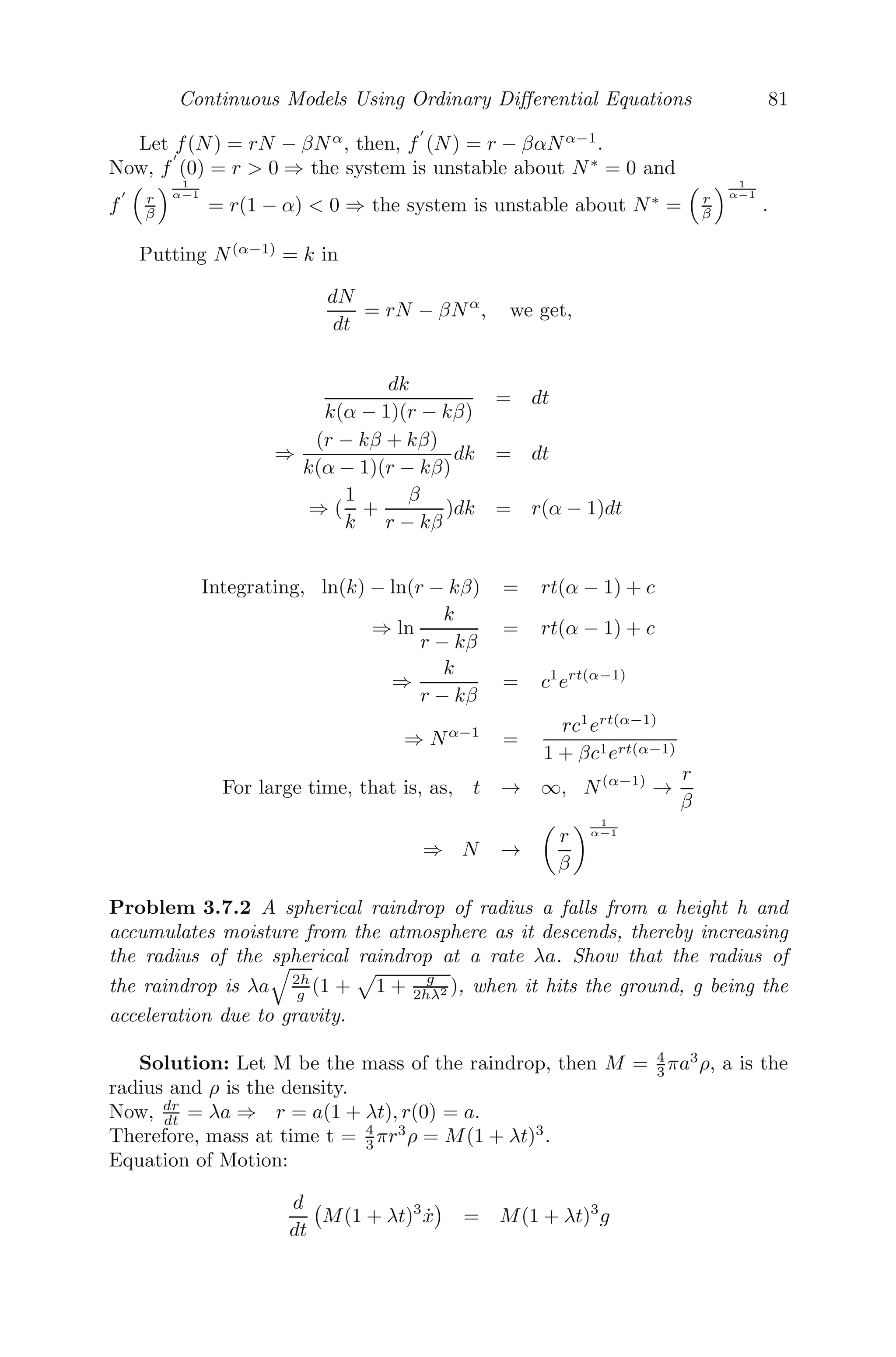
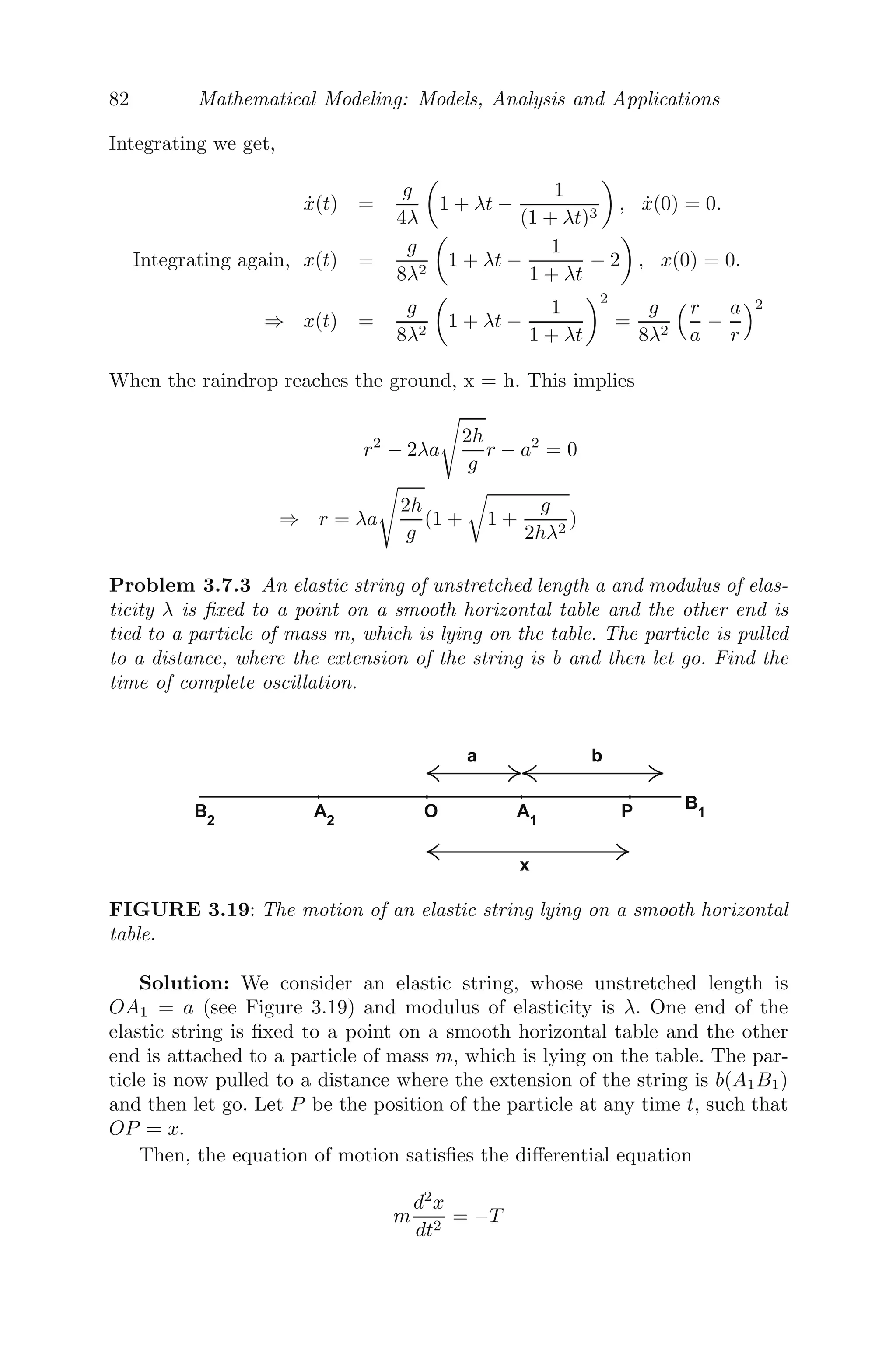
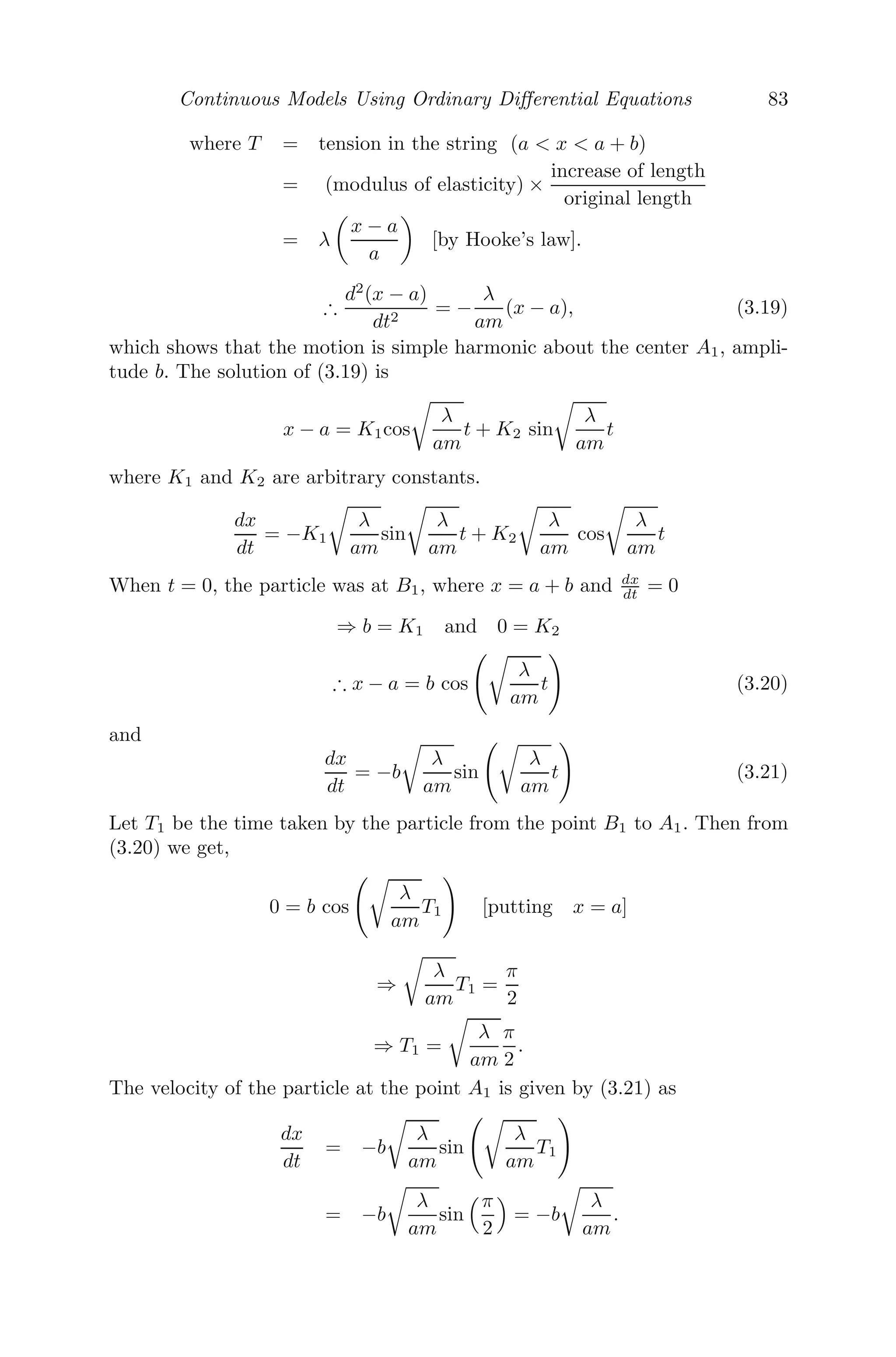


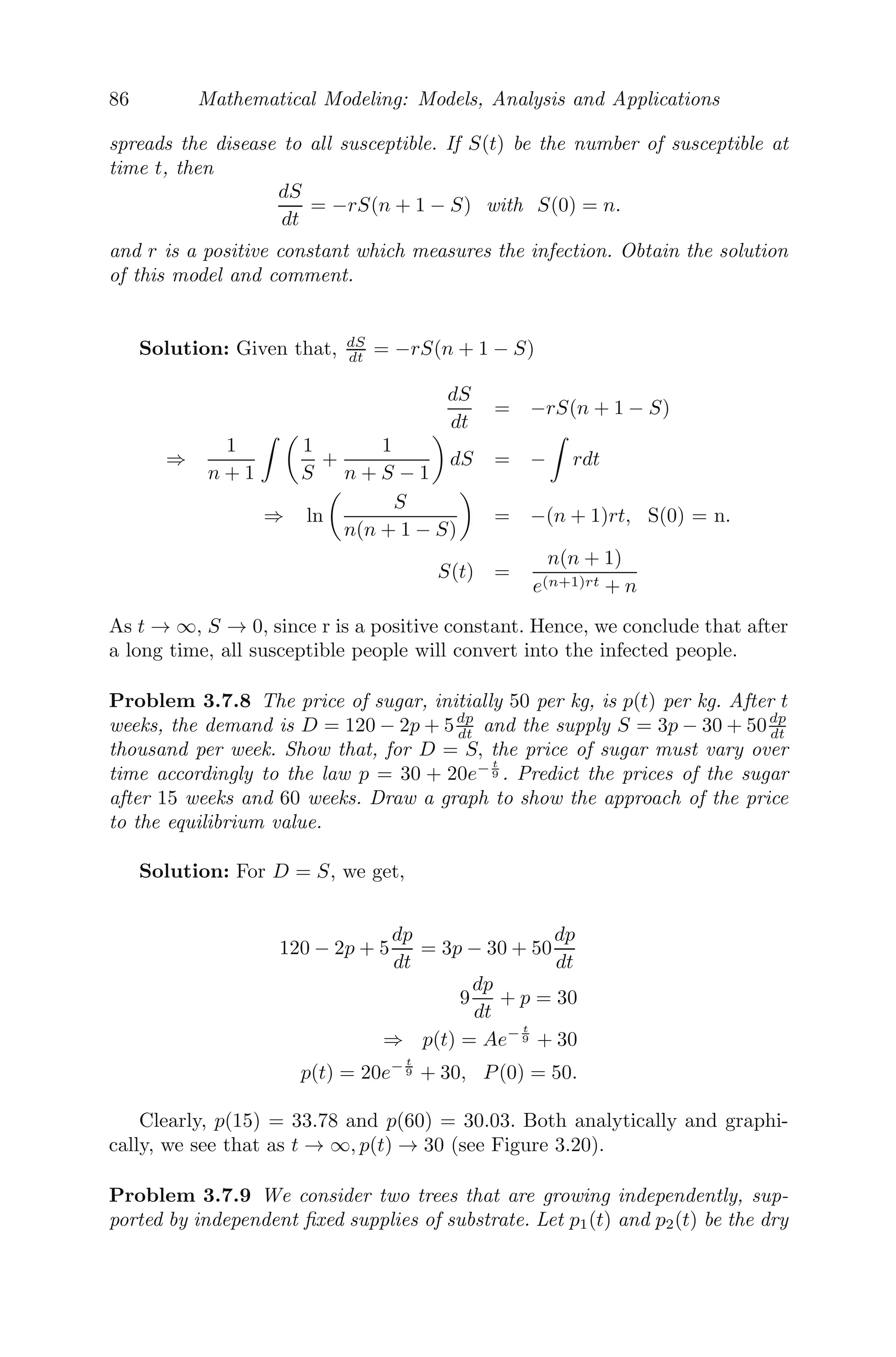
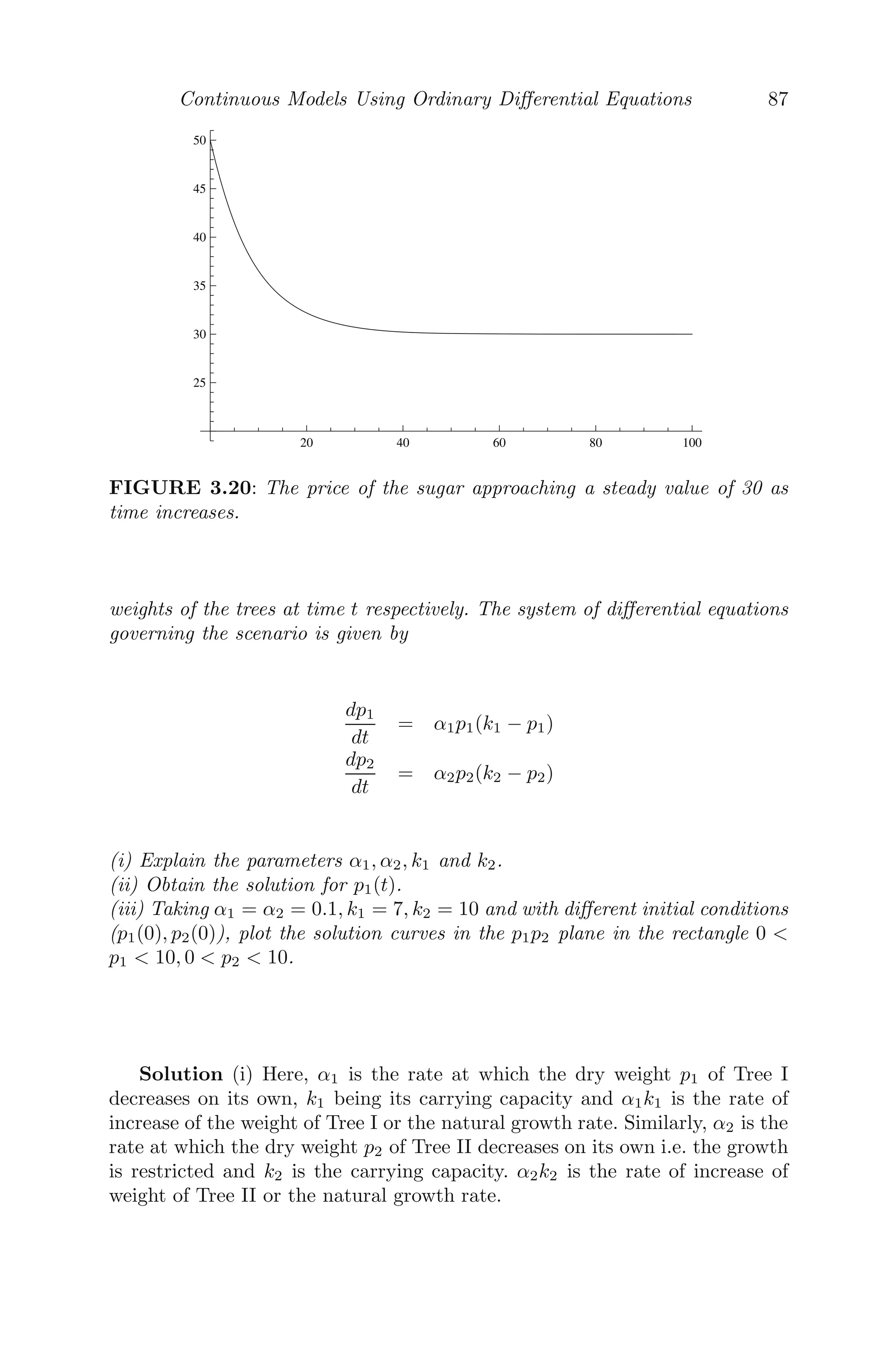
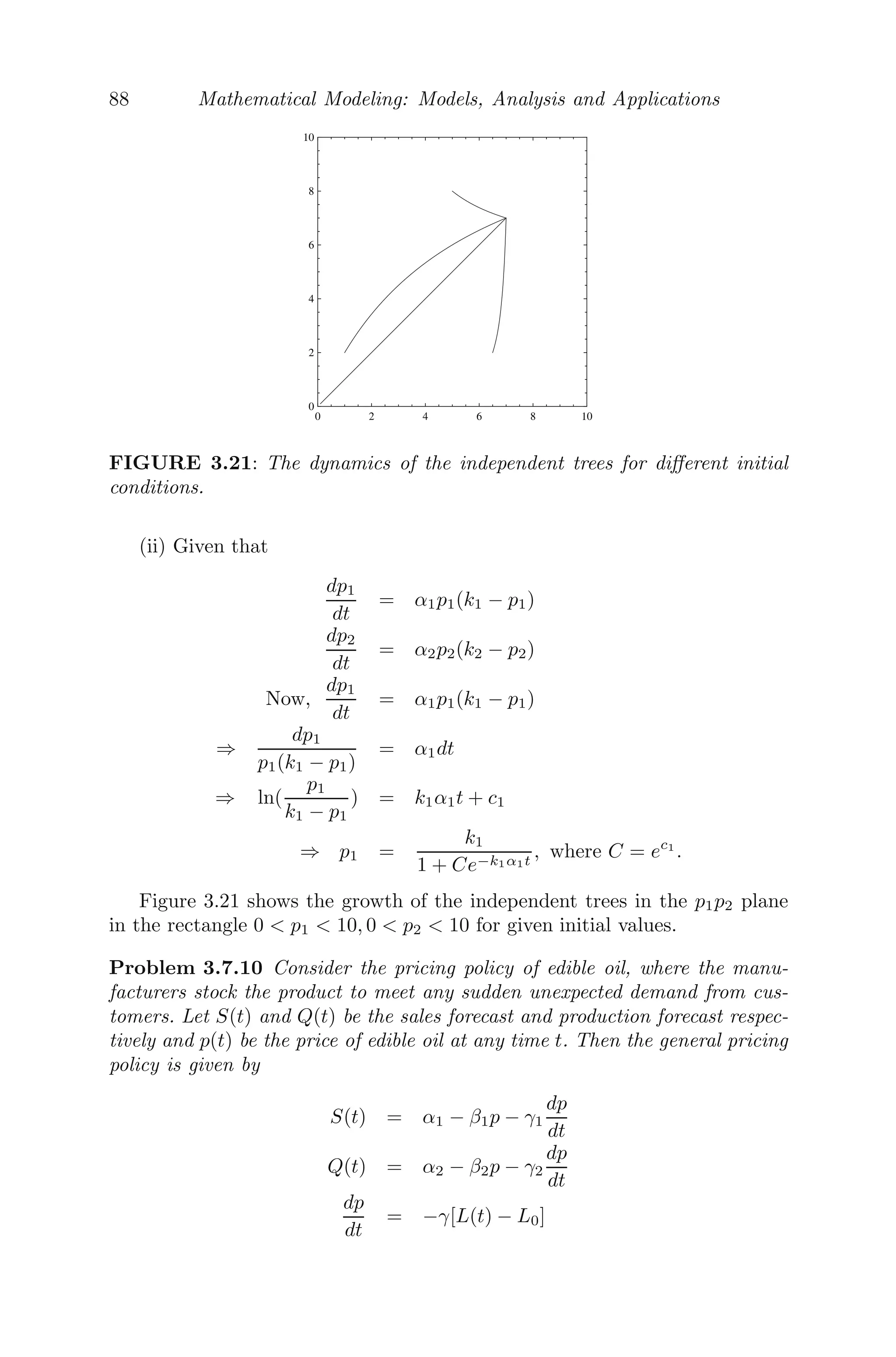

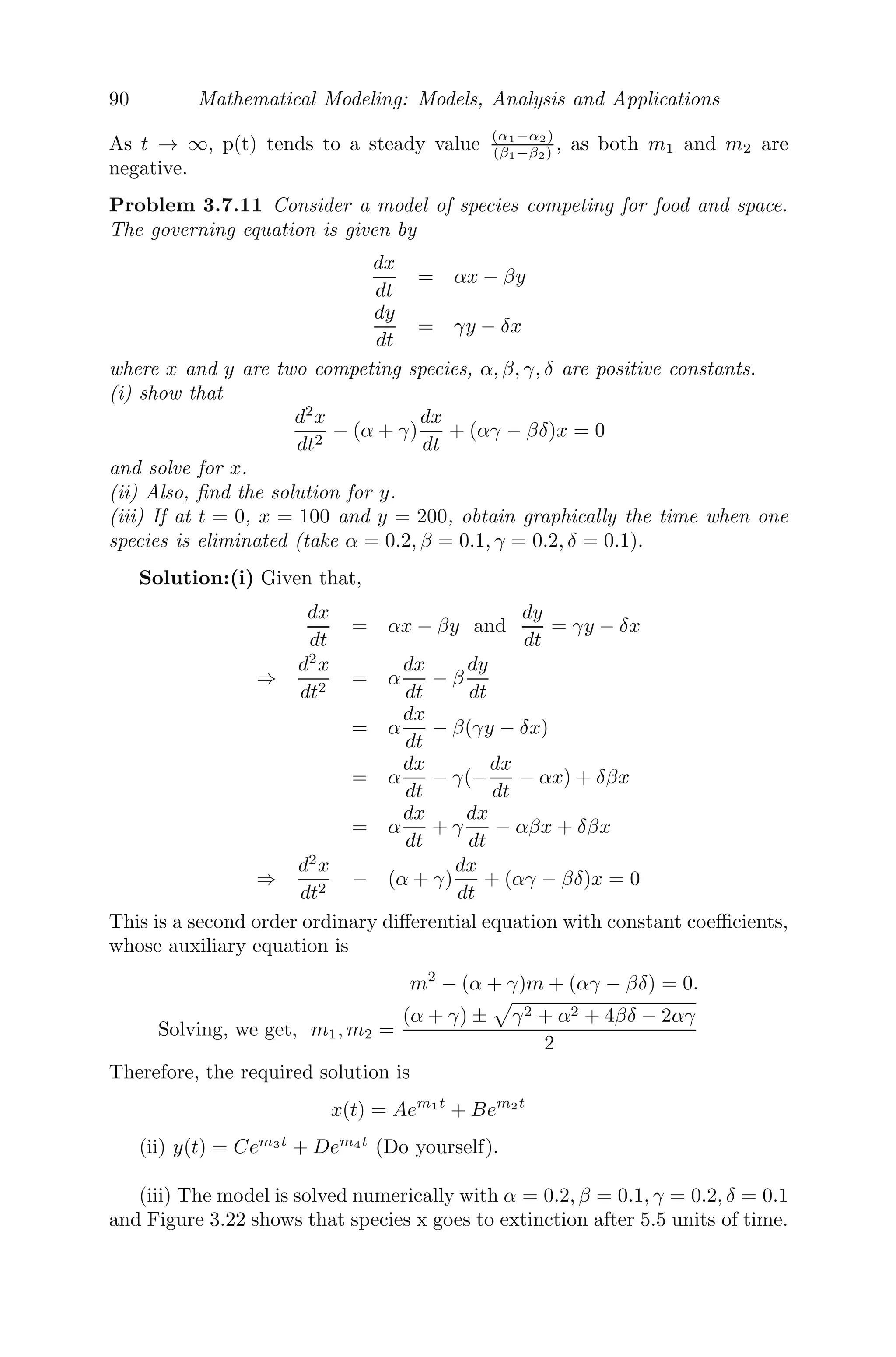
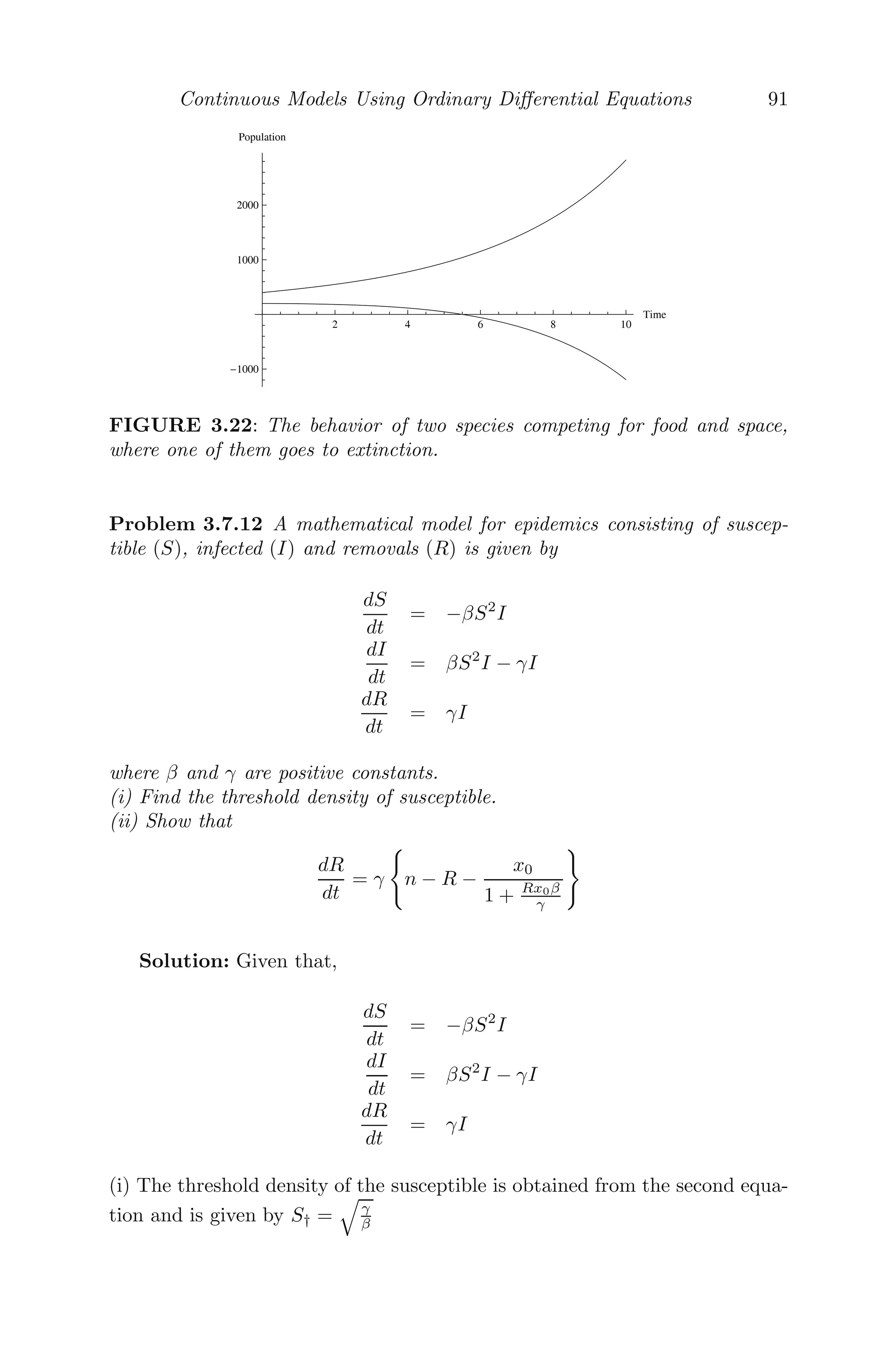
![68 Mathematical Modeling: Models, Analysis and Applications
Example 3.4.1 The fish growth model by Von Bertalanffy [38] is given by
dF(t)
dt
= αF3/2
(t) − βF(t),
where F(t) denotes the weight of the fish, and α and β are positive constants.
Solution: The equilibrium solution of the model is given by
dF(t)
dt
= 0 ⇒ αF3/2
− βF = 0
⇒ F(αF1/2
− β) = 0
⇒ F∗ = 0 and
β2
α2
Let W(F) = αF3/2
− βF = 0
W
(F∗) =
3
2
αF ∗1/2
−β
Now, W
(0) = −β 0 implies that the equilibrium point F∗
= 0 is stable
and W
(β/α) = 1
2 β 0 implies that the equilibrium point F∗
= β2
/α2
is
unstable.
3.5 Phase Plane Diagrams of Linear Systems
We consider a two-dimensional linear system of the form
dx
dt
= λ1x + λ2y
dy
dt
= λ3x + λ4y (3.15)
which can be written in matrix form as
dx̃
dt
= Ax̃ where A =
λ1 λ2
λ3 λ4
and x̃ =
x
y
(3.16)
Clearly, the linear system has one steady state solution (0, 0), provided
detA = λ1λ4−λ2λ3 = 0. The solution of (3.16) can be visualized as trajectories
moving in the xy− plane and can be sketched, which are known as a phase
portrait or phase plane diagram.
For better understanding of the system, we consider a much more similar
linear system of the form
dx
dt
= λ1x and
dy
dt
= λ4y, (3.17)](https://image.slidesharecdn.com/mathematicalmodelingmodelsanalysisandapplicationspdfdrive-211127122602/75/Mathematical-modeling-models-analysis-and-applications-pdf-drive-115-2048.jpg)
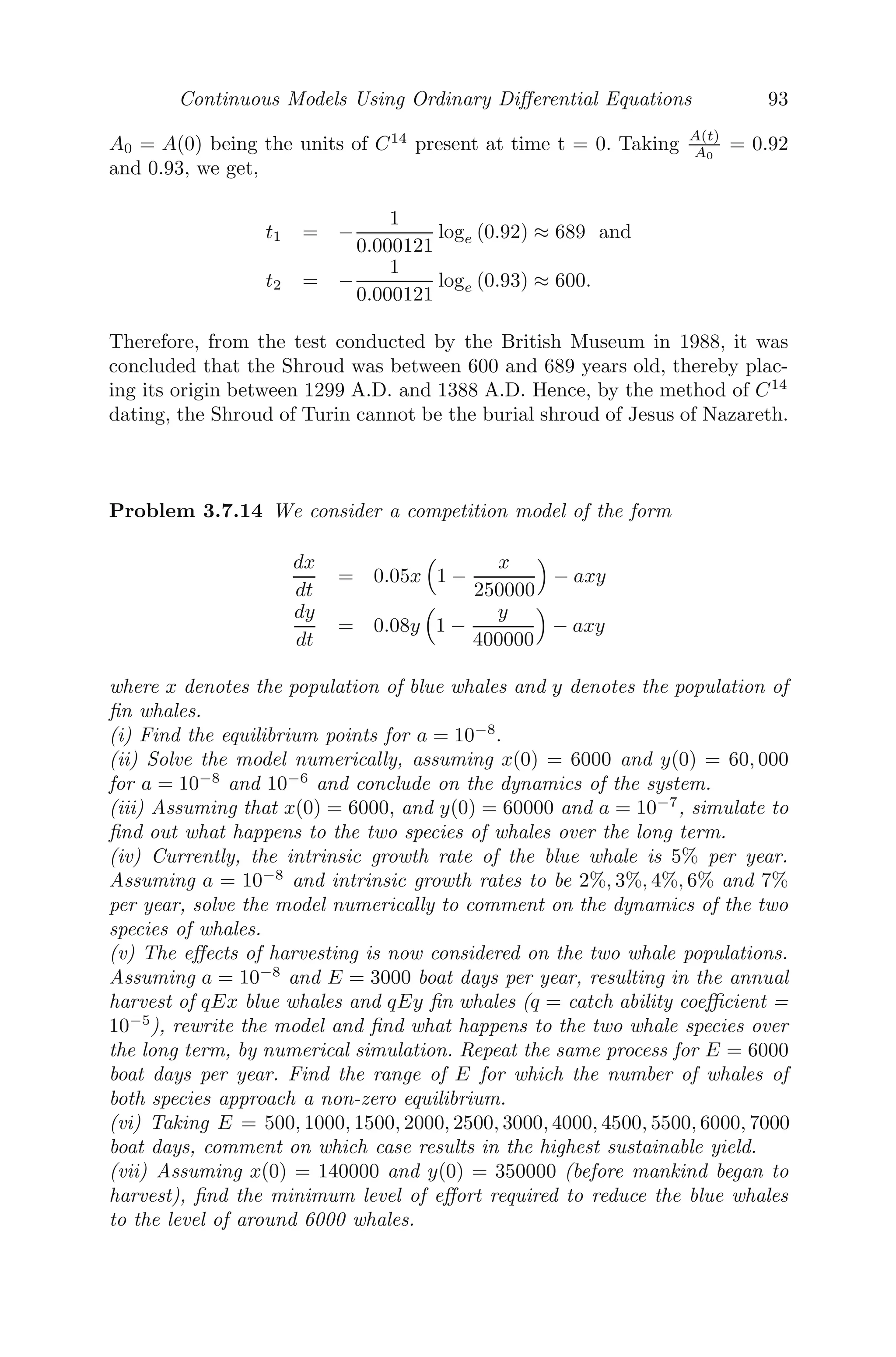
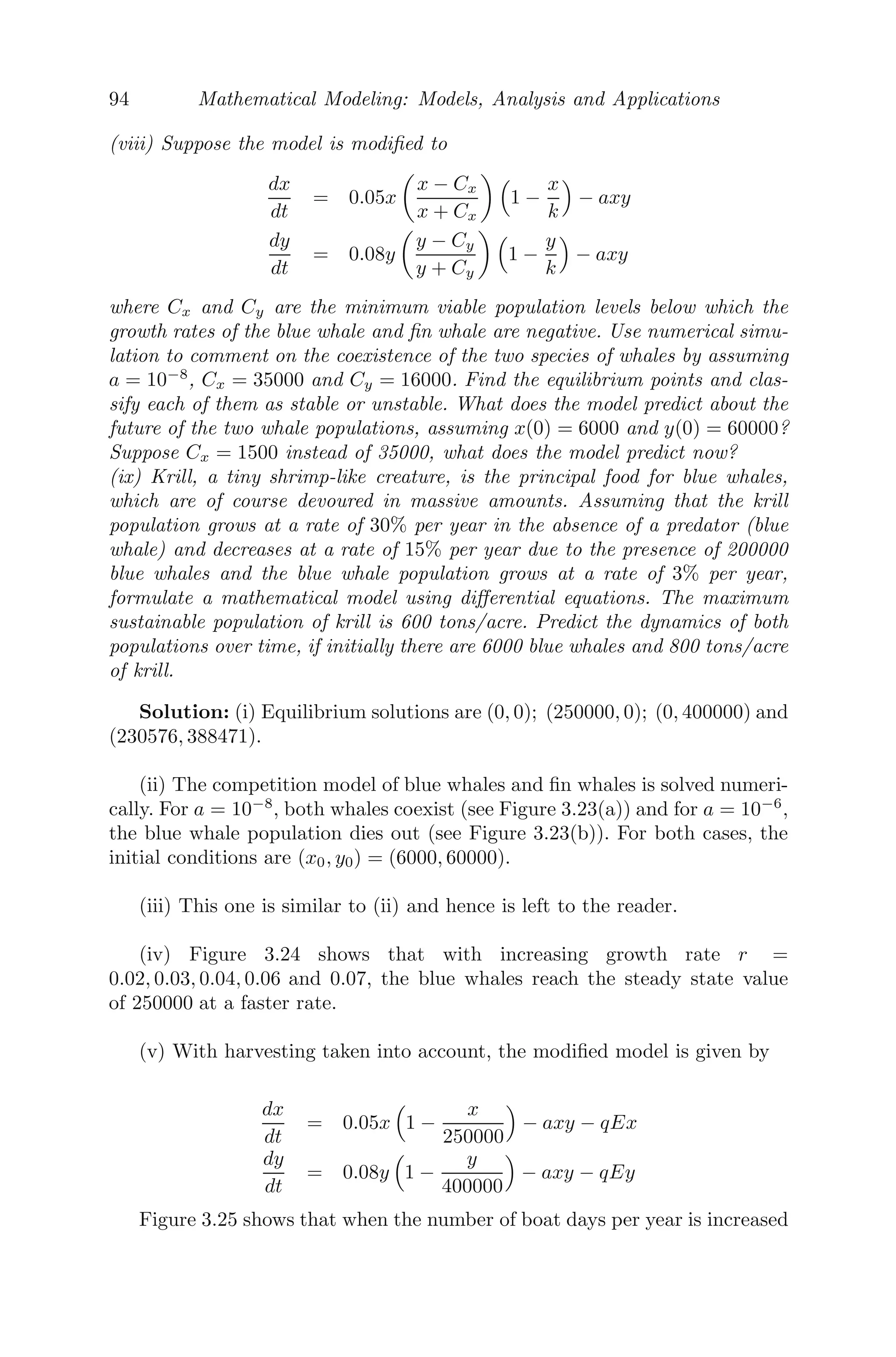
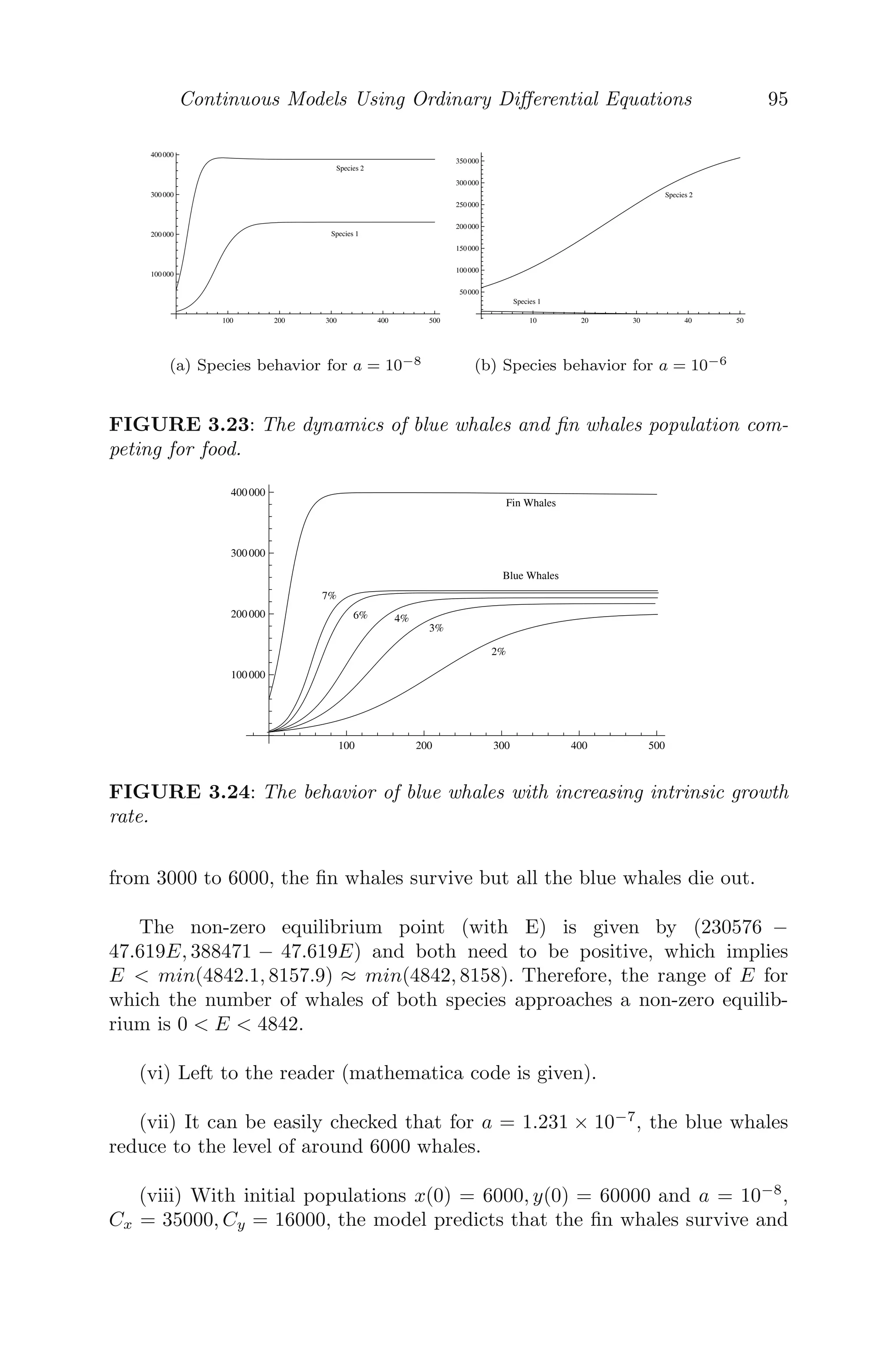
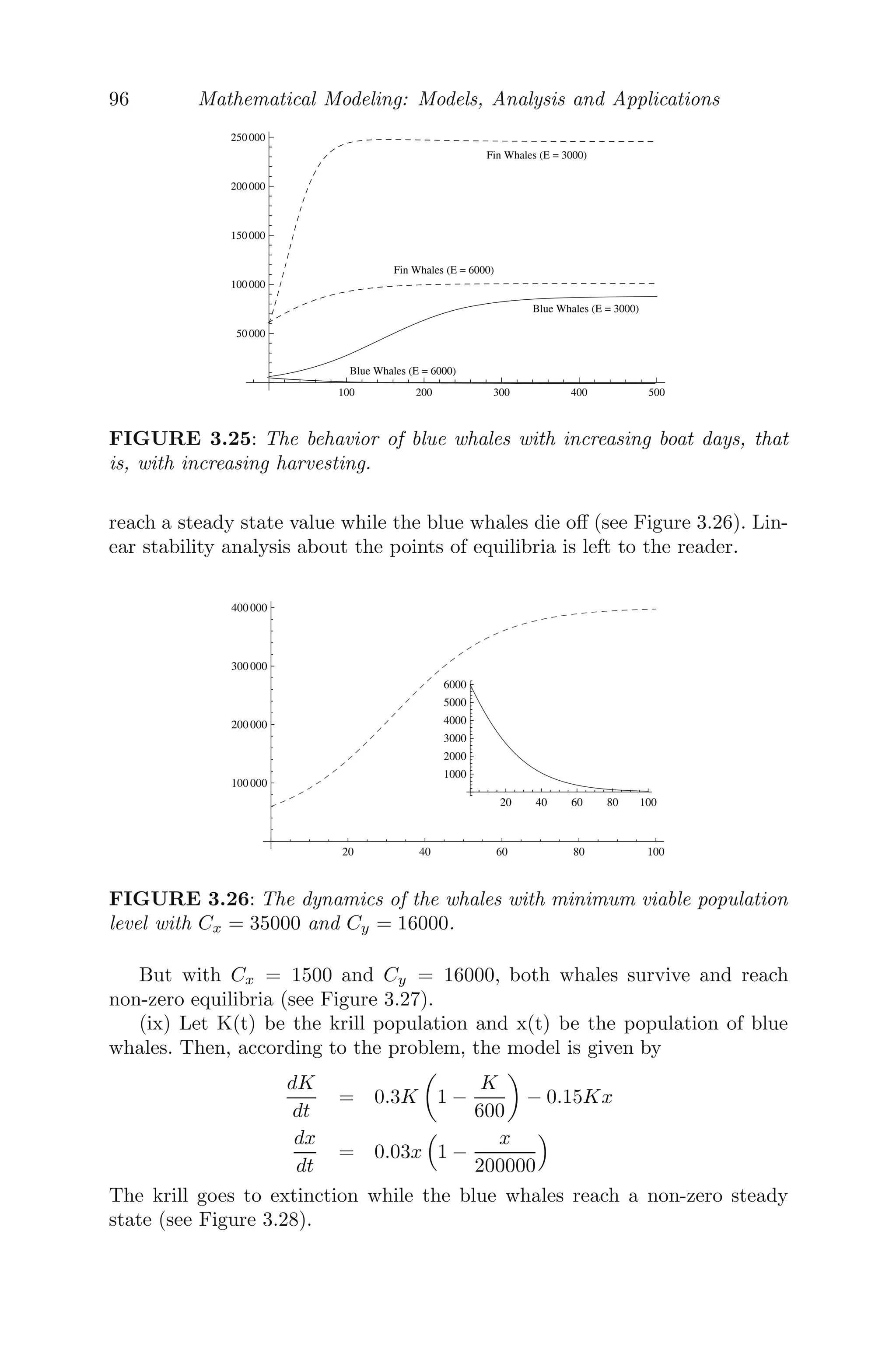
![Continuous Models Using Ordinary Differential Equations 73
(a) Eigenvalues with positive real
parts
(b) Unstable focus
FIGURE 3.13: Phase plane diagram showing all the trajectories spiral away
from (0,0), an unstable spiral or an unstable focus.
3.6.1 Saddle-Node Bifurcation
In saddle-node bifurcation, fixed points are created and destroyed. As
the parameter varies, the two equilibria existing on one side of the bifur-
cation disappear on the other side of the bifurcation. This means that as
the parameter varies, two equilibria move towards each other, coincide and
are destroyed. A saddle-node bifurcation of a fixed point of the system
dy
dx = f(x, μ), where x ∈ Rn
and μ ∈ R, occurs at (x∗
, μ∗
) if
(i) there is an equilibrium at x = x∗
for μ = μ∗
, that is f(x∗
, μ∗
) = 0 or
(ii) the Jacobian matrix Dxf(x∗
, μ∗
) has a zero eigenvalue =
∂f
∂x
(x∗,μ∗)
Example 3.6.1 Consider the system [125]
dy
dx
= μ − x2
where μ is the parameter.
The system does not have an equilibrium point for μ 0 and for μ 0, it
has two nontrivial equilibrium points, namely, −
√
μ and +
√
μ. The Jacobian
matrix (in this case, a single element −2x) has a single eigenvalue λ = −2x.
Clearly, the equilibrium point
√
μ is a stable node and −
√
μ is an unstable
node (why?).
Now, it is noted that at (0, 0),
(i) f(x, μ) = μ − x2
/(0,0) = 0
(ii) Dxf =
∂f
∂x
/(0,0) has a zero eigenvalue at μ = 0](https://image.slidesharecdn.com/mathematicalmodelingmodelsanalysisandapplicationspdfdrive-211127122602/75/Mathematical-modeling-models-analysis-and-applications-pdf-drive-120-2048.jpg)
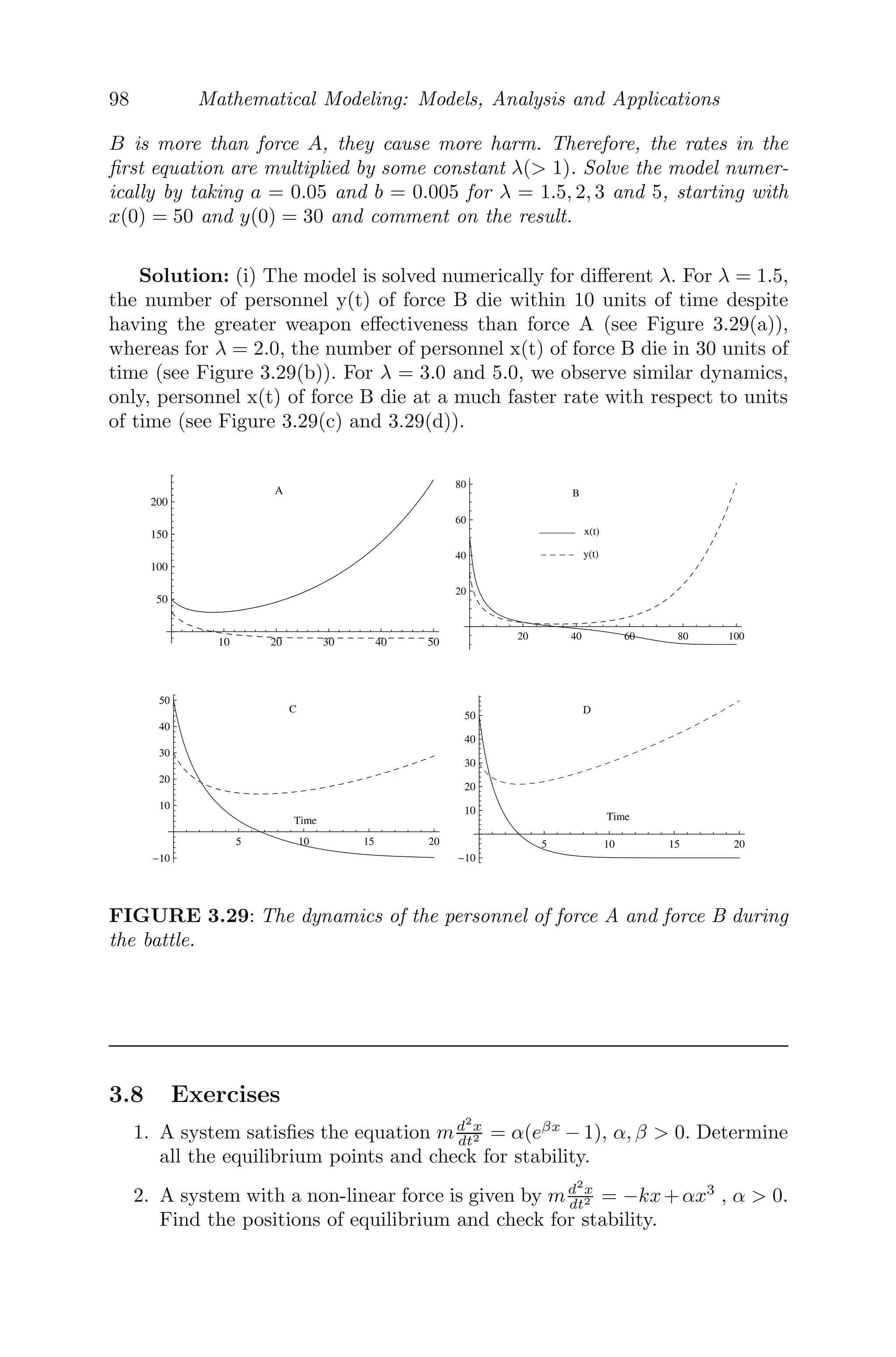
![Continuous Models Using Ordinary Differential Equations 75
Following Sotomayor’s theorem [98, 125], let ν = w = (1, 0)T
, then
wT
fμ(0, 0) =
1 0
1
0
= 1 = 0
and
wT
[D2
f(0, 0)(ν, w)] =
1 0
−2 0
0 0
1
0
= −2 = 0
Therefore, the system experiences a saddle-node bifurcation at the equi-
librium point (0, 0) as the parameter μ passes through μ = 0 (see Figure
3.15).
1.0 0.5 0.5 1.0
Μ
1.0
0.5
0.5
1.0
x
SaddleNode Bifurcation
FIGURE 3.15: A saddle-node bifurcation as μ passes through μ = 0 from
positive to negative.
3.6.2 Transcritical Bifurcation
In transcritical bifurcation, the fixed points change their stability as the
bifurcation parameter is varied. The fixed points of the system exist for all
parameter values and can never be destroyed.
Example 3.6.3 Consider a system given by [125]
dx
dt
= μx − x2
dy
dt
= −y](https://image.slidesharecdn.com/mathematicalmodelingmodelsanalysisandapplicationspdfdrive-211127122602/75/Mathematical-modeling-models-analysis-and-applications-pdf-drive-122-2048.jpg)
![76 Mathematical Modeling: Models, Analysis and Applications
The system has two fixed points, namely, (0, 0) and (μ, 0). The Jacobian
matrix
Dxf =
μ − 2x 0
0 −1
Now,
A = Dxf(0, 0) =
μ 0
0 −1
and fμ =
x
0
Clearly, A has a simple eigenvalue at μ = 0 and let υ =
1 0
T
and
w =
1 0
T
be the eigenvectors of A and AT
respectively, corresponding
to the eigenvalue λ = 0. Following Sotomayor’s theorem [98, 125], we have
wT
fμ(0, 0) =
1 0
0
0
= 0
wT
[Dfμ(0, 0)υ] =
1 0
1
0
wT
[D2
f(0, 0)(υ, υ)] =
1 0
−2 0
0 0
1
0
= −2 = 0
Therefore, the system experiences a transcritical bifurcation at the equilibrium
point (0 ,0) as the parameter μ passes through μ = 0.
1.0 0.5 0.0 0.5 1.0
1.0
0.5
0.0
0.5
1.0
Μ
x
Transcritical Bifurcation
FIGURE 3.16: A transcritical bifurcation at the equilibrium point (0,0) as
the parameter μ passes through μ = 0.
For μ 0, the equilibrium point (μ, 0) is unstable and (0, 0) is stable](https://image.slidesharecdn.com/mathematicalmodelingmodelsanalysisandapplicationspdfdrive-211127122602/75/Mathematical-modeling-models-analysis-and-applications-pdf-drive-123-2048.jpg)
![Continuous Models Using Ordinary Differential Equations 77
with increasing μ. The unstable fixed point (μ, 0) approaches the origin and
coalesces with it when μ = 0. And, when μ 0, the fixed point (μ, 0) becomes
stable and the origin becomes unstable. Thus, in a transcritical bifurcation,
there is a stability switch between two points of equilibria (see Figure 3.16).
3.6.3 Pitchfork Bifurcation
A pitchfork bifurcation is a particular type of local bifurcation (possible in
dynamical systems) that have a symmetry. In such cases equilibrium points
appear and disappear in symmetrical pairs. There are two types of pitchfork
bifurcations, namely supercritical and subcritical.
Example 3.6.4 Consider the system [125]
dx
dt
= f(x; μ) = μx − x3
dy
dt
= −y
There are three fixed points, namely, (0, 0), (+
√
μ, 0) and (−
√
μ, 0).
The Jacobian matrix
Dxf =
μ − 3x2
0
0 −1
has the eigenvalue λ = μ at (0, 0) and λ = −2μ at (±
√
μ, 0).
Now,
A = Dxf(0, 0) =
μ 0
0 −1
and fμ =
x
0
Clearly, A has a simple eigenvalue at μ = 0 and let υ =
1 0
T
and
w =
1 0
T
be the eigenvectors of A and AT
respectively, corresponding
to the eigenvalue λ = 0 (since μ = 0). Following Sotomayor’s theorem [125, 98],
we get,
wT
fμ(0, 0) =
1 0
0
0
= 0
wT
[Dfμ(0, 0)υ] =
1 0
1
0
wT
[D2
f(0, 0)(υ, υ)] =
1 0
0 0
0 0
1
0
= 0
wT
[D3
f(0, 0)(υ, υ, υ)] =
1 0
−6 0
0 0
1
0
= −6 = 0](https://image.slidesharecdn.com/mathematicalmodelingmodelsanalysisandapplicationspdfdrive-211127122602/75/Mathematical-modeling-models-analysis-and-applications-pdf-drive-124-2048.jpg)
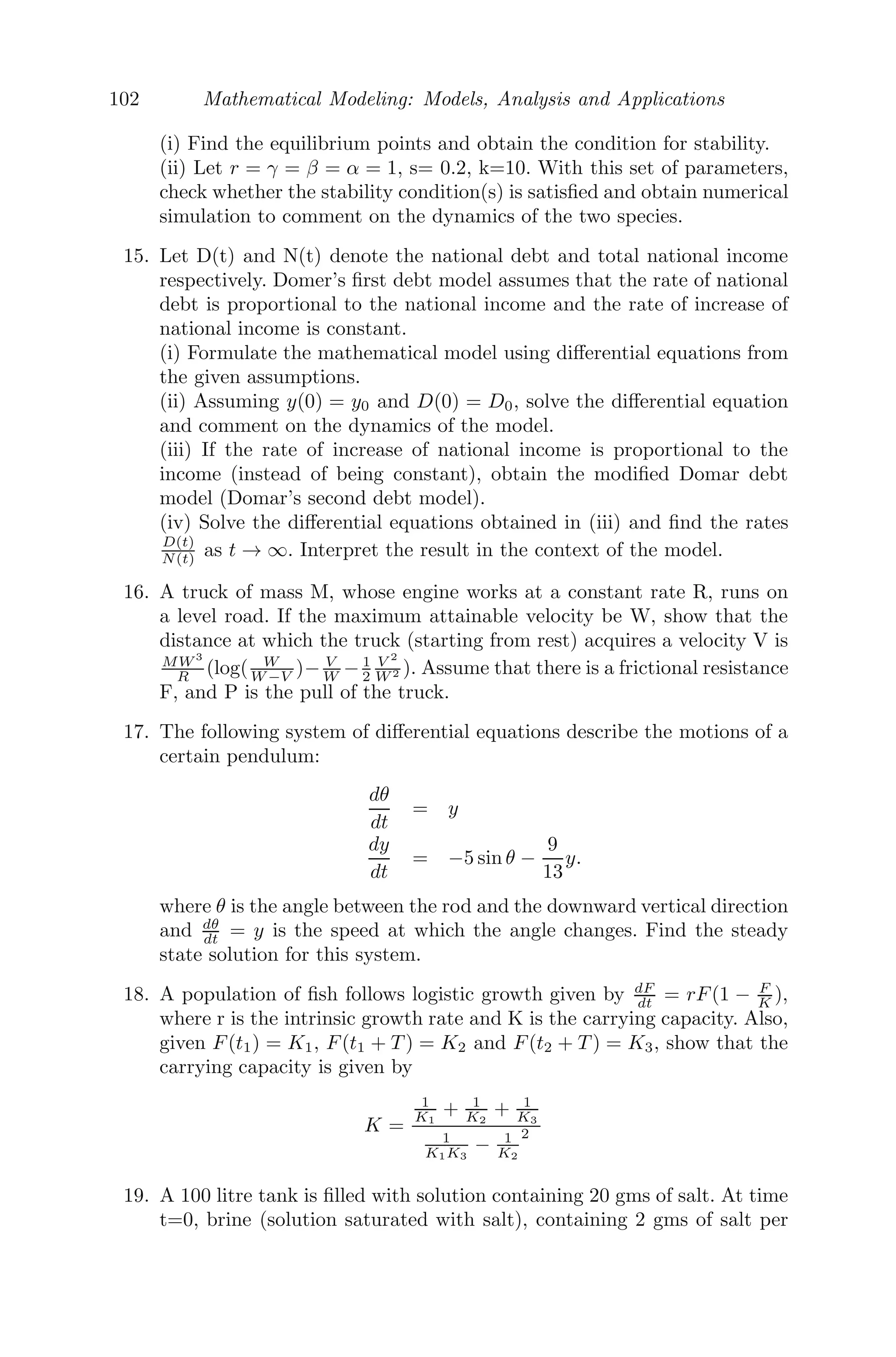
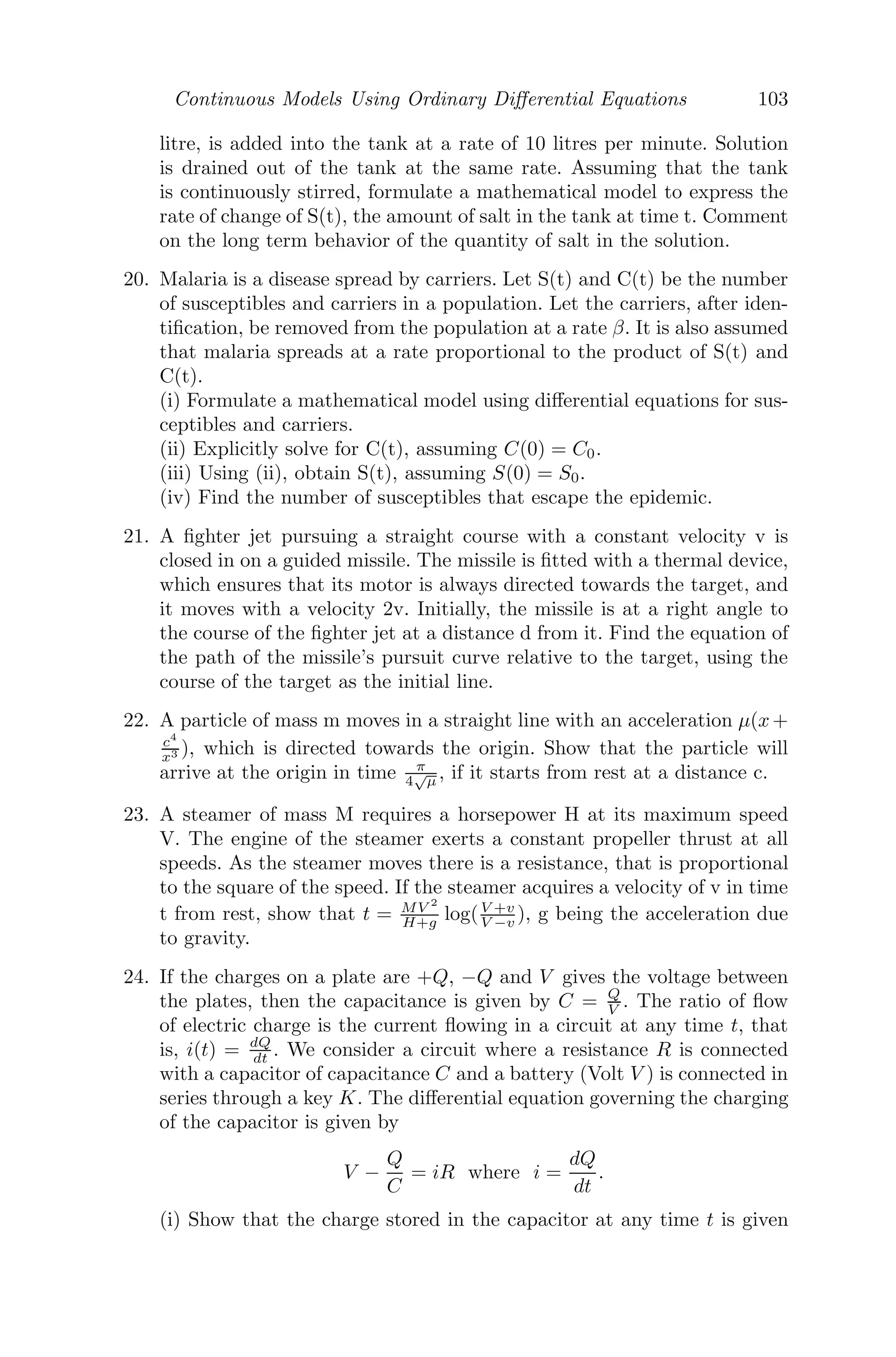
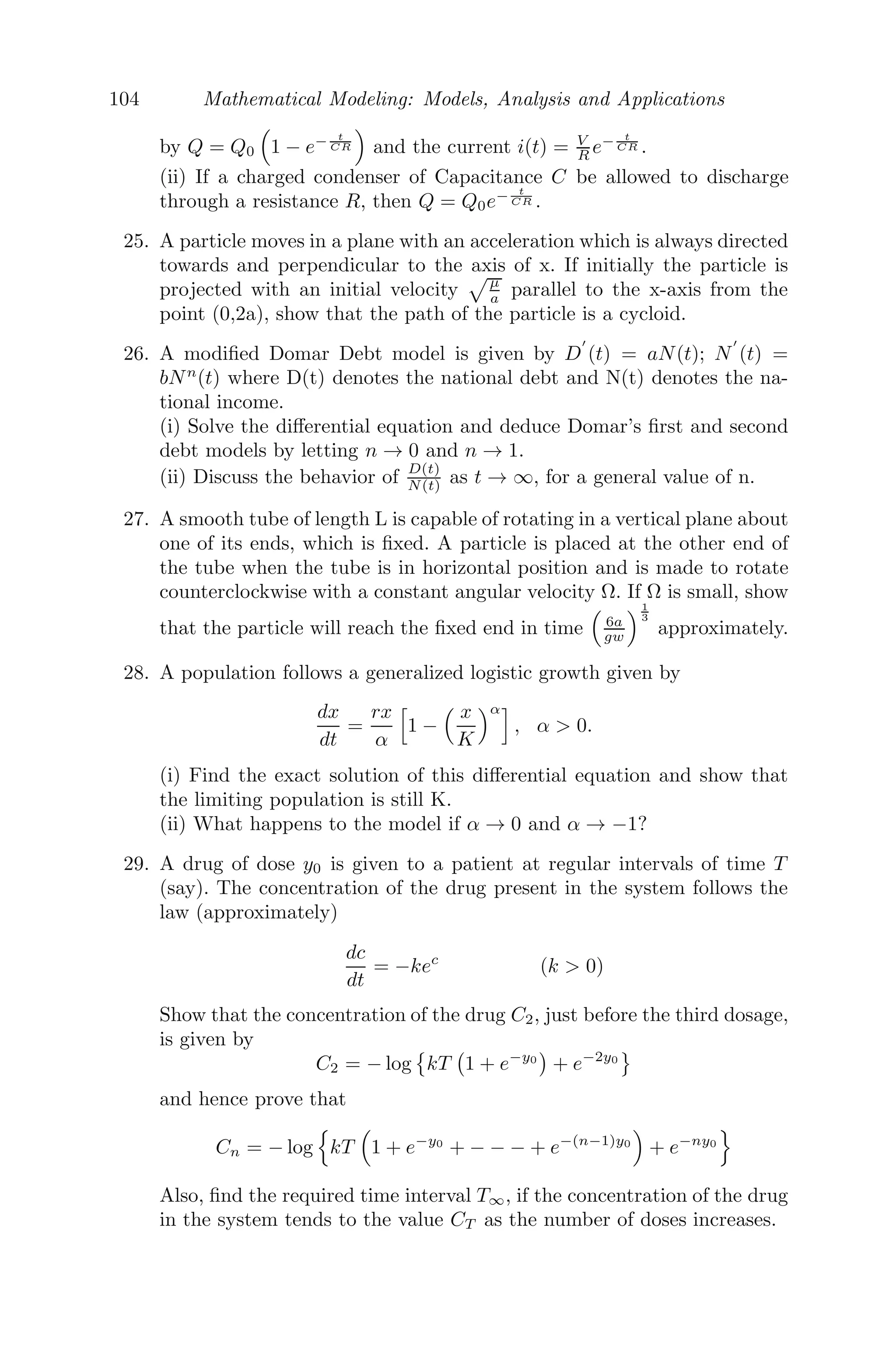
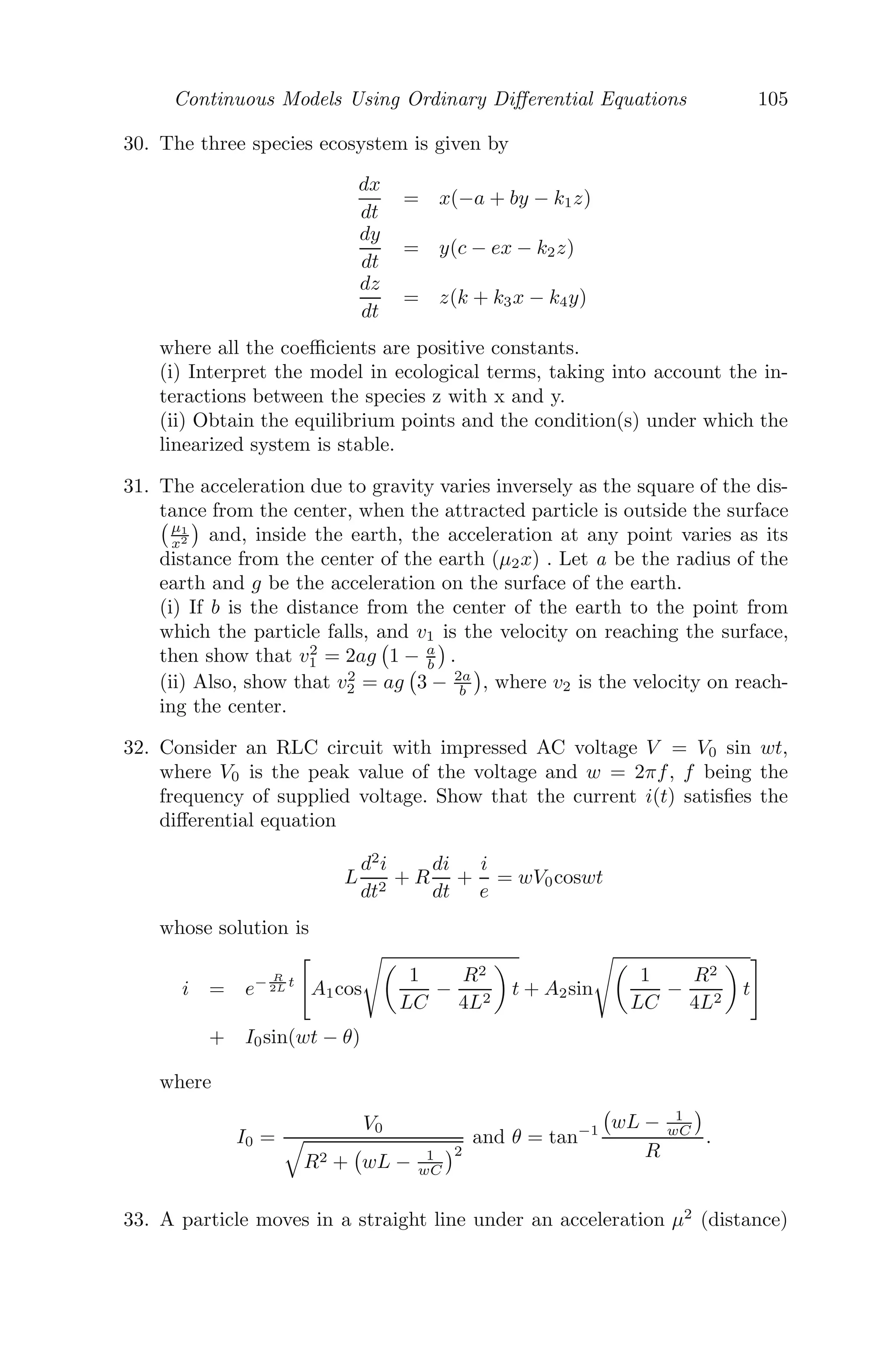
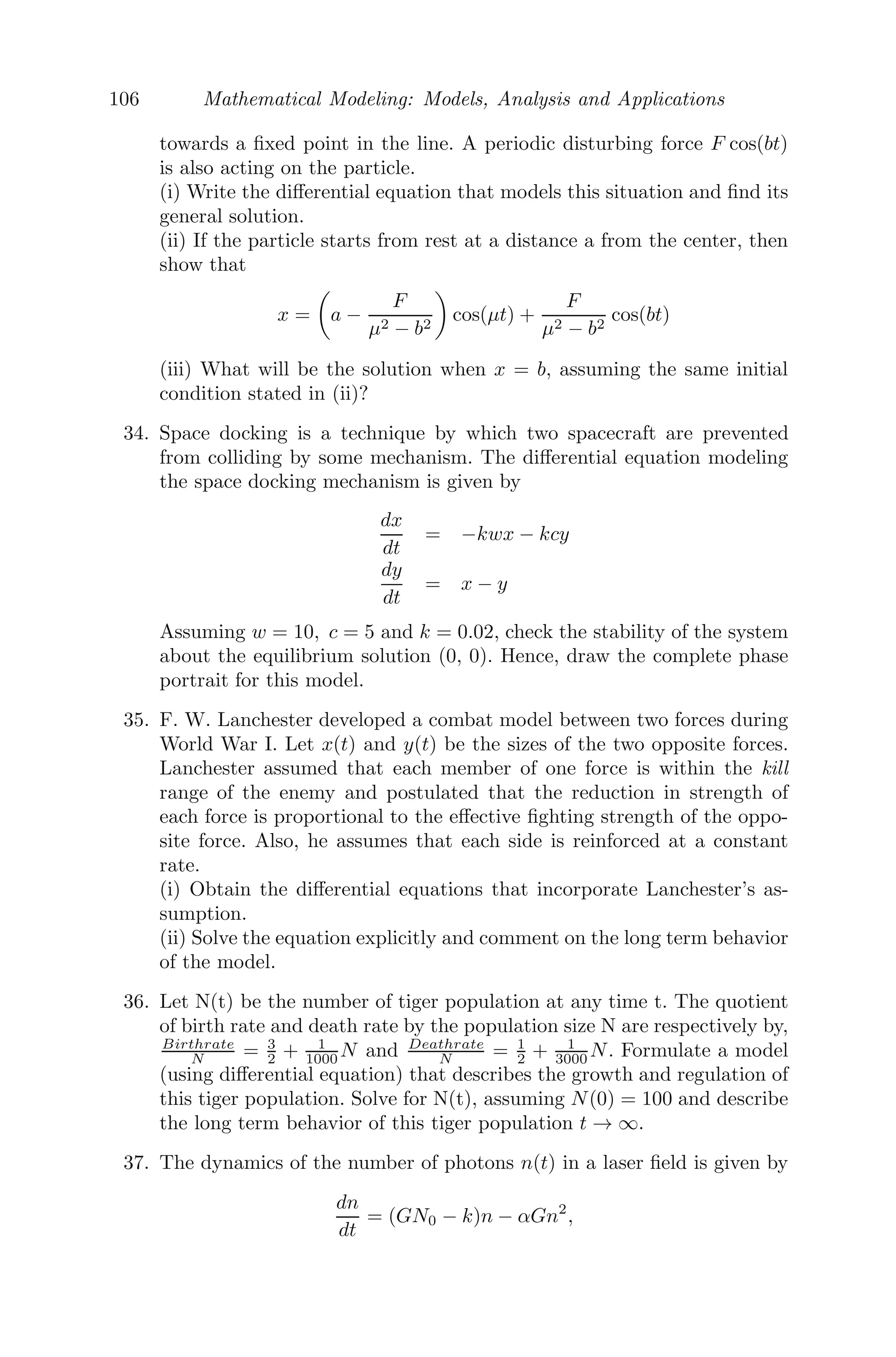
![Continuous Models Using Ordinary Differential Equations 83
where T = tension in the string (a x a + b)
= (modulus of elasticity) ×
increase of length
original length
= λ
x − a
a
[by Hooke’s law].
∴
d2
(x − a)
dt2
= −
λ
am
(x − a), (3.19)
which shows that the motion is simple harmonic about the center A1, ampli-
tude b. The solution of (3.19) is
x − a = K1cos
λ
am
t + K2 sin
λ
am
t
where K1 and K2 are arbitrary constants.
dx
dt
= −K1
λ
am
sin
λ
am
t + K2
λ
am
cos
λ
am
t
When t = 0, the particle was at B1, where x = a + b and dx
dt = 0
⇒ b = K1 and 0 = K2
∴ x − a = b cos
λ
am
t
(3.20)
and
dx
dt
= −b
λ
am
sin
λ
am
t
(3.21)
Let T1 be the time taken by the particle from the point B1 to A1. Then from
(3.20) we get,
0 = b cos
λ
am
T1
[putting x = a]
⇒
λ
am
T1 =
π
2
⇒ T1 =
λ
am
π
2
.
The velocity of the particle at the point A1 is given by (3.21) as
dx
dt
= −b
λ
am
sin
λ
am
T1
= −b
λ
am
sin
π
2
= −b
λ
am
.](https://image.slidesharecdn.com/mathematicalmodelingmodelsanalysisandapplicationspdfdrive-211127122602/75/Mathematical-modeling-models-analysis-and-applications-pdf-drive-130-2048.jpg)
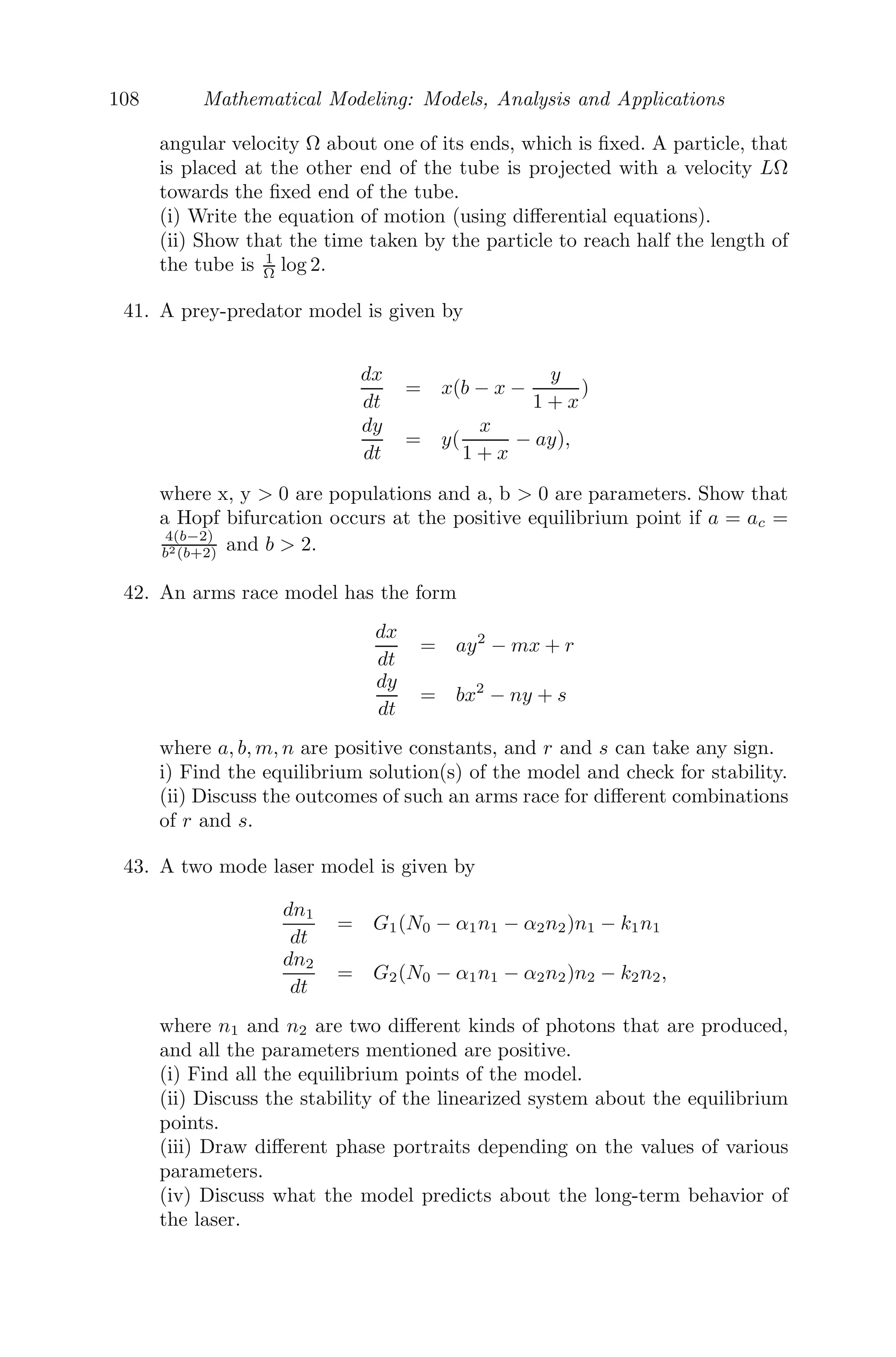
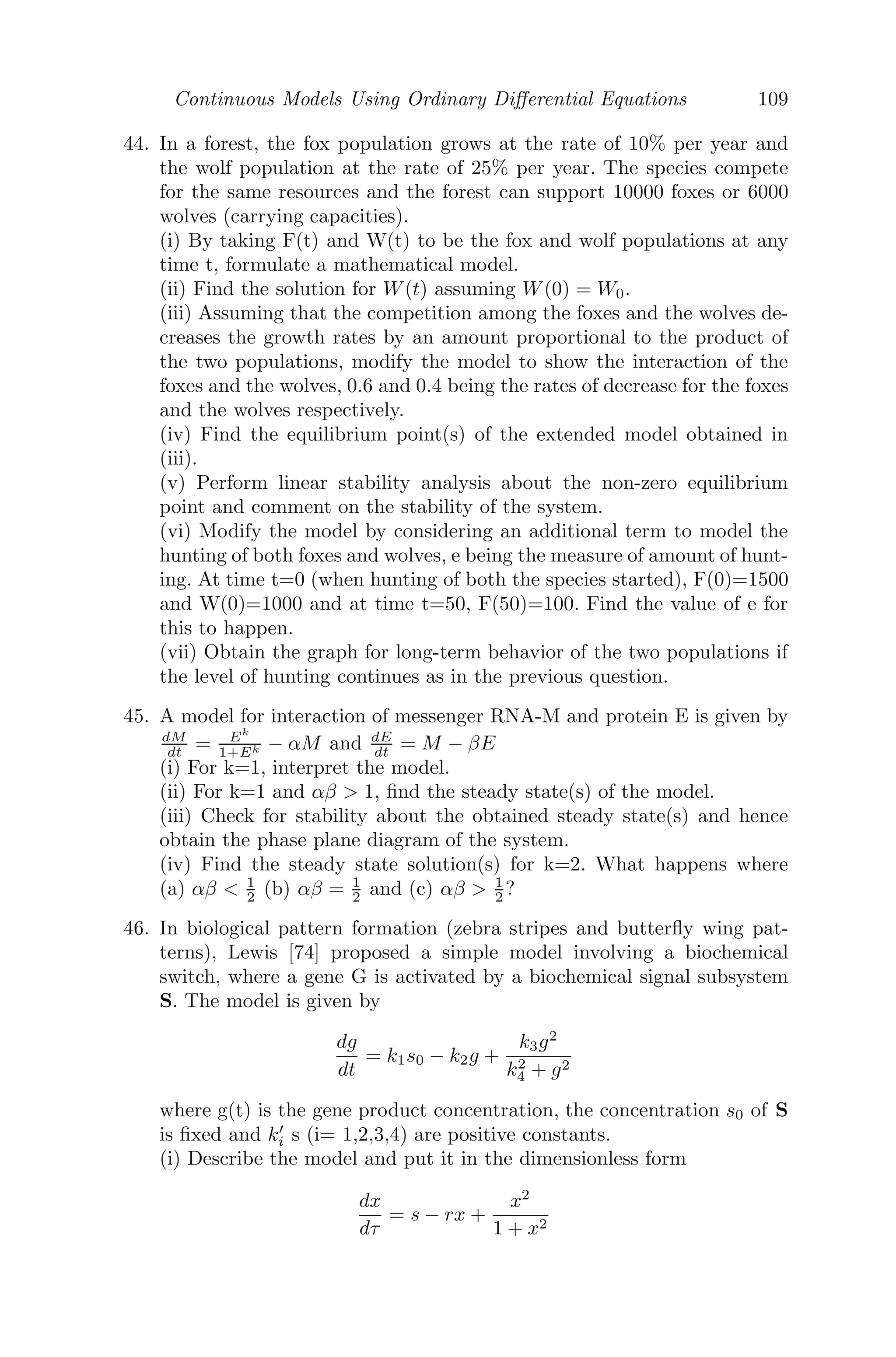
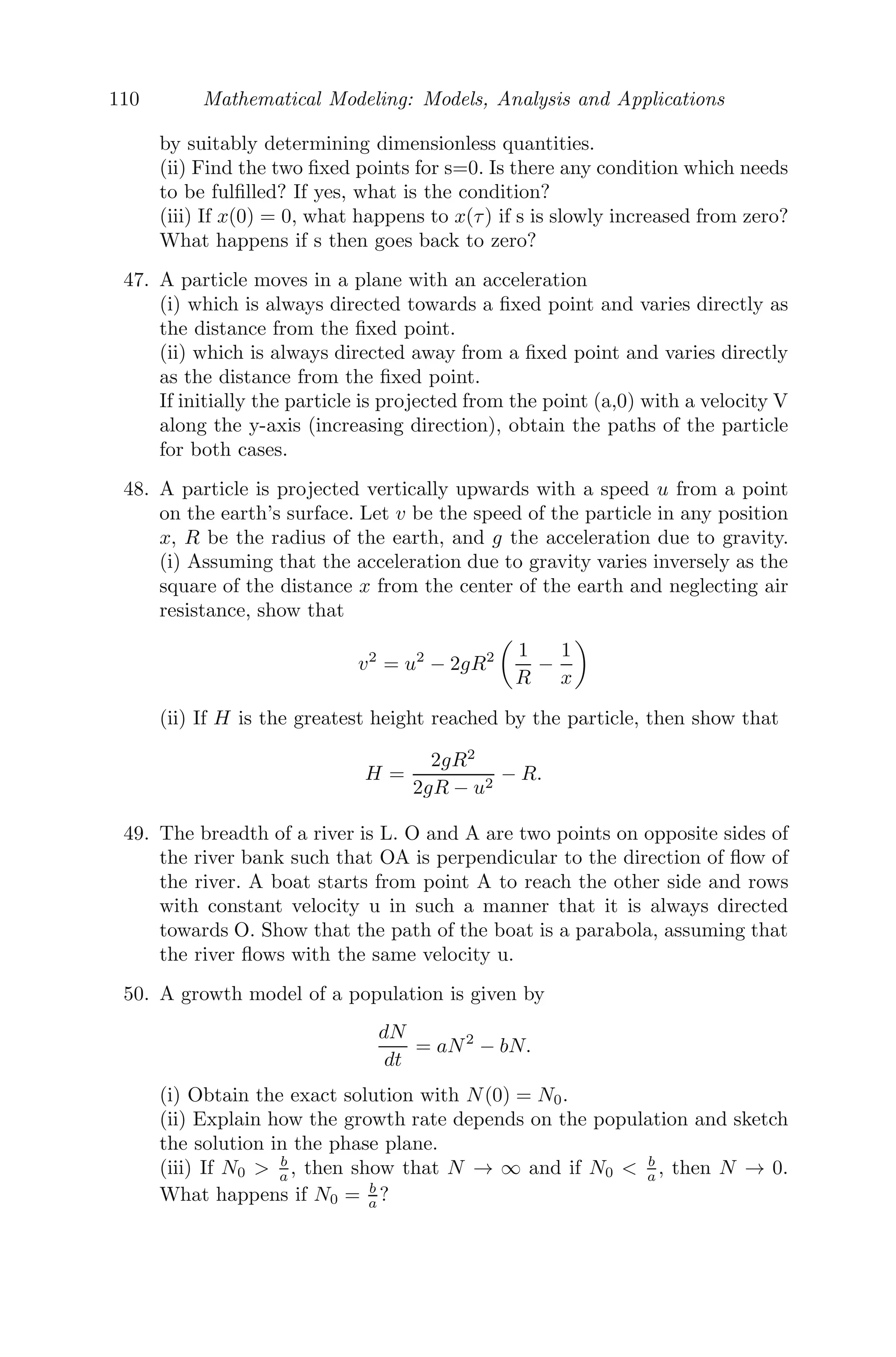
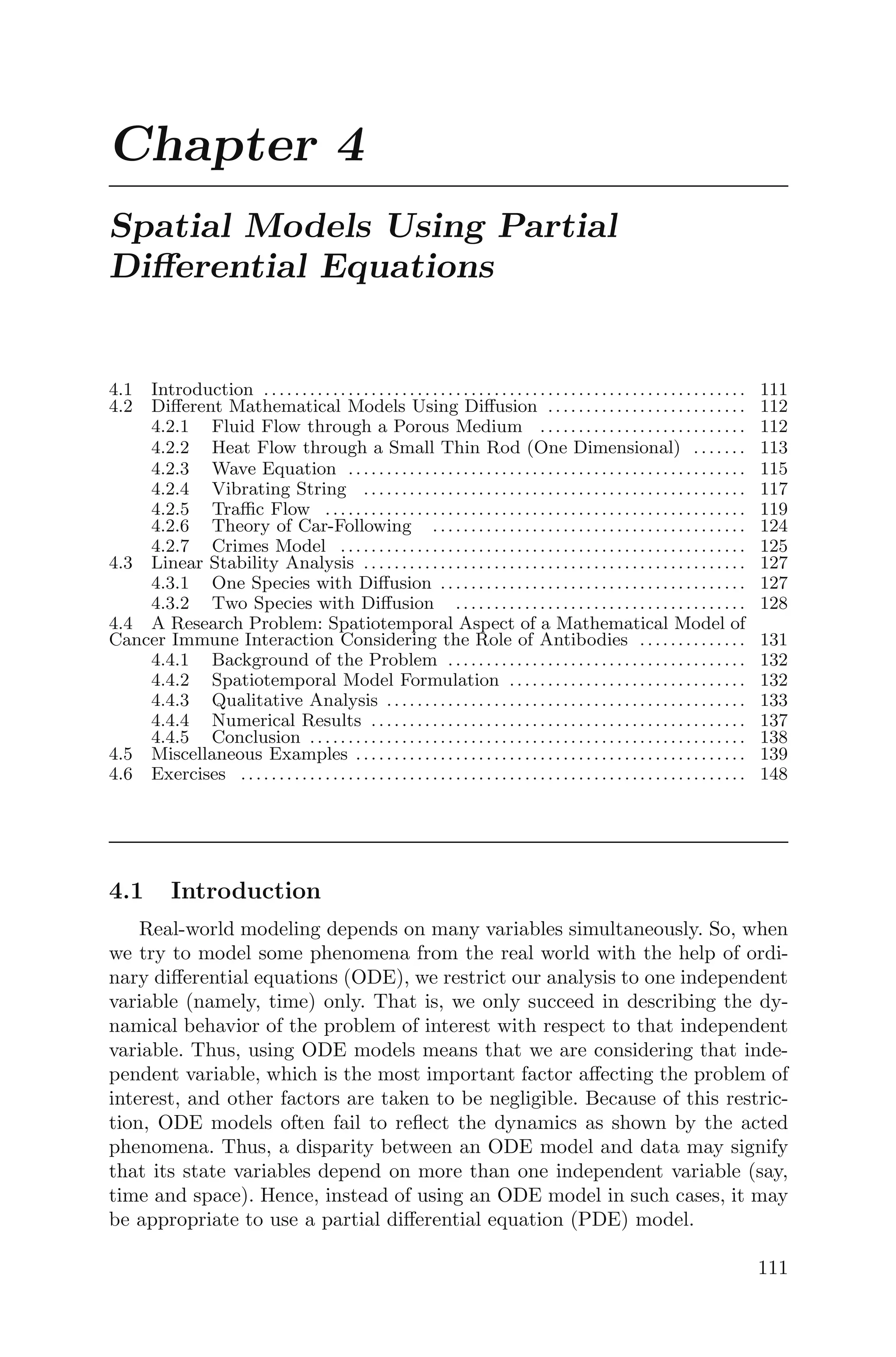
![88 Mathematical Modeling: Models, Analysis and Applications
0 2 4 6 8 10
0
2
4
6
8
10
FIGURE 3.21: The dynamics of the independent trees for different initial
conditions.
(ii) Given that
dp1
dt
= α1p1(k1 − p1)
dp2
dt
= α2p2(k2 − p2)
Now,
dp1
dt
= α1p1(k1 − p1)
⇒
dp1
p1(k1 − p1)
= α1dt
⇒ ln(
p1
k1 − p1
) = k1α1t + c1
⇒ p1 =
k1
1 + Ce−k1α1t
, where C = ec1
.
Figure 3.21 shows the growth of the independent trees in the p1p2 plane
in the rectangle 0 p1 10, 0 p2 10 for given initial values.
Problem 3.7.10 Consider the pricing policy of edible oil, where the manu-
facturers stock the product to meet any sudden unexpected demand from cus-
tomers. Let S(t) and Q(t) be the sales forecast and production forecast respec-
tively and p(t) be the price of edible oil at any time t. Then the general pricing
policy is given by
S(t) = α1 − β1p − γ1
dp
dt
Q(t) = α2 − β2p − γ2
dp
dt
dp
dt
= −γ[L(t) − L0]](https://image.slidesharecdn.com/mathematicalmodelingmodelsanalysisandapplicationspdfdrive-211127122602/75/Mathematical-modeling-models-analysis-and-applications-pdf-drive-135-2048.jpg)
![Continuous Models Using Ordinary Differential Equations 89
Here, α1, α2, β1, β2, γ1, γ2, δ are positive constants, L is the inventory level and
L0 the desired optimum inventory level. The changes in inventory follow the
law
dL
dt
= Q − S.
Show that the equation
d2
p
dt2
+ δ(γ1 − γ2)
dp
dt
+ δ(β1 − β2)p = δ(α1 − α2)
gives the forecast price. Hence, deduce that if γ1 γ2, β1 β2, the price
tends to be stable as t increases.
Solution: Given that,
dL
dt
= Q − S
S(t) = α1 − β1p − γ1
dp
dt
Q(t) = α2 − β2p − γ2
dp
dt
⇒
dL
dt
= (α2 − α1) − p(β2 − β1) − (γ2 − γ1)
dp
dt
Also,
dp
dt
= −γ[L(t) − L0]
⇒
d2
p
dt2
= −δ
dL(t)
dt
⇒
d2
p
dt2
= −δ
(α2 − α1) − p(β2 − β1) − (γ2 − γ1)
dp
dt
⇒
d2
p
dt2
+ δ(γ1 − γ2)
dp
dt
+ δ(β1 − β2)p = δ(α1 − α2), (3.22)
which gives the forecast price. Equation (3.22) is a second order ordinary
differential equation with constant coefficients, whose complementary function
is
Ae−m1t
+ Be−m2t
where m1, m2 = −δ(γ1 − γ2) ± δ
(γ1 − γ2)2 − 4
(β1 − β2)
δ
,
and both are negative as γ1 γ2 and β1 β2. The particular integral is
δ(α1−α2)
δ(β1−β2) . Therefore, the general solution of (3.22) is
p(t) = Ae−m1t
+ Be−m2t
+
δ(α1 − α2)
δ(β1 − β2)](https://image.slidesharecdn.com/mathematicalmodelingmodelsanalysisandapplicationspdfdrive-211127122602/75/Mathematical-modeling-models-analysis-and-applications-pdf-drive-136-2048.jpg)
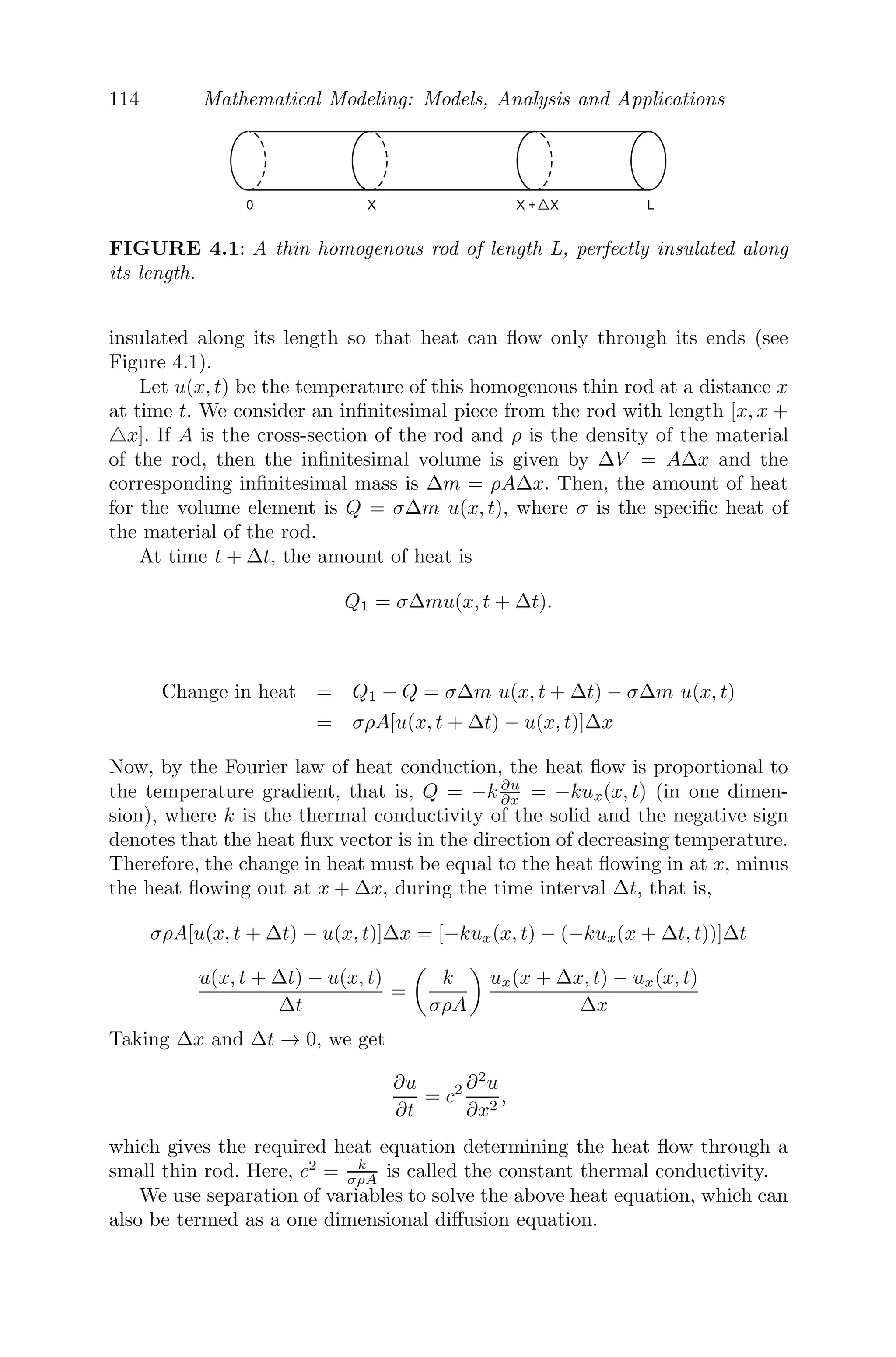
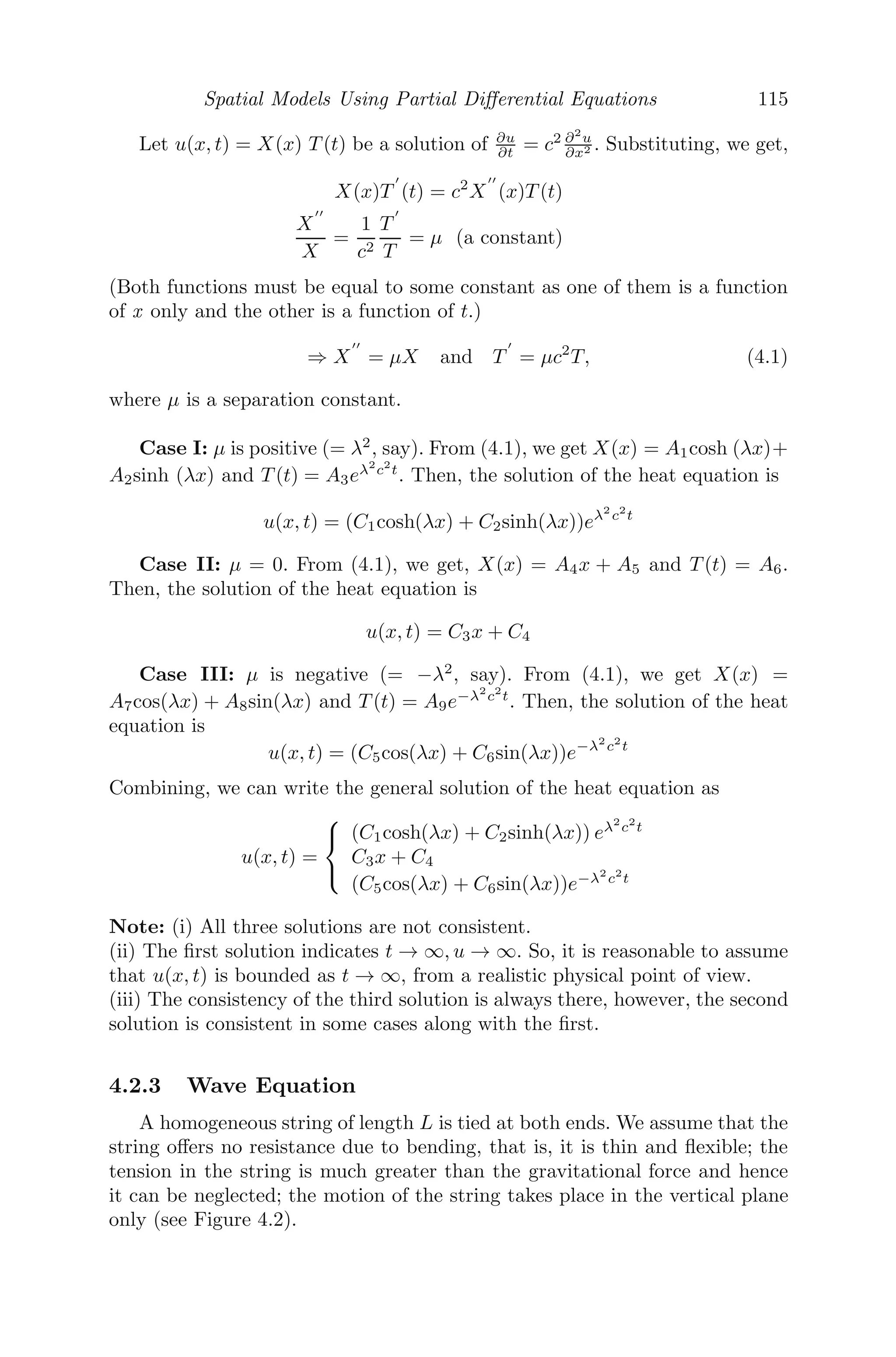
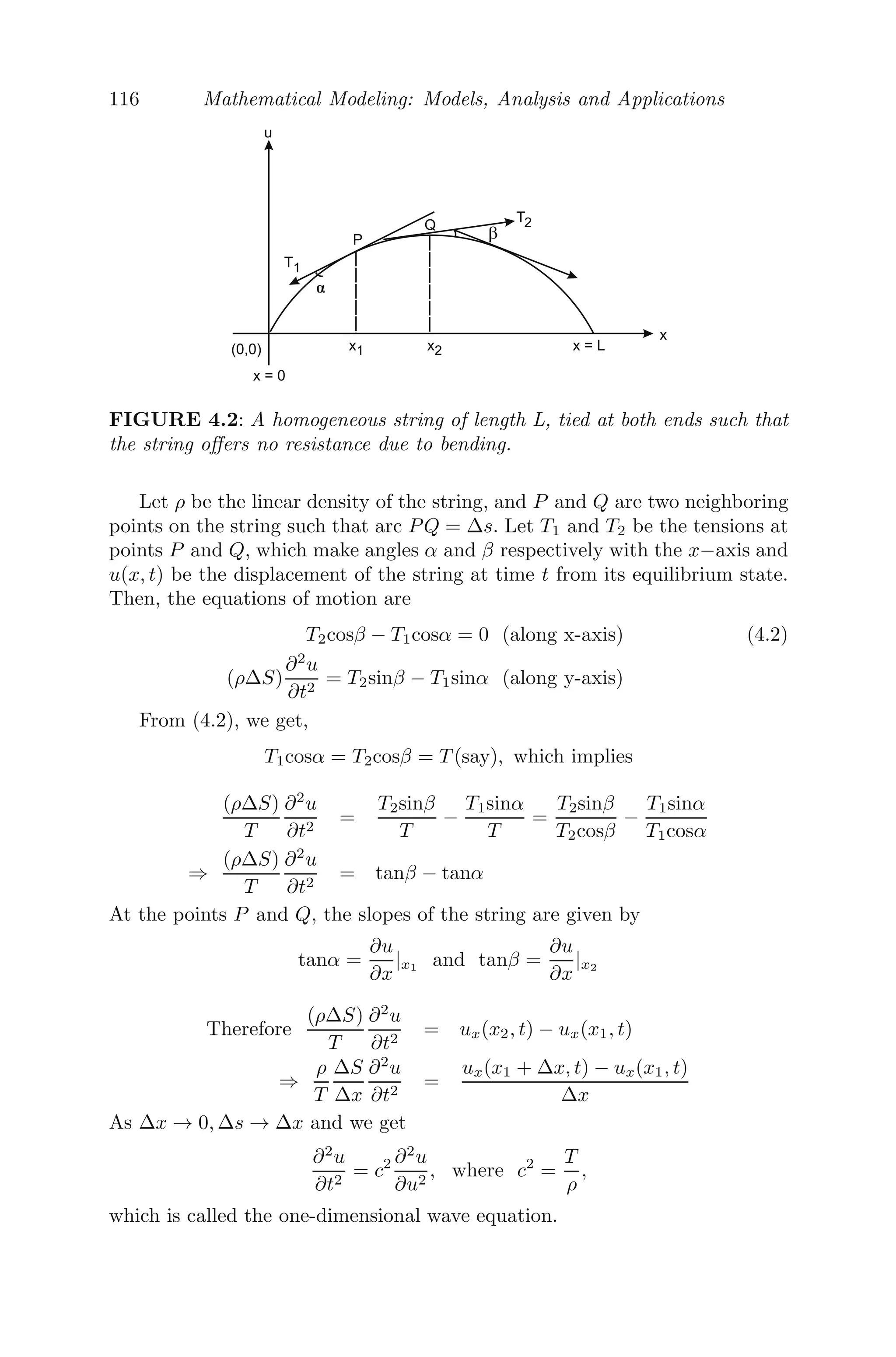
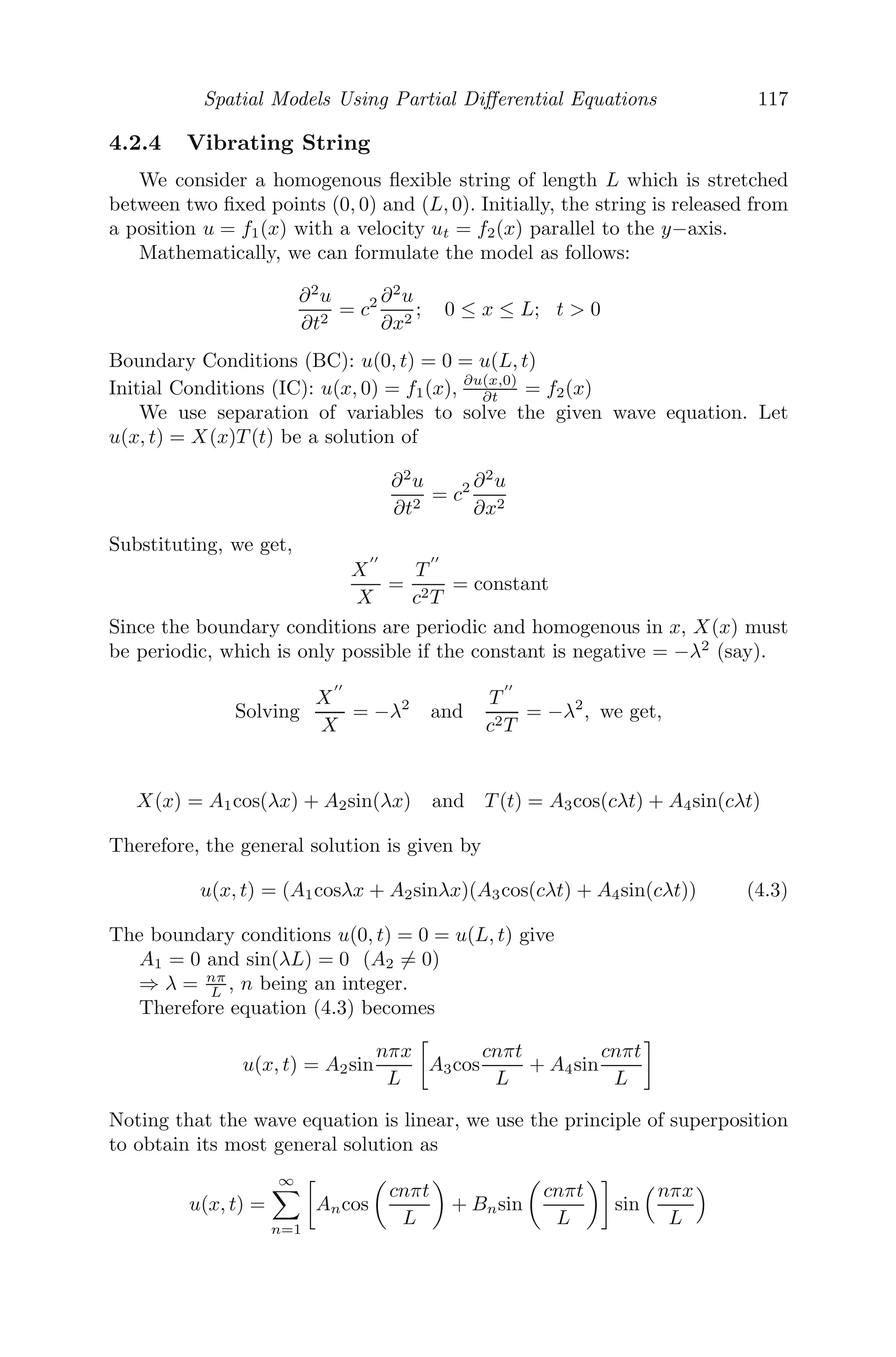
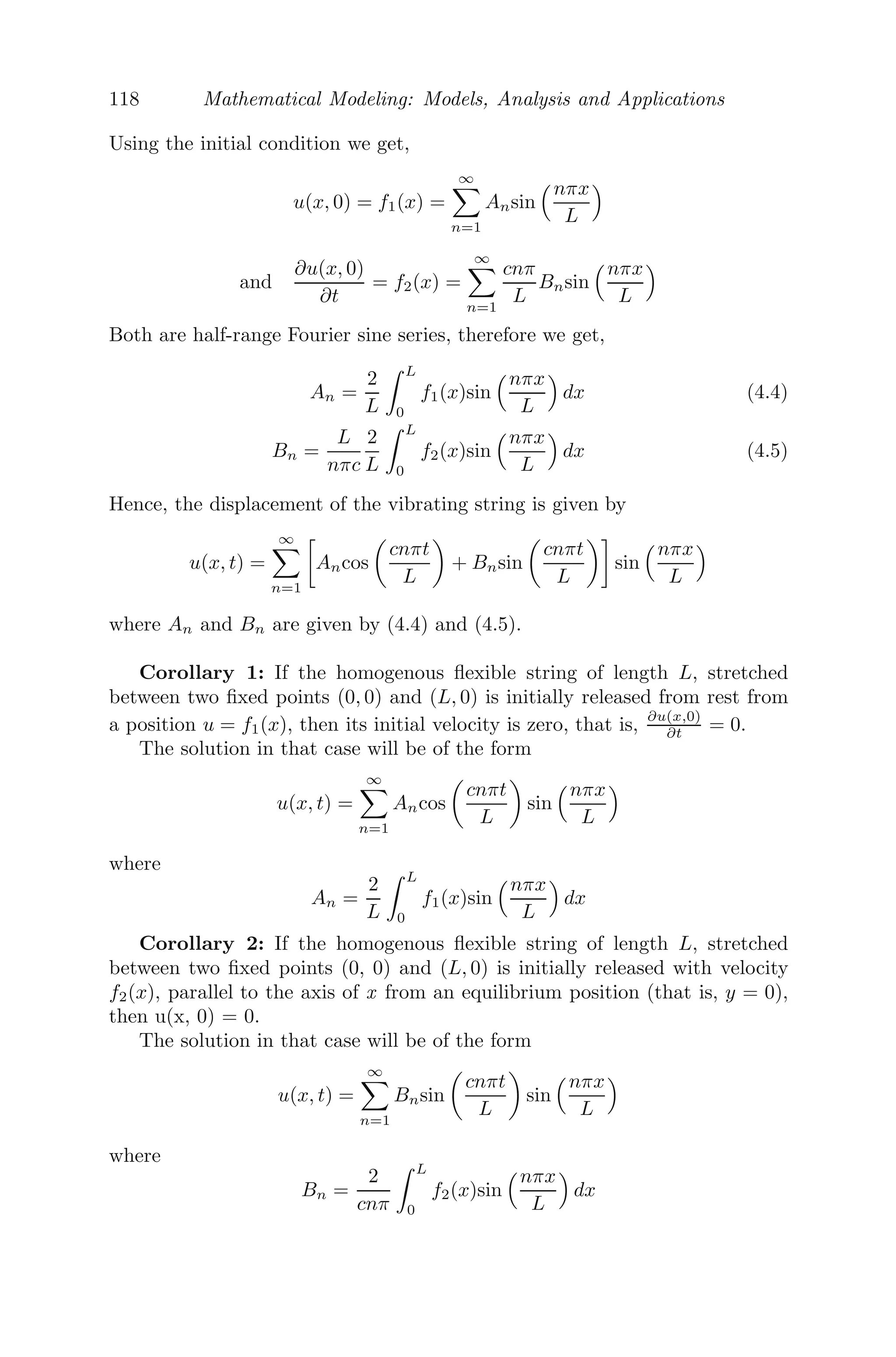
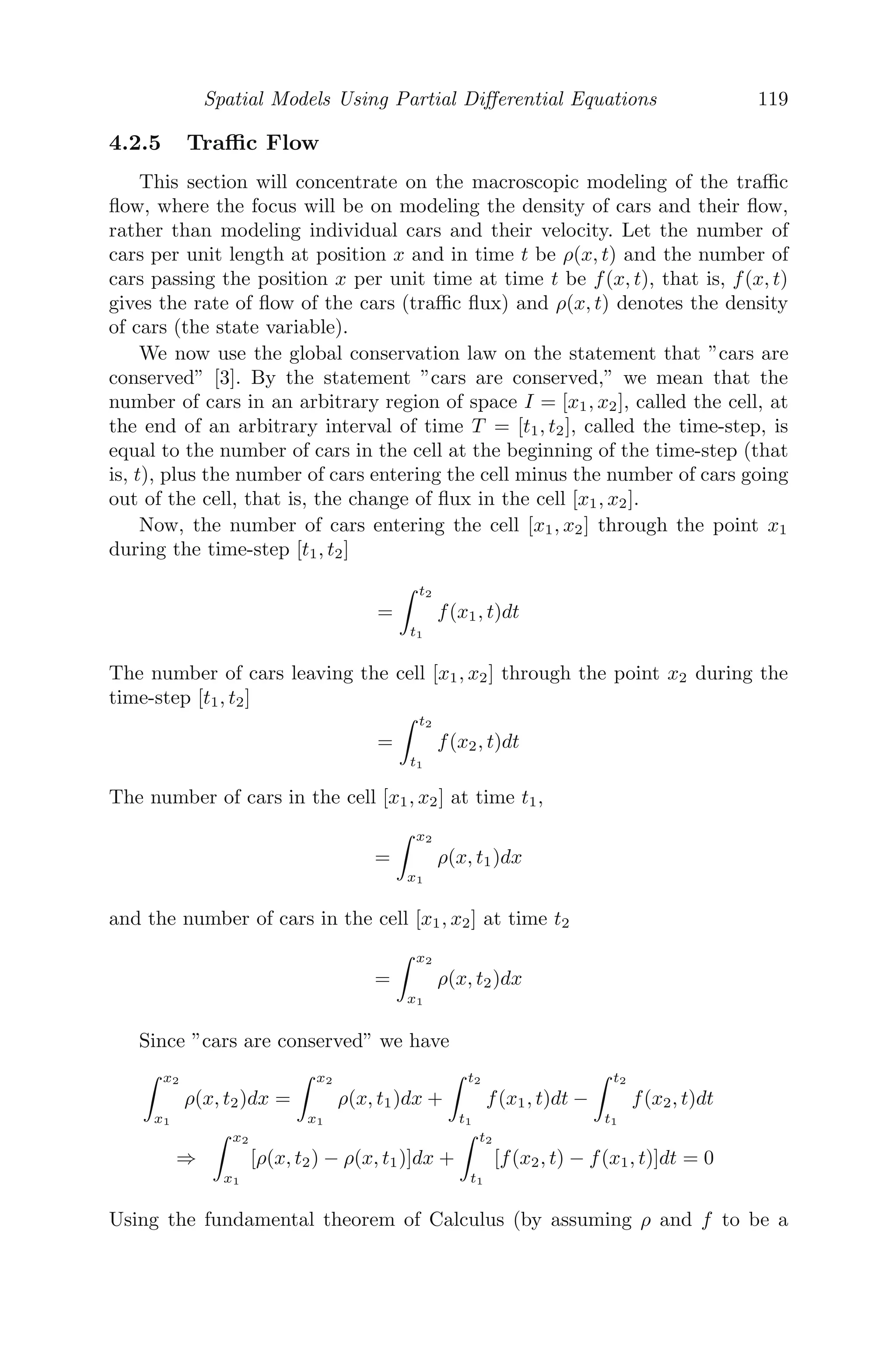
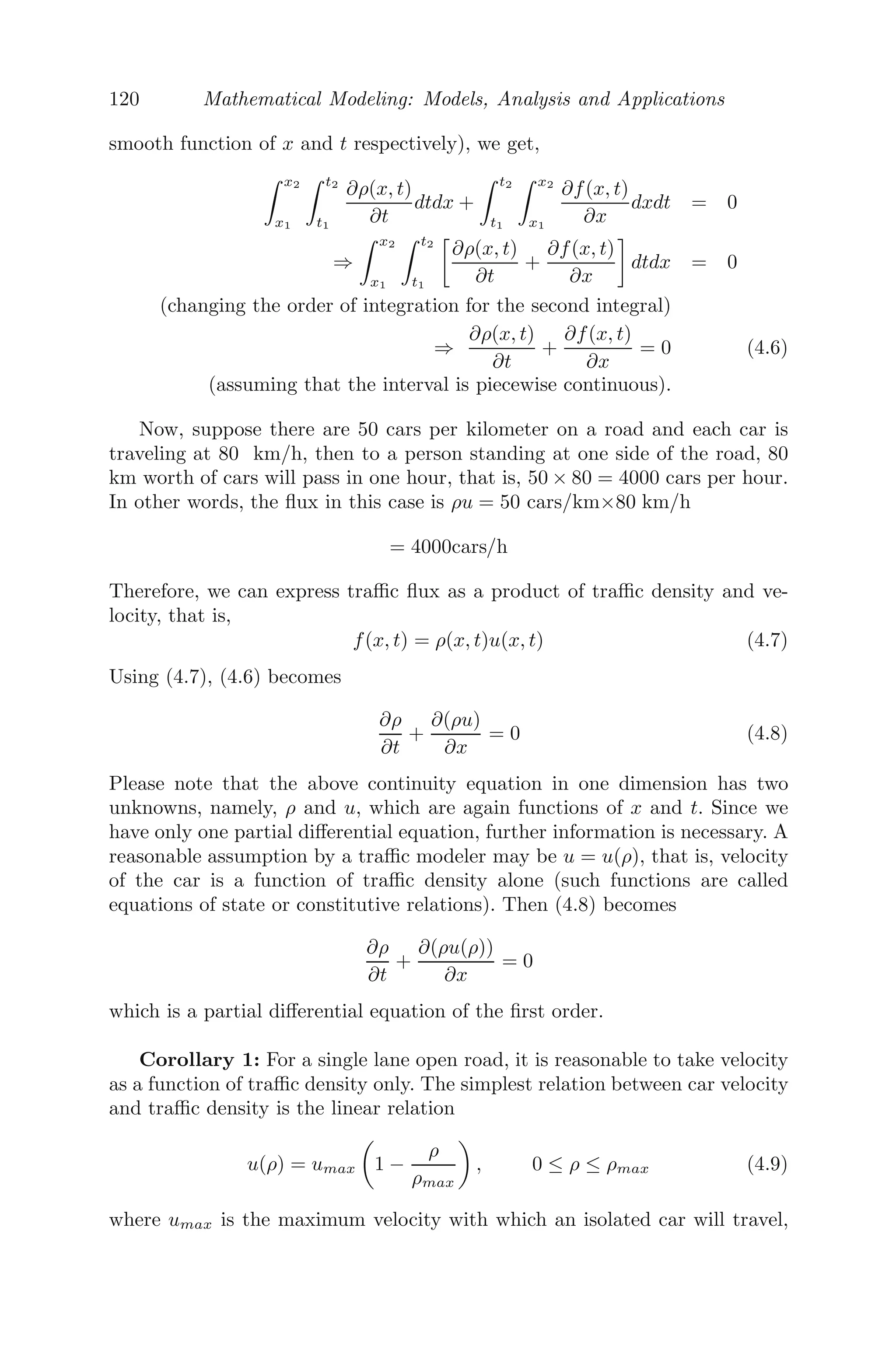
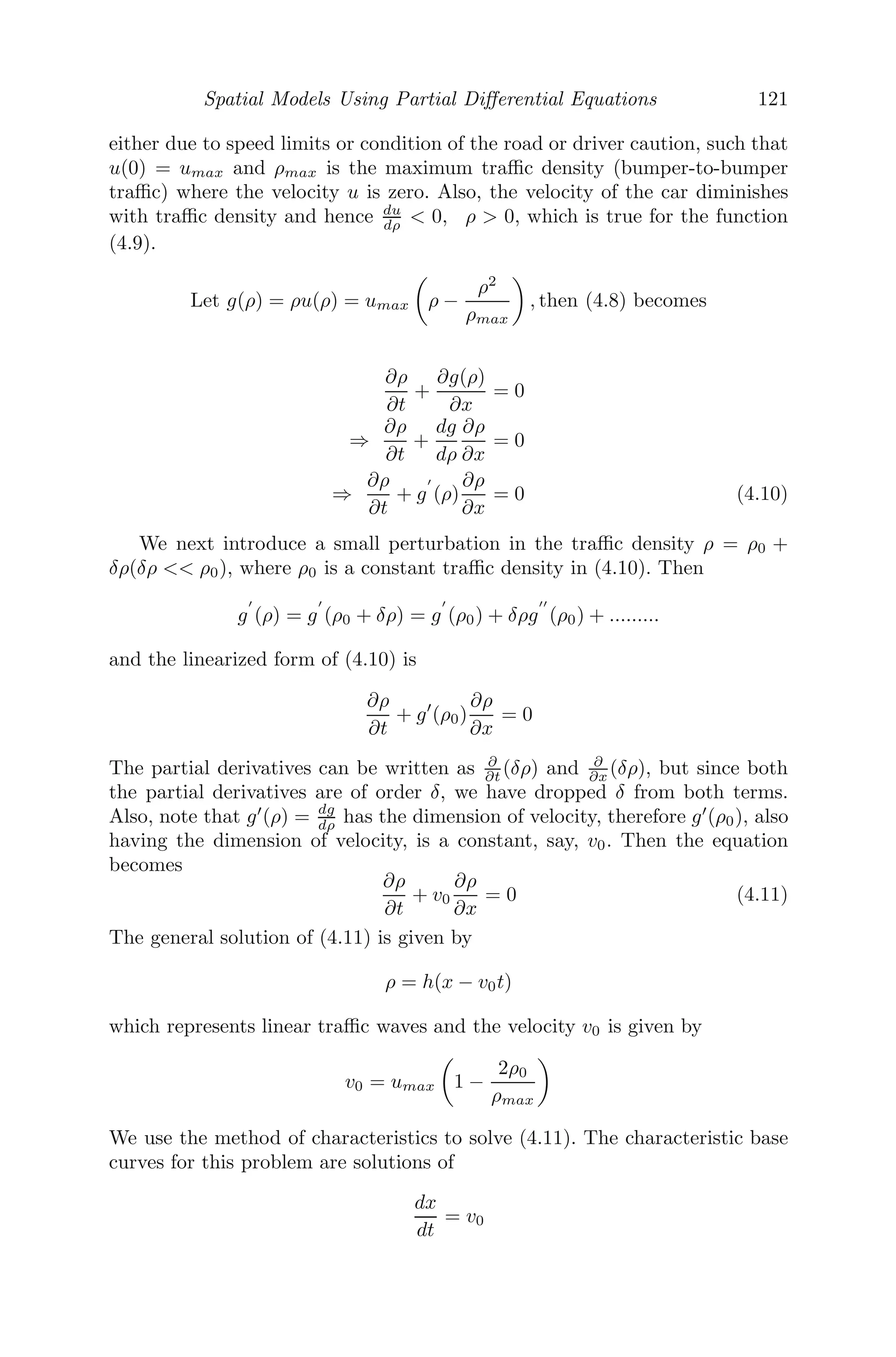


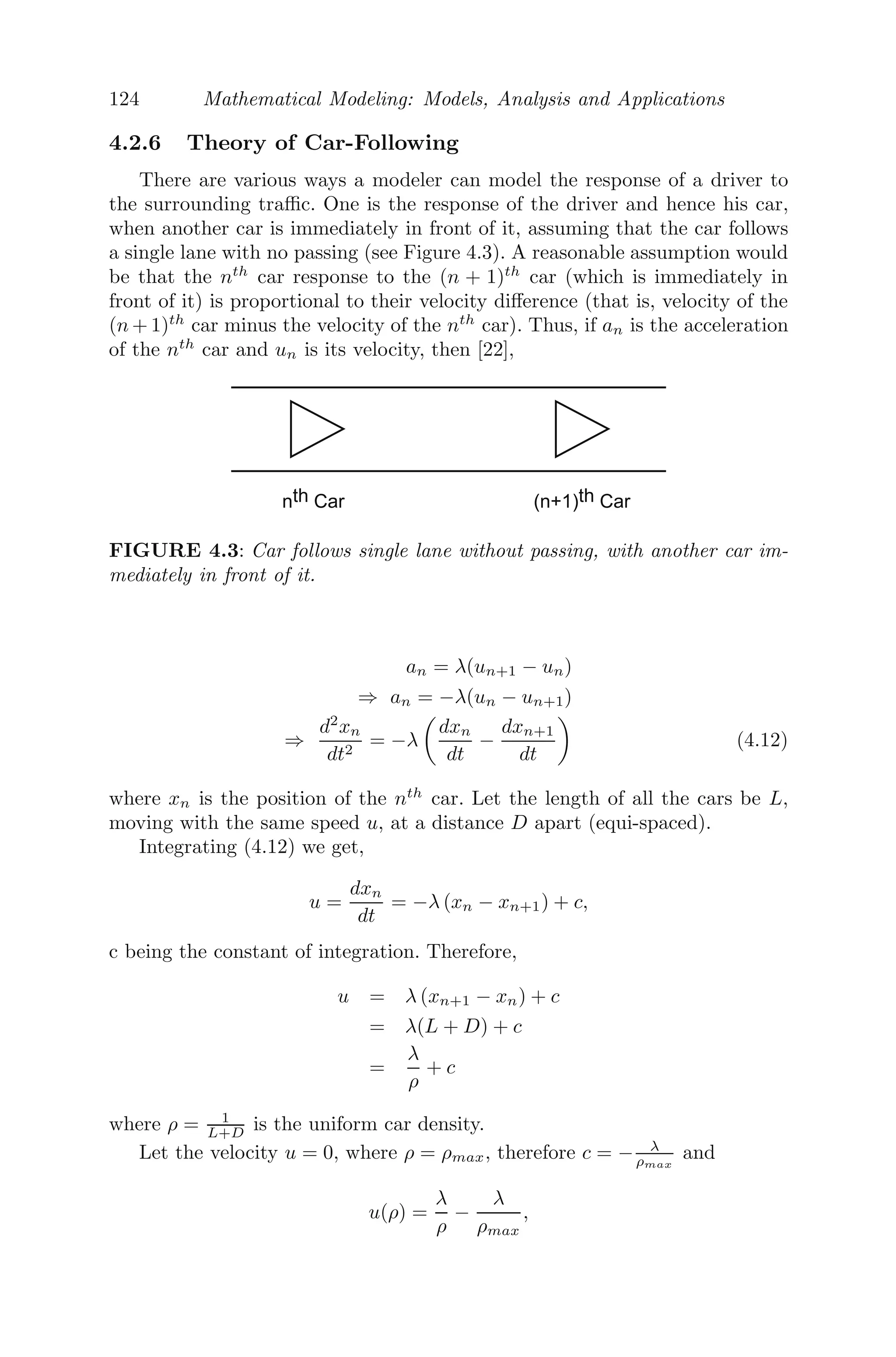

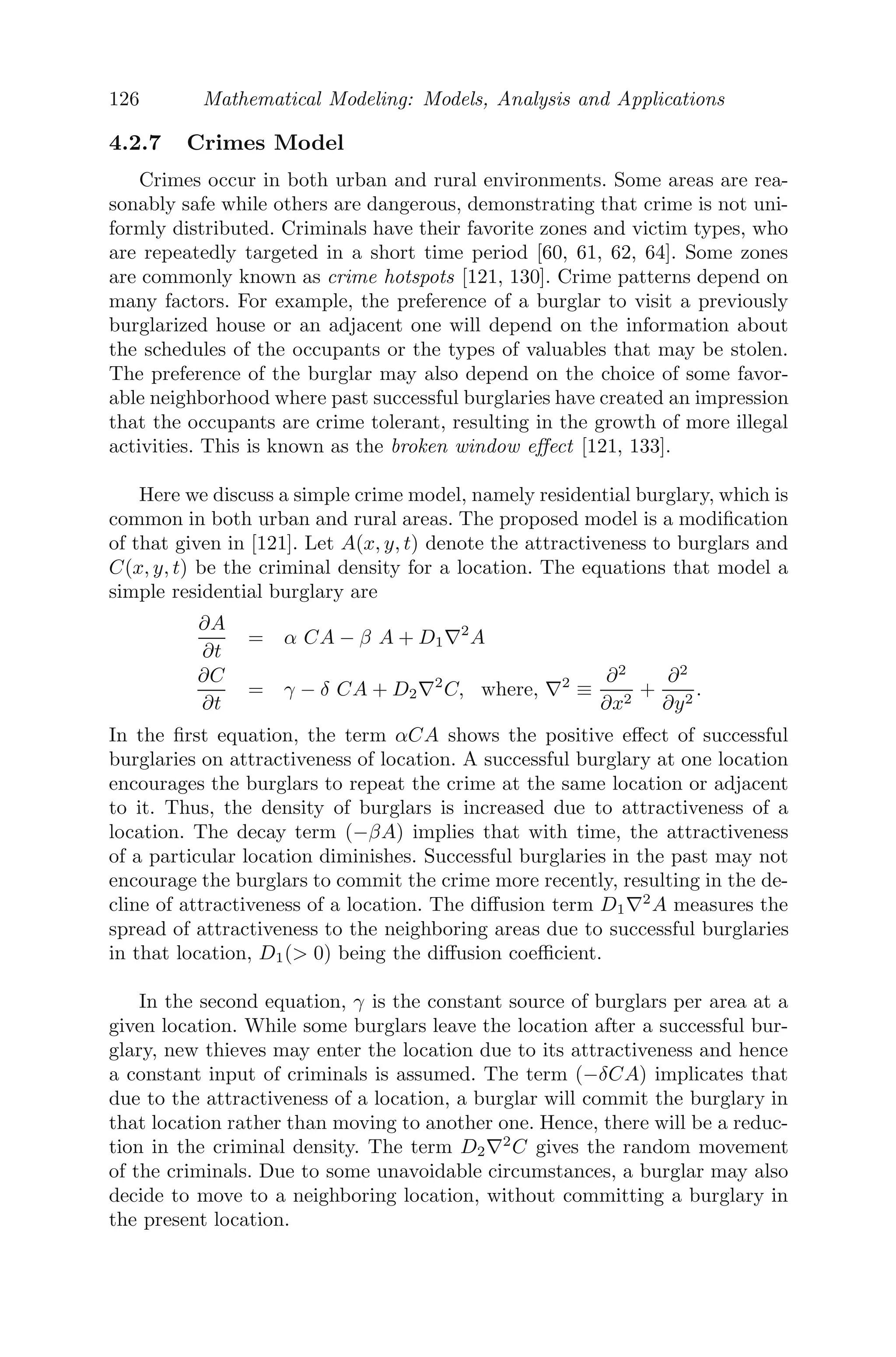
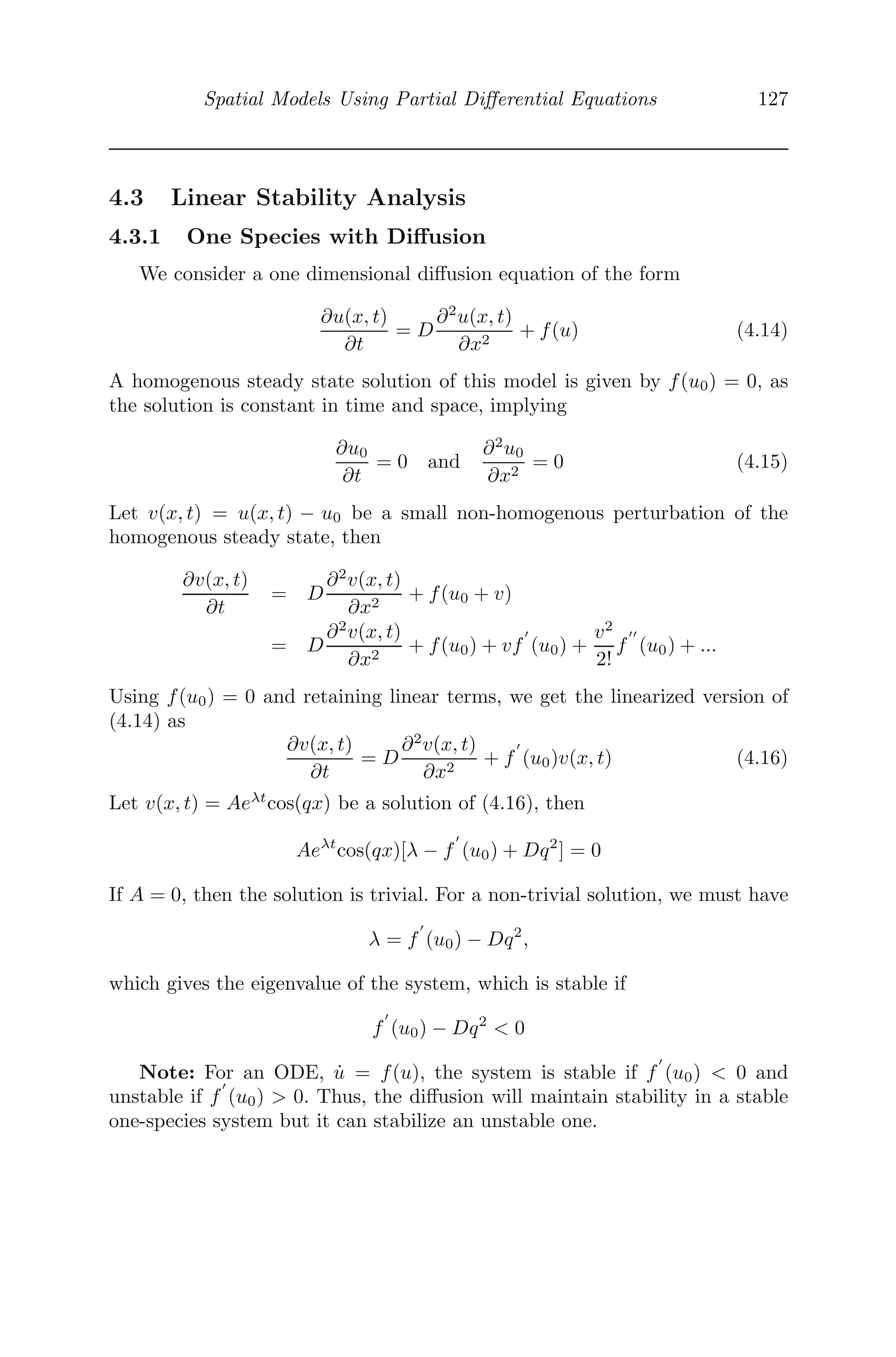
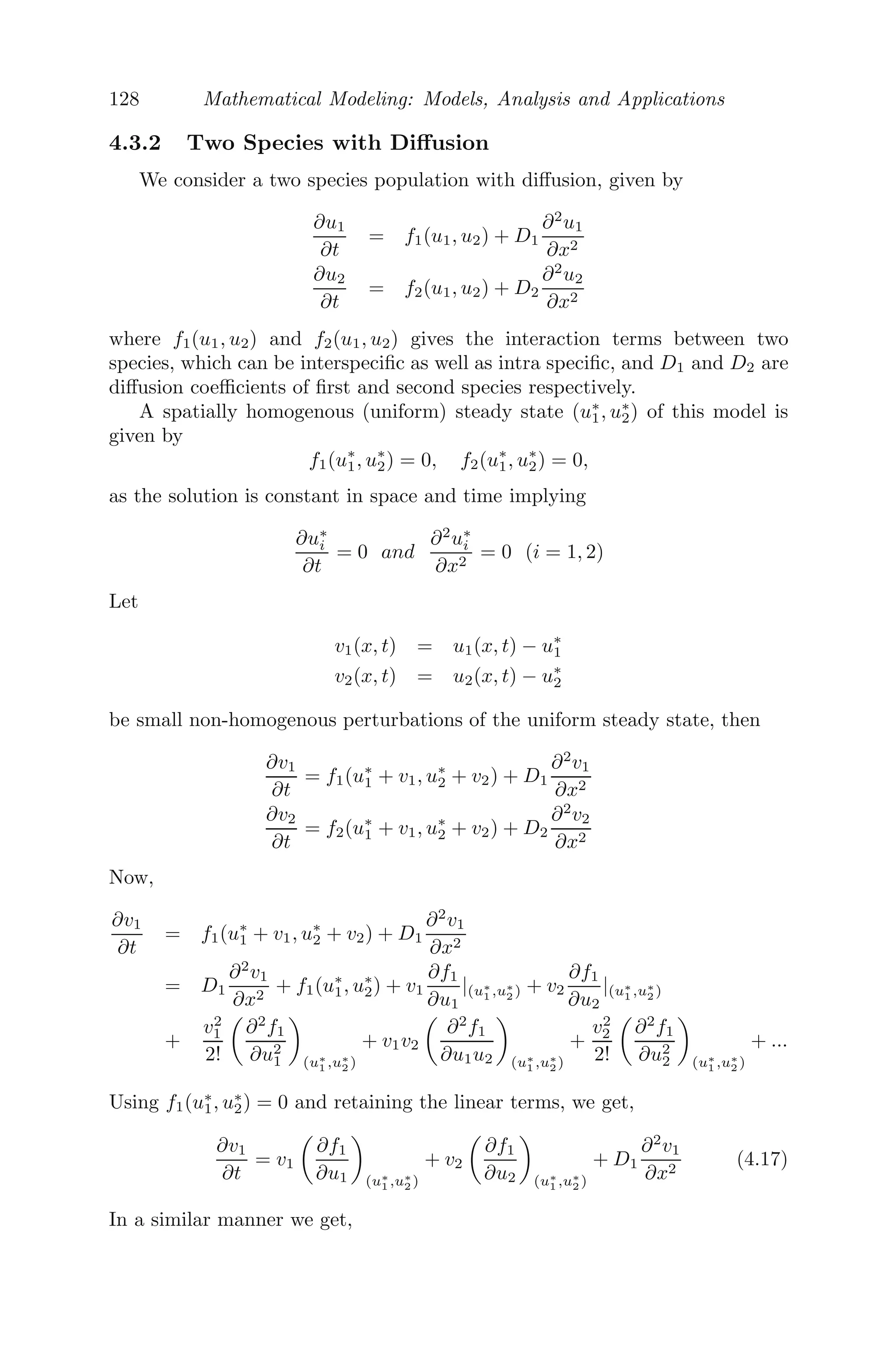
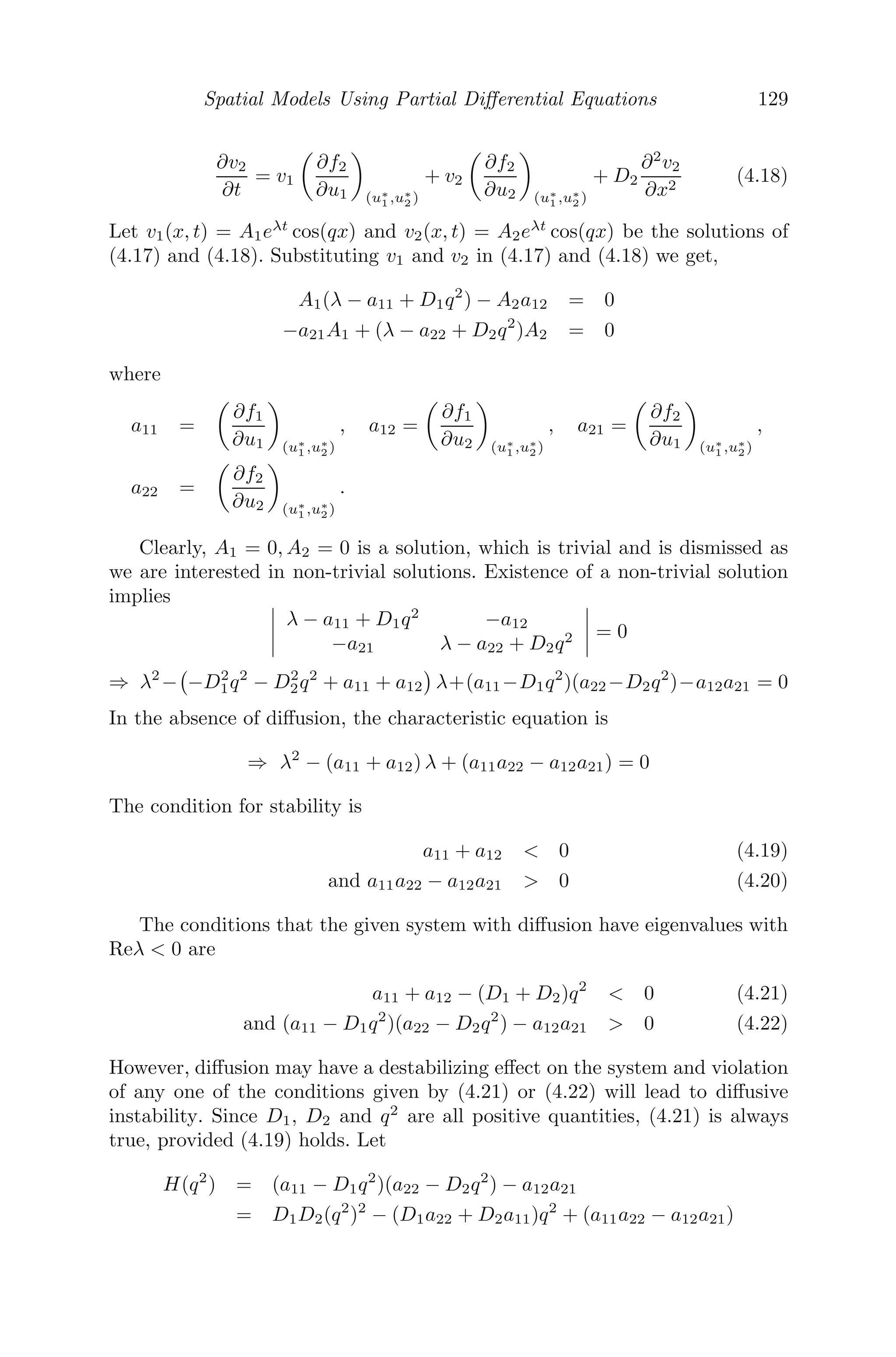
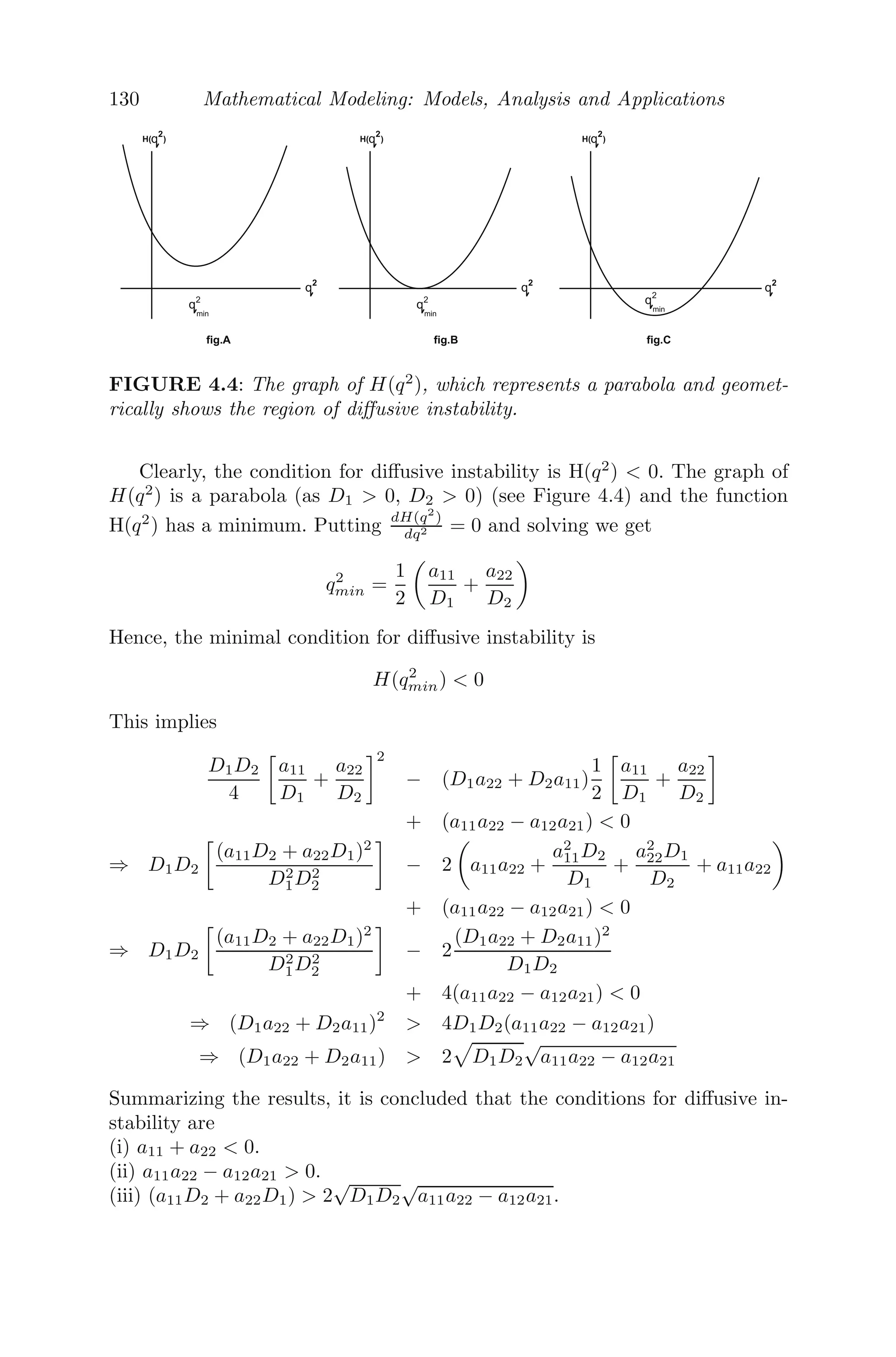
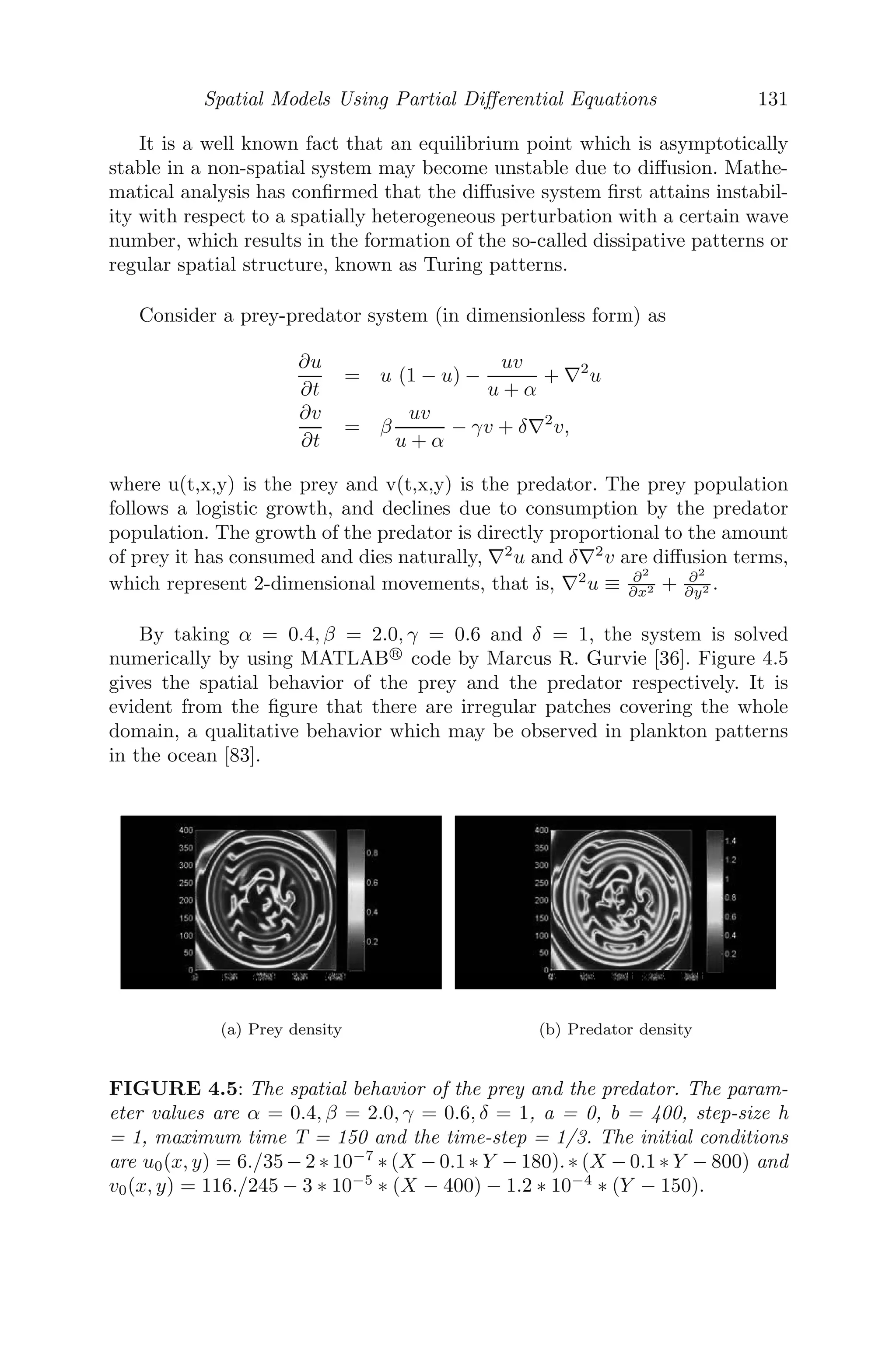
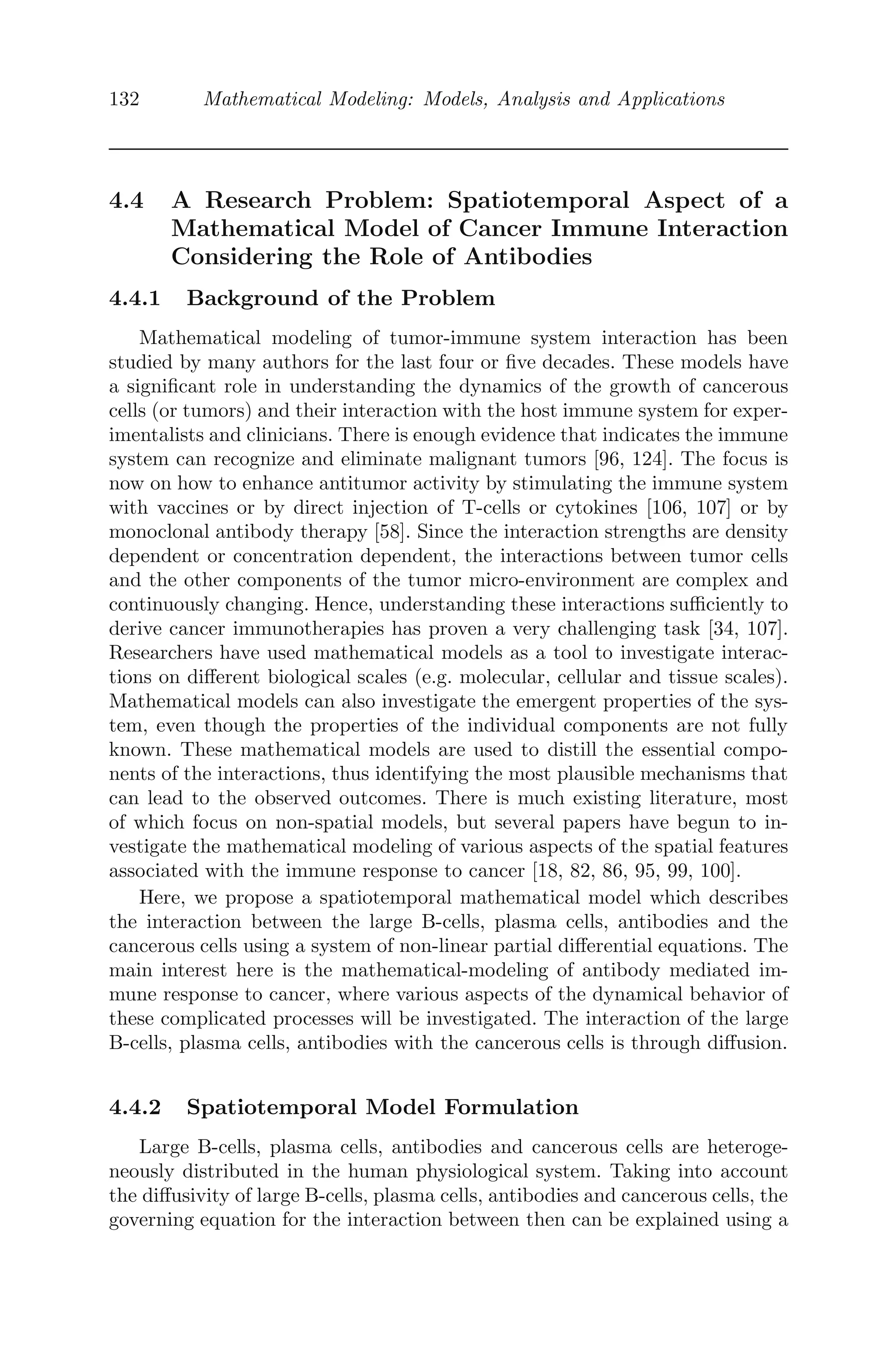
![Continuous Models Using Ordinary Differential Equations 109
44. In a forest, the fox population grows at the rate of 10% per year and
the wolf population at the rate of 25% per year. The species compete
for the same resources and the forest can support 10000 foxes or 6000
wolves (carrying capacities).
(i) By taking F(t) and W(t) to be the fox and wolf populations at any
time t, formulate a mathematical model.
(ii) Find the solution for W(t) assuming W(0) = W0.
(iii) Assuming that the competition among the foxes and the wolves de-
creases the growth rates by an amount proportional to the product of
the two populations, modify the model to show the interaction of the
foxes and the wolves, 0.6 and 0.4 being the rates of decrease for the foxes
and the wolves respectively.
(iv) Find the equilibrium point(s) of the extended model obtained in
(iii).
(v) Perform linear stability analysis about the non-zero equilibrium
point and comment on the stability of the system.
(vi) Modify the model by considering an additional term to model the
hunting of both foxes and wolves, e being the measure of amount of hunt-
ing. At time t=0 (when hunting of both the species started), F(0)=1500
and W(0)=1000 and at time t=50, F(50)=100. Find the value of e for
this to happen.
(vii) Obtain the graph for long-term behavior of the two populations if
the level of hunting continues as in the previous question.
45. A model for interaction of messenger RNA-M and protein E is given by
dM
dt = Ek
1+Ek − αM and dE
dt = M − βE
(i) For k=1, interpret the model.
(ii) For k=1 and αβ 1, find the steady state(s) of the model.
(iii) Check for stability about the obtained steady state(s) and hence
obtain the phase plane diagram of the system.
(iv) Find the steady state solution(s) for k=2. What happens where
(a) αβ 1
2 (b) αβ = 1
2 and (c) αβ 1
2 ?
46. In biological pattern formation (zebra stripes and butterfly wing pat-
terns), Lewis [74] proposed a simple model involving a biochemical
switch, where a gene G is activated by a biochemical signal subsystem
S. The model is given by
dg
dt
= k1s0 − k2g +
k3g2
k2
4 + g2
where g(t) is the gene product concentration, the concentration s0 of S
is fixed and k
i s (i= 1,2,3,4) are positive constants.
(i) Describe the model and put it in the dimensionless form
dx
dτ
= s − rx +
x2
1 + x2](https://image.slidesharecdn.com/mathematicalmodelingmodelsanalysisandapplicationspdfdrive-211127122602/75/Mathematical-modeling-models-analysis-and-applications-pdf-drive-156-2048.jpg)
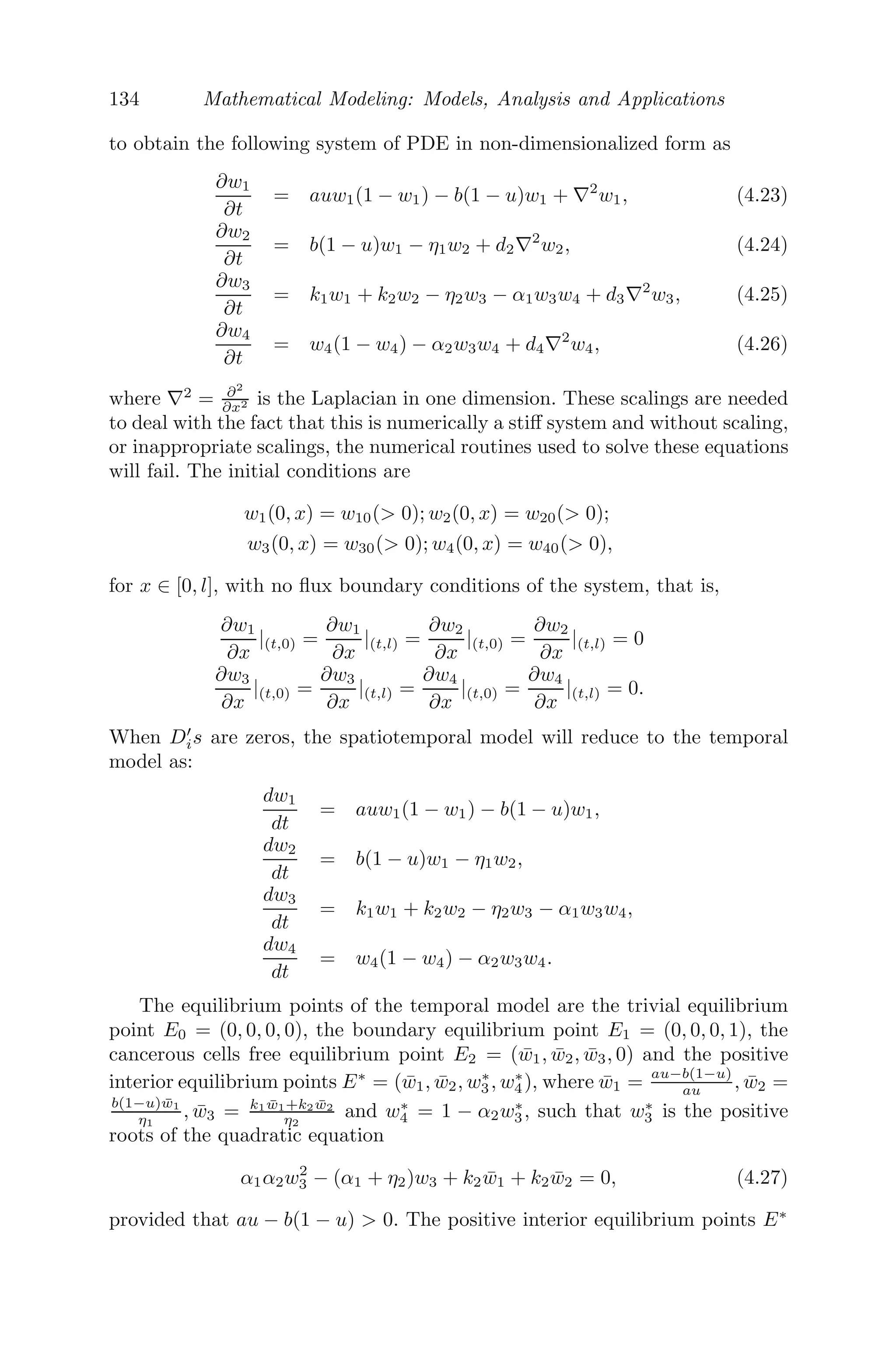
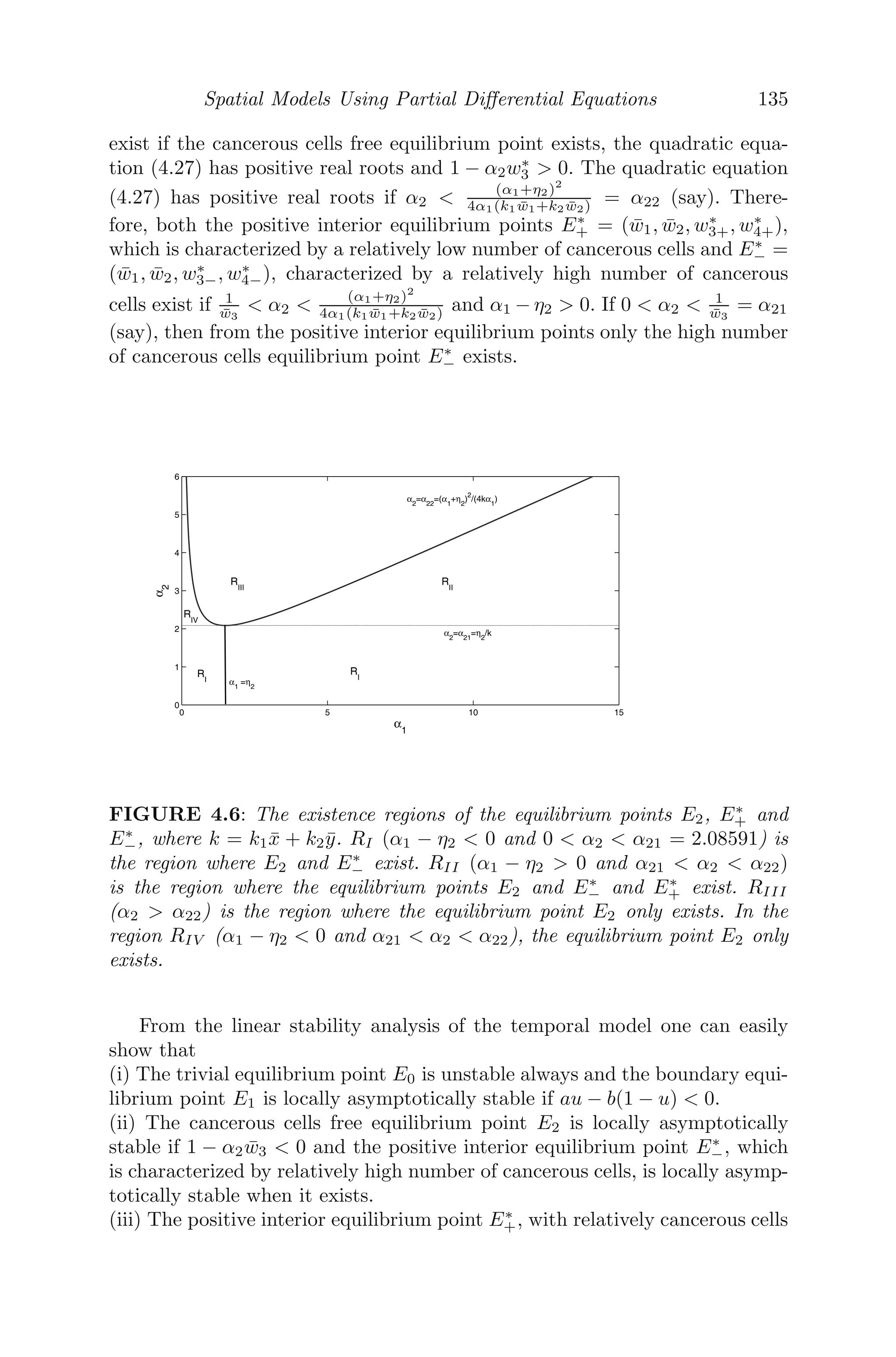
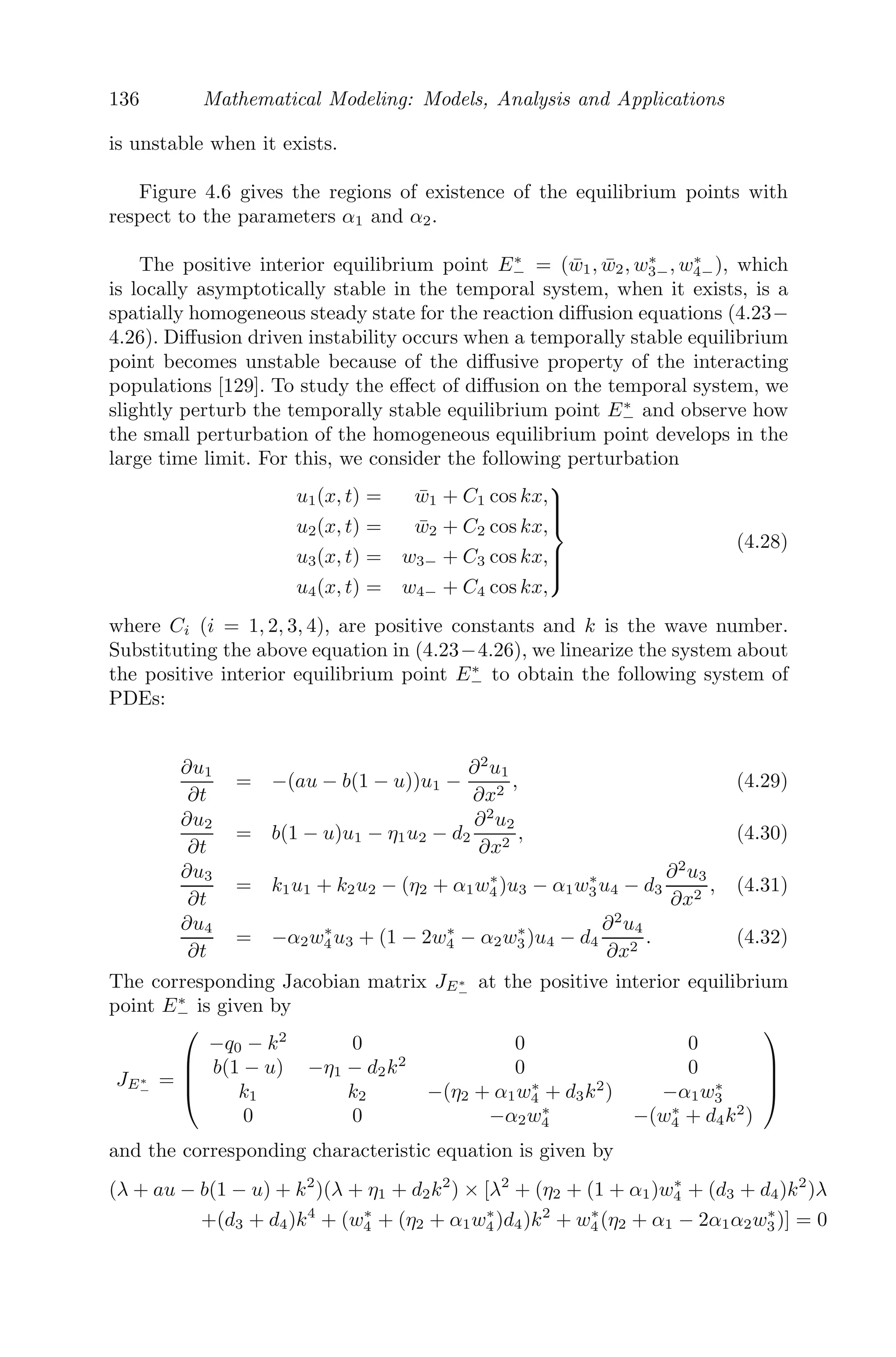
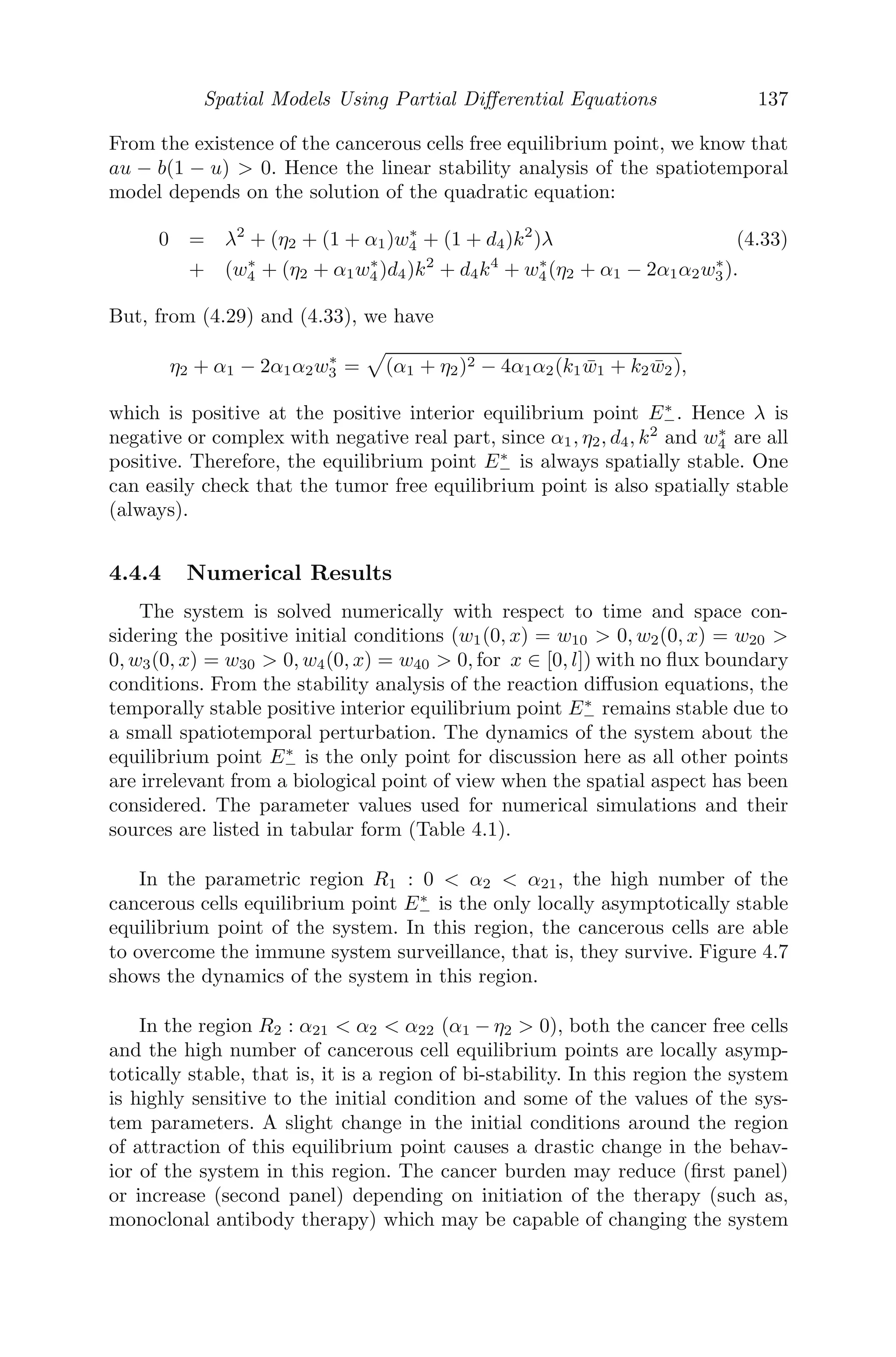
![114 Mathematical Modeling: Models, Analysis and Applications
FIGURE 4.1: A thin homogenous rod of length L, perfectly insulated along
its length.
insulated along its length so that heat can flow only through its ends (see
Figure 4.1).
Let u(x, t) be the temperature of this homogenous thin rod at a distance x
at time t. We consider an infinitesimal piece from the rod with length [x, x +
x]. If A is the cross-section of the rod and ρ is the density of the material
of the rod, then the infinitesimal volume is given by ΔV = AΔx and the
corresponding infinitesimal mass is Δm = ρAΔx. Then, the amount of heat
for the volume element is Q = σΔm u(x, t), where σ is the specific heat of
the material of the rod.
At time t + Δt, the amount of heat is
Q1 = σΔmu(x, t + Δt).
Change in heat = Q1 − Q = σΔm u(x, t + Δt) − σΔm u(x, t)
= σρA[u(x, t + Δt) − u(x, t)]Δx
Now, by the Fourier law of heat conduction, the heat flow is proportional to
the temperature gradient, that is, Q = −k ∂u
∂x = −kux(x, t) (in one dimen-
sion), where k is the thermal conductivity of the solid and the negative sign
denotes that the heat flux vector is in the direction of decreasing temperature.
Therefore, the change in heat must be equal to the heat flowing in at x, minus
the heat flowing out at x + Δx, during the time interval Δt, that is,
σρA[u(x, t + Δt) − u(x, t)]Δx = [−kux(x, t) − (−kux(x + Δt, t))]Δt
u(x, t + Δt) − u(x, t)
Δt
=
k
σρA
ux(x + Δx, t) − ux(x, t)
Δx
Taking Δx and Δt → 0, we get
∂u
∂t
= c2 ∂2
u
∂x2
,
which gives the required heat equation determining the heat flow through a
small thin rod. Here, c2
= k
σρA is called the constant thermal conductivity.
We use separation of variables to solve the above heat equation, which can
also be termed as a one dimensional diffusion equation.](https://image.slidesharecdn.com/mathematicalmodelingmodelsanalysisandapplicationspdfdrive-211127122602/75/Mathematical-modeling-models-analysis-and-applications-pdf-drive-161-2048.jpg)
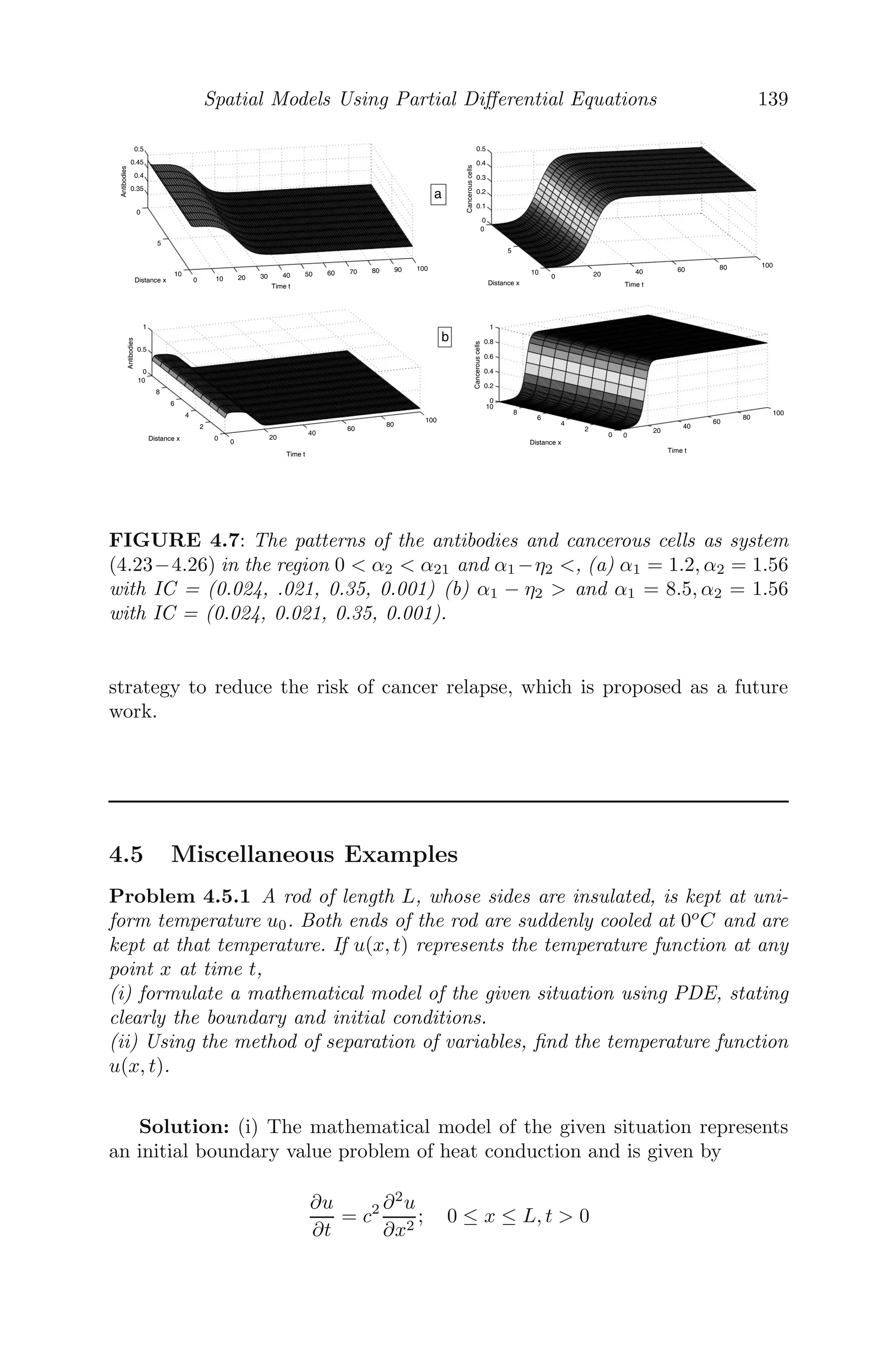
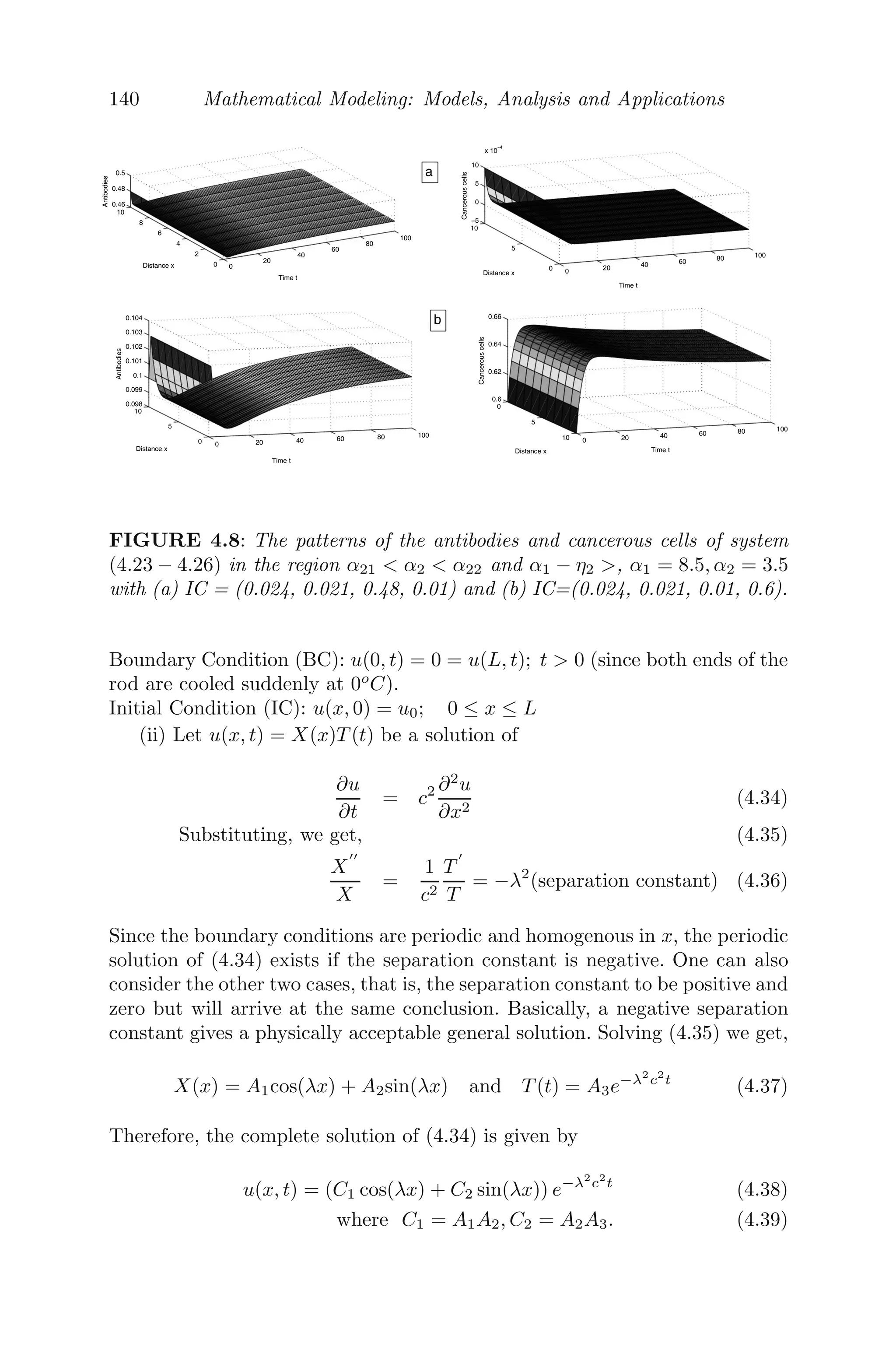
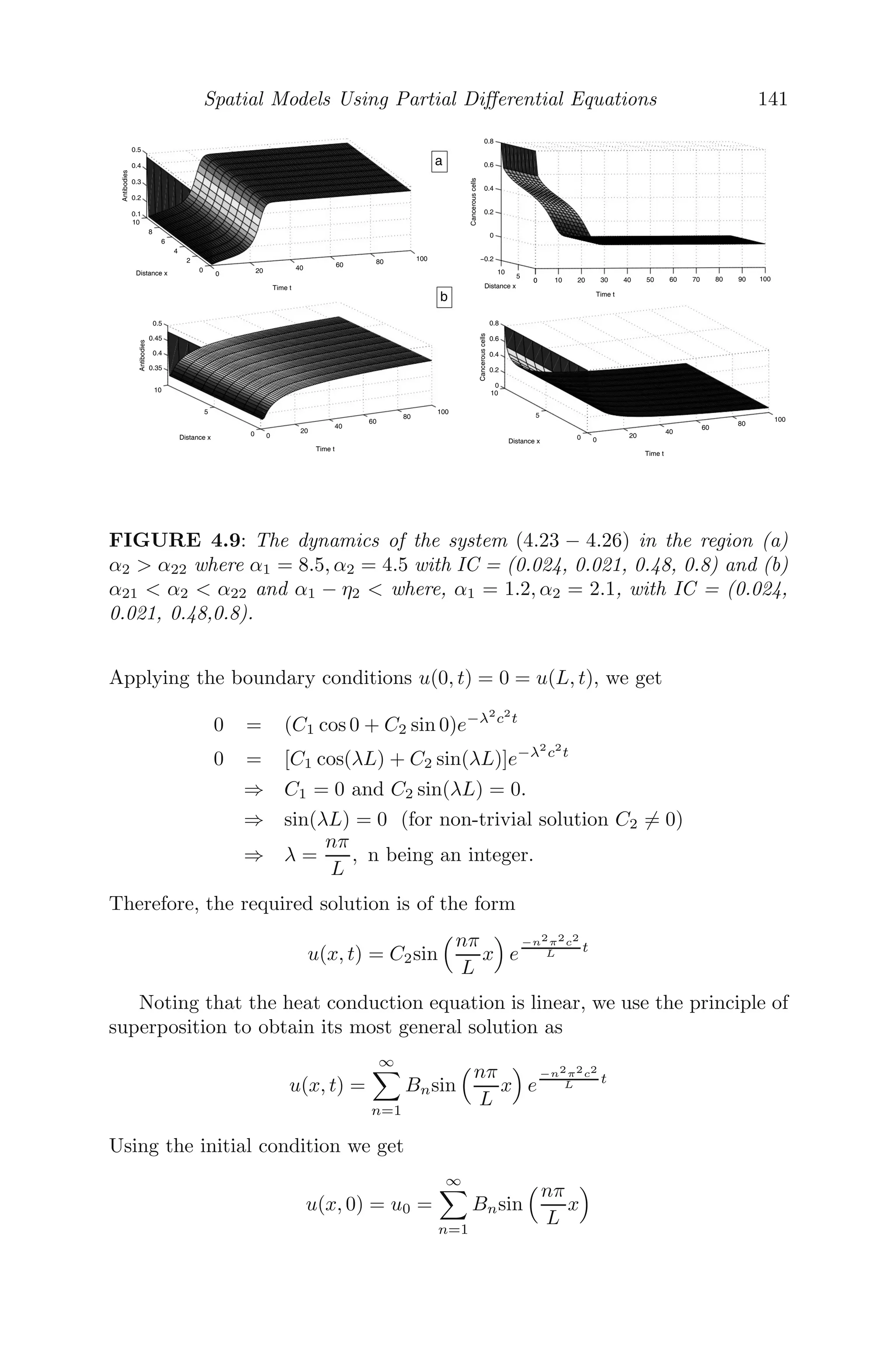

![Spatial Models Using Partial Differential Equations 119
4.2.5 Traffic Flow
This section will concentrate on the macroscopic modeling of the traffic
flow, where the focus will be on modeling the density of cars and their flow,
rather than modeling individual cars and their velocity. Let the number of
cars per unit length at position x and in time t be ρ(x, t) and the number of
cars passing the position x per unit time at time t be f(x, t), that is, f(x, t)
gives the rate of flow of the cars (traffic flux) and ρ(x, t) denotes the density
of cars (the state variable).
We now use the global conservation law on the statement that ”cars are
conserved” [3]. By the statement ”cars are conserved,” we mean that the
number of cars in an arbitrary region of space I = [x1, x2], called the cell, at
the end of an arbitrary interval of time T = [t1, t2], called the time-step, is
equal to the number of cars in the cell at the beginning of the time-step (that
is, t), plus the number of cars entering the cell minus the number of cars going
out of the cell, that is, the change of flux in the cell [x1, x2].
Now, the number of cars entering the cell [x1, x2] through the point x1
during the time-step [t1, t2]
=
t2
t1
f(x1, t)dt
The number of cars leaving the cell [x1, x2] through the point x2 during the
time-step [t1, t2]
=
t2
t1
f(x2, t)dt
The number of cars in the cell [x1, x2] at time t1,
=
x2
x1
ρ(x, t1)dx
and the number of cars in the cell [x1, x2] at time t2
=
x2
x1
ρ(x, t2)dx
Since ”cars are conserved” we have
x2
x1
ρ(x, t2)dx =
x2
x1
ρ(x, t1)dx +
t2
t1
f(x1, t)dt −
t2
t1
f(x2, t)dt
⇒
x2
x1
[ρ(x, t2) − ρ(x, t1)]dx +
t2
t1
[f(x2, t) − f(x1, t)]dt = 0
Using the fundamental theorem of Calculus (by assuming ρ and f to be a](https://image.slidesharecdn.com/mathematicalmodelingmodelsanalysisandapplicationspdfdrive-211127122602/75/Mathematical-modeling-models-analysis-and-applications-pdf-drive-166-2048.jpg)
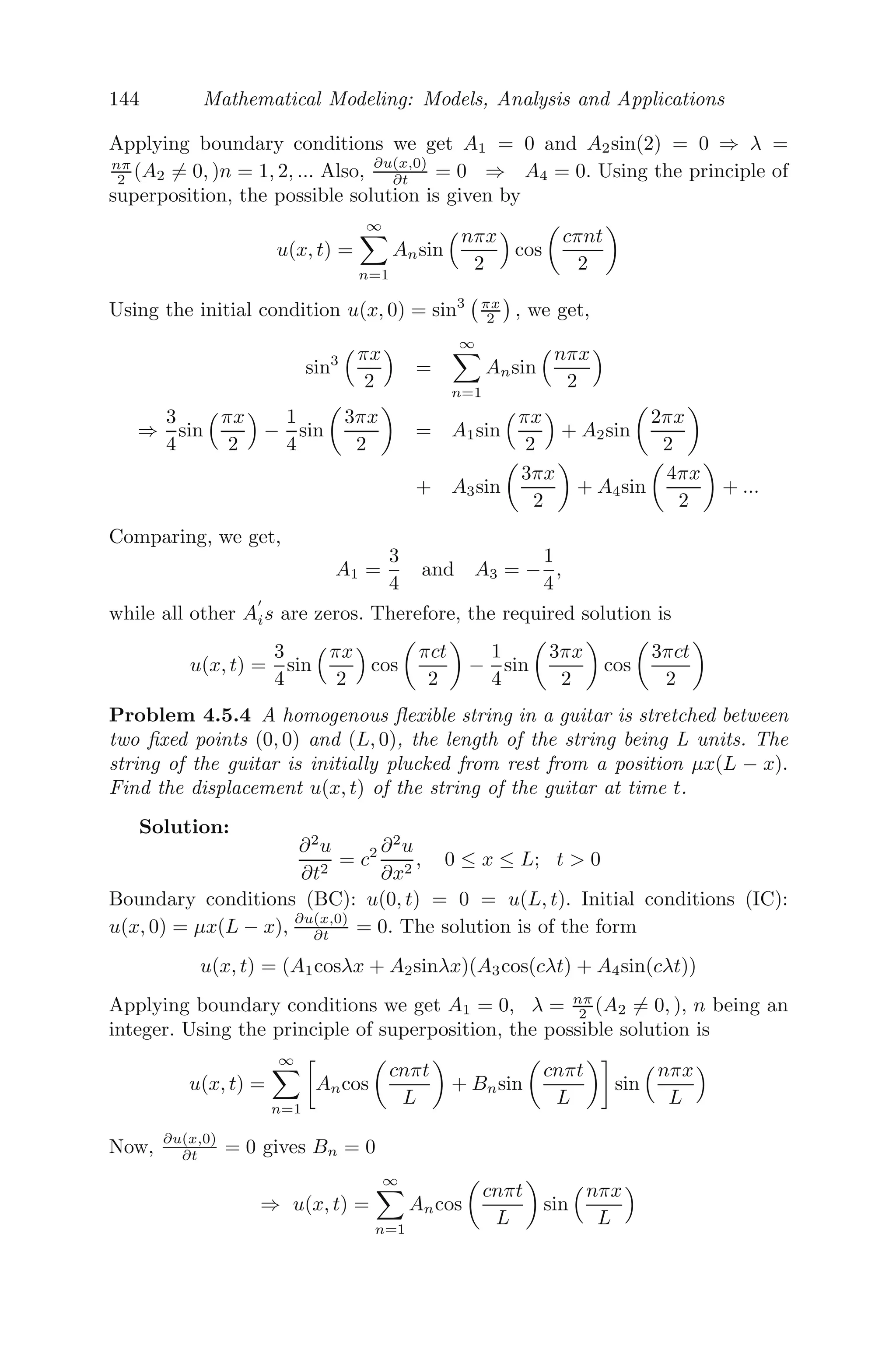
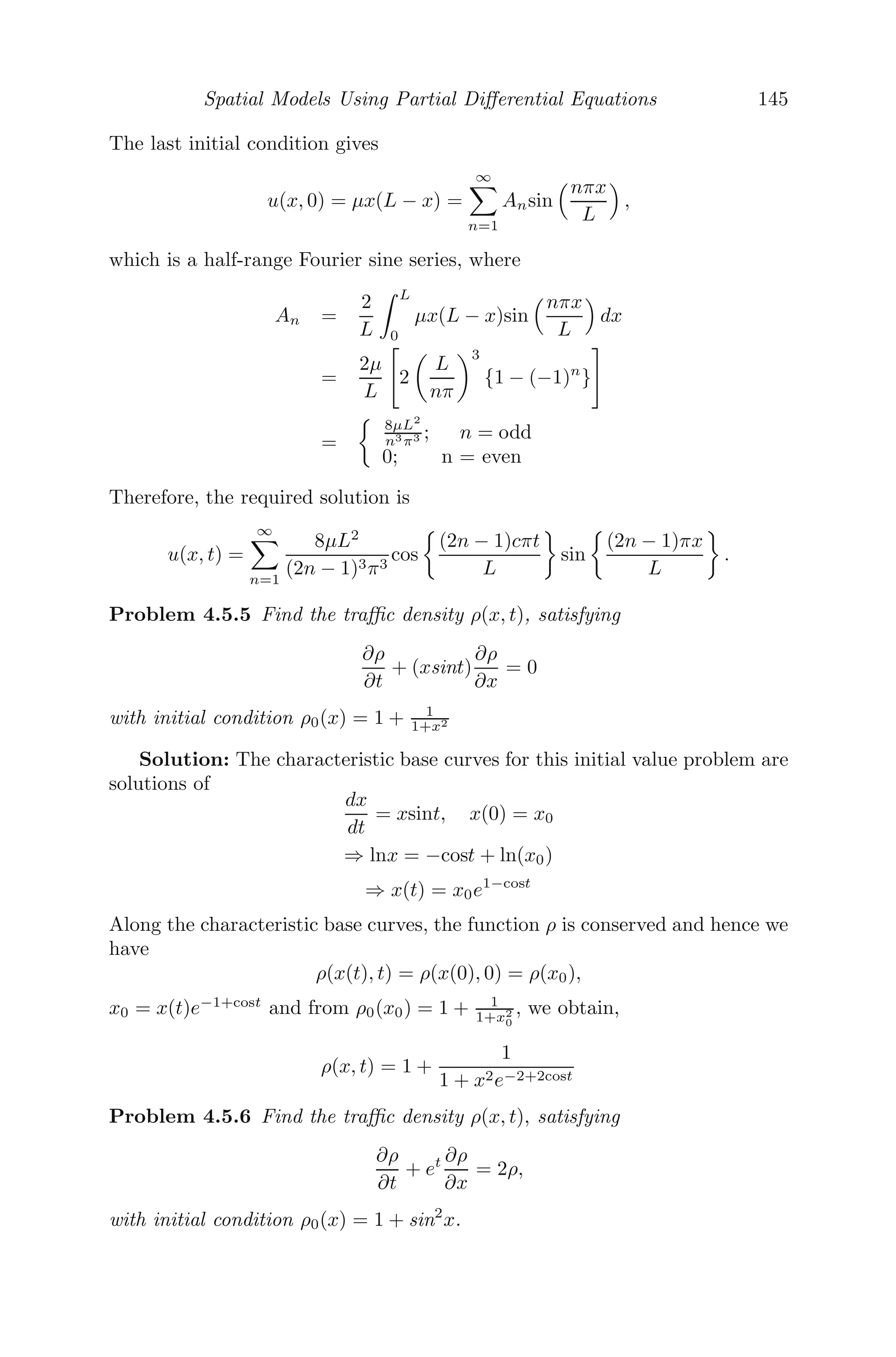
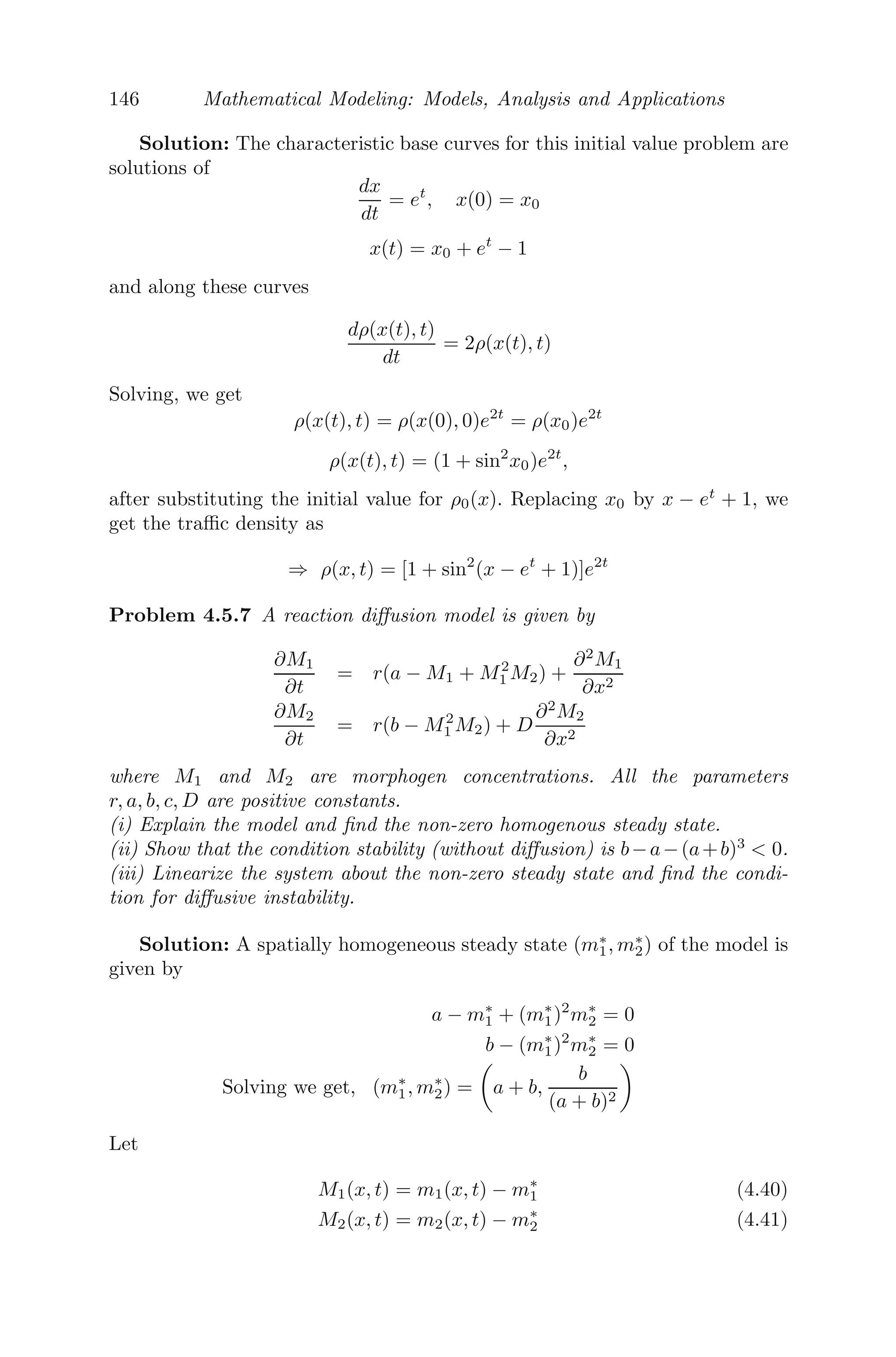
![Spatial Models Using Partial Differential Equations 123
Corollary 2: We next consider an equation of the form [22]
∂ρ
∂t
+ v(ρ)
∂ρ
∂x
= 0, where v(ρ) =
√
ρ
and initial condition ρ(x, 0) = x, x 0
The characteristic base curves for this problem
dx
dt
= v(ρ(x(t), t)) =
ρ(x(t), t)
Though the problem looks complicated, note that ρ is constant on the charac-
teristic curve, implying v(ρ) =
ρ(x(t), t) is also constant and is independent
of t. Therefore,
x =
ρ(x(t), t) t + x0, since x(0) = x0
The function ρ is conserved along the characteristic base curves, which implies
ρ(x(t), t) = ρ(x(0), 0) = ρ(x0) = x0
⇒ x =
√
x0t + x0
(
√
x0)2
+ t
√
x0 − x = 0
x0 =
1
2
(t2
− t
t2 + 4x) + x
Therefore, the traffic density is obtained from
ρ(x0) = x0(x, t) as
ρ(x, t) =
1
2
(t2
− t
t2 + 4x) + x
Corollary 3: This method can be extended to non-homogenous initial
condition problems of the form
∂ρ
∂t
+ f(x, t)
∂ρ
∂x
= h(ρ, x, t)
The characteristic base curves for this problem are solutions of (as mentioned
earlier)
dx
dt
= f(x, t)
and
dρ
dt
= h(ρ, x, t)
is an arbitrary differential equation for ρ.](https://image.slidesharecdn.com/mathematicalmodelingmodelsanalysisandapplicationspdfdrive-211127122602/75/Mathematical-modeling-models-analysis-and-applications-pdf-drive-170-2048.jpg)
![124 Mathematical Modeling: Models, Analysis and Applications
4.2.6 Theory of Car-Following
There are various ways a modeler can model the response of a driver to
the surrounding traffic. One is the response of the driver and hence his car,
when another car is immediately in front of it, assuming that the car follows
a single lane with no passing (see Figure 4.3). A reasonable assumption would
be that the nth
car response to the (n + 1)th
car (which is immediately in
front of it) is proportional to their velocity difference (that is, velocity of the
(n + 1)th
car minus the velocity of the nth
car). Thus, if an is the acceleration
of the nth
car and un is its velocity, then [22],
FIGURE 4.3: Car follows single lane without passing, with another car im-
mediately in front of it.
an = λ(un+1 − un)
⇒ an = −λ(un − un+1)
⇒
d2
xn
dt2
= −λ
dxn
dt
−
dxn+1
dt
(4.12)
where xn is the position of the nth
car. Let the length of all the cars be L,
moving with the same speed u, at a distance D apart (equi-spaced).
Integrating (4.12) we get,
u =
dxn
dt
= −λ (xn − xn+1) + c,
c being the constant of integration. Therefore,
u = λ (xn+1 − xn) + c
= λ(L + D) + c
=
λ
ρ
+ c
where ρ = 1
L+D is the uniform car density.
Let the velocity u = 0, where ρ = ρmax, therefore c = − λ
ρmax
and
u(ρ) =
λ
ρ
−
λ
ρmax
,](https://image.slidesharecdn.com/mathematicalmodelingmodelsanalysisandapplicationspdfdrive-211127122602/75/Mathematical-modeling-models-analysis-and-applications-pdf-drive-171-2048.jpg)
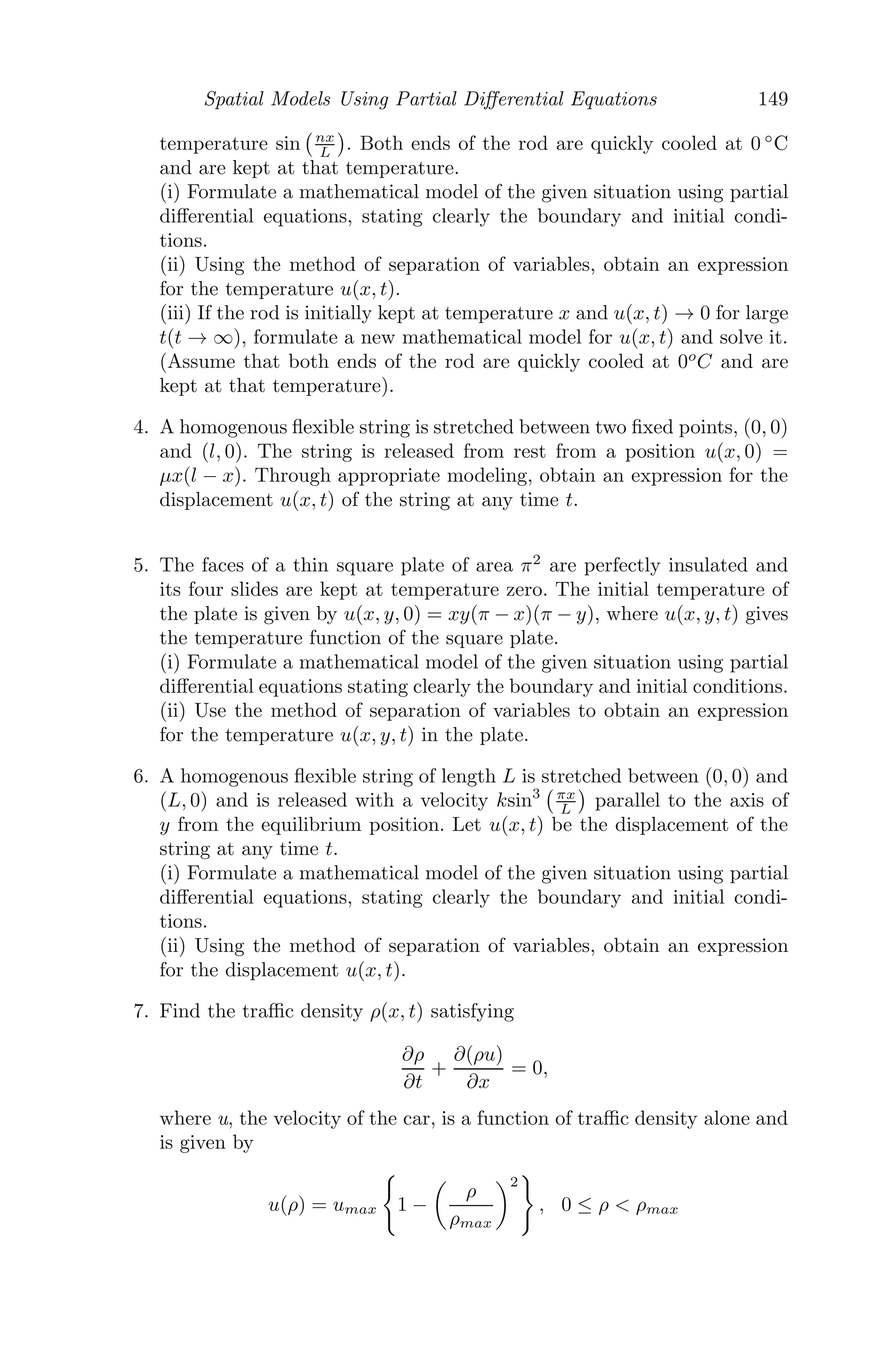
![126 Mathematical Modeling: Models, Analysis and Applications
4.2.7 Crimes Model
Crimes occur in both urban and rural environments. Some areas are rea-
sonably safe while others are dangerous, demonstrating that crime is not uni-
formly distributed. Criminals have their favorite zones and victim types, who
are repeatedly targeted in a short time period [60, 61, 62, 64]. Some zones
are commonly known as crime hotspots [121, 130]. Crime patterns depend on
many factors. For example, the preference of a burglar to visit a previously
burglarized house or an adjacent one will depend on the information about
the schedules of the occupants or the types of valuables that may be stolen.
The preference of the burglar may also depend on the choice of some favor-
able neighborhood where past successful burglaries have created an impression
that the occupants are crime tolerant, resulting in the growth of more illegal
activities. This is known as the broken window effect [121, 133].
Here we discuss a simple crime model, namely residential burglary, which is
common in both urban and rural areas. The proposed model is a modification
of that given in [121]. Let A(x, y, t) denote the attractiveness to burglars and
C(x, y, t) be the criminal density for a location. The equations that model a
simple residential burglary are
∂A
∂t
= α CA − β A + D1∇2
A
∂C
∂t
= γ − δ CA + D2∇2
C, where, ∇2
≡
∂2
∂x2
+
∂2
∂y2
.
In the first equation, the term αCA shows the positive effect of successful
burglaries on attractiveness of location. A successful burglary at one location
encourages the burglars to repeat the crime at the same location or adjacent
to it. Thus, the density of burglars is increased due to attractiveness of a
location. The decay term (−βA) implies that with time, the attractiveness
of a particular location diminishes. Successful burglaries in the past may not
encourage the burglars to commit the crime more recently, resulting in the de-
cline of attractiveness of a location. The diffusion term D1∇2
A measures the
spread of attractiveness to the neighboring areas due to successful burglaries
in that location, D1( 0) being the diffusion coefficient.
In the second equation, γ is the constant source of burglars per area at a
given location. While some burglars leave the location after a successful bur-
glary, new thieves may enter the location due to its attractiveness and hence
a constant input of criminals is assumed. The term (−δCA) implicates that
due to the attractiveness of a location, a burglar will commit the burglary in
that location rather than moving to another one. Hence, there will be a reduc-
tion in the criminal density. The term D2∇2
C gives the random movement
of the criminals. Due to some unavoidable circumstances, a burglar may also
decide to move to a neighboring location, without committing a burglary in
the present location.](https://image.slidesharecdn.com/mathematicalmodelingmodelsanalysisandapplicationspdfdrive-211127122602/75/Mathematical-modeling-models-analysis-and-applications-pdf-drive-173-2048.jpg)
![Spatial Models Using Partial Differential Equations 127
4.3 Linear Stability Analysis
4.3.1 One Species with Diffusion
We consider a one dimensional diffusion equation of the form
∂u(x, t)
∂t
= D
∂2
u(x, t)
∂x2
+ f(u) (4.14)
A homogenous steady state solution of this model is given by f(u0) = 0, as
the solution is constant in time and space, implying
∂u0
∂t
= 0 and
∂2
u0
∂x2
= 0 (4.15)
Let v(x, t) = u(x, t) − u0 be a small non-homogenous perturbation of the
homogenous steady state, then
∂v(x, t)
∂t
= D
∂2
v(x, t)
∂x2
+ f(u0 + v)
= D
∂2
v(x, t)
∂x2
+ f(u0) + vf
(u0) +
v2
2!
f
(u0) + ...
Using f(u0) = 0 and retaining linear terms, we get the linearized version of
(4.14) as
∂v(x, t)
∂t
= D
∂2
v(x, t)
∂x2
+ f
(u0)v(x, t) (4.16)
Let v(x, t) = Aeλt
cos(qx) be a solution of (4.16), then
Aeλt
cos(qx)[λ − f
(u0) + Dq2
] = 0
If A = 0, then the solution is trivial. For a non-trivial solution, we must have
λ = f
(u0) − Dq2
,
which gives the eigenvalue of the system, which is stable if
f
(u0) − Dq2
0
Note: For an ODE, u̇ = f(u), the system is stable if f
(u0) 0 and
unstable if f
(u0) 0. Thus, the diffusion will maintain stability in a stable
one-species system but it can stabilize an unstable one.](https://image.slidesharecdn.com/mathematicalmodelingmodelsanalysisandapplicationspdfdrive-211127122602/75/Mathematical-modeling-models-analysis-and-applications-pdf-drive-174-2048.jpg)
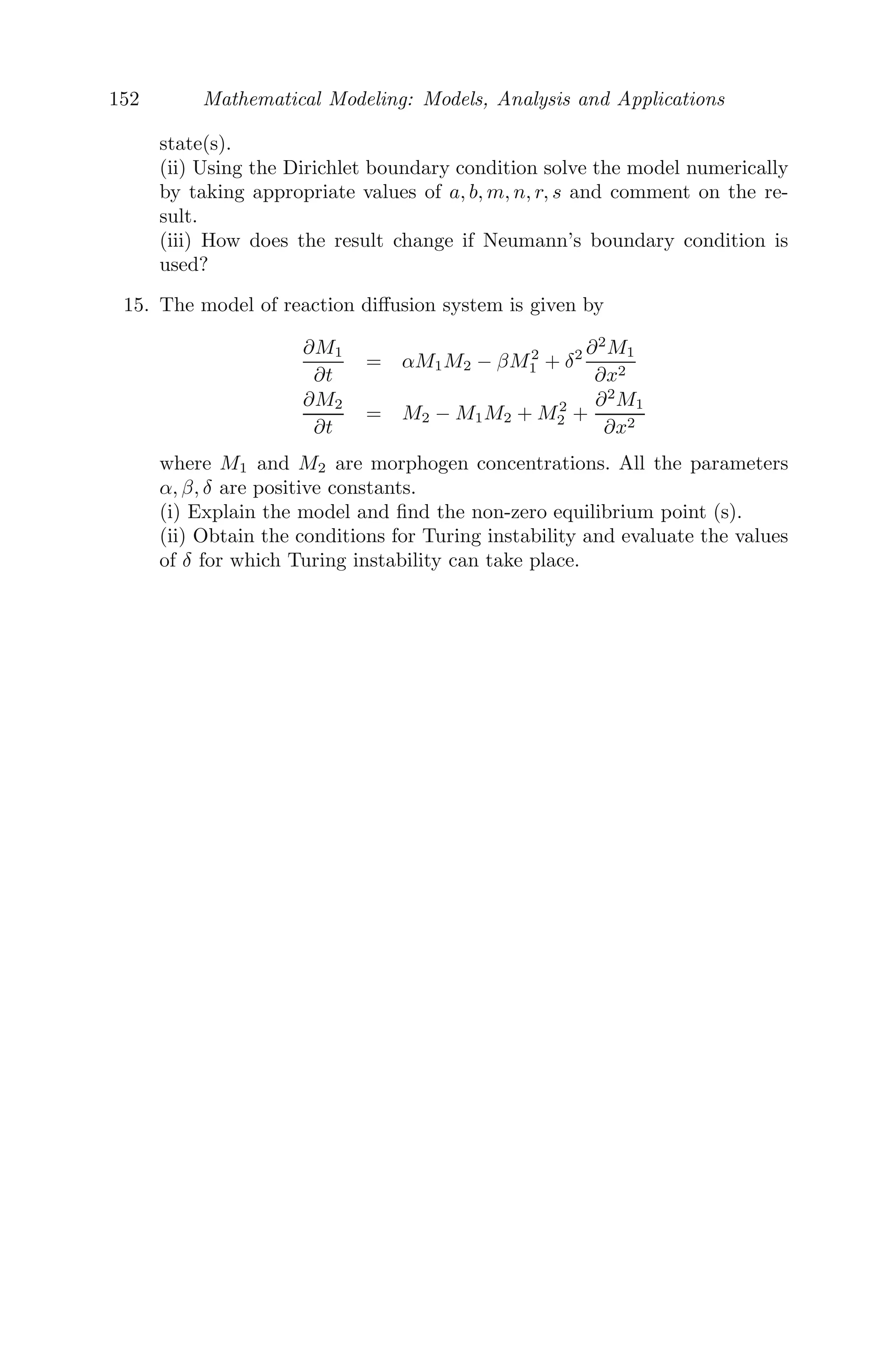
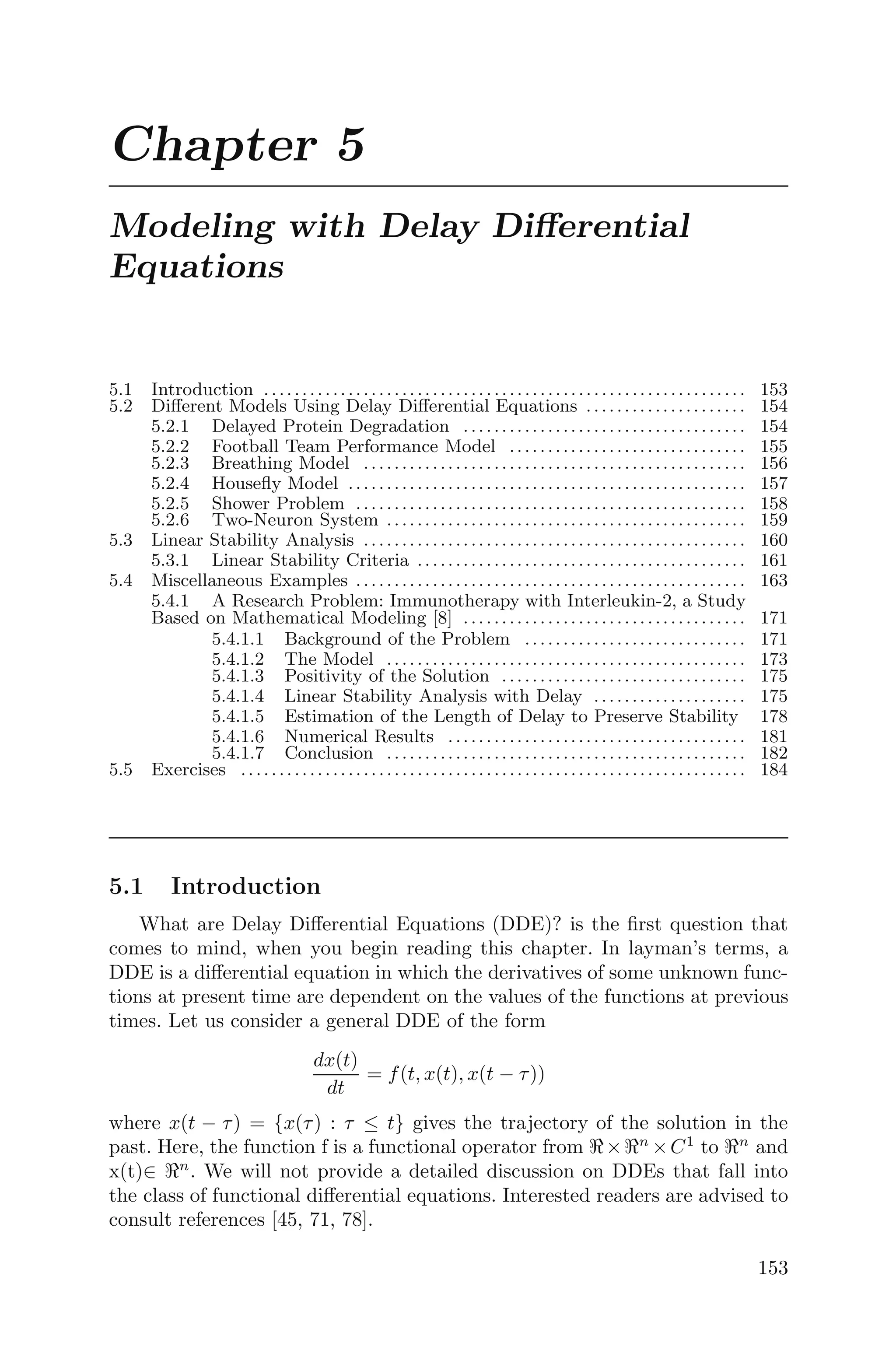

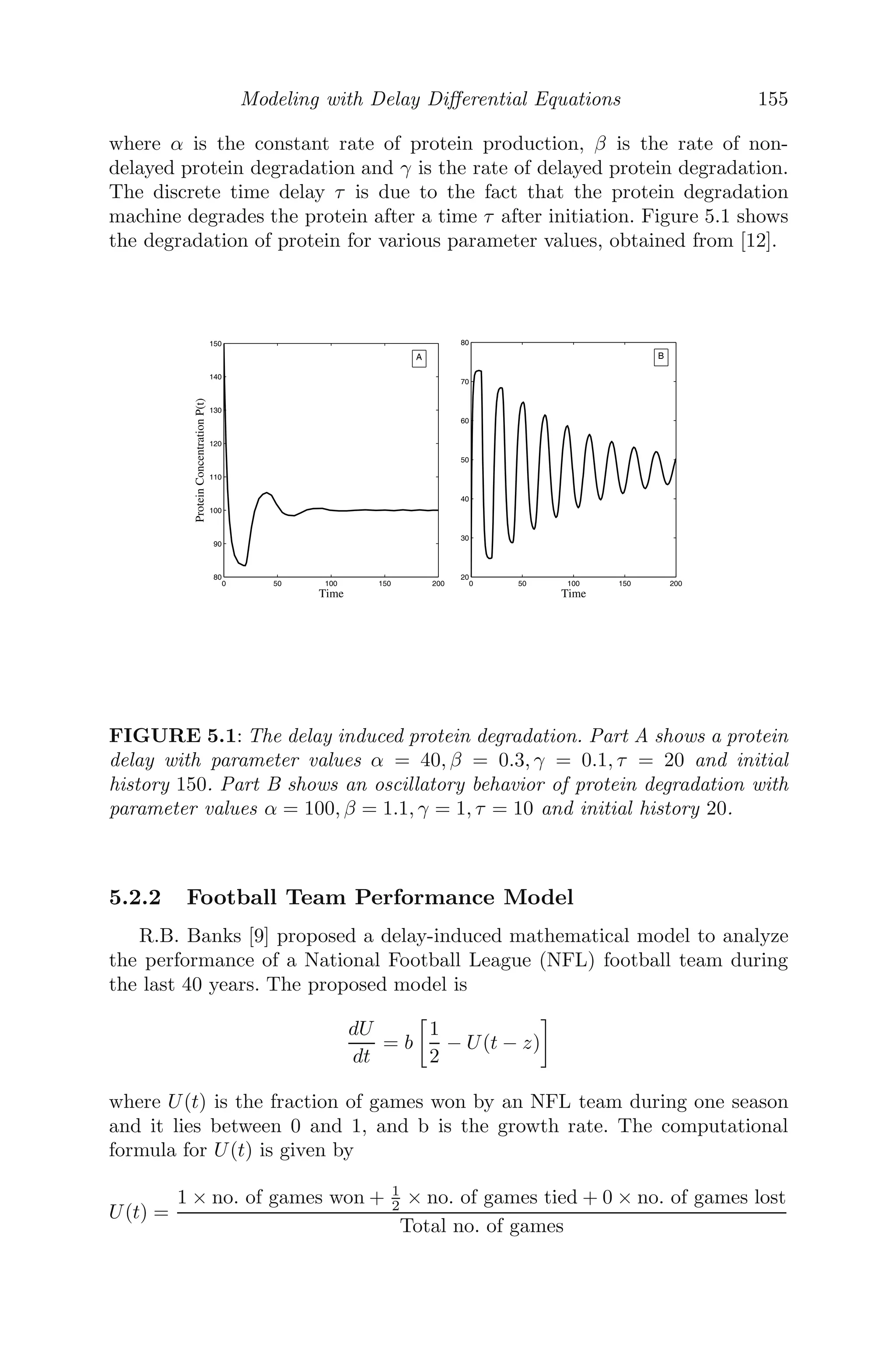

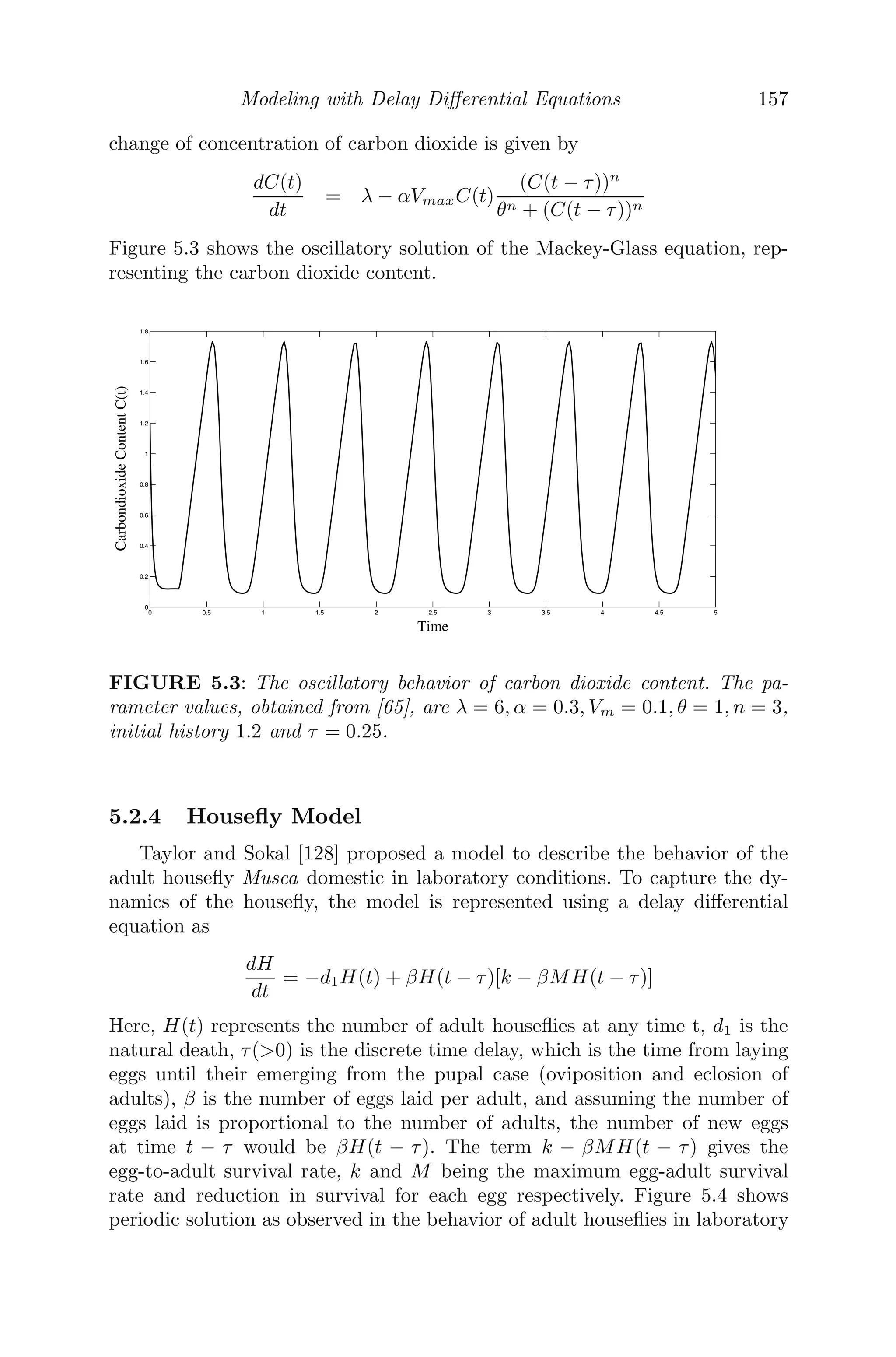
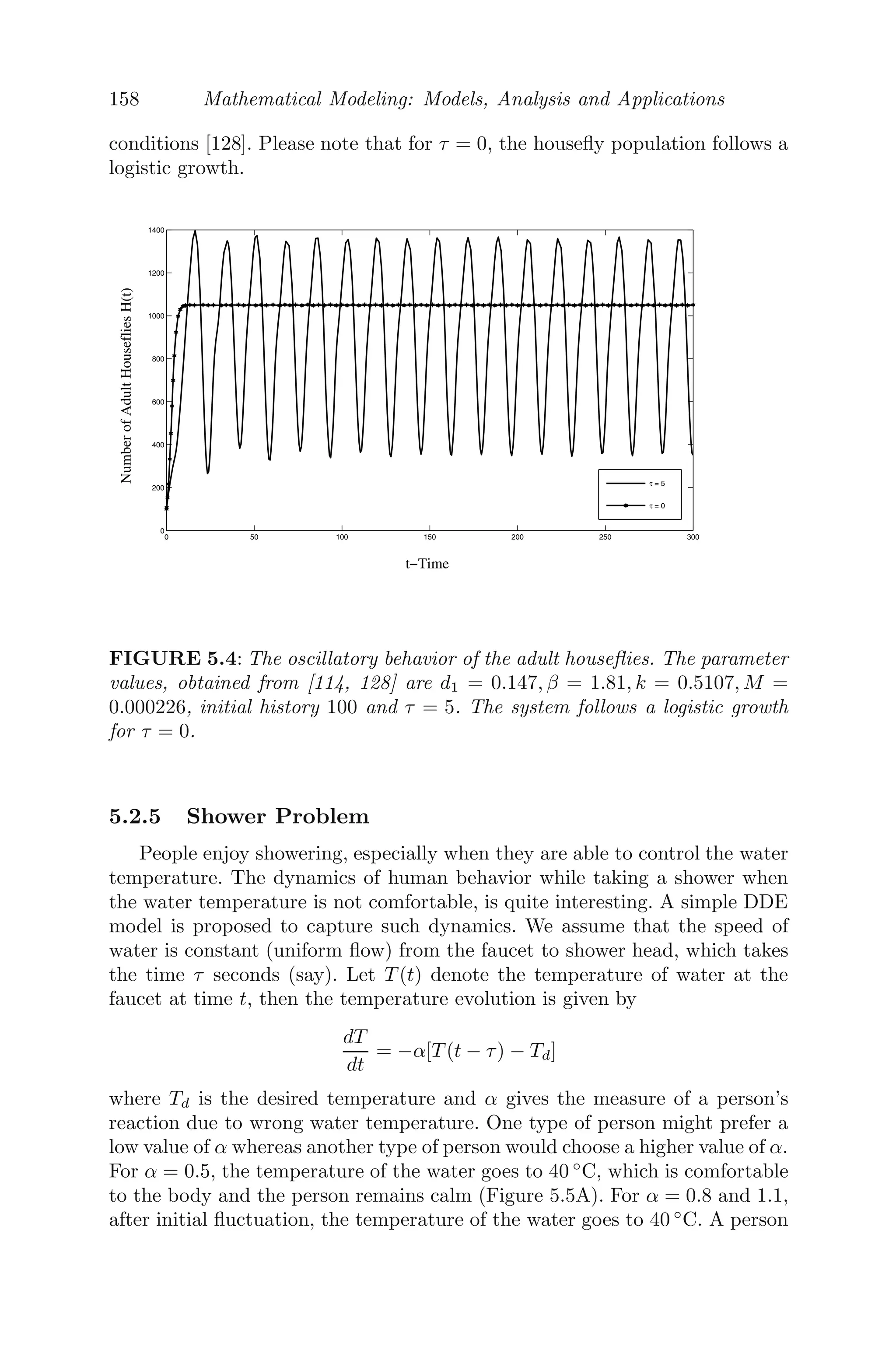

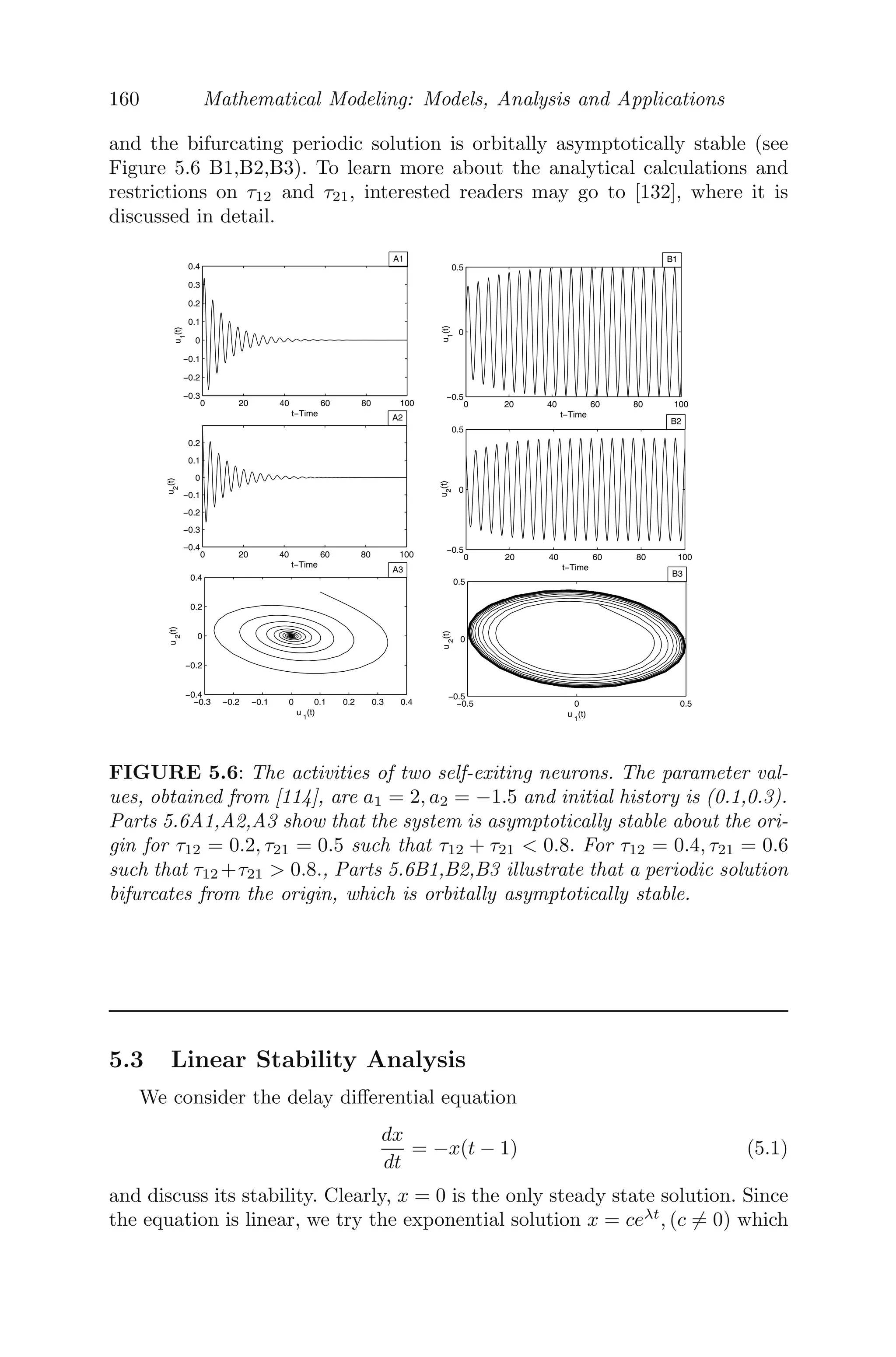
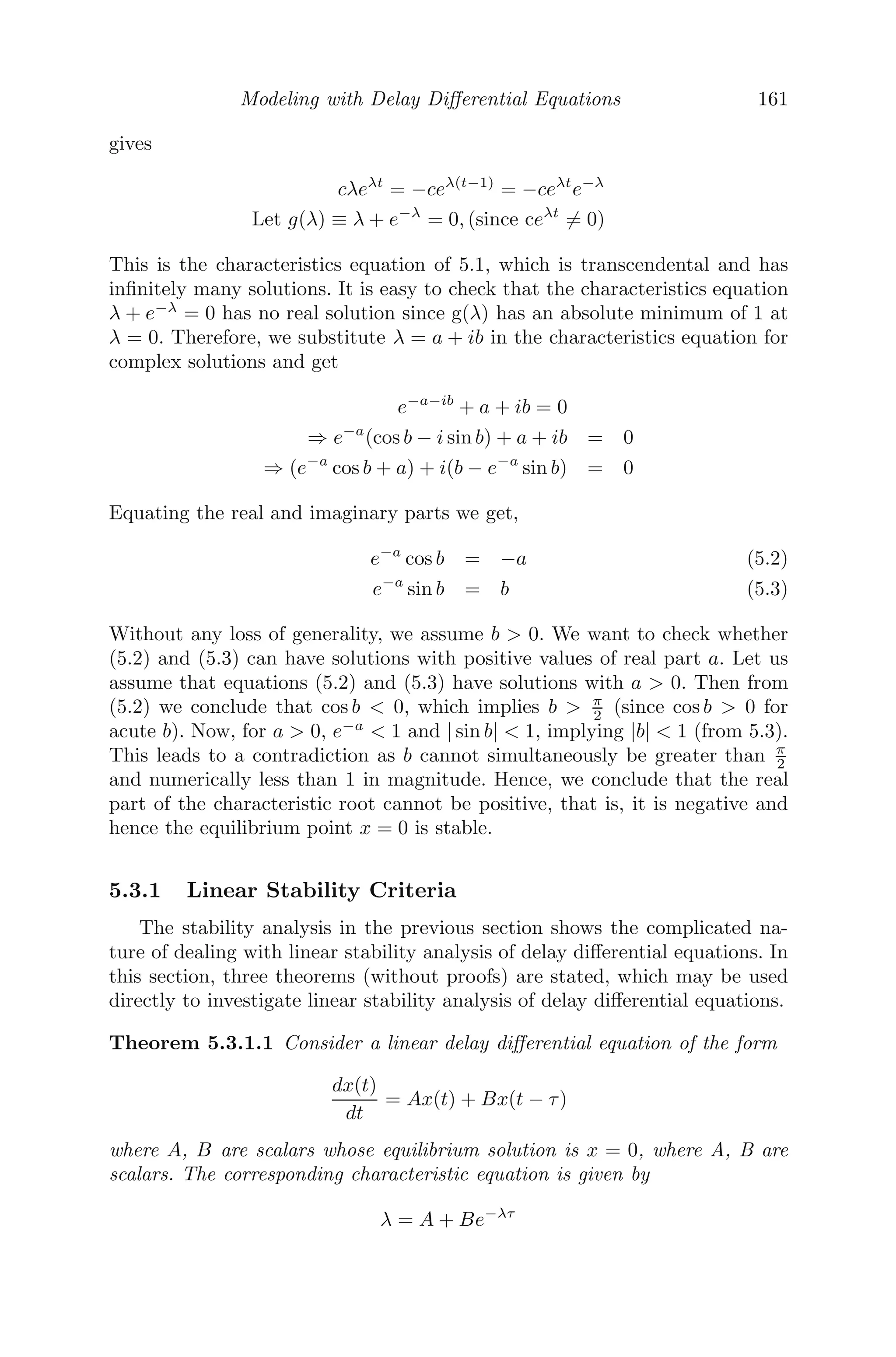

![Spatial Models Using Partial Differential Equations 131
It is a well known fact that an equilibrium point which is asymptotically
stable in a non-spatial system may become unstable due to diffusion. Mathe-
matical analysis has confirmed that the diffusive system first attains instabil-
ity with respect to a spatially heterogeneous perturbation with a certain wave
number, which results in the formation of the so-called dissipative patterns or
regular spatial structure, known as Turing patterns.
Consider a prey-predator system (in dimensionless form) as
∂u
∂t
= u (1 − u) −
uv
u + α
+ ∇2
u
∂v
∂t
= β
uv
u + α
− γv + δ∇2
v,
where u(t,x,y) is the prey and v(t,x,y) is the predator. The prey population
follows a logistic growth, and declines due to consumption by the predator
population. The growth of the predator is directly proportional to the amount
of prey it has consumed and dies naturally, ∇2
u and δ∇2
v are diffusion terms,
which represent 2-dimensional movements, that is, ∇2
u ≡ ∂2
∂x2 + ∂2
∂y2 .
By taking α = 0.4, β = 2.0, γ = 0.6 and δ = 1, the system is solved
numerically by using MATLAB
code by Marcus R. Gurvie [36]. Figure 4.5
gives the spatial behavior of the prey and the predator respectively. It is
evident from the figure that there are irregular patches covering the whole
domain, a qualitative behavior which may be observed in plankton patterns
in the ocean [83].
(a) Prey density (b) Predator density
FIGURE 4.5: The spatial behavior of the prey and the predator. The param-
eter values are α = 0.4, β = 2.0, γ = 0.6, δ = 1, a = 0, b = 400, step-size h
= 1, maximum time T = 150 and the time-step = 1/3. The initial conditions
are u0(x, y) = 6./35 − 2 ∗ 10−7
∗ (X − 0.1 ∗ Y − 180).∗ (X − 0.1 ∗ Y − 800) and
v0(x, y) = 116./245 − 3 ∗ 10−5
∗ (X − 400) − 1.2 ∗ 10−4
∗ (Y − 150).](https://image.slidesharecdn.com/mathematicalmodelingmodelsanalysisandapplicationspdfdrive-211127122602/75/Mathematical-modeling-models-analysis-and-applications-pdf-drive-186-2048.jpg)
![132 Mathematical Modeling: Models, Analysis and Applications
4.4 A Research Problem: Spatiotemporal Aspect of a
Mathematical Model of Cancer Immune Interaction
Considering the Role of Antibodies
4.4.1 Background of the Problem
Mathematical modeling of tumor-immune system interaction has been
studied by many authors for the last four or five decades. These models have
a significant role in understanding the dynamics of the growth of cancerous
cells (or tumors) and their interaction with the host immune system for exper-
imentalists and clinicians. There is enough evidence that indicates the immune
system can recognize and eliminate malignant tumors [96, 124]. The focus is
now on how to enhance antitumor activity by stimulating the immune system
with vaccines or by direct injection of T-cells or cytokines [106, 107] or by
monoclonal antibody therapy [58]. Since the interaction strengths are density
dependent or concentration dependent, the interactions between tumor cells
and the other components of the tumor micro-environment are complex and
continuously changing. Hence, understanding these interactions sufficiently to
derive cancer immunotherapies has proven a very challenging task [34, 107].
Researchers have used mathematical models as a tool to investigate interac-
tions on different biological scales (e.g. molecular, cellular and tissue scales).
Mathematical models can also investigate the emergent properties of the sys-
tem, even though the properties of the individual components are not fully
known. These mathematical models are used to distill the essential compo-
nents of the interactions, thus identifying the most plausible mechanisms that
can lead to the observed outcomes. There is much existing literature, most
of which focus on non-spatial models, but several papers have begun to in-
vestigate the mathematical modeling of various aspects of the spatial features
associated with the immune response to cancer [18, 82, 86, 95, 99, 100].
Here, we propose a spatiotemporal mathematical model which describes
the interaction between the large B-cells, plasma cells, antibodies and the
cancerous cells using a system of non-linear partial differential equations. The
main interest here is the mathematical-modeling of antibody mediated im-
mune response to cancer, where various aspects of the dynamical behavior of
these complicated processes will be investigated. The interaction of the large
B-cells, plasma cells, antibodies with the cancerous cells is through diffusion.
4.4.2 Spatiotemporal Model Formulation
Large B-cells, plasma cells, antibodies and cancerous cells are heteroge-
neously distributed in the human physiological system. Taking into account
the diffusivity of large B-cells, plasma cells, antibodies and cancerous cells, the
governing equation for the interaction between then can be explained using a](https://image.slidesharecdn.com/mathematicalmodelingmodelsanalysisandapplicationspdfdrive-211127122602/75/Mathematical-modeling-models-analysis-and-applications-pdf-drive-187-2048.jpg)
![Spatial Models Using Partial Differential Equations 133
system of partial differential equations. Let L, P, A and T be the number of
large B-cells, plasma cells, antibodies and cancerous cells at time t1. Then the
spatiotemporal mathematical model for the interaction of the cancerous cells
and the host immune system is given by
∂L
∂t1
= a1uL(1 −
L
K1
) − b1(1 − u)L + D1∇2
L,
∂P
∂t1
= b1(1 − u)L − μ1P + D2∇2
P,
∂A
∂t1
= r1L + r2P − μ2A − β1AT + D3∇2
A,
∂T
∂t1
= rT (1 −
T
K2
) − β2AT + D4∇2
T,
The large B-cells proliferate at a constant growth rate a1 following a logistic
growth, and differentiate into plasma cells at the constant rate b1. K1 is the
carrying capacity of the large B-cells, u is the fraction of the population of large
B-cells which remains as the proliferating population, and (1-u) is the fraction
of the large B-cell population which differentiate into plasma cells. μ1 and μ2
are the natural death rates of the plasma cells and the antibodies respectively
and r1 and r2 are the rates at which the large B-cells and the plasma cells
secrete antibodies respectively. The intrinsic growth rate of the cancerous cells
is denoted by r and its carrying capacity by K2. β1 and β2 are the constant
rates of loss of the antibodies and the cancerous cells respectively due to
interaction between them. D
is (i = 1, 2, 3, 4), are constant positive diffusion
coefficients of the large B-cells, plasma cells, antibodies and the cancerous
cells respectively and ∇2
= ∂2
∂X2 is the Laplacian in one dimension. The initial
conditions L(0, X) = L0, P(0, X) = P0, A(0, X) = A0, T (0, X) = T0, forX ∈
[0, l], are assumed to be positive functions and we assume no flux boundary
conditions of the system, that is,
∂L
∂X
|(t,0) =
∂L
∂X
|(t,l) =
∂P
∂X
|(t,0) =
∂p
∂X
|(t,l) = 0
∂A
∂X
|(t,0) =
∂A
∂X
|(t,l) =
∂T
∂X
|(t,0) =
∂T
∂X
|(t,l) = 0.
4.4.3 Qualitative Analysis
To reduce the number of system parameters, the spatiotemporal model
can be written in dimensionless variables using the following scaling:
w1 =
L
K1
, w2 =
P
K1
, w3 =
A
K2
, w4 =
T
K2
, t = rt1, X = λx,
λ2
=
D1
r
, d2 =
D2
D1
, d3 =
D3
D1
, d4 =
D4
D1
, a =
a1
r
, b =
b1
r
, η1 =
μ1
r
,
η2 =
μ2
r
, k1 =
r1K1
rK2
, k2 =
r2K1
rK2
, α1 =
β1K2
r
, α2 =
β2K2
r
,](https://image.slidesharecdn.com/mathematicalmodelingmodelsanalysisandapplicationspdfdrive-211127122602/75/Mathematical-modeling-models-analysis-and-applications-pdf-drive-188-2048.jpg)
![134 Mathematical Modeling: Models, Analysis and Applications
to obtain the following system of PDE in non-dimensionalized form as
∂w1
∂t
= auw1(1 − w1) − b(1 − u)w1 + ∇2
w1, (4.23)
∂w2
∂t
= b(1 − u)w1 − η1w2 + d2∇2
w2, (4.24)
∂w3
∂t
= k1w1 + k2w2 − η2w3 − α1w3w4 + d3∇2
w3, (4.25)
∂w4
∂t
= w4(1 − w4) − α2w3w4 + d4∇2
w4, (4.26)
where ∇2
= ∂2
∂x2 is the Laplacian in one dimension. These scalings are needed
to deal with the fact that this is numerically a stiff system and without scaling,
or inappropriate scalings, the numerical routines used to solve these equations
will fail. The initial conditions are
w1(0, x) = w10( 0); w2(0, x) = w20( 0);
w3(0, x) = w30( 0); w4(0, x) = w40( 0),
for x ∈ [0, l], with no flux boundary conditions of the system, that is,
∂w1
∂x
|(t,0) =
∂w1
∂x
|(t,l) =
∂w2
∂x
|(t,0) =
∂w2
∂x
|(t,l) = 0
∂w3
∂x
|(t,0) =
∂w3
∂x
|(t,l) =
∂w4
∂x
|(t,0) =
∂w4
∂x
|(t,l) = 0.
When D
is are zeros, the spatiotemporal model will reduce to the temporal
model as:
dw1
dt
= auw1(1 − w1) − b(1 − u)w1,
dw2
dt
= b(1 − u)w1 − η1w2,
dw3
dt
= k1w1 + k2w2 − η2w3 − α1w3w4,
dw4
dt
= w4(1 − w4) − α2w3w4.
The equilibrium points of the temporal model are the trivial equilibrium
point E0 = (0, 0, 0, 0), the boundary equilibrium point E1 = (0, 0, 0, 1), the
cancerous cells free equilibrium point E2 = (w̄1, w̄2, w̄3, 0) and the positive
interior equilibrium points E∗
= (w̄1, w̄2, w∗
3, w∗
4), where w̄1 = au−b(1−u)
au , w̄2 =
b(1−u)w̄1
η1
, w̄3 = k1w̄1+k2w̄2
η2
and w∗
4 = 1 − α2w∗
3, such that w∗
3 is the positive
roots of the quadratic equation
α1α2w2
3 − (α1 + η2)w3 + k2w̄1 + k2w̄2 = 0, (4.27)
provided that au − b(1 − u) 0. The positive interior equilibrium points E∗](https://image.slidesharecdn.com/mathematicalmodelingmodelsanalysisandapplicationspdfdrive-211127122602/75/Mathematical-modeling-models-analysis-and-applications-pdf-drive-189-2048.jpg)
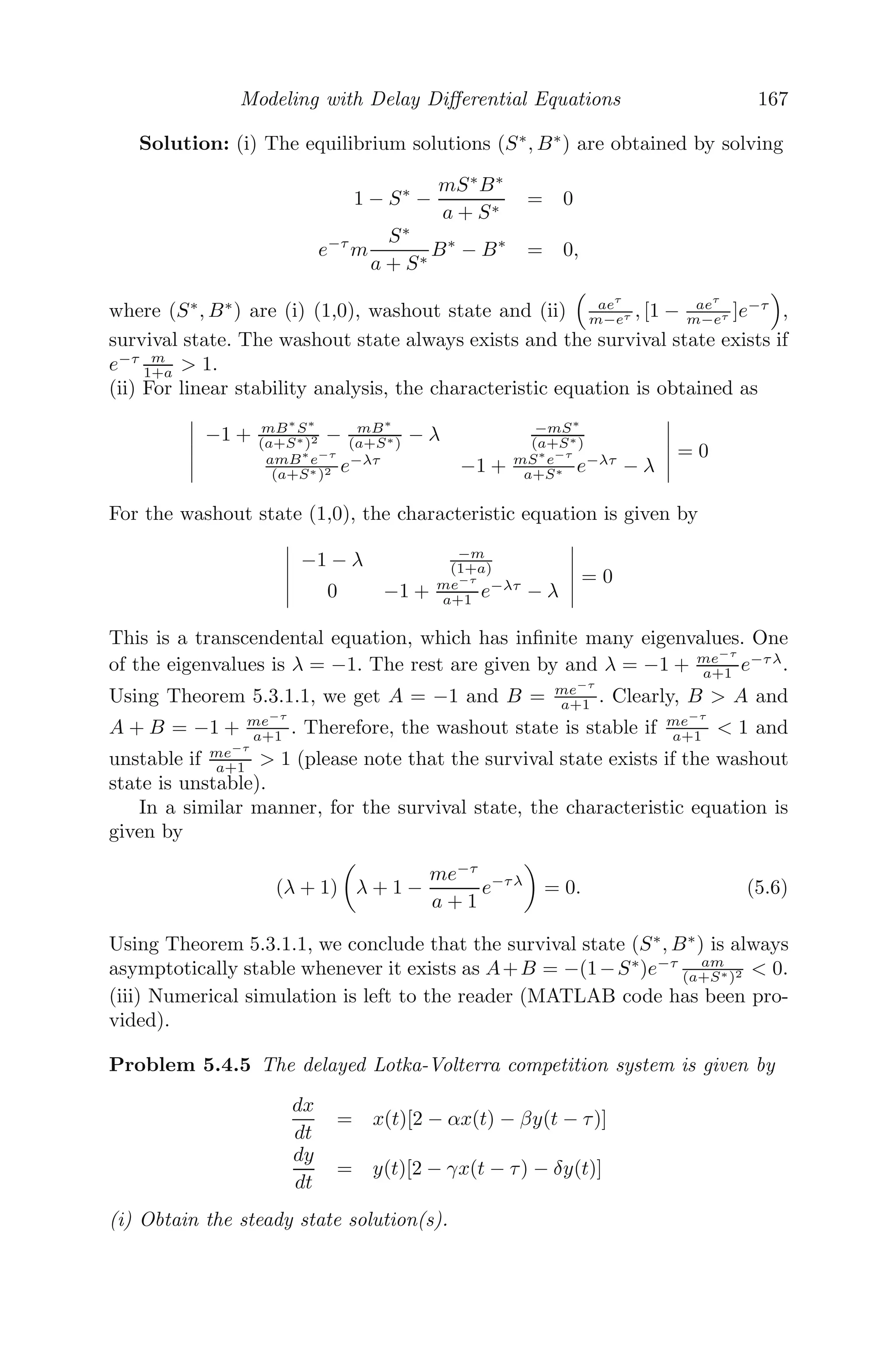
![136 Mathematical Modeling: Models, Analysis and Applications
is unstable when it exists.
Figure 4.6 gives the regions of existence of the equilibrium points with
respect to the parameters α1 and α2.
The positive interior equilibrium point E∗
− = (w̄1, w̄2, w∗
3−, w∗
4−), which
is locally asymptotically stable in the temporal system, when it exists, is a
spatially homogeneous steady state for the reaction diffusion equations (4.23−
4.26). Diffusion driven instability occurs when a temporally stable equilibrium
point becomes unstable because of the diffusive property of the interacting
populations [129]. To study the effect of diffusion on the temporal system, we
slightly perturb the temporally stable equilibrium point E∗
− and observe how
the small perturbation of the homogeneous equilibrium point develops in the
large time limit. For this, we consider the following perturbation
u1(x, t) = w̄1 + C1 cos kx,
u2(x, t) = w̄2 + C2 cos kx,
u3(x, t) = w3− + C3 cos kx,
u4(x, t) = w4− + C4 cos kx,
⎫
⎪
⎪
⎪
⎬
⎪
⎪
⎪
⎭
(4.28)
where Ci (i = 1, 2, 3, 4), are positive constants and k is the wave number.
Substituting the above equation in (4.23−4.26), we linearize the system about
the positive interior equilibrium point E∗
− to obtain the following system of
PDEs:
∂u1
∂t
= −(au − b(1 − u))u1 −
∂2
u1
∂x2
, (4.29)
∂u2
∂t
= b(1 − u)u1 − η1u2 − d2
∂2
u2
∂x2
, (4.30)
∂u3
∂t
= k1u1 + k2u2 − (η2 + α1w∗
4)u3 − α1w∗
3u4 − d3
∂2
u3
∂x2
, (4.31)
∂u4
∂t
= −α2w∗
4u3 + (1 − 2w∗
4 − α2w∗
3)u4 − d4
∂2
u4
∂x2
. (4.32)
The corresponding Jacobian matrix JE∗
−
at the positive interior equilibrium
point E∗
− is given by
JE∗
−
=
⎛
⎜
⎜
⎝
−q0 − k2
0 0 0
b(1 − u) −η1 − d2k2
0 0
k1 k2 −(η2 + α1w∗
4 + d3k2
) −α1w∗
3
0 0 −α2w∗
4 −(w∗
4 + d4k2
)
⎞
⎟
⎟
⎠
and the corresponding characteristic equation is given by
(λ + au − b(1 − u) + k2
)(λ + η1 + d2k2
) × [λ2
+ (η2 + (1 + α1)w∗
4 + (d3 + d4)k2
)λ
+(d3 + d4)k4
+ (w∗
4 + (η2 + α1w∗
4)d4)k2
+ w∗
4(η2 + α1 − 2α1α2w∗
3)] = 0](https://image.slidesharecdn.com/mathematicalmodelingmodelsanalysisandapplicationspdfdrive-211127122602/75/Mathematical-modeling-models-analysis-and-applications-pdf-drive-191-2048.jpg)
![Spatial Models Using Partial Differential Equations 137
From the existence of the cancerous cells free equilibrium point, we know that
au − b(1 − u) 0. Hence the linear stability analysis of the spatiotemporal
model depends on the solution of the quadratic equation:
0 = λ2
+ (η2 + (1 + α1)w∗
4 + (1 + d4)k2
)λ (4.33)
+ (w∗
4 + (η2 + α1w∗
4)d4)k2
+ d4k4
+ w∗
4(η2 + α1 − 2α1α2w∗
3).
But, from (4.29) and (4.33), we have
η2 + α1 − 2α1α2w∗
3 =
(α1 + η2)2 − 4α1α2(k1w̄1 + k2w̄2),
which is positive at the positive interior equilibrium point E∗
−. Hence λ is
negative or complex with negative real part, since α1, η2, d4, k2
and w∗
4 are all
positive. Therefore, the equilibrium point E∗
− is always spatially stable. One
can easily check that the tumor free equilibrium point is also spatially stable
(always).
4.4.4 Numerical Results
The system is solved numerically with respect to time and space con-
sidering the positive initial conditions (w1(0, x) = w10 0, w2(0, x) = w20
0, w3(0, x) = w30 0, w4(0, x) = w40 0, for x ∈ [0, l]) with no flux boundary
conditions. From the stability analysis of the reaction diffusion equations, the
temporally stable positive interior equilibrium point E∗
− remains stable due to
a small spatiotemporal perturbation. The dynamics of the system about the
equilibrium point E∗
− is the only point for discussion here as all other points
are irrelevant from a biological point of view when the spatial aspect has been
considered. The parameter values used for numerical simulations and their
sources are listed in tabular form (Table 4.1).
In the parametric region R1 : 0 α2 α21, the high number of the
cancerous cells equilibrium point E∗
− is the only locally asymptotically stable
equilibrium point of the system. In this region, the cancerous cells are able
to overcome the immune system surveillance, that is, they survive. Figure 4.7
shows the dynamics of the system in this region.
In the region R2 : α21 α2 α22 (α1 − η2 0), both the cancer free cells
and the high number of cancerous cell equilibrium points are locally asymp-
totically stable, that is, it is a region of bi-stability. In this region the system
is highly sensitive to the initial condition and some of the values of the sys-
tem parameters. A slight change in the initial conditions around the region
of attraction of this equilibrium point causes a drastic change in the behav-
ior of the system in this region. The cancer burden may reduce (first panel)
or increase (second panel) depending on initiation of the therapy (such as,
monoclonal antibody therapy) which may be capable of changing the system](https://image.slidesharecdn.com/mathematicalmodelingmodelsanalysisandapplicationspdfdrive-211127122602/75/Mathematical-modeling-models-analysis-and-applications-pdf-drive-192-2048.jpg)
![138 Mathematical Modeling: Models, Analysis and Applications
TABLE 4.1: Parameter Values
Parameters Values Scaled References
a1 (0.02 − 0.2) hr.−1
0.0464 -0.464 [97]
b1 0.01 hr.−1
0.0232 [97]
μ1 (0.002 − 0.02) hr.−1
0.00464-
0.0464
[97]
K1 1.25 × 107
cells − [97]
u 0.1 − [97]
r1 100 Ab cell−1
sec.−1
2.95942 [84]
r2 1000 Ab cell−1
sec.−1
29.5942 [84]
μ2 0.1277 − 0.6465 hr.−1
0.2963 - 1.5 [31]
β1 4.5 × 10−10
− 2.5448 ×
10−6
cell−1
hr.−1
1.0232 -
5786.32
[31]
r 0.431 day−1
− [100]
K2 9.8 × 108
cells − [100]
β2 6.6 × 10−10
− 2.4935 ×
10−7
Ab−1
hr.−1
1.5 −
566.968
[31]
parameters. The dynamics of the system are depicted in Figure 4.8.
In the regions R3 : α2 α22 and R4 : α21 α2 α22, α1 − η2 0,
the cancerous cells free equilibrium point is the only equilibrium point of the
system which is locally asymptotically stable. In these regions, the antibodies
are able to successfully eradicate the cancerous cells. Any amount of cancerous
cells are eradicated with time. This situation is depicted in Figure 4.9.
4.4.5 Conclusion
In this example, we have examined a spatiotemporal mathematical model
describing the interaction of cancerous cells in the presence of humoral (anti-
body) mediated immune response. In particular, we have focused our attention
upon the interaction of cancer cells with antibodies through diffusion. Ana-
lytical study shows that the system always remains stable when the spatial
aspect is taken into account. Numerically, it is shown that for a particular
choice of parameters, the model was able to simulate the phenomenon of can-
cer dormancy - a clinical condition that has been observed in colon cancer,
breast cancer and in several types of lymphomas. The model also allows us
to identify certain critical system parameters, that can reduce cancer burden.
However, there are few significant features which may not be included in this
model. For example, a bifurcation analysis of the spatiotemporal model can
give a better understanding of the system parameters that may lead to cancer
dormancy and cancer regrowth mechanisms and in optimizing the therapeutic](https://image.slidesharecdn.com/mathematicalmodelingmodelsanalysisandapplicationspdfdrive-211127122602/75/Mathematical-modeling-models-analysis-and-applications-pdf-drive-193-2048.jpg)
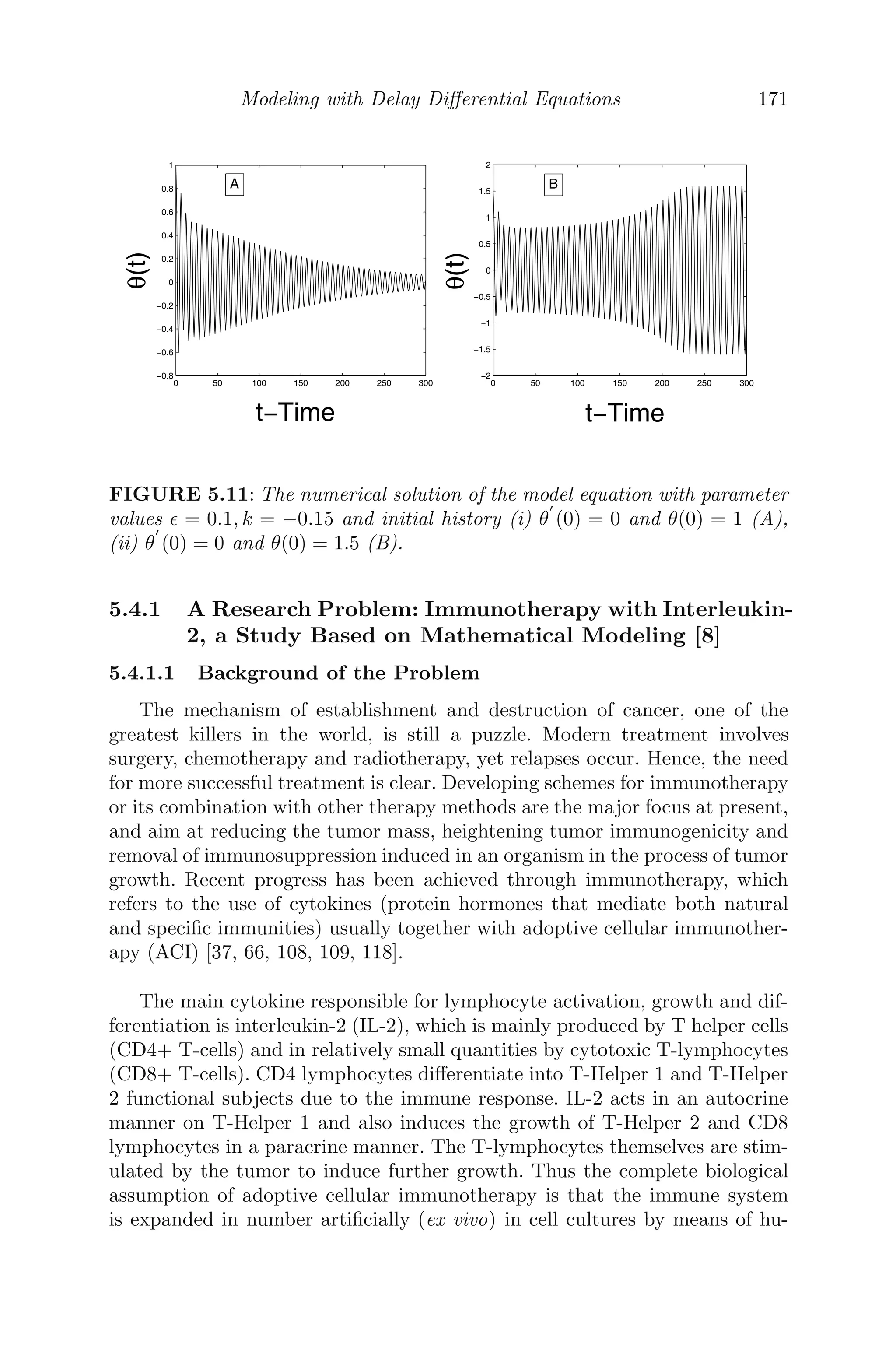
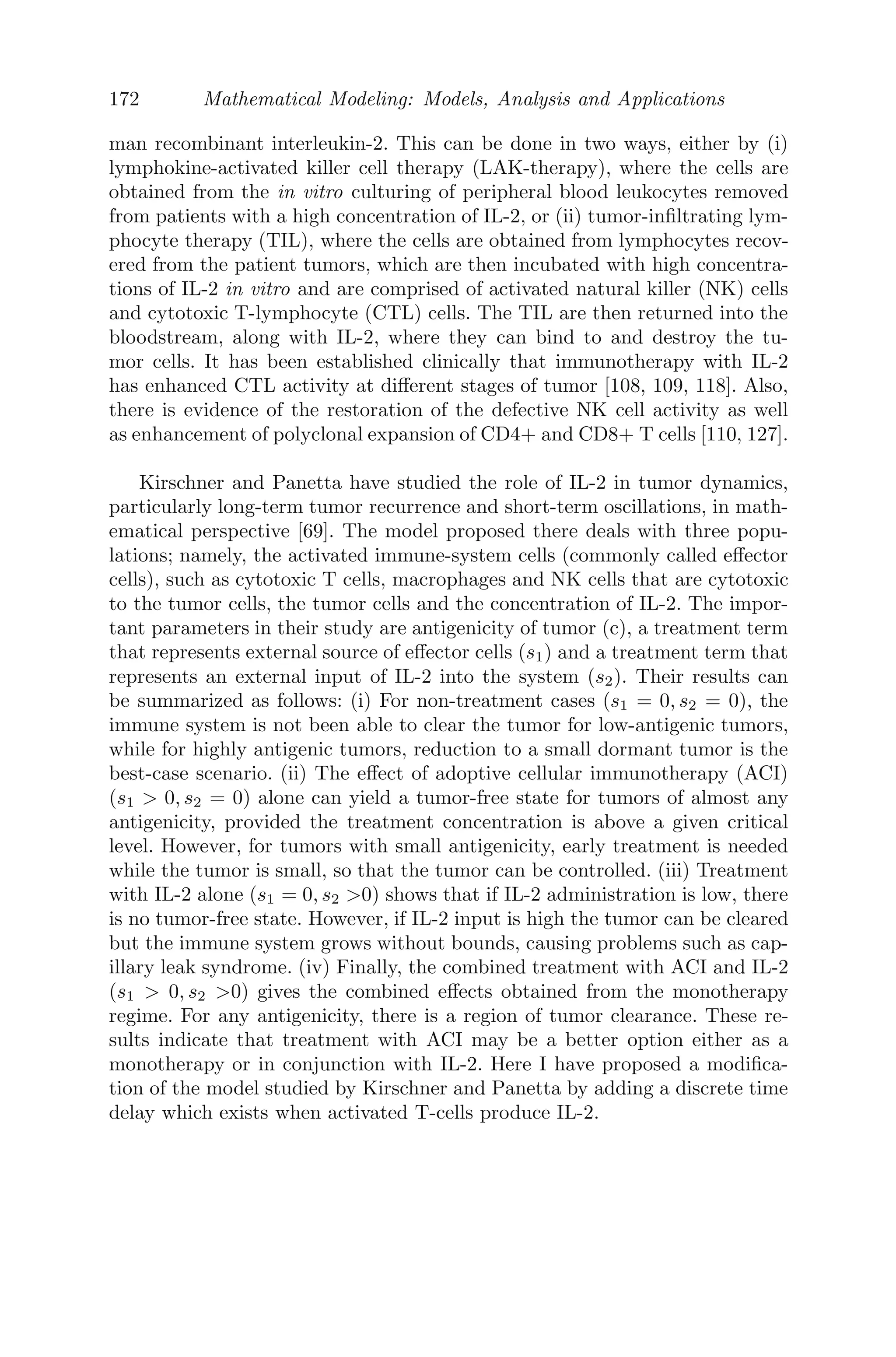
![Spatial Models Using Partial Differential Equations 141
0
2
4
6
8
10
0 20 40 60 80 100
0.1
0.2
0.3
0.4
0.5
Time t
Distance x
Antibodies
0
5
10
0 10 20 30 40 50 60 70 80 90 100
−0.2
0
0.2
0.4
0.6
0.8
Time t
Distance x
Cancerous
cells
0
5
10
0
20
40
60
80
100
0.35
0.4
0.45
0.5
Time t
Distance x
Antibodies
0
5
10
0
20
40
60
80
100
0
0.2
0.4
0.6
0.8
Time t
Distance x
Cancerous
cells
a
b
FIGURE 4.9: The dynamics of the system (4.23 − 4.26) in the region (a)
α2 α22 where α1 = 8.5, α2 = 4.5 with IC = (0.024, 0.021, 0.48, 0.8) and (b)
α21 α2 α22 and α1 − η2 where, α1 = 1.2, α2 = 2.1, with IC = (0.024,
0.021, 0.48,0.8).
Applying the boundary conditions u(0, t) = 0 = u(L, t), we get
0 = (C1 cos 0 + C2 sin 0)e−λ2
c2
t
0 = [C1 cos(λL) + C2 sin(λL)]e−λ2
c2
t
⇒ C1 = 0 and C2 sin(λL) = 0.
⇒ sin(λL) = 0 (for non-trivial solution C2 = 0)
⇒ λ =
nπ
L
, n being an integer.
Therefore, the required solution is of the form
u(x, t) = C2sin
nπ
L
x
e
−n2π2c2
L t
Noting that the heat conduction equation is linear, we use the principle of
superposition to obtain its most general solution as
u(x, t) =
∞
n=1
Bnsin
nπ
L
x
e
−n2π2c2
L t
Using the initial condition we get
u(x, 0) = u0 =
∞
n=1
Bnsin
nπ
L
x](https://image.slidesharecdn.com/mathematicalmodelingmodelsanalysisandapplicationspdfdrive-211127122602/75/Mathematical-modeling-models-analysis-and-applications-pdf-drive-196-2048.jpg)
![142 Mathematical Modeling: Models, Analysis and Applications
which is a half-range Fourier series, where
Bn =
2
L
L
0
u0 sin
nπ
L
x
dx
=
2u0
nπ
(1 − cosnπ)
=
2u0
nπ
[1 − (−1)n
]
Therefore,
Bn =
4u0
nπ , nis odd
0, n is even
In general, we can write
Bn =
4u0
(2n + 1)π
, n = 0, 1, 2, ...
Hence, the temperature function is given by
u(x, t) =
∞
n=1
4u0
(2n + 1)π
sin
nπx
L
e
−n2π2c2
L t
Problem 4.5.2 A rod of length 10 cm, whose sides are insulated, is kept at
temperature 0 ◦
C and 100 ◦
C at its ends A and B respectively, until the steady
state condition prevails. The temperature at end A is suddenly increased to
20 ◦
C and at end B, it is decreased to 60 ◦
C. Formulate a mathematical model
of the given situation and obtain the temperature function at any time t.
Solution:
PDE :
∂u
∂t
= c2 ∂2
u
∂x2
, 0 ≤ x ≤ 10;
BC : u(0, t) = 0, u(10, t) = 100.
Before the temperature at the ends of the rod are changed, the heat flow in
the rod is independent of time when steady state is reached. Therefore, at the
steady state
d2
u
dx2
= 0 ⇒ us(x) = C1x + C2
Applying boundary conditions we get, C1 = 10, C2 = 0. Thus, the initial
steady temperature distribution in the rod is
us(x) = 10x
In a similar manner, when the temperature at the ends of the rod are changed
to 20 ◦
C and 60 ◦
C respectively, the final steady temperature in the rod is
us(x) = 4x + 20,](https://image.slidesharecdn.com/mathematicalmodelingmodelsanalysisandapplicationspdfdrive-211127122602/75/Mathematical-modeling-models-analysis-and-applications-pdf-drive-197-2048.jpg)
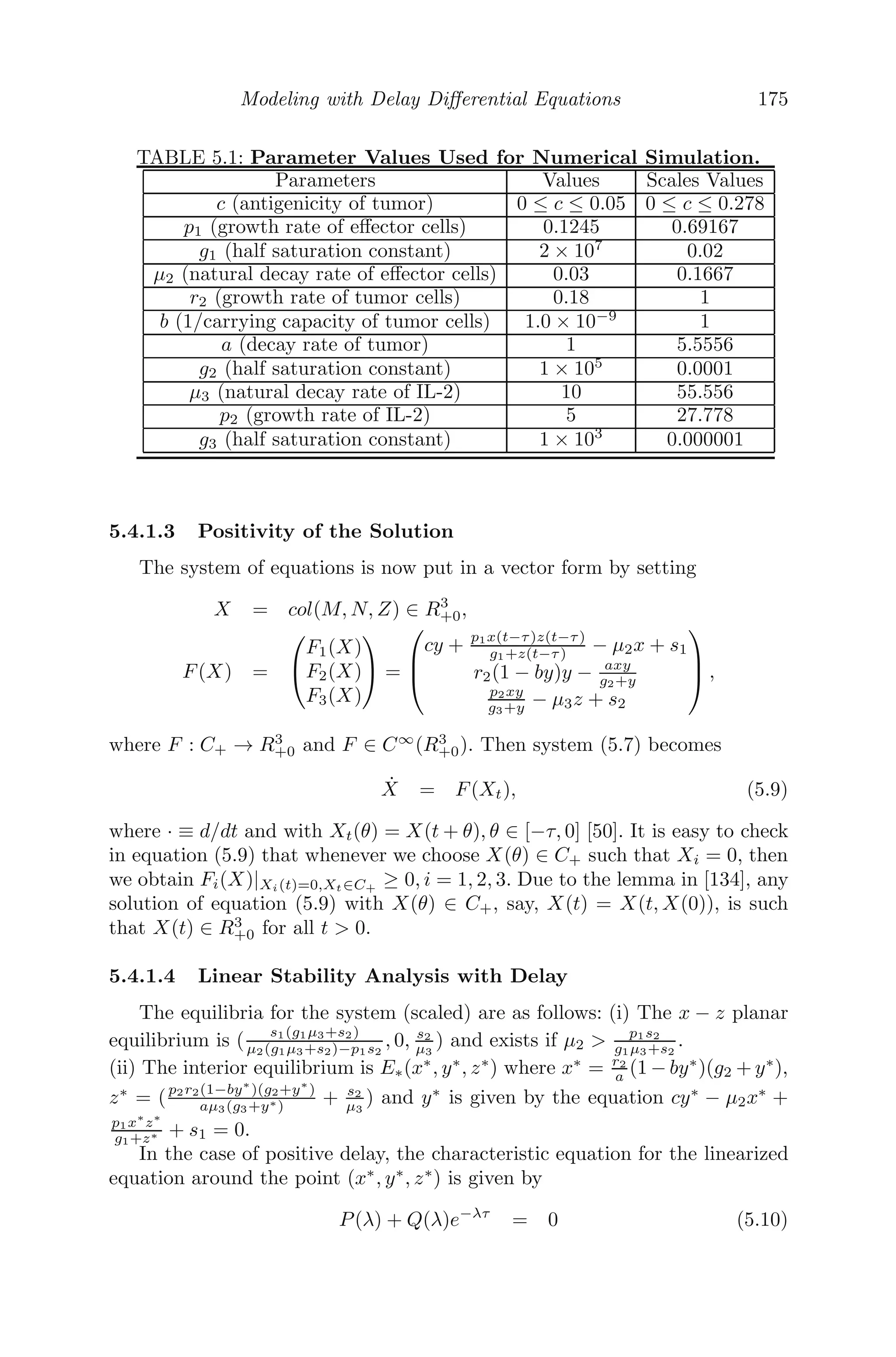
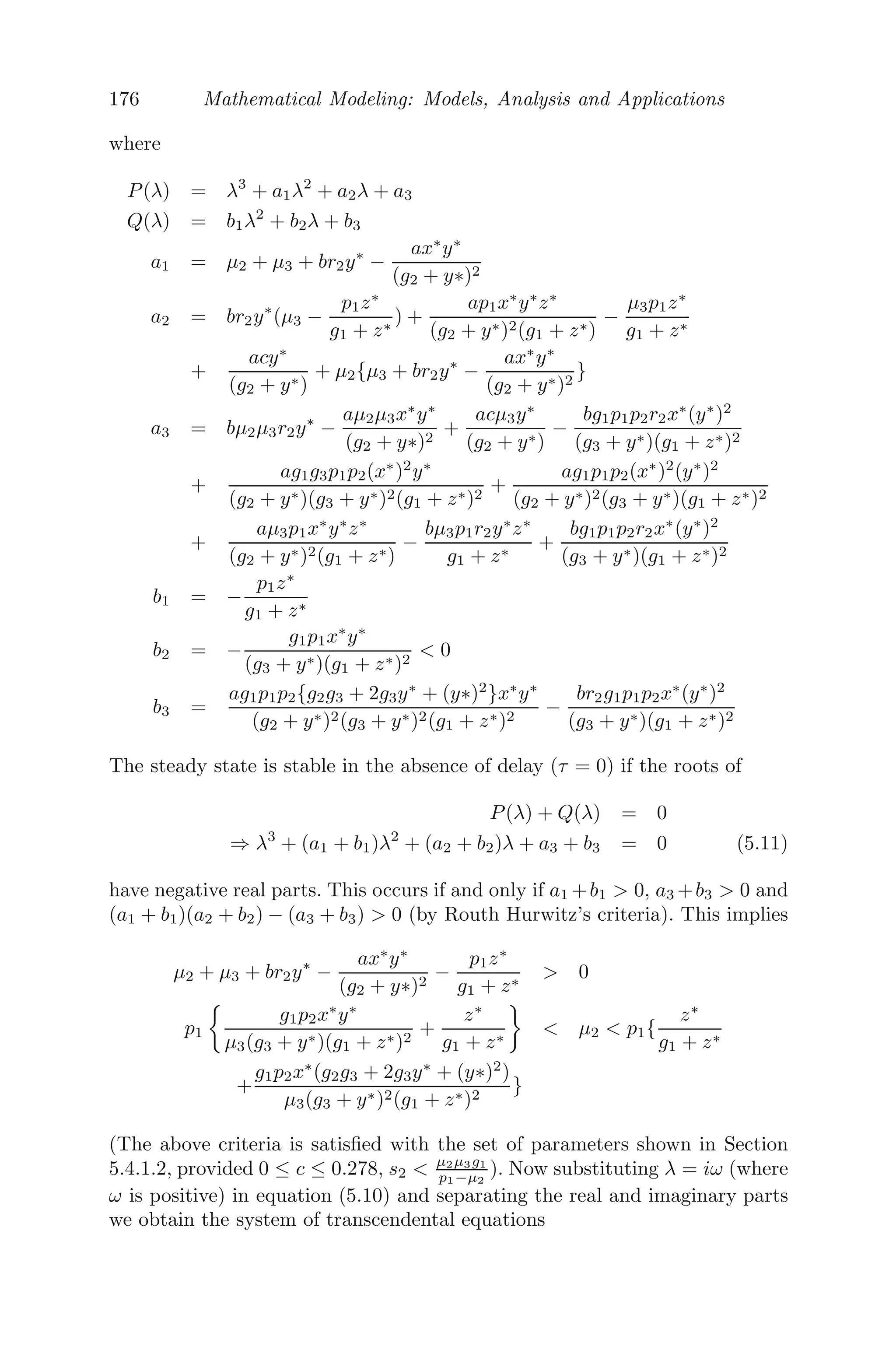
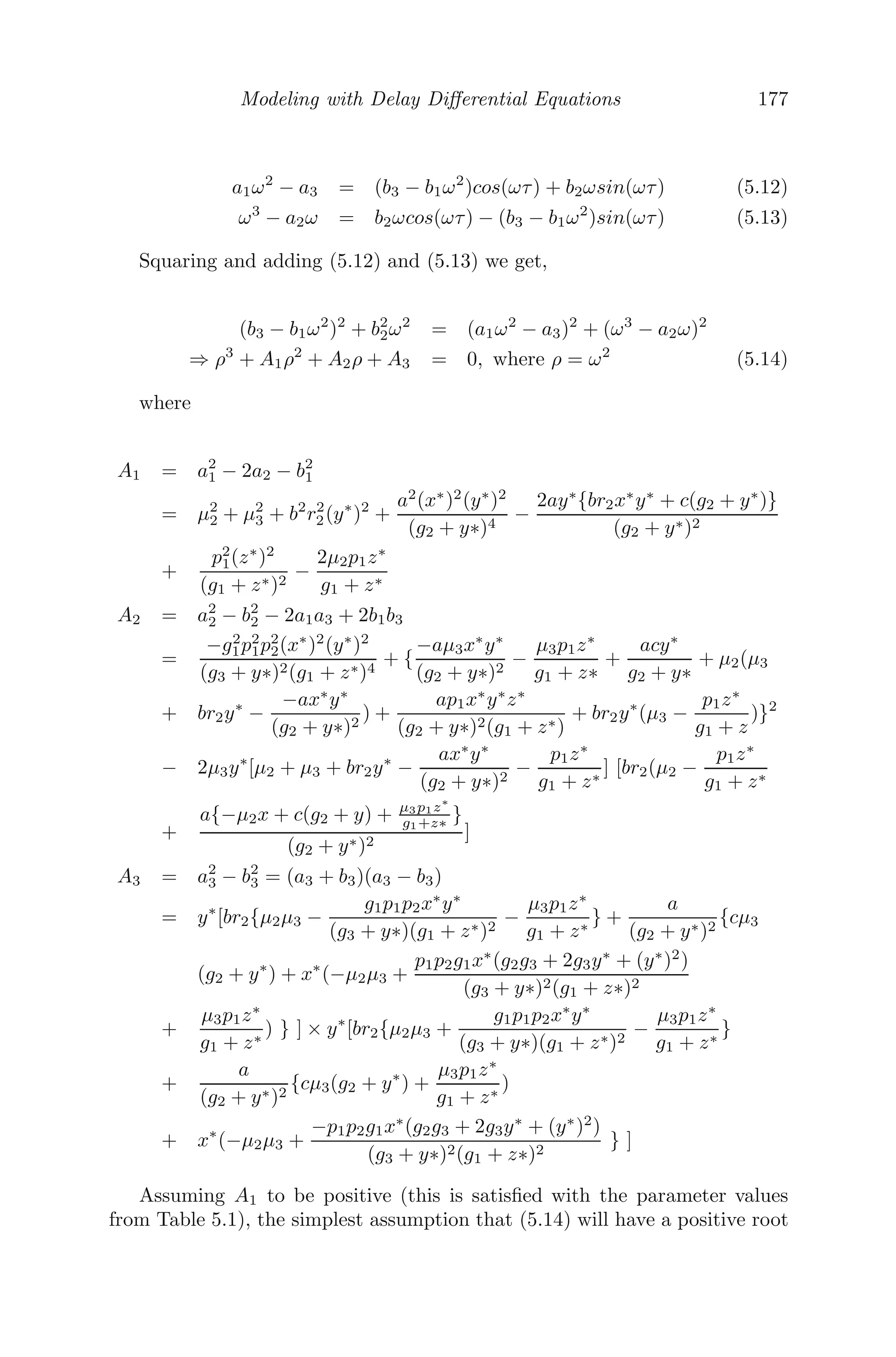
![146 Mathematical Modeling: Models, Analysis and Applications
Solution: The characteristic base curves for this initial value problem are
solutions of
dx
dt
= et
, x(0) = x0
x(t) = x0 + et
− 1
and along these curves
dρ(x(t), t)
dt
= 2ρ(x(t), t)
Solving, we get
ρ(x(t), t) = ρ(x(0), 0)e2t
= ρ(x0)e2t
ρ(x(t), t) = (1 + sin2
x0)e2t
,
after substituting the initial value for ρ0(x). Replacing x0 by x − et
+ 1, we
get the traffic density as
⇒ ρ(x, t) = [1 + sin2
(x − et
+ 1)]e2t
Problem 4.5.7 A reaction diffusion model is given by
∂M1
∂t
= r(a − M1 + M2
1 M2) +
∂2
M1
∂x2
∂M2
∂t
= r(b − M2
1 M2) + D
∂2
M2
∂x2
where M1 and M2 are morphogen concentrations. All the parameters
r, a, b, c, D are positive constants.
(i) Explain the model and find the non-zero homogenous steady state.
(ii) Show that the condition stability (without diffusion) is b−a−(a+b)3
0.
(iii) Linearize the system about the non-zero steady state and find the condi-
tion for diffusive instability.
Solution: A spatially homogeneous steady state (m∗
1, m∗
2) of the model is
given by
a − m∗
1 + (m∗
1)2
m∗
2 = 0
b − (m∗
1)2
m∗
2 = 0
Solving we get, (m∗
1, m∗
2) =
a + b,
b
(a + b)2
Let
M1(x, t) = m1(x, t) − m∗
1 (4.40)
M2(x, t) = m2(x, t) − m∗
2 (4.41)](https://image.slidesharecdn.com/mathematicalmodelingmodelsanalysisandapplicationspdfdrive-211127122602/75/Mathematical-modeling-models-analysis-and-applications-pdf-drive-201-2048.jpg)
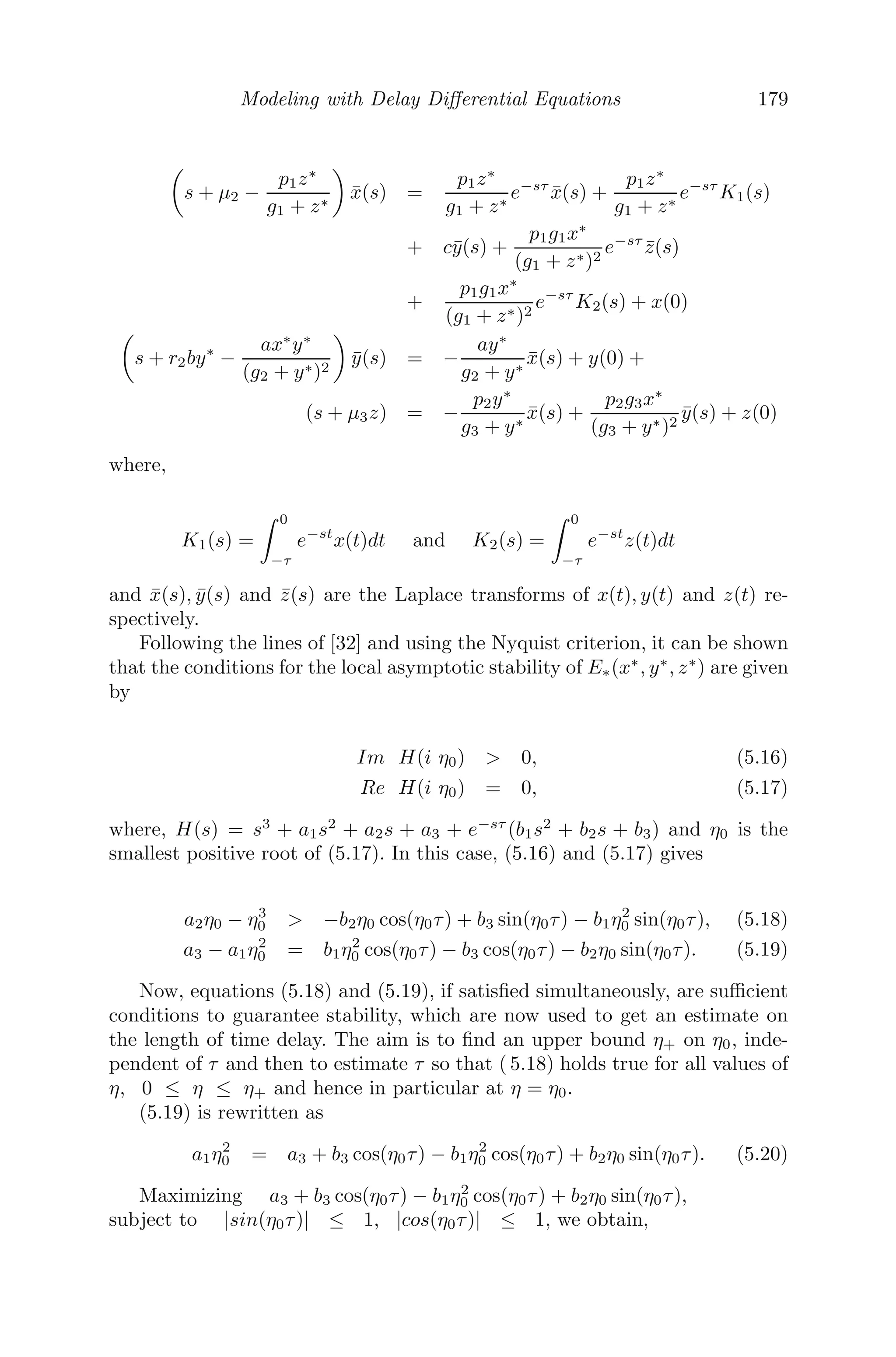

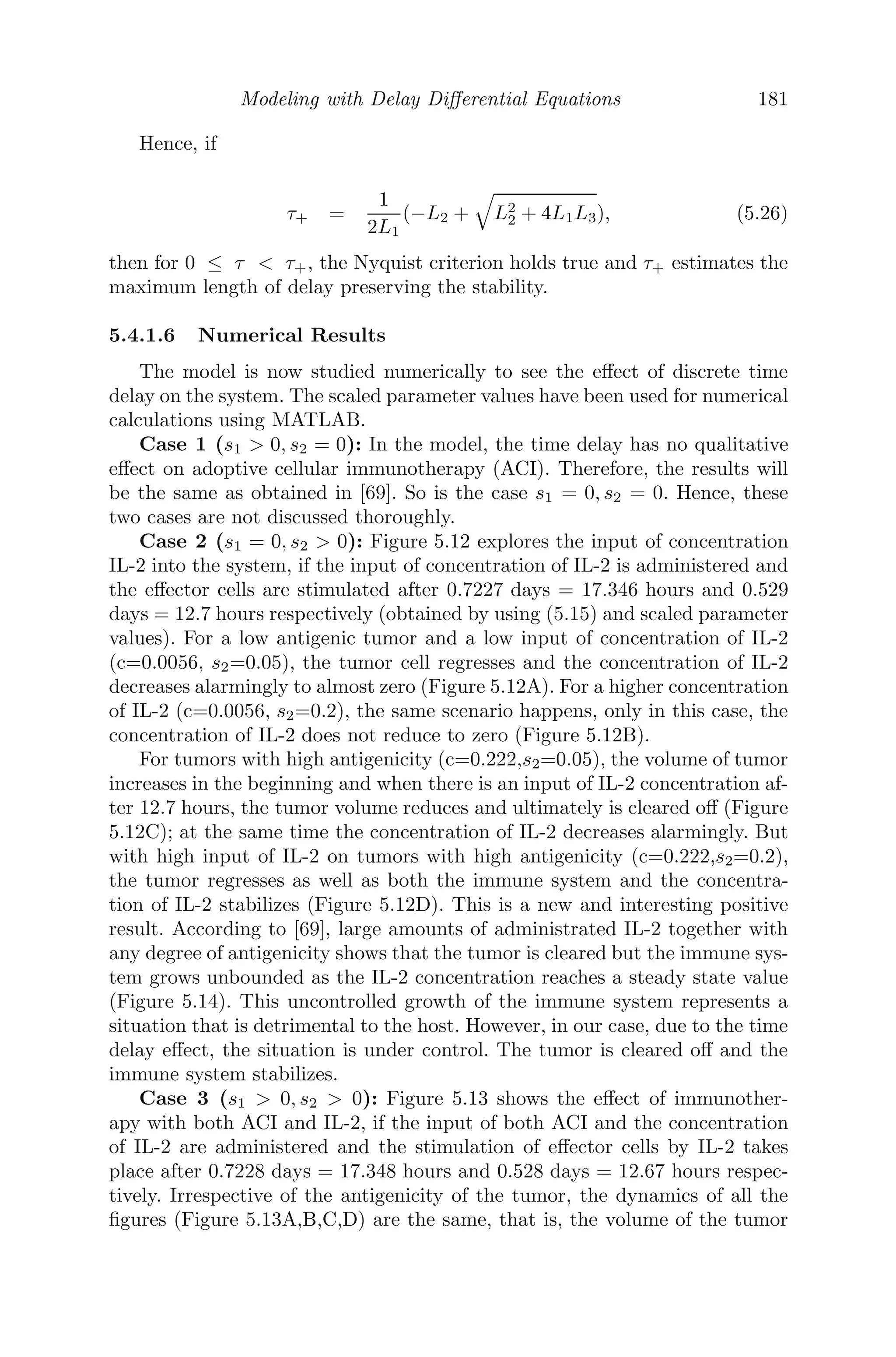
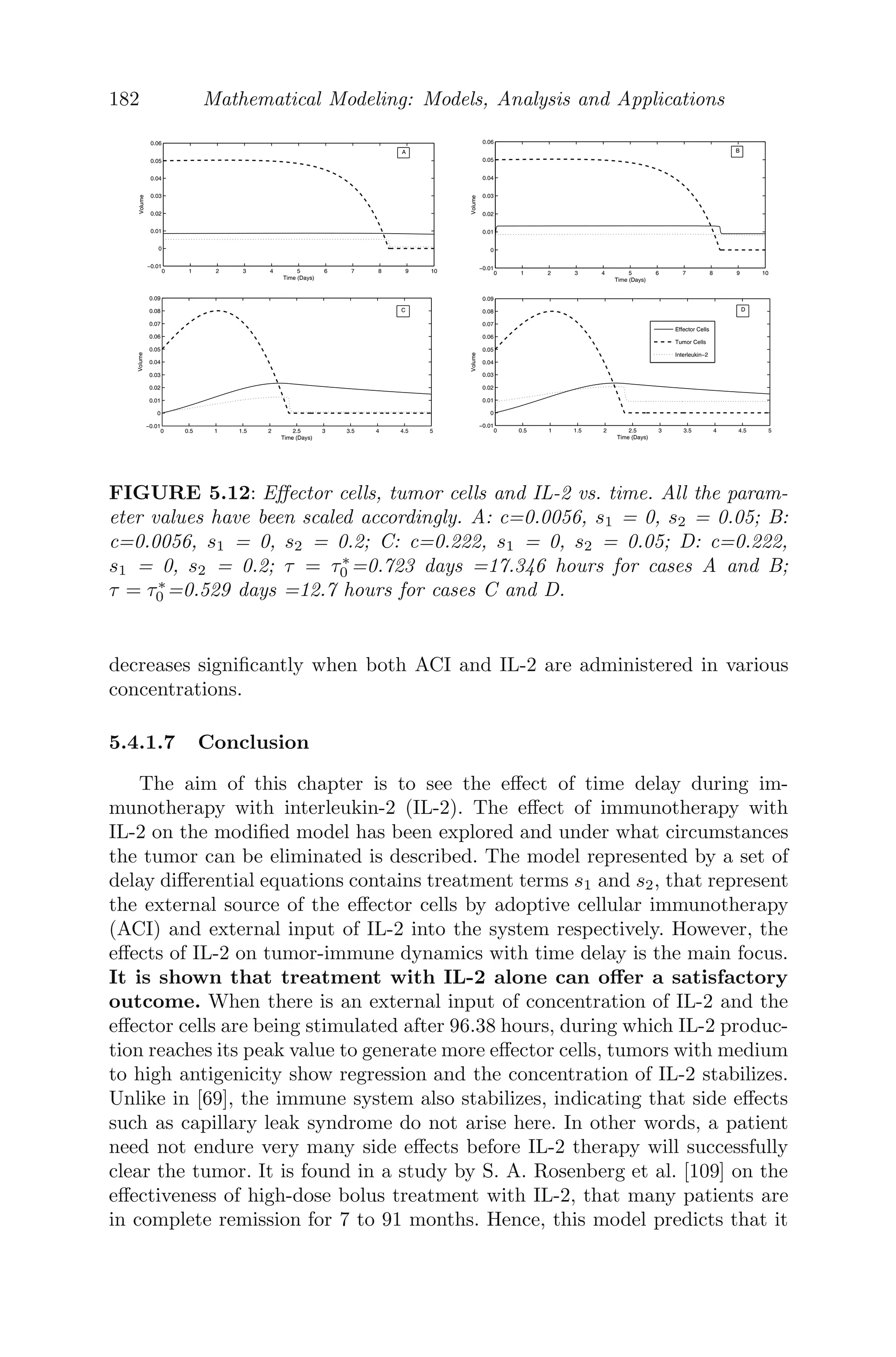
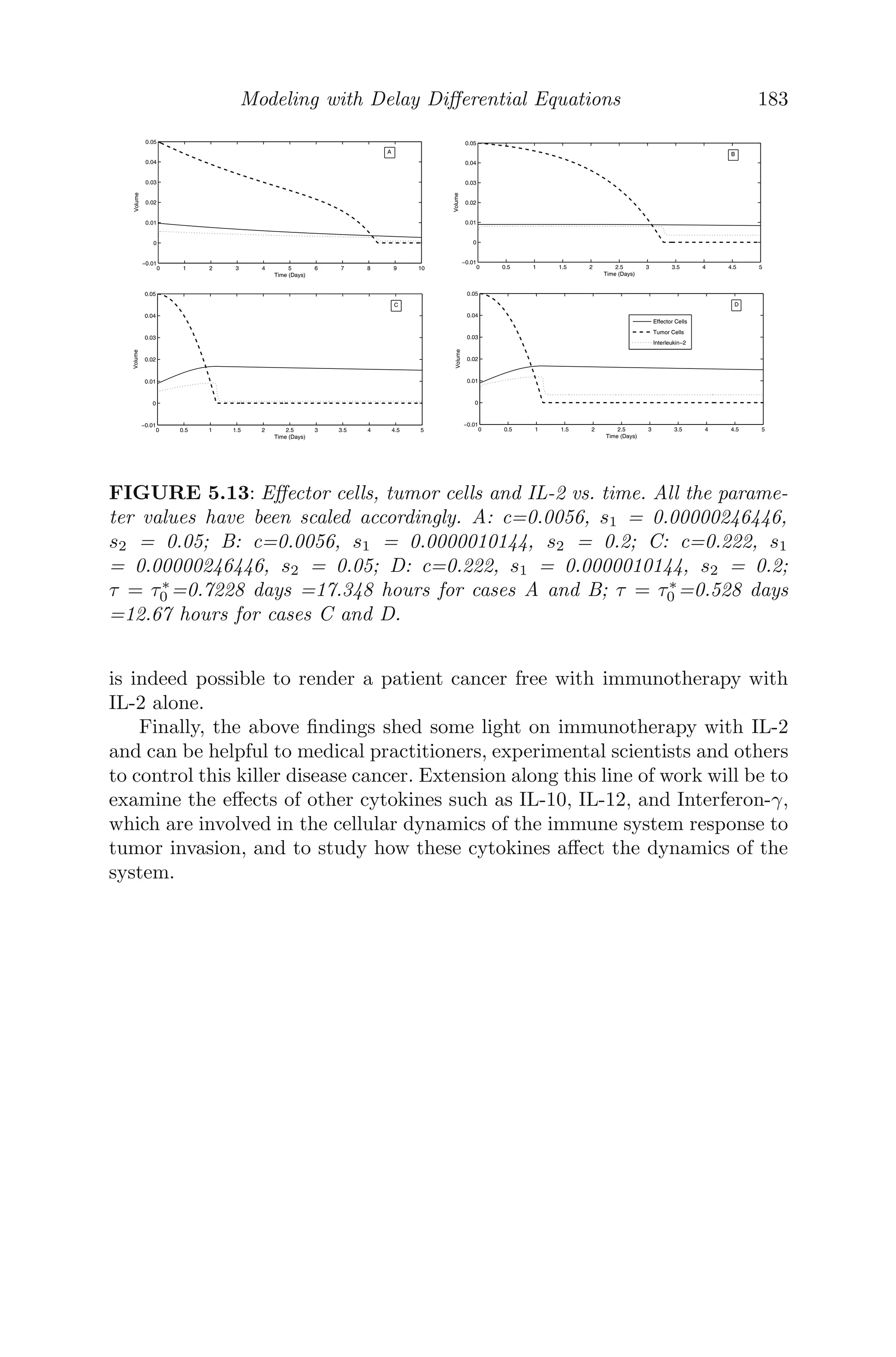
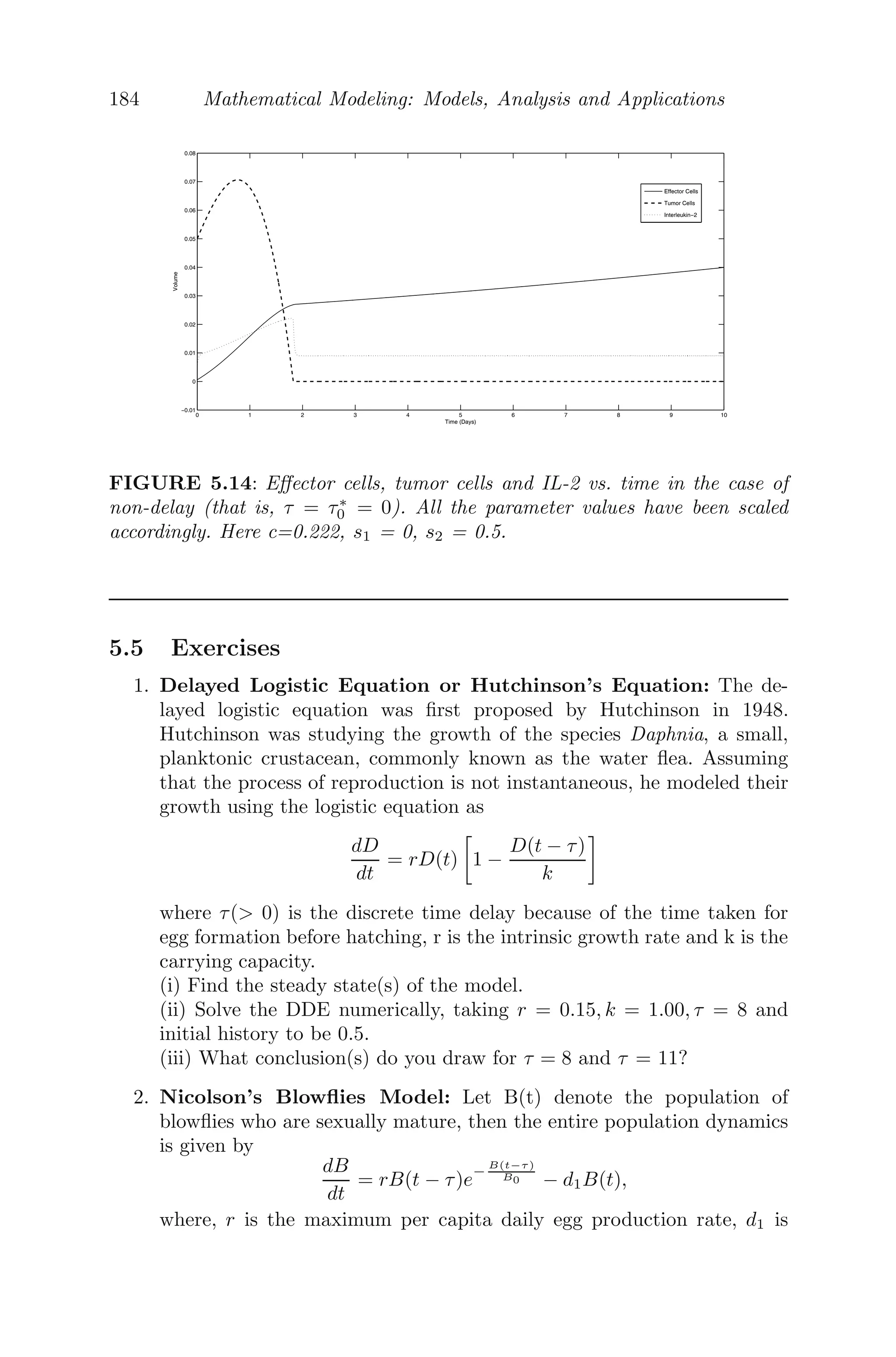
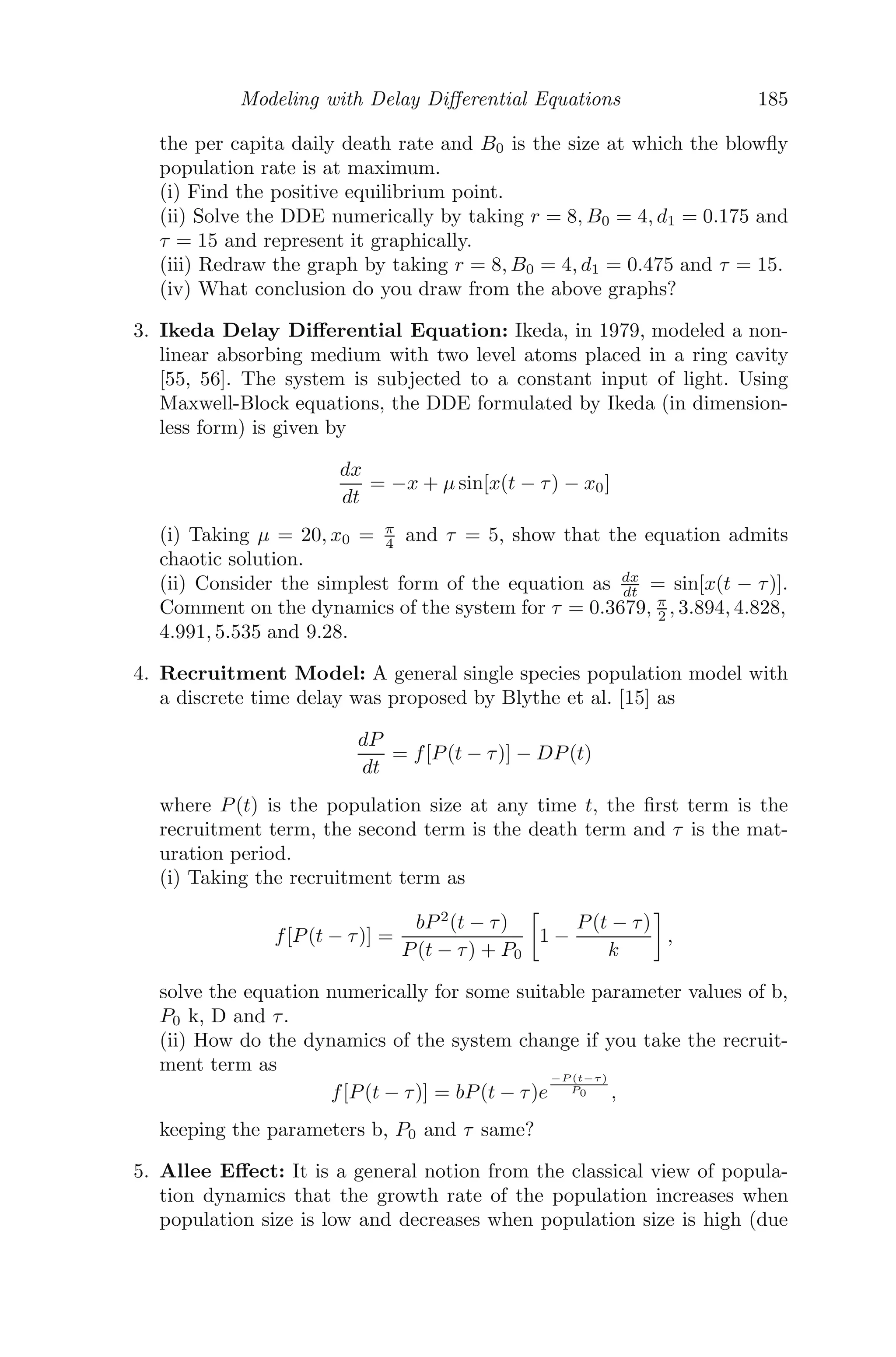

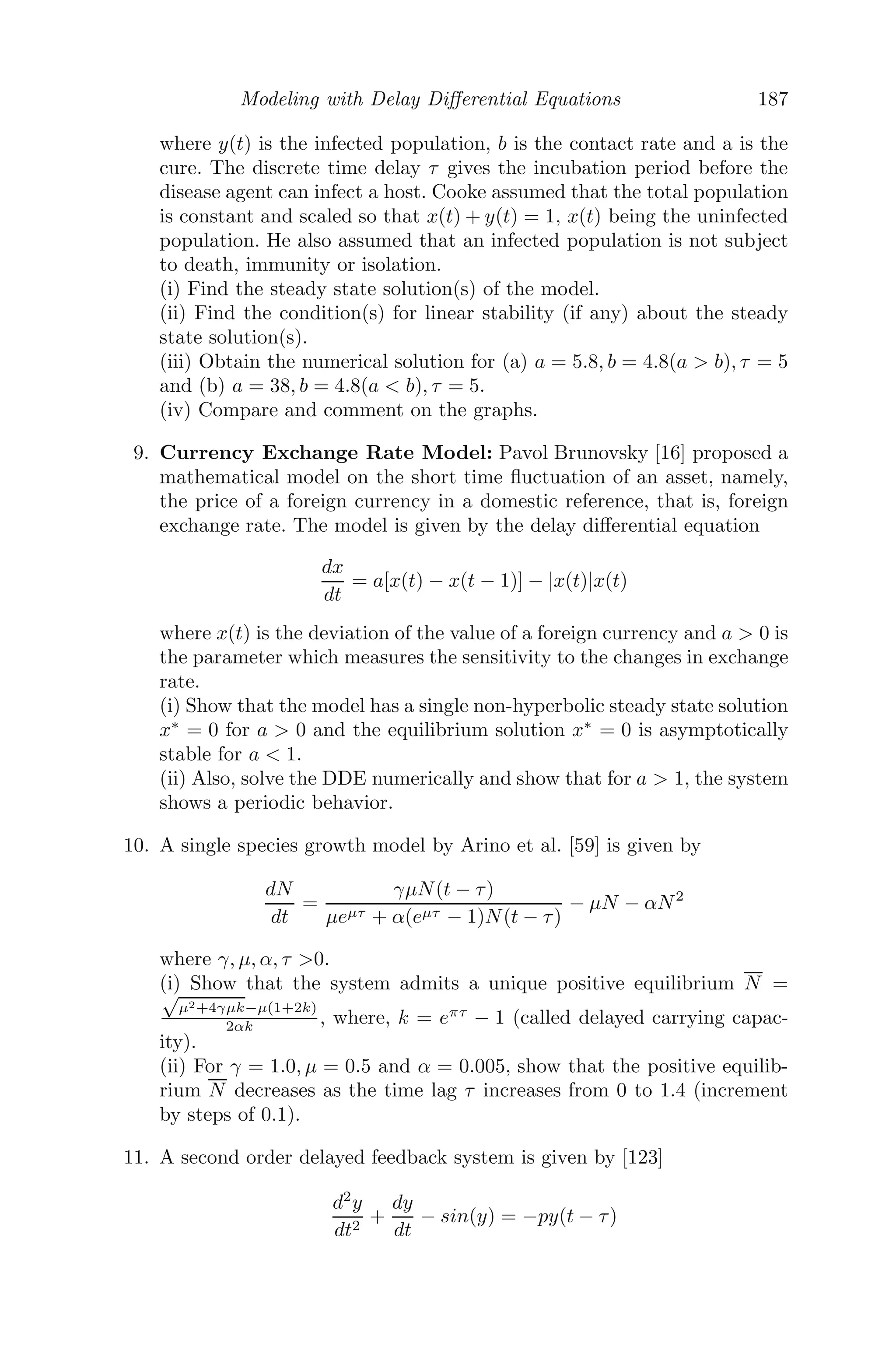
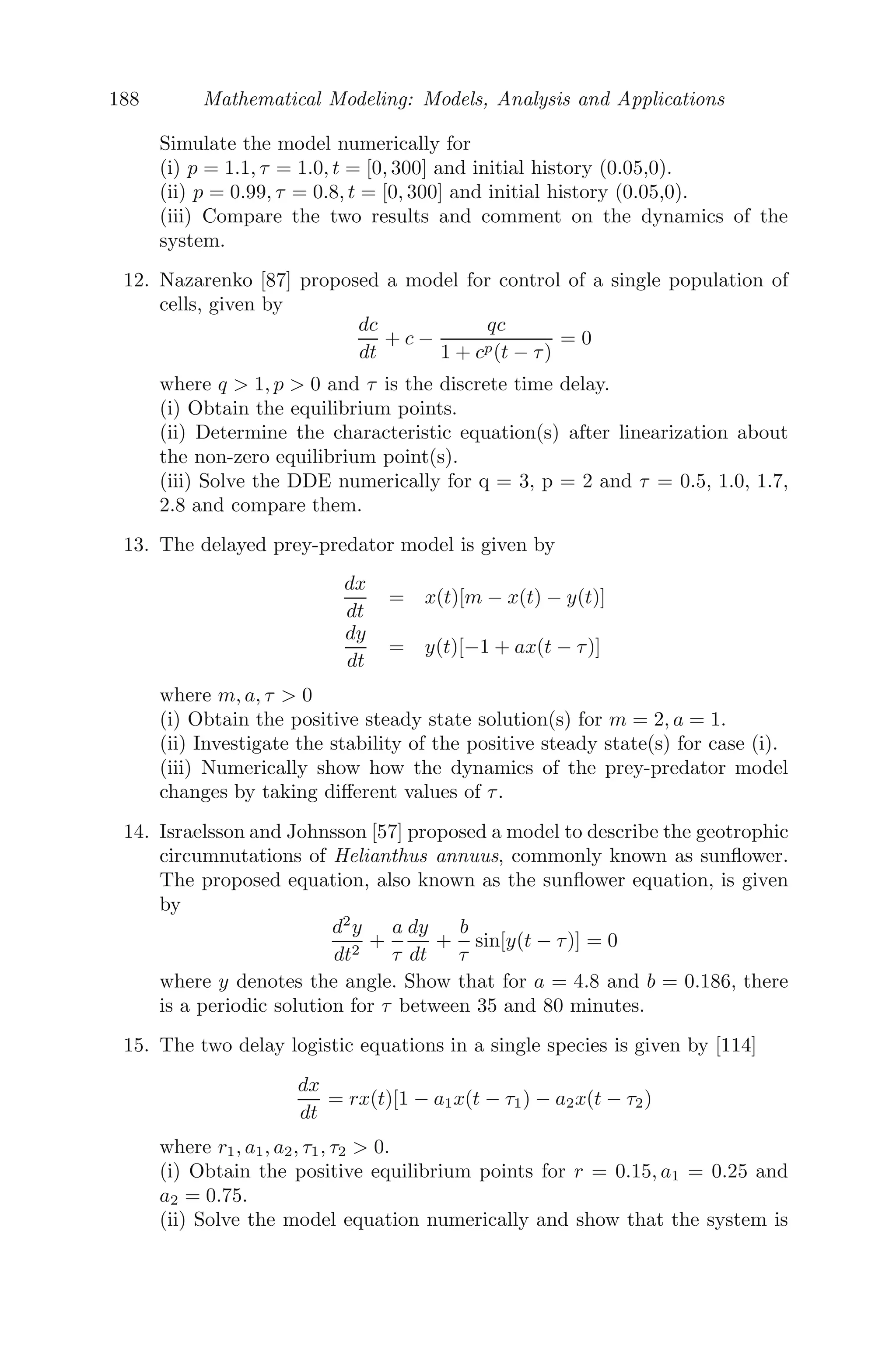
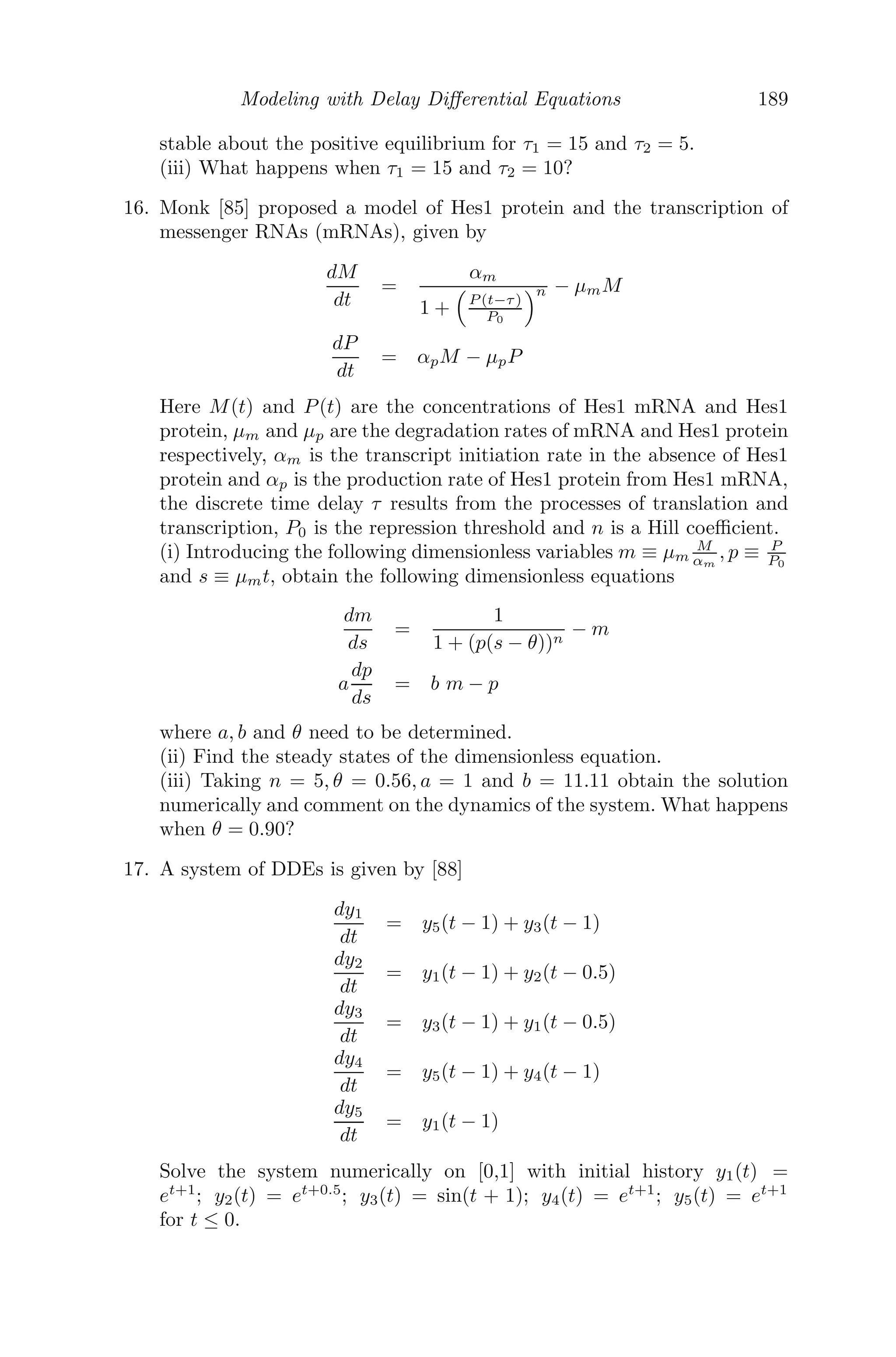
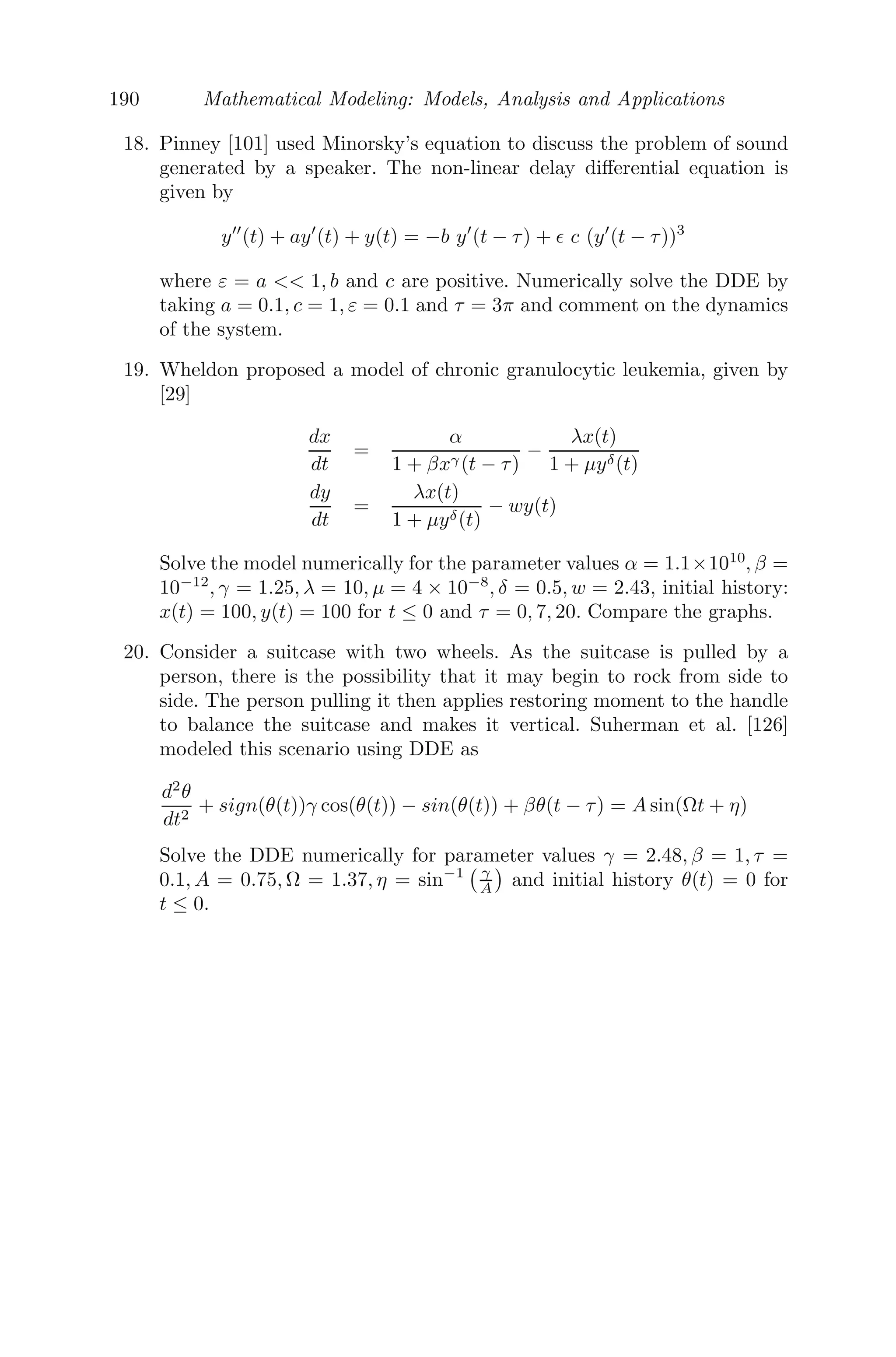
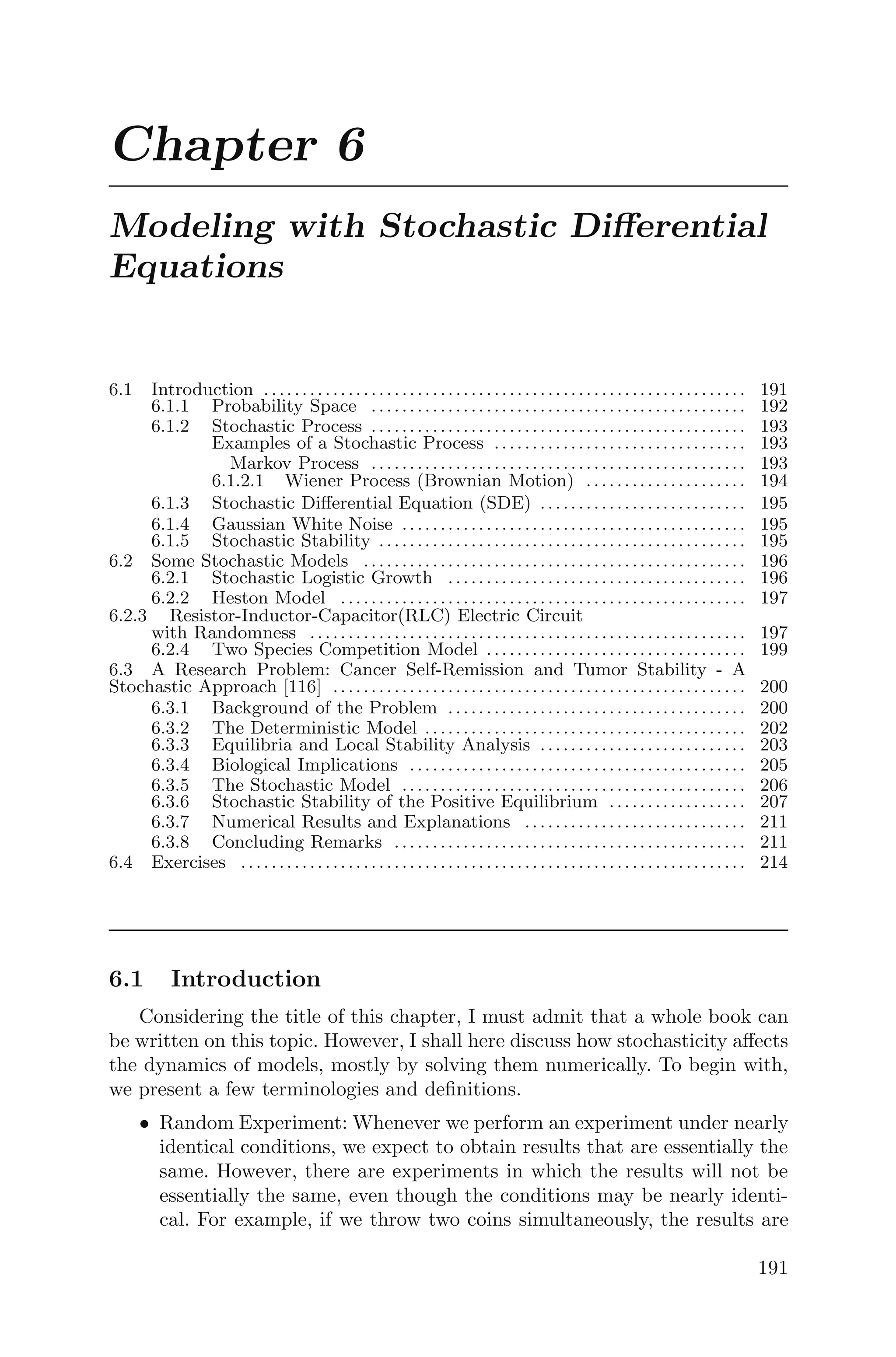
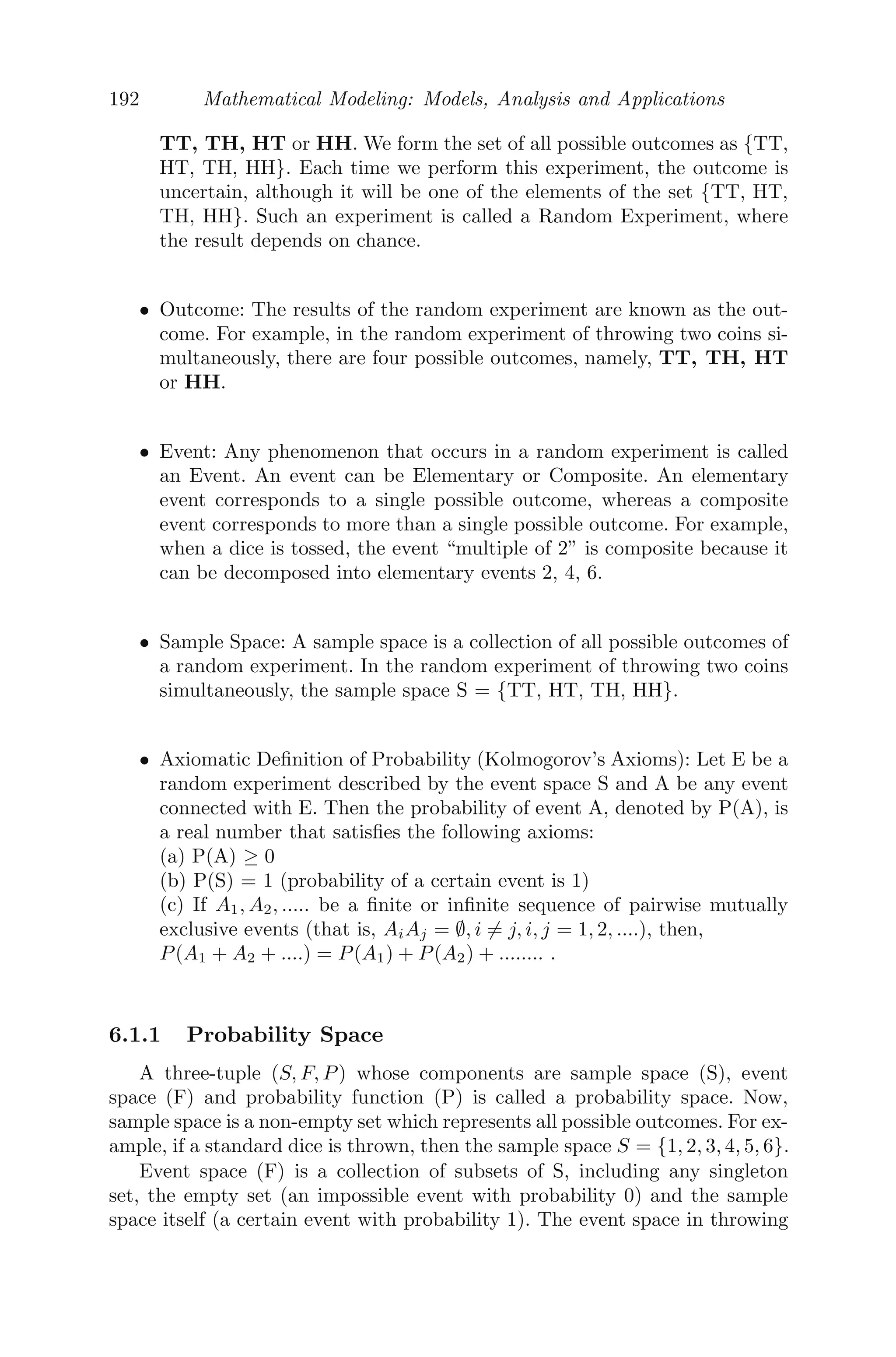
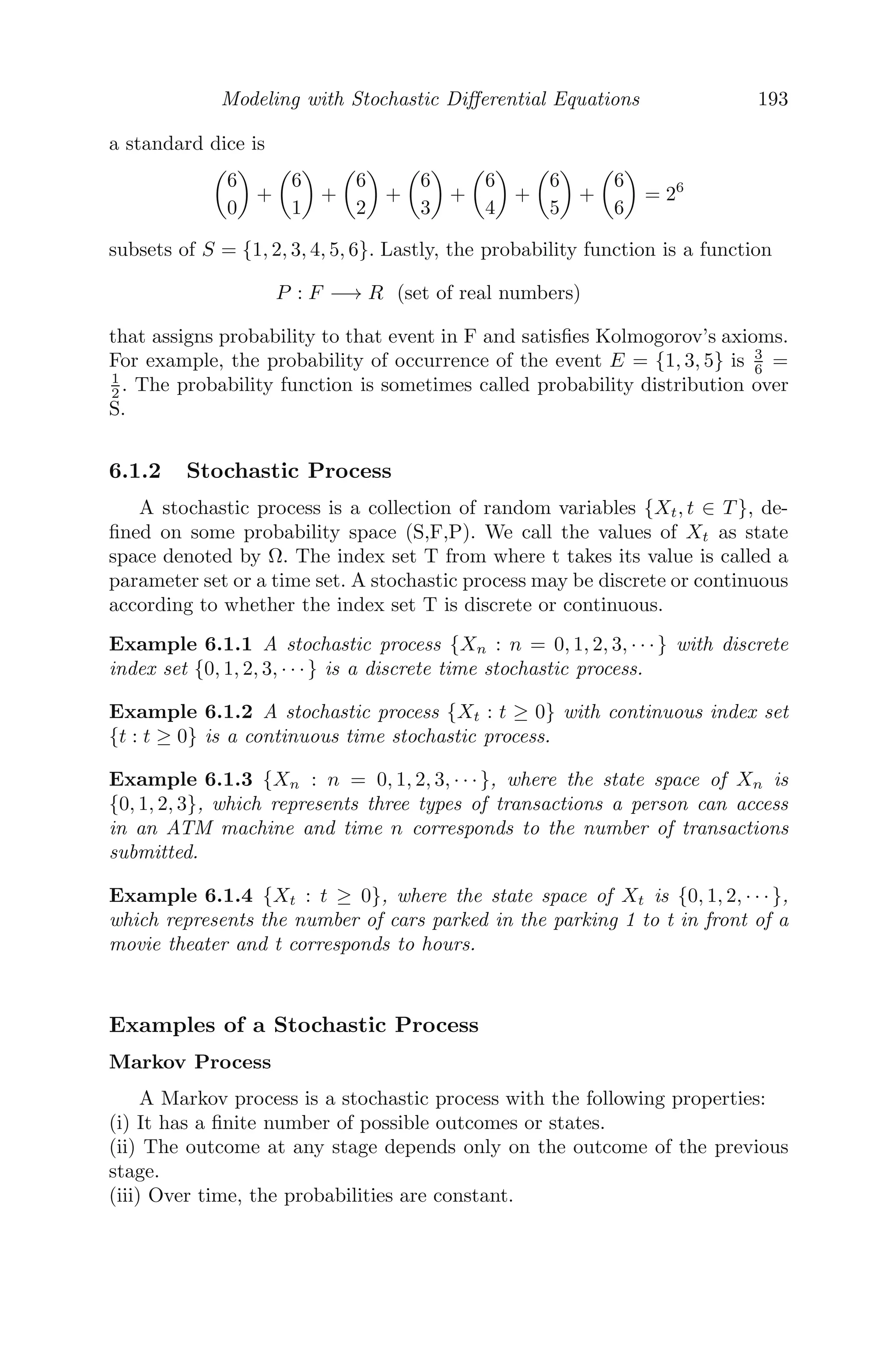
![150 Mathematical Modeling: Models, Analysis and Applications
with initial traffic density as
ρ(x, 0) =
⎧
⎨
⎩
150, x 0
150
1 − x
2
, 0 x 1
80, x 1
8. Find the traffic density ρ(x, t) satisfying the traffic equation
∂ρ
∂t
+ (1 − 2ρ)
∂ρ
∂x
= 0
with initial traffic density as
ρ(x, 0) =
⎧
⎨
⎩
1
4 , x 0
1
4 (1 − x2
)2
, x 1
0, x ≥ 1
9. Find the traffic density ρ(x, t) satisfying
(i)
∂ρ
∂t
+ 2
∂ρ
∂x
= 0, ρ0(x) = e−x2
(ii)
∂ρ
∂t
+ 2t
∂ρ
∂x
= 0, ρ0(x) = e−x2
(iii)
∂ρ
∂t
+ 2(1 − ρ)
∂ρ
∂x
= 0,
ρ0(x) =
1, x ≤ 0
0, x 0
10. The linear growth of a population is given by [26]
∂P(x, t)
∂t
= αP(x, t) + D
∂2
P(x, t)
∂x2
(i) Obtain the solution of the given model.
(ii) Let P(x, t) = k (constant). Then show that the value x
t is given by
x
t
= ∓
4αD −
2D
t
ln(t) −
2D
t
ln
√
2πD
k
P0
1/2
11. The spread of the spruce budworm [77] is given by
∂B
∂t
= αB
1 −
B
k
− β
B2
h2 + B2
+ D
∂2
B
∂x2
(i) Explain the model and find homogenous stability steady state(s).
(ii) Perform the linear stability analysis about the equilibrium point(s)
for the non-diffusive system and obtain the condition for stability. In-
terpret the condition in the context of the model.
(iii) Now, perform the linear stability analysis for a diffusive system and
conclude about the effect of diffusion on the system.](https://image.slidesharecdn.com/mathematicalmodelingmodelsanalysisandapplicationspdfdrive-211127122602/75/Mathematical-modeling-models-analysis-and-applications-pdf-drive-217-2048.jpg)
![Spatial Models Using Partial Differential Equations 151
12. Segal and Jackson [119, 26] have modeled a spatially distributed
predator-prey system as
Prey :
∂V
∂t
= (k0 + k1V ) − AV E + μ2∇2
V
Predator :
∂E
∂t
= BV E − ME − CE2
+ μ2∇2
E
(i) Describe the model by explaining each term in the equations.
(ii) Assuming M = 0 and putting v = V B
k0
and e = Ec
k0
, write the model
in non-dimensionlized form as
∂v
∂t
= (1 + kv)v − aev + δ2
∇2
v
∂e
∂t
= ev − e2
+ ∇2
e
where k = k1
B , a = A
C and δ2
= μ1
μ2
.
(iii) Find the non-trivial homogenous steady state(s).
(iv) Show that the condition for diffusive instability is k−δ2
2
√
a − k.
13. The spread of least colonies was introduced by Gray and Kirwan [26, 48]
and is given by
∂Y
∂t
= D1
∂2
Y
∂x2
+ kY (G − G0)
∂G
∂t
= D2
∂2
G
∂x2
− ckY (G − G0)
Here, Y (x, t) is the density of yeast cells and G(x, t) is the glucose con-
centration in medium at time t and location x.
(i) Explain the model and find the homogenous steady state(s).
(ii) Perform the linear stability analysis about the equilibrium point(s)
for the non-diffusive system and obtain the condition for stability. In-
terpret the condition in context with the model.
(iii) Now, perform the linear stability analysis for the diffusive system
and comment about the effect of diffusion on the system.
14. A space dependent arms race model is given by [64]
∂A1(x, t)
∂t
= aA2
2 − mA1 + r + D1
∂2
A1
∂x2
∂A2(x, t)
∂t
= bA2
1 − nA2 + s + D2
∂2
A2
∂x2
where A1 and A2 are the amounts spent on arms by two countries C1
and C2, where the parameters a, b, m, n are positive.
(i) Explain the model and find the non-trivial homogenous steady](https://image.slidesharecdn.com/mathematicalmodelingmodelsanalysisandapplicationspdfdrive-211127122602/75/Mathematical-modeling-models-analysis-and-applications-pdf-drive-218-2048.jpg)
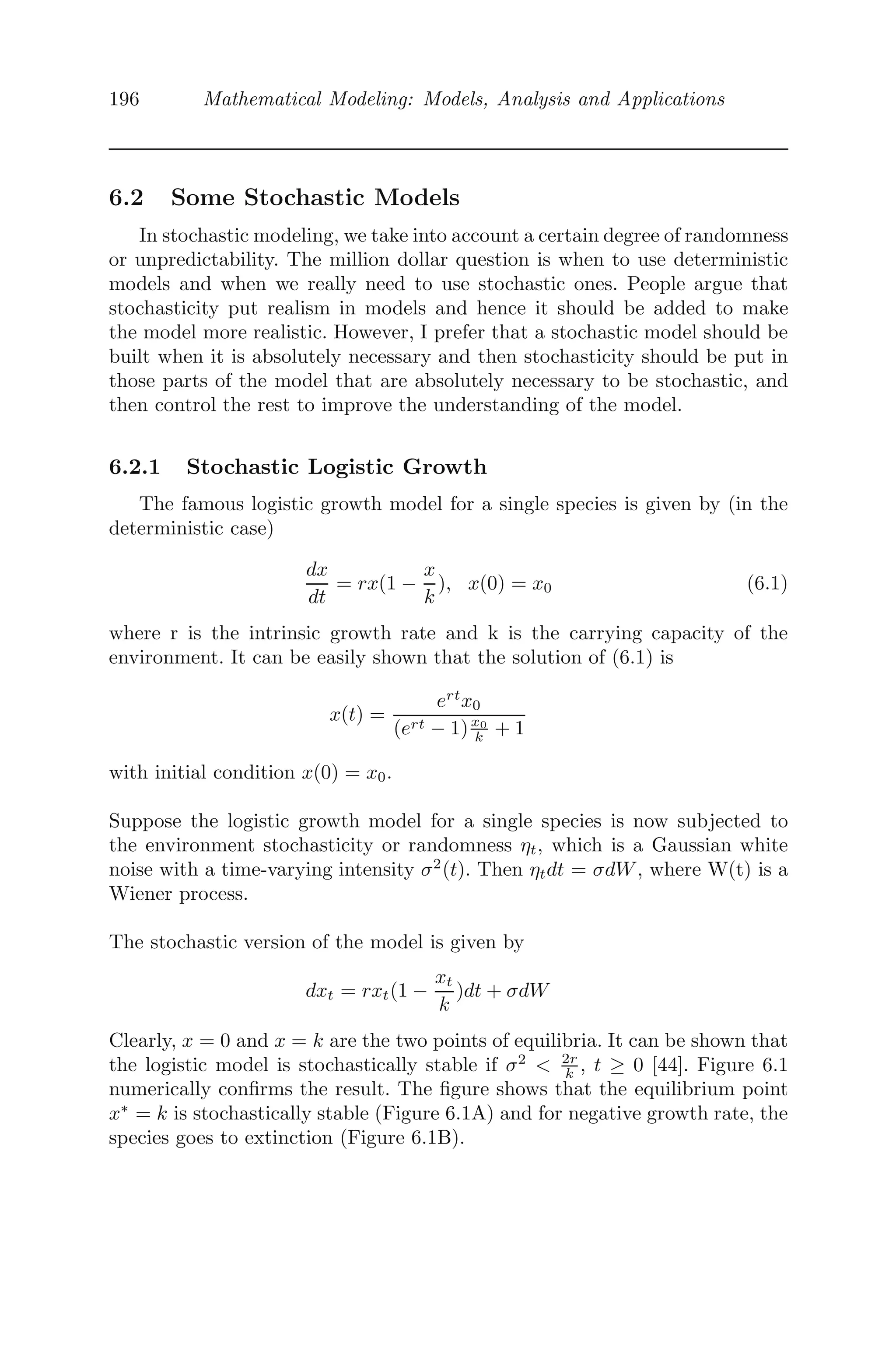
![Chapter 5
Modeling with Delay Differential
Equations
5.1 Introduction ............................................................... 153
5.2 Different Models Using Delay Differential Equations ..................... 154
5.2.1 Delayed Protein Degradation ..................................... 154
5.2.2 Football Team Performance Model ............................... 155
5.2.3 Breathing Model .................................................. 156
5.2.4 Housefly Model .................................................... 157
5.2.5 Shower Problem ................................................... 158
5.2.6 Two-Neuron System ............................................... 159
5.3 Linear Stability Analysis .................................................. 160
5.3.1 Linear Stability Criteria ........................................... 161
5.4 Miscellaneous Examples ................................................... 163
5.4.1 A Research Problem: Immunotherapy with Interleukin-2, a Study
Based on Mathematical Modeling [8] ..................................... 171
5.4.1.1 Background of the Problem ............................. 171
5.4.1.2 The Model ............................................... 173
5.4.1.3 Positivity of the Solution ................................ 175
5.4.1.4 Linear Stability Analysis with Delay .................... 175
5.4.1.5 Estimation of the Length of Delay to Preserve Stability 178
5.4.1.6 Numerical Results ....................................... 181
5.4.1.7 Conclusion ............................................... 182
5.5 Exercises .................................................................. 184
5.1 Introduction
What are Delay Differential Equations (DDE)? is the first question that
comes to mind, when you begin reading this chapter. In layman’s terms, a
DDE is a differential equation in which the derivatives of some unknown func-
tions at present time are dependent on the values of the functions at previous
times. Let us consider a general DDE of the form
dx(t)
dt
= f(t, x(t), x(t − τ))
where x(t − τ) = {x(τ) : τ ≤ t} gives the trajectory of the solution in the
past. Here, the function f is a functional operator from ×n
×C1
to n
and
x(t)∈ n
. We will not provide a detailed discussion on DDEs that fall into
the class of functional differential equations. Interested readers are advised to
consult references [45, 71, 78].
153](https://image.slidesharecdn.com/mathematicalmodelingmodelsanalysisandapplicationspdfdrive-211127122602/75/Mathematical-modeling-models-analysis-and-applications-pdf-drive-220-2048.jpg)
![154 Mathematical Modeling: Models, Analysis and Applications
Now, what about the solutions of DDEs? It is not easy to solve a DDE
analytically. To give an idea of the process, let us consider a simple DDE of
the form
dx
dt
= −x(t − τ), t 0
Initial history: x(t)=1, −τ ≤ t ≤ 0. Clearly, with τ = 0, x(t) = x(0)e−t
.
However, the presence of τ makes the situation a bit tricky. Hence, in the
interval 0 ≤ t ≤ τ, we have
dx
dt
= −x(t − τ) = −1
⇒ x(t) = x(0) +
t
0
(−1)ds = 1 − t, 0 ≤ t ≤ τ.
In τ ≤ t ≤ 2τ, we get, 0 ≤ t − τ ≤ τ and so we have,
x(t) = −x(t − τ) = −[1 − (t − τ)]
⇒ x(t) = x(τ) +
t
τ
[−{1 − (s − τ)}]ds
x(t) = 1 − t +
(t − τ)2
2
, τ ≤ t ≤ 2τ
and so on. In general, it can be shown (use mathematical induction) that
x(t) = 1 +
n
k=1
(−1)k [t − k − 1 τ]k
k!
, (n − 1)τ ≤ t ≤ nτ, n ≥ 1
The above method is known as a procedure of steps. One can use MATLAB
DDE 23 to obtain numerical solutions of the DDEs.
5.2 Different Models Using Delay Differential Equations
5.2.1 Delayed Protein Degradation
Let P(t) be the concentration of proteins at any time t in a system, then
the production of proteins at any time is given by [12]
dP(t)
dt
= α − βP(t) − γP(t − τ),](https://image.slidesharecdn.com/mathematicalmodelingmodelsanalysisandapplicationspdfdrive-211127122602/75/Mathematical-modeling-models-analysis-and-applications-pdf-drive-221-2048.jpg)
![Modeling with Delay Differential Equations 155
where α is the constant rate of protein production, β is the rate of non-
delayed protein degradation and γ is the rate of delayed protein degradation.
The discrete time delay τ is due to the fact that the protein degradation
machine degrades the protein after a time τ after initiation. Figure 5.1 shows
the degradation of protein for various parameter values, obtained from [12].
0 50 100 150 200
80
90
100
110
120
130
140
150
Time
Protein
Concentration
P(t)
0 50 100 150 200
20
30
40
50
60
70
80
Time
A B
FIGURE 5.1: The delay induced protein degradation. Part A shows a protein
delay with parameter values α = 40, β = 0.3, γ = 0.1, τ = 20 and initial
history 150. Part B shows an oscillatory behavior of protein degradation with
parameter values α = 100, β = 1.1, γ = 1, τ = 10 and initial history 20.
5.2.2 Football Team Performance Model
R.B. Banks [9] proposed a delay-induced mathematical model to analyze
the performance of a National Football League (NFL) football team during
the last 40 years. The proposed model is
dU
dt
= b
1
2
− U(t − z)
where U(t) is the fraction of games won by an NFL team during one season
and it lies between 0 and 1, and b is the growth rate. The computational
formula for U(t) is given by
U(t) =
1 × no. of games won + 1
2 × no. of games tied + 0 × no. of games lost
Total no. of games](https://image.slidesharecdn.com/mathematicalmodelingmodelsanalysisandapplicationspdfdrive-211127122602/75/Mathematical-modeling-models-analysis-and-applications-pdf-drive-222-2048.jpg)
![156 Mathematical Modeling: Models, Analysis and Applications
Basically, the proposed model says that at the present time, the rate of change
of U is proportional to the difference between U = 1
2 (average values) and the
values of U at some previous time t − τ. Banks [9] concluded from his model
that the time delay τ plays an important role in the ups and downs of a
football team and it experiences a simple periodicity, which is evident from
Figure 5.2.
1960 1965 1970 1975 1980 1985 1990
0
0.1
0.2
0.3
0.4
0.5
0.6
0.7
t (years)
U(t)
FIGURE 5.2: The performance of an NFL team from 1960 to 1992, with pa-
rameter values b = 0.785, τ = 2 years and initial history 0.4. The performance
of the team shows a cyclic behavior, which matches with data [9].
5.2.3 Breathing Model
The arterial carbon dioxide level controls our rate of breathing. A mathe-
matical model was first developed by Mackey and Glass [42], where they as-
sumed that carbon dioxide is produced at a constant rate λ due to metabolic
activity and its removal from the bloodstream is proportional to both the
current carbon dioxide concentration and to ventilation. Ventilation, which is
the volume of gas exchanged by the lungs per unit of time, is controlled by
the carbon dioxide level in the blood. The process is complex and involves
detection of carbon dioxide levels by receptors in the brain stem. This car-
bon dioxide detection and its subsequent adjustment to ventilation is not an
instantaneous process; there is a time lag due to the fact that the blood trans-
port from the lungs to the heart and then back to the brain requires time [65].
Thus, if C is the concentration of the carbon dioxide, then the rate of change
of concentration of carbon dioxide due to breathing is given by
dC(t)
dt
= λ − αVmaxC(t)V̇ (t − τ)
where V̇ (t) is the rate of ventilation and is assumed to follow the Hill function,
that is V̇ (t) = (C(t))n
θn+(C(t))n ; Vmax, θ, n and α are constants. Thus, the rate of](https://image.slidesharecdn.com/mathematicalmodelingmodelsanalysisandapplicationspdfdrive-211127122602/75/Mathematical-modeling-models-analysis-and-applications-pdf-drive-223-2048.jpg)
![Modeling with Delay Differential Equations 157
change of concentration of carbon dioxide is given by
dC(t)
dt
= λ − αVmaxC(t)
(C(t − τ))n
θn + (C(t − τ))n
Figure 5.3 shows the oscillatory solution of the Mackey-Glass equation, rep-
resenting the carbon dioxide content.
0 0.5 1 1.5 2 2.5 3 3.5 4 4.5 5
0
0.2
0.4
0.6
0.8
1
1.2
1.4
1.6
1.8
Time
Carbondioxide
Content
C(t)
FIGURE 5.3: The oscillatory behavior of carbon dioxide content. The pa-
rameter values, obtained from [65], are λ = 6, α = 0.3, Vm = 0.1, θ = 1, n = 3,
initial history 1.2 and τ = 0.25.
5.2.4 Housefly Model
Taylor and Sokal [128] proposed a model to describe the behavior of the
adult housefly Musca domestic in laboratory conditions. To capture the dy-
namics of the housefly, the model is represented using a delay differential
equation as
dH
dt
= −d1H(t) + βH(t − τ)[k − βMH(t − τ)]
Here, H(t) represents the number of adult houseflies at any time t, d1 is the
natural death, τ(0) is the discrete time delay, which is the time from laying
eggs until their emerging from the pupal case (oviposition and eclosion of
adults), β is the number of eggs laid per adult, and assuming the number of
eggs laid is proportional to the number of adults, the number of new eggs
at time t − τ would be βH(t − τ). The term k − βMH(t − τ) gives the
egg-to-adult survival rate, k and M being the maximum egg-adult survival
rate and reduction in survival for each egg respectively. Figure 5.4 shows
periodic solution as observed in the behavior of adult houseflies in laboratory](https://image.slidesharecdn.com/mathematicalmodelingmodelsanalysisandapplicationspdfdrive-211127122602/75/Mathematical-modeling-models-analysis-and-applications-pdf-drive-224-2048.jpg)
![158 Mathematical Modeling: Models, Analysis and Applications
conditions [128]. Please note that for τ = 0, the housefly population follows a
logistic growth.
0 50 100 150 200 250 300
0
200
400
600
800
1000
1200
1400
t−Time
Number
of
Adult
Houseflies
H(t)
τ = 5
τ = 0
FIGURE 5.4: The oscillatory behavior of the adult houseflies. The parameter
values, obtained from [114, 128] are d1 = 0.147, β = 1.81, k = 0.5107, M =
0.000226, initial history 100 and τ = 5. The system follows a logistic growth
for τ = 0.
5.2.5 Shower Problem
People enjoy showering, especially when they are able to control the water
temperature. The dynamics of human behavior while taking a shower when
the water temperature is not comfortable, is quite interesting. A simple DDE
model is proposed to capture such dynamics. We assume that the speed of
water is constant (uniform flow) from the faucet to shower head, which takes
the time τ seconds (say). Let T (t) denote the temperature of water at the
faucet at time t, then the temperature evolution is given by
dT
dt
= −α[T (t − τ) − Td]
where Td is the desired temperature and α gives the measure of a person’s
reaction due to wrong water temperature. One type of person might prefer a
low value of α whereas another type of person would choose a higher value of α.
For α = 0.5, the temperature of the water goes to 40 ◦
C, which is comfortable
to the body and the person remains calm (Figure 5.5A). For α = 0.8 and 1.1,
after initial fluctuation, the temperature of the water goes to 40 ◦
C. A person](https://image.slidesharecdn.com/mathematicalmodelingmodelsanalysisandapplicationspdfdrive-211127122602/75/Mathematical-modeling-models-analysis-and-applications-pdf-drive-225-2048.jpg)
![Modeling with Delay Differential Equations 159
0 5 10 15
0
5
10
15
20
25
30
35
40
45
Temperature
of
the
water
T(t)
0 5 10 15
0
10
20
30
40
50
60
0 5 10 15
0
10
20
30
40
50
60
70
0 5 10 15
−10
0
10
20
30
40
50
60
70
80
0 5 10 15
−200
−150
−100
−50
0
50
100
150
200
t−Time
0 5 10 15
−1.5
−1
−0.5
0
0.5
1
1.5
2
2.5
x 10
4 F
E
D
C
B
A
α = 0.5
α = 0.8 α = 1.1
α = 1.55 α = 1.8 α = 2.8
FIGURE 5.5: Varied temperatures of water for different values of α. The
parameter values are Td = 40 ◦
C, τ = 1, initial history = 0.5 and α =
0.5, 0.8, 1.1, 1.55, 1.8 and 2.8 respectively.
may show initial discomfort with the start of the shower (Figure 5.5B,C).
One person will prefer the value of α = 1.55 while showering (a bathroom
singer?), which shows cyclic behavior (Figure 5.5D). For α = 1.8 and 2.8,
the temperature of the water is erratic and unpleasant while taking shower
(Figure 5.5E,F).
5.2.6 Two-Neuron System
A two-neuron system of self-existing neurons is given by [7, 132]
du1
dt
= −u1(t) + a1tanh[u2(t − τ21)]
du2
dt
= −u2(t) + a2tanh[u1(t − τ12)]
where u1(t) and u2(t) are the activities of the first and second neurons re-
spectively, τ21 is the delay in signal transmission between the second neuron
and the first neuron (τ12 can be explained in similar manner) and ai’s (i
= 1,2) are the weighing of the connection between the neurons. By taking
a1 = 2, a2 = −1.5, τ12 = 0.2, τ21 = 0.5 such that τ12 + τ21 0.8, numerically
it has been shown that the model is asymptotically stable about the origin
(see Figure 5.6 A1,A2,A3). For τ12 = 0.4, τ21 = 0.6 such that τ12 + τ21 0.8,
a periodic solution bifurcates from the origin; that bifurcation is supercritical](https://image.slidesharecdn.com/mathematicalmodelingmodelsanalysisandapplicationspdfdrive-211127122602/75/Mathematical-modeling-models-analysis-and-applications-pdf-drive-226-2048.jpg)
![160 Mathematical Modeling: Models, Analysis and Applications
and the bifurcating periodic solution is orbitally asymptotically stable (see
Figure 5.6 B1,B2,B3). To learn more about the analytical calculations and
restrictions on τ12 and τ21, interested readers may go to [132], where it is
discussed in detail.
0 20 40 60 80 100
−0.3
−0.2
−0.1
0
0.1
0.2
0.3
0.4
t−Time
u
1
(t)
0 20 40 60 80 100
−0.4
−0.3
−0.2
−0.1
0
0.1
0.2
t−Time
u
2
(t)
−0.3 −0.2 −0.1 0 0.1 0.2 0.3 0.4
−0.4
−0.2
0
0.2
0.4
u
1
(t)
u
2
(t)
0 20 40 60 80 100
−0.5
0
0.5
t−Time
u
1
(t)
0 20 40 60 80 100
−0.5
0
0.5
t−Time
u
2
(t)
−0.5 0 0.5
−0.5
0
0.5
u 1
(t)
u
2
(t)
A1
A2
A3 B3
B2
B1
FIGURE 5.6: The activities of two self-exiting neurons. The parameter val-
ues, obtained from [114], are a1 = 2, a2 = −1.5 and initial history is (0.1,0.3).
Parts 5.6A1,A2,A3 show that the system is asymptotically stable about the ori-
gin for τ12 = 0.2, τ21 = 0.5 such that τ12 + τ21 0.8. For τ12 = 0.4, τ21 = 0.6
such that τ12 +τ21 0.8., Parts 5.6B1,B2,B3 illustrate that a periodic solution
bifurcates from the origin, which is orbitally asymptotically stable.
5.3 Linear Stability Analysis
We consider the delay differential equation
dx
dt
= −x(t − 1) (5.1)
and discuss its stability. Clearly, x = 0 is the only steady state solution. Since
the equation is linear, we try the exponential solution x = ceλt
, (c = 0) which](https://image.slidesharecdn.com/mathematicalmodelingmodelsanalysisandapplicationspdfdrive-211127122602/75/Mathematical-modeling-models-analysis-and-applications-pdf-drive-227-2048.jpg)
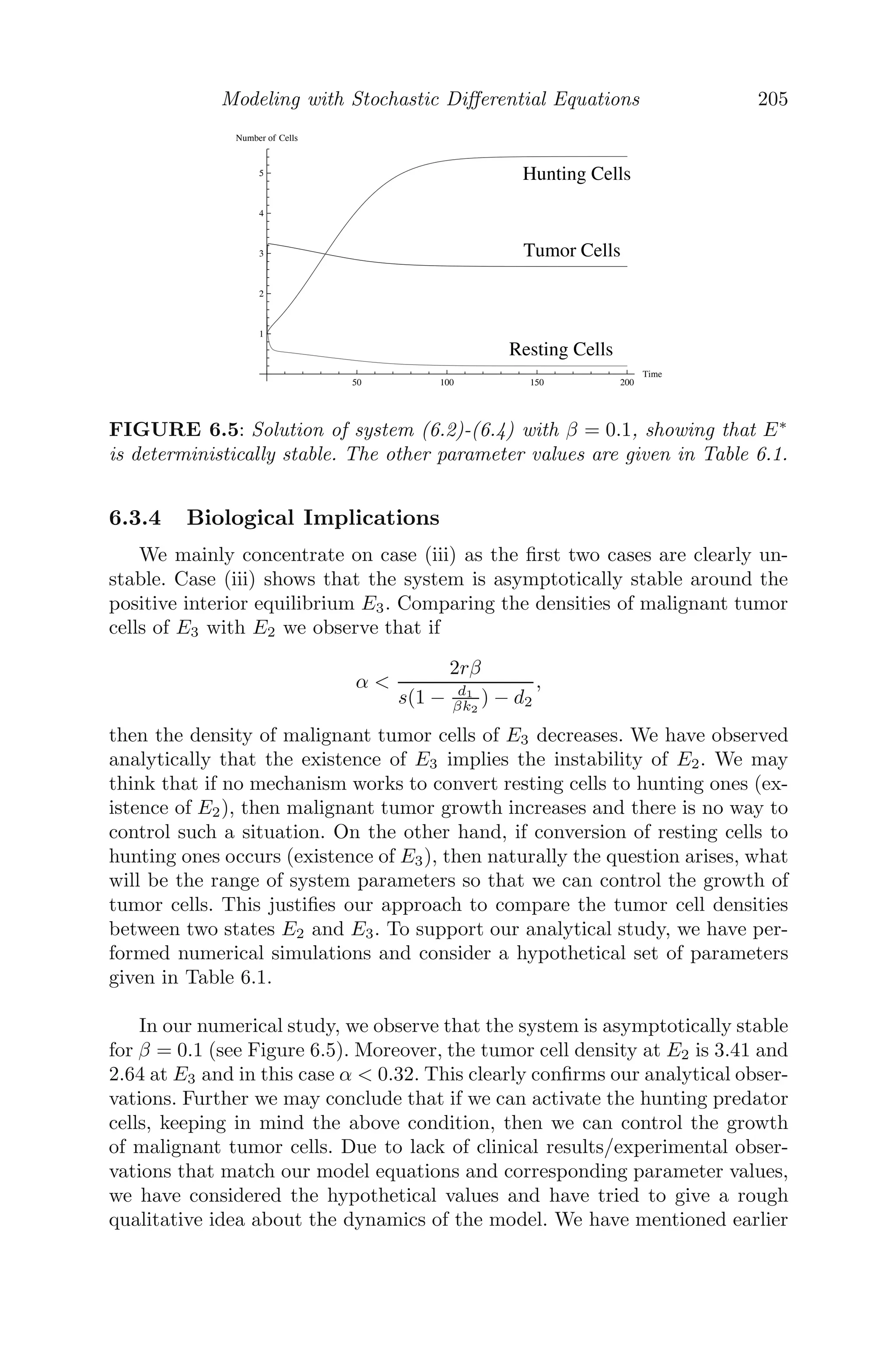
![162 Mathematical Modeling: Models, Analysis and Applications
Then [123],
(i) If A + B 0, then x = 0 is unstable.
(ii) If A + B 0 and B ≥ A, then x = 0 is asymptotically stable.
(iii) If A + B 0 and B A, then there exists τ∗
0 such that x = 0
is asymptotically stable for 0 τ τ∗
and unstable for τ τ∗
. Also, there
exists a pair of imaginary roots at τ = τ∗
= cos−1 −A/B
B2−A2 .
Theorem 5.3.1.2 Consider a linear autonomous delay differential equation
of the form
dx
dt
+ a1x(t − τ1) + a2x(t − τ2) = 0 (5.4)
where a1, a2, τ1, τ2 ∈ [0 , ∞). The transcendental characteristic equation of
(5.4) can be obtained by substituting the ansatz x(t) = ceλt
in (5.4), which
results in
λ + a1e−λτ1
+ a2e−λτ2
= 0 (5.5)
where λ is a complex number.
(i) Let a2 = 0 and a1, τ1 ∈ (0, ∞). A necessary and sufficient condition for
all roots of λ + a1e−λτ1
= 0 to have negative real parts is 0 a1τ1 π
2 .
(ii) Let a1, a2, τ1, τ2 ∈ (0, ∞). A sufficient condition for all roots of (5.5) to
have negative real parts is a1τ1 + a2τ2 1 and a necessary condition for the
same is a1τ1 + a2τ2 π/2.
Theorem 5.3.1.3 Consider the characteristic equation of the form
P(λ) + Q(λ)e−λτ
= 0
where P and Q are polynomials with real coefficients and τ( 0) is the discrete
time delay. Let,
(i) P(λ) = 0 in the region P(λ) ≥ 0,
(ii) Q(ib) |P(ib)|, 0 ≤ b ∞,
(iii) lim|λ|→∞, Re(λ)≥0 |Q(λ)
P (λ) | = 0, then, Real (λ) 0 for every root λ and all
τ ≥ 0.
Corollary: Suppose P(λ) has leading coefficient one and let Q(λ) = c
(constant). If
(i) all roots of the polynomial P(λ) are real and negative and |P(0)| |c| or
(ii) P(λ) = λ2
+ aλ + b, a, b 0 and either
(A1) b |c| and a2
≥ 2b or (A2) a
√
4b − a2 2|c| and a2
2b,
then Re(λ) 0 for every root λ and all τ ≥ 0.](https://image.slidesharecdn.com/mathematicalmodelingmodelsanalysisandapplicationspdfdrive-211127122602/75/Mathematical-modeling-models-analysis-and-applications-pdf-drive-229-2048.jpg)
![Modeling with Delay Differential Equations 163
5.4 Miscellaneous Examples
Problem 5.4.1 Mackey-Glass Model: Mackey and Glass [42] proposed a
delayed model for the growth of density of blood cells
dB
dt
=
λαm
B(t − τ)
αm + Bm(t − τ)
− βB(t)
where λ, α, m, β and τ are positive constants.
(i) Explain the model in terms of the system parameters.
(ii) Solve the system numerically by taking λ = 0.2, α = 0.1, β = 0.1, m =
10, τ = 4 and initial history 0.1 and represent it graphically. What kind of
behavior is observed?
(iii) Obtain graphs by taking the discrete time delays τ = 6, 15, 30. What
changes do you observe in the dynamics of the system?
Solution: (i) B(t) is the density of blood cells in the circulating blood, λ
is the rate at which it is produced, α is the dissociation constant and β is the
rate of natural death of the cells. There is a release of mature cells from the
bone marrow into the blood due to the reduction in cells in the bloodstream
but there is a delay of approximately 6 days. Here, τ is the delay between
the production of blood cells in the bone marrow and its release into the
bloodstream. It is also assumed that the density of blood cells that enter the
bloodstream depends on cell density at an earlier time B(t − τ).
(ii) The numerical solution of the model shows that the density of blood
cells follows a damped oscillation for τ = 4 (see Figure 5.7A).
(iii) As the value of τ (=6) is increased, the system exhibits bifurcating
periodic solutions (Figure 5.7B). The solution becomes aperiodic for further
increase in τ = 15 (Figure 5.7C) and chaotic for τ = 30 (Figure 5.7D).
Problem 5.4.2 A second order delayed feedback system is given by [123]
d2
x
dt2
+
dx
dt
+ 3x = −
√
5 tanh[x(t − τ)]
Simulate the model numerically for τ = 0.5, 0.555, 0.6, 2, 3.5 and 5 and com-
ment on the dynamics of the system.
Solution: The second order delayed feedback system is first expressed as
a system of first order delayed differential equations
dx
dt
= y1
dy1
dt
= −y1 − 3x −
√
5 tanh[x(t − τ)]](https://image.slidesharecdn.com/mathematicalmodelingmodelsanalysisandapplicationspdfdrive-211127122602/75/Mathematical-modeling-models-analysis-and-applications-pdf-drive-230-2048.jpg)
![164 Mathematical Modeling: Models, Analysis and Applications
0 100 200 300 400 500
0
0.2
0.4
0.6
0.8
1
1.2
1.4
0 100 200 300 400 500
0
0.2
0.4
0.6
0.8
1
1.2
1.4
Density
of
Blood
Cells
B(t)
0 200 400 600 800 1000
0
0.2
0.4
0.6
0.8
1
1.2
1.4
0 200 400 600 800 1000
0
0.2
0.4
0.6
0.8
1
1.2
1.4
t−Time
A B
C D
FIGURE 5.7: The effect of delay on the density of blood cells with parameter
values λ = 0.2, α = 0.1, β = 0.1, m = 10 and initial history 0.1, obtained from
[114]. (A) This shows a damped oscillation for τ = 4. (B) As the value of delay
is increased to τ = 6, there is a cascading sequence of bifurcating periodic
solutions. (C) For further increase in delay, the solution becomes aperiodic
and (D) chaotic.
and then solved numerically for different values of τ. For τ = 0.5 and 3.5, the
system is asymptotically stable (see Figure 5.8A,E). For τ = 0.6 and 5, the
system is unstable (see Figure 5.8C,F). For τ = 0.555, the system bifurcates to
periodic solution (see Figure 5.8B) and for τ = 2.0, the system is in oscillatory
mode with high amplitude of oscillation (see Figure 5.8D).
Problem 5.4.3 Cooke proposed an epidemic model [75, 78] given by
dt
dt
= by(t − 7)[1 − y(t)] − cy(t),
where y(t) denotes the fraction of a population infected at time t.
(i) Find the equilibrium point(s) of the model and comment on their existence.
(ii) Investigate the stability of the system about the equilibrium point(s).
(iii) Simulate the model numerically for b = 2, c = 1, initial history = 0.8 and
comment on the dynamics of the system.](https://image.slidesharecdn.com/mathematicalmodelingmodelsanalysisandapplicationspdfdrive-211127122602/75/Mathematical-modeling-models-analysis-and-applications-pdf-drive-231-2048.jpg)
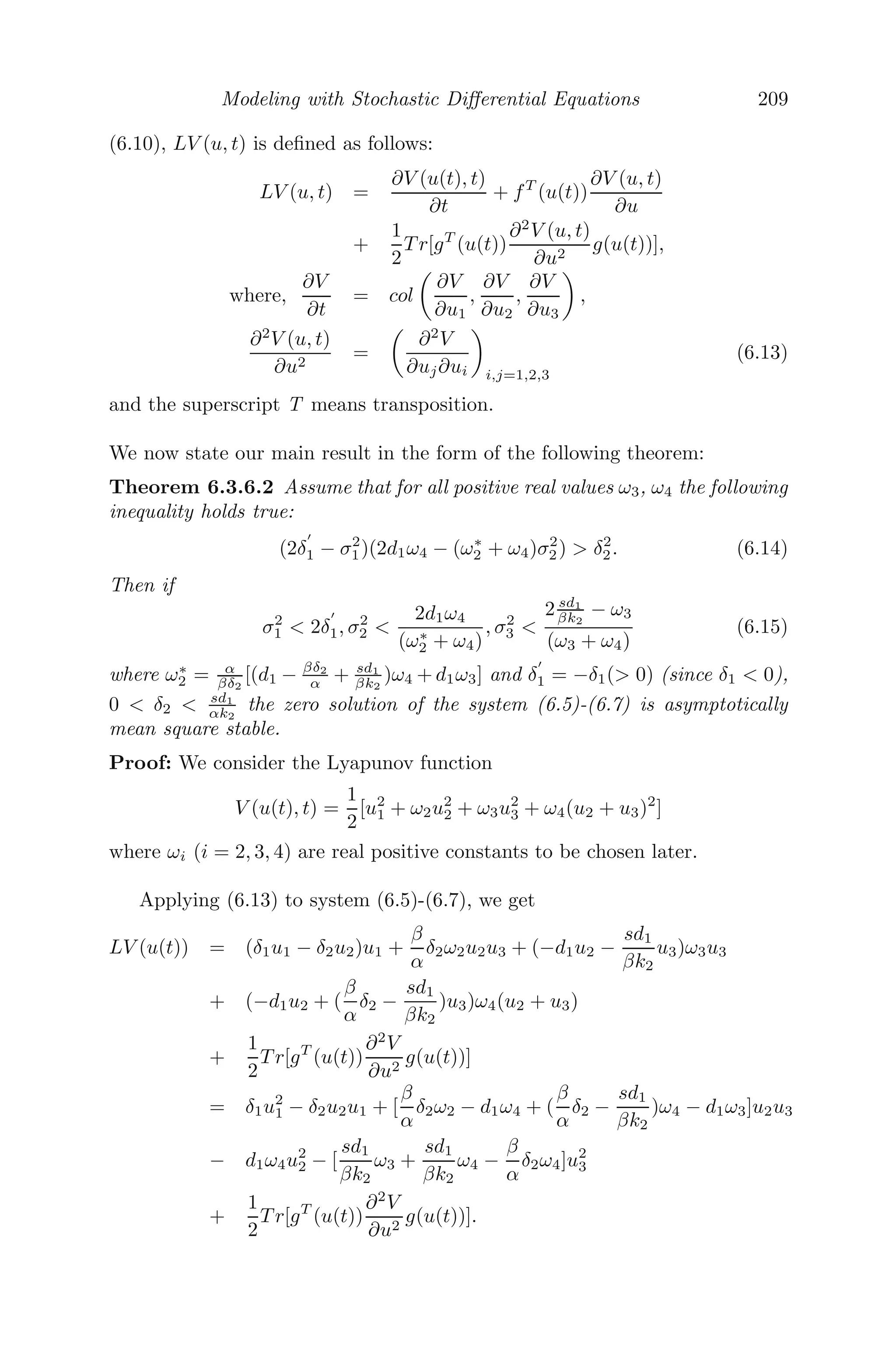
![166 Mathematical Modeling: Models, Analysis and Applications
Using Theorem 5.3.1.1, we get A + B = −(b − c) 0. The system is asymp-
totically stable about the equilibrium point y∗
= b−c
b if b c. However, if
b c, then there exists τ∗
0 such that x = 0 is asymptotically stable for
0 τ τ∗
and unstable for τ τ∗
.
(iii) Figure 5.9 shows the simulation of the model for b = 2, c = 1 and ini-
tial history = 0.8. The numerical solution agrees with the theory and the
graph shows that the system is stable and reaches the equilibrium solution
y∗
= b−c
b = 0.5 with time.
0 10 20 30 40 50 60 70 80
0.45
0.5
0.55
0.6
0.65
0.7
0.75
0.8
t−Time
Population
y(t)
FIGURE 5.9: The behavior of the population with time for b = 2, c = 1, τ = 7
and initial history 0.8.
Problem 5.4.4 Microbial Growth Model with Delay: A delayed bac-
terial growth model in a chemostat is given by (after scaling time and the
dependent variables) [28, 123]
dS(t)
dt
= 1 − S(t) −
mS(t)B(t)
a + S(t)
dB(t)
dt
= e−τ
m
S(t − τ)
a + S(t − τ)
B(t − τ) − B(t)
where S(t) is the substrate concentration (food for bacteria) and B(t) is the
biomass concentration of bacteria, m and a are positive constants and τ is the
time of cellular absorption resulting in the increase of bacterial biomass.
(i) Find the equilibrium point(s) of the model and comment on their existence.
(ii) Investigate the stability of the system about the equilibrium point(s).
(iii) Simulate the model numerically for m = 0.7, a = 2, τ = 0.1, initial history
= [2, 14] and comment on the dynamics of the system.](https://image.slidesharecdn.com/mathematicalmodelingmodelsanalysisandapplicationspdfdrive-211127122602/75/Mathematical-modeling-models-analysis-and-applications-pdf-drive-233-2048.jpg)
![Modeling with Delay Differential Equations 167
Solution: (i) The equilibrium solutions (S∗
, B∗
) are obtained by solving
1 − S∗
−
mS∗
B∗
a + S∗
= 0
e−τ
m
S∗
a + S∗
B∗
− B∗
= 0,
where (S∗
, B∗
) are (i) (1,0), washout state and (ii)
aeτ
m−eτ , [1 − aeτ
m−eτ ]e−τ
,
survival state. The washout state always exists and the survival state exists if
e−τ m
1+a 1.
(ii) For linear stability analysis, the characteristic equation is obtained as](https://image.slidesharecdn.com/mathematicalmodelingmodelsanalysisandapplicationspdfdrive-211127122602/75/Mathematical-modeling-models-analysis-and-applications-pdf-drive-234-2048.jpg)
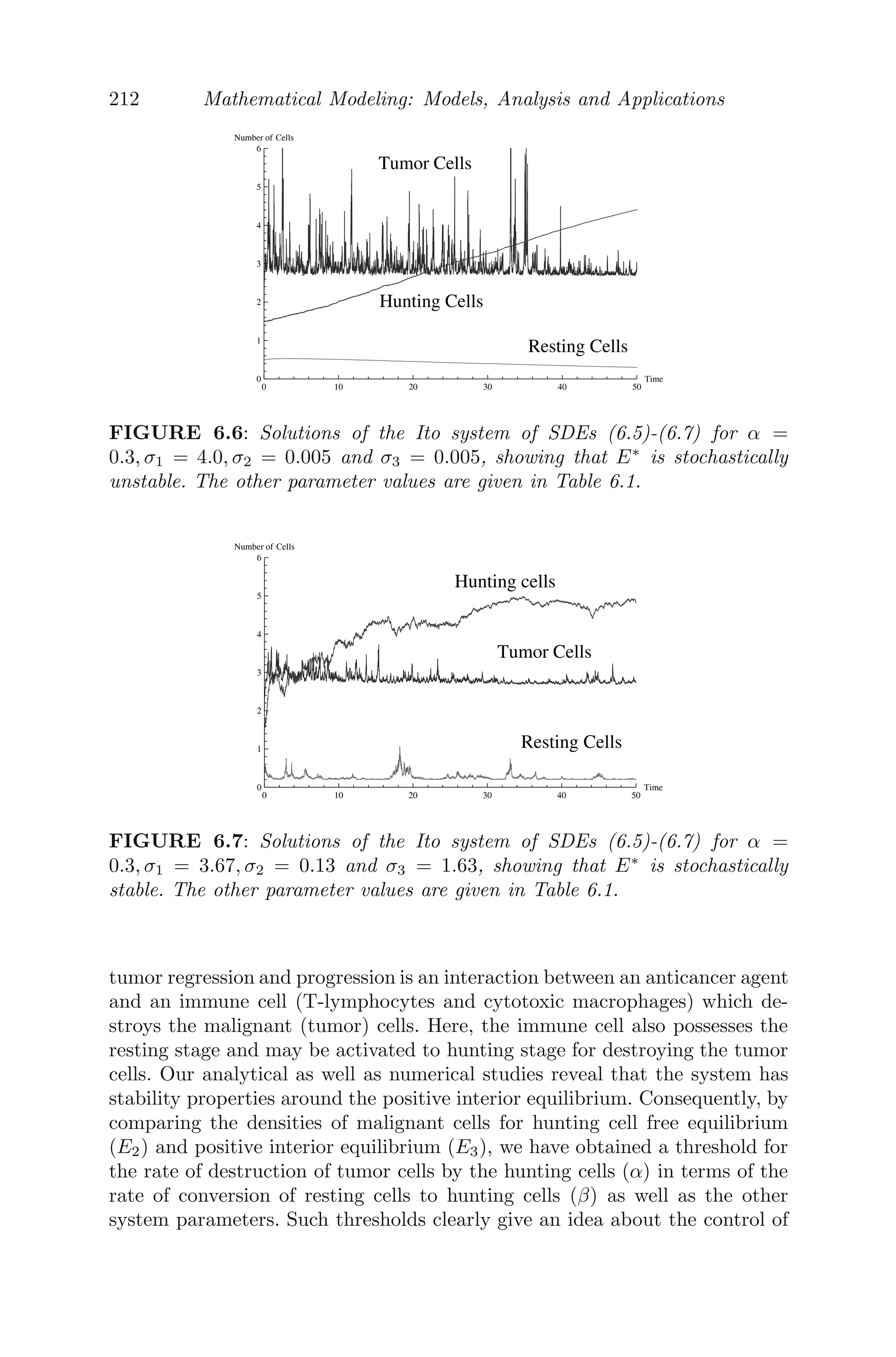
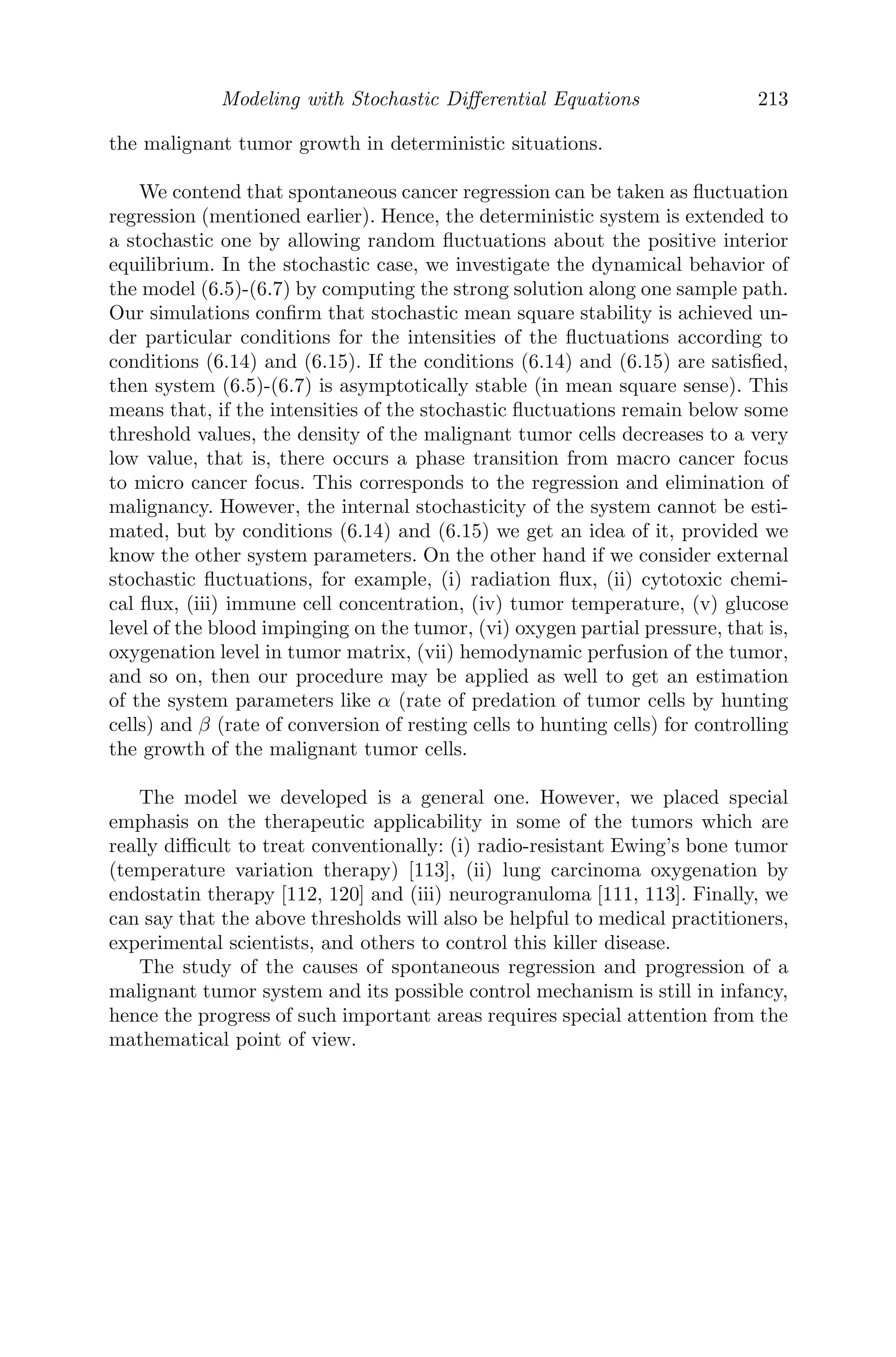
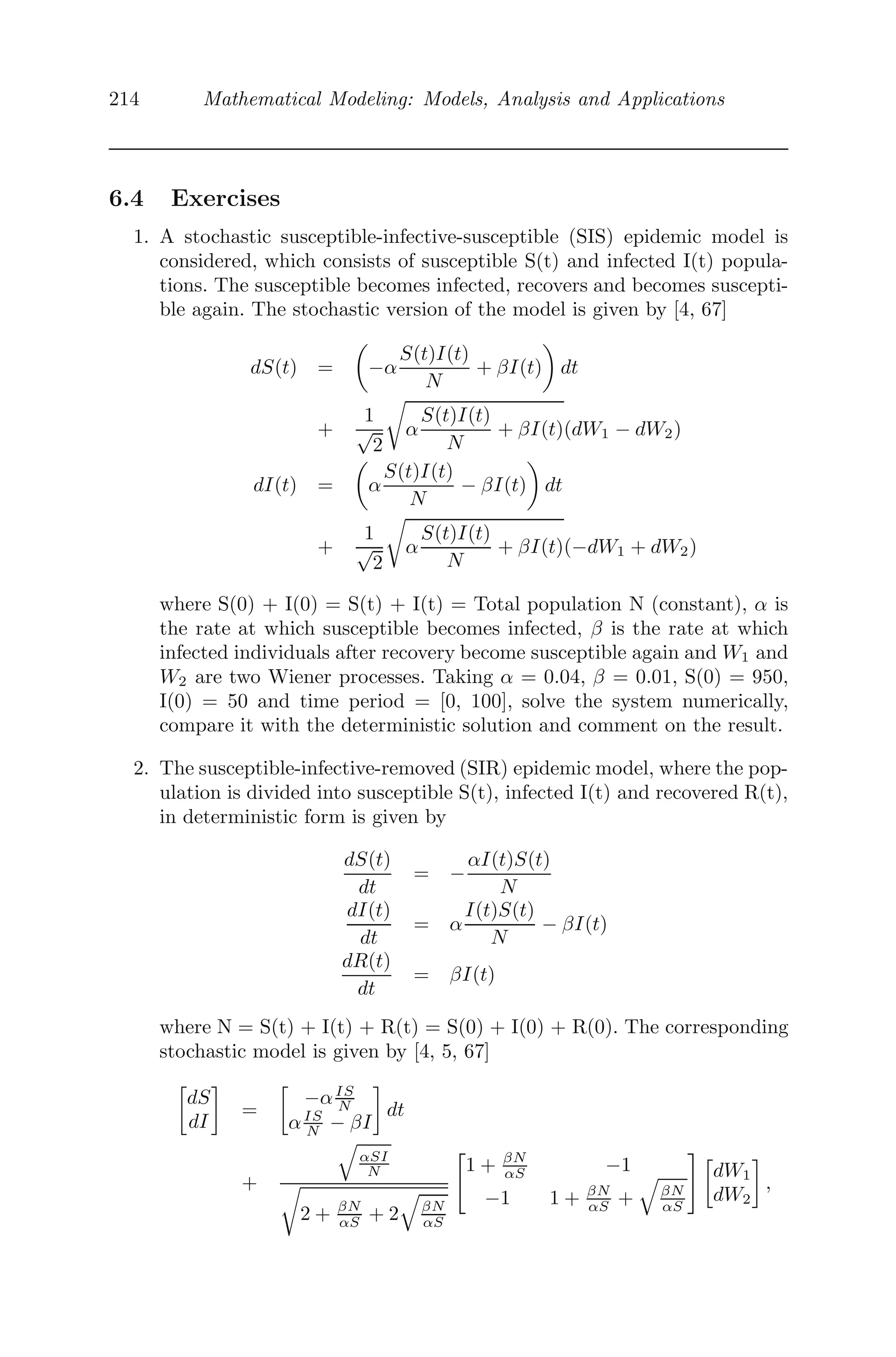
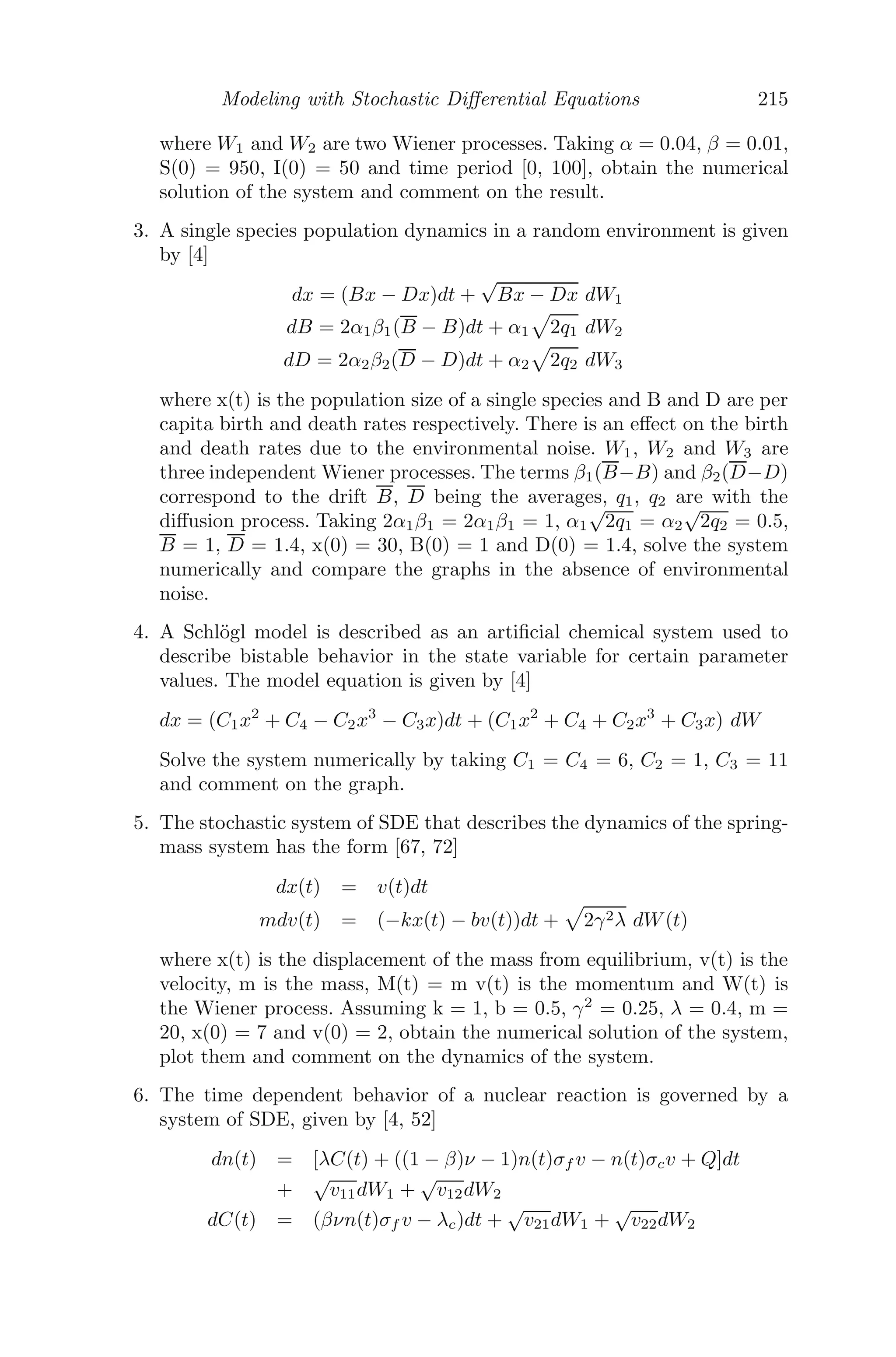
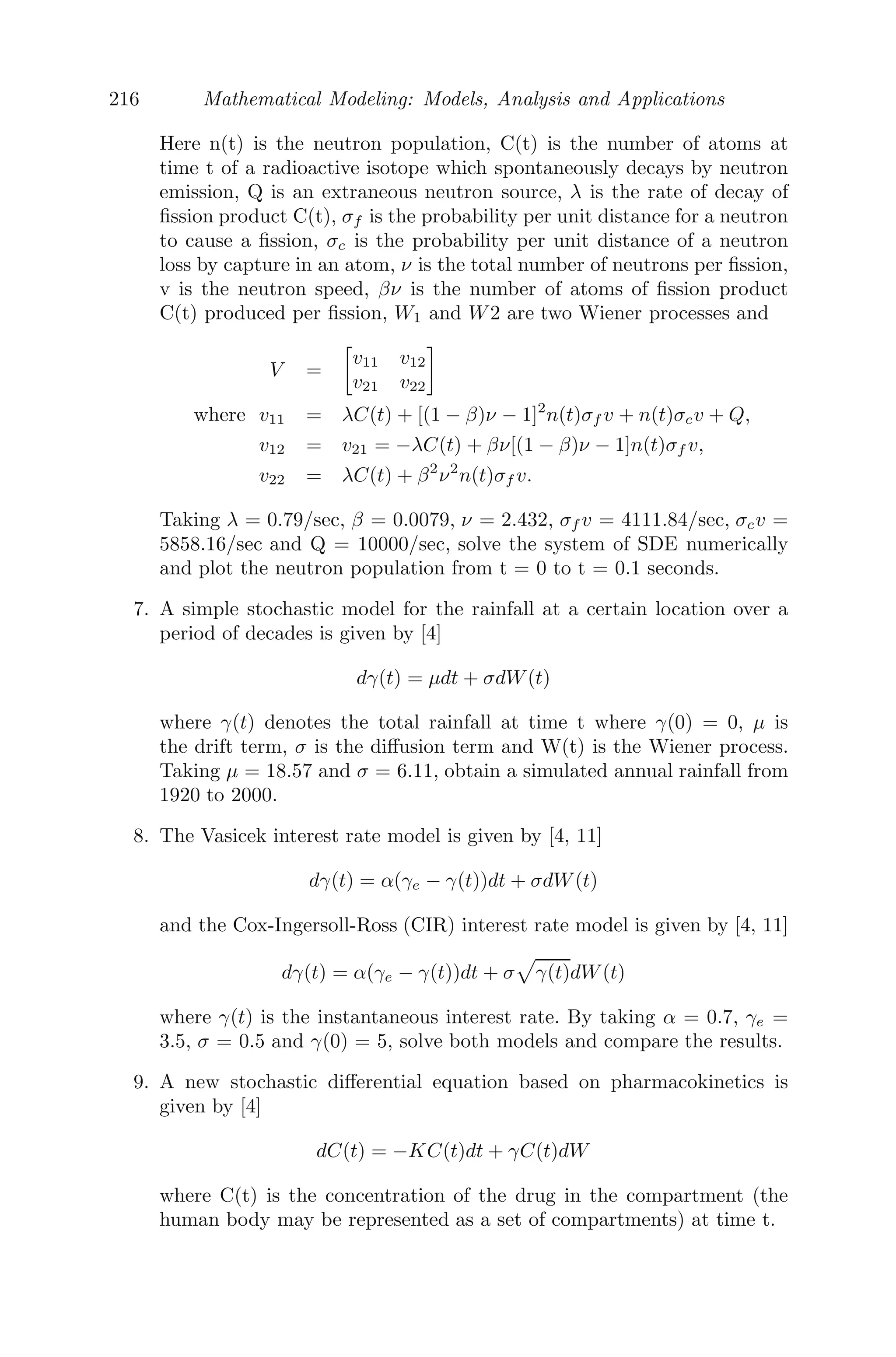
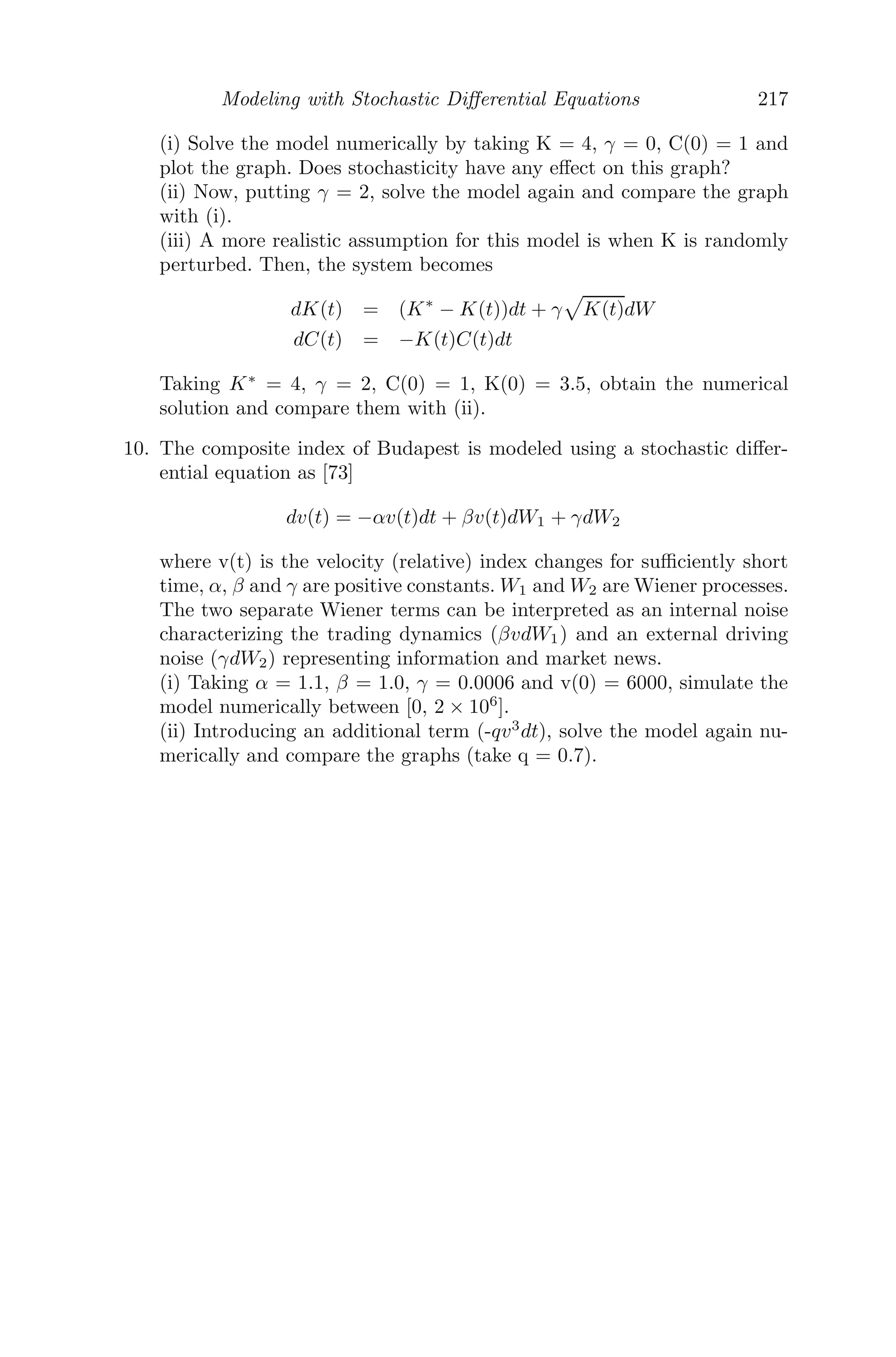

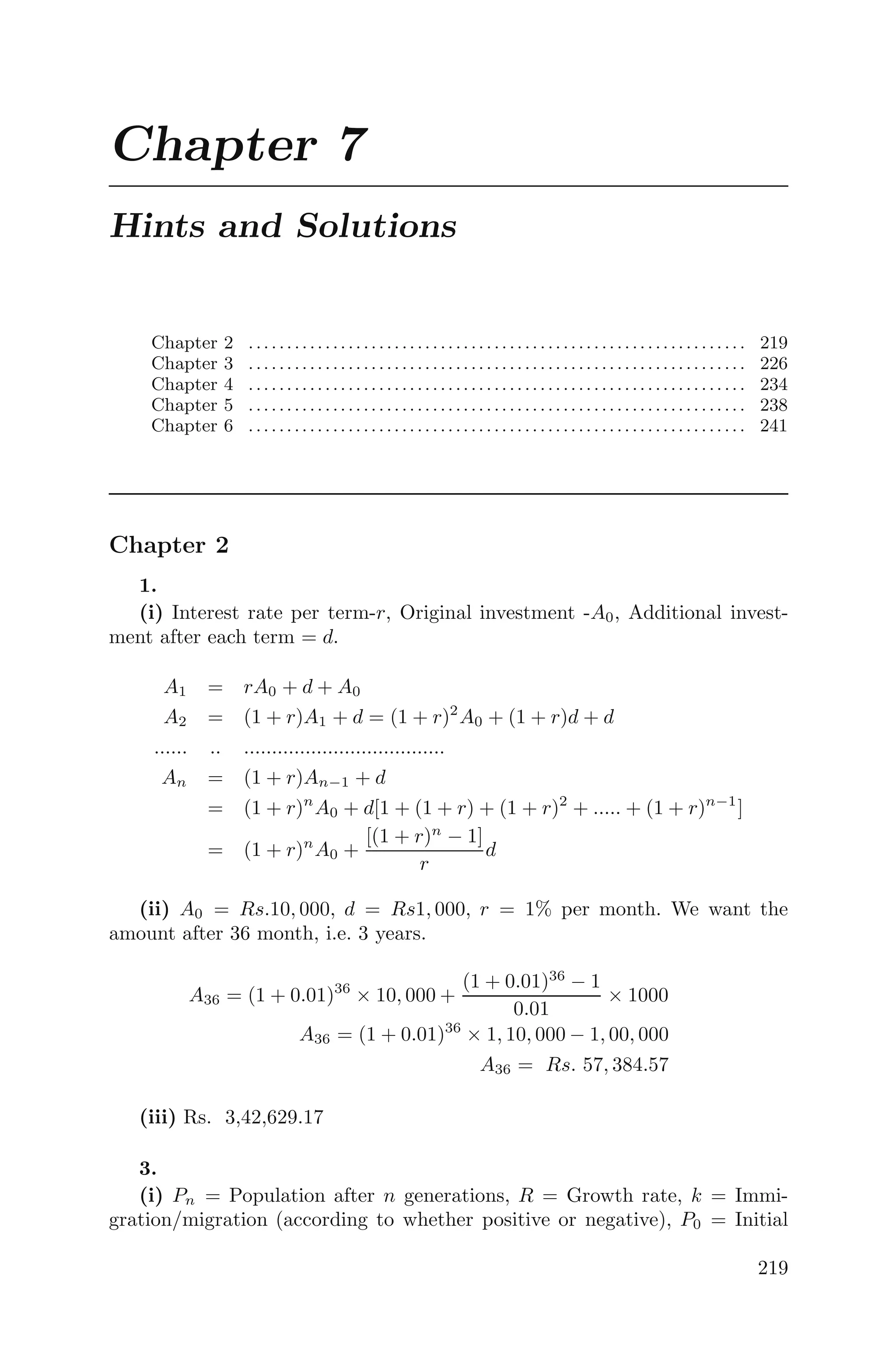
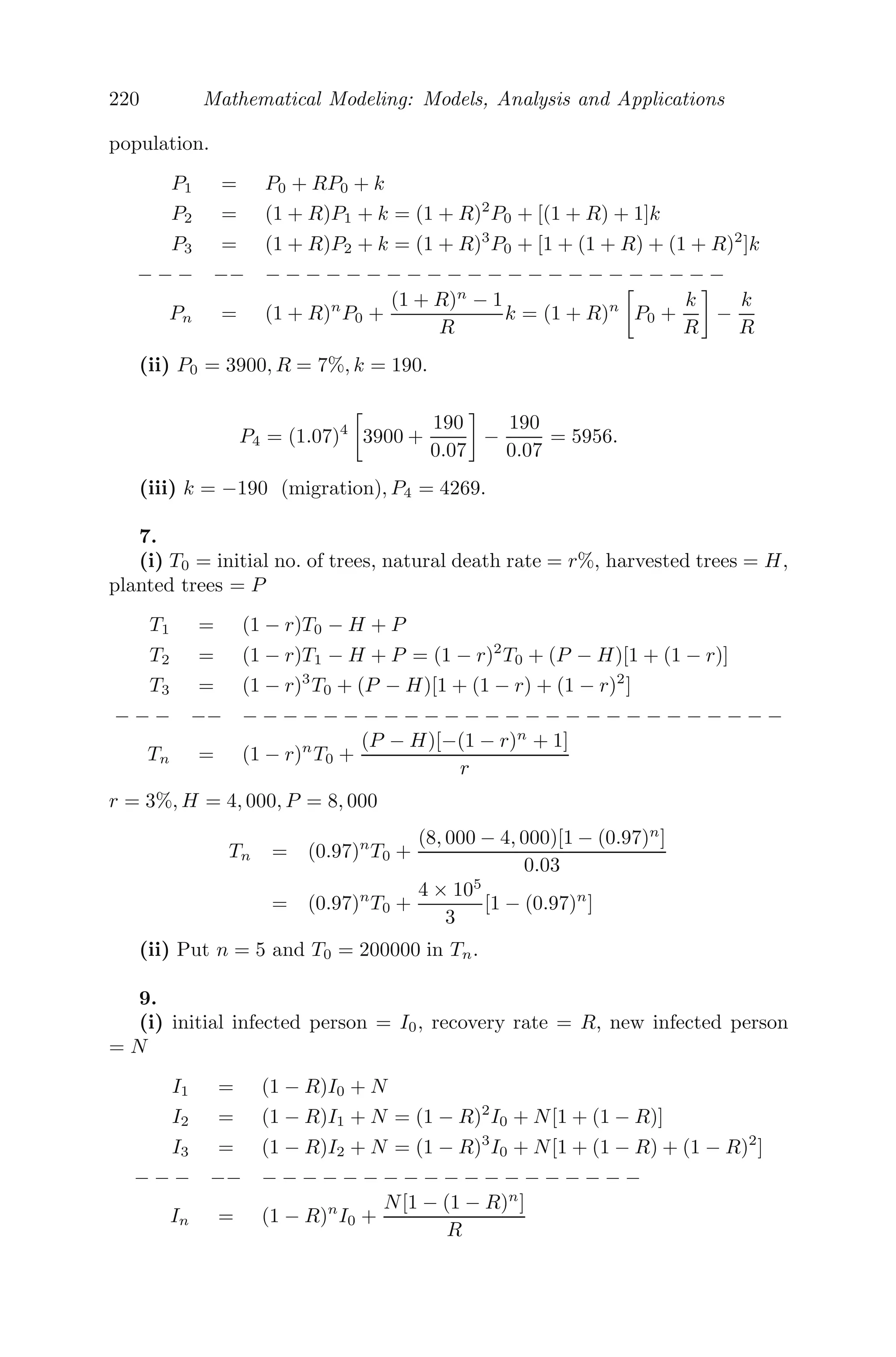
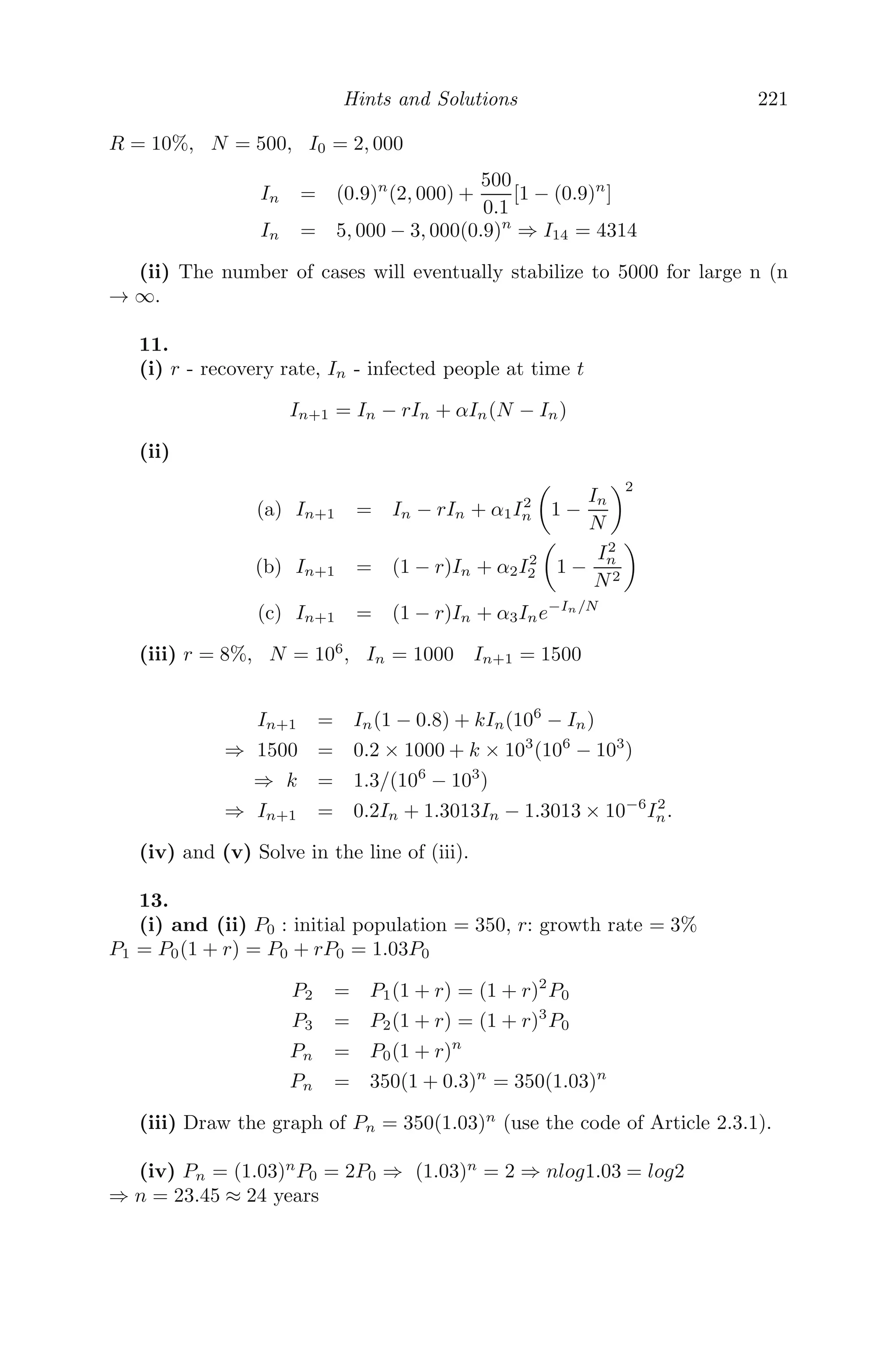
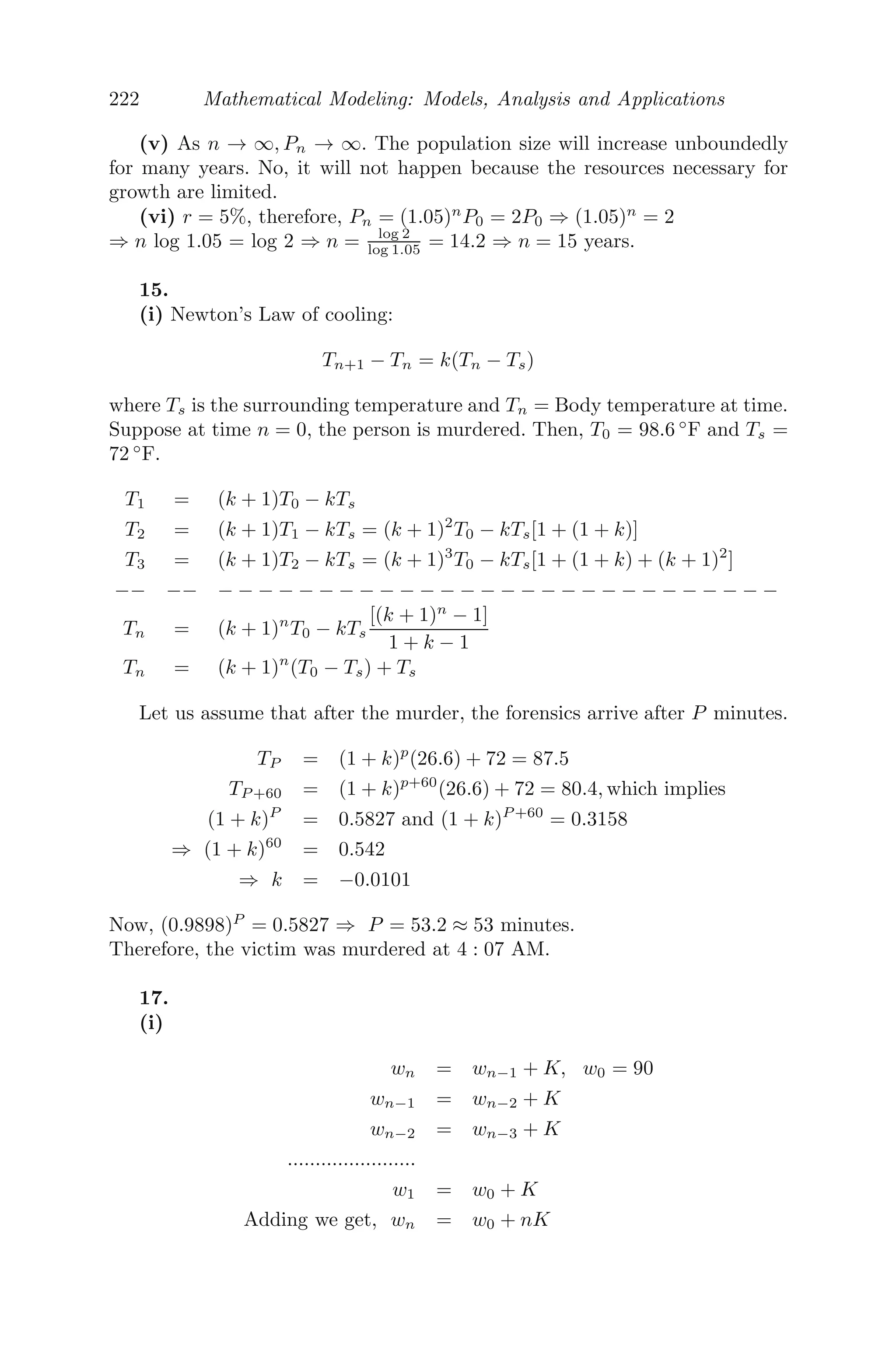
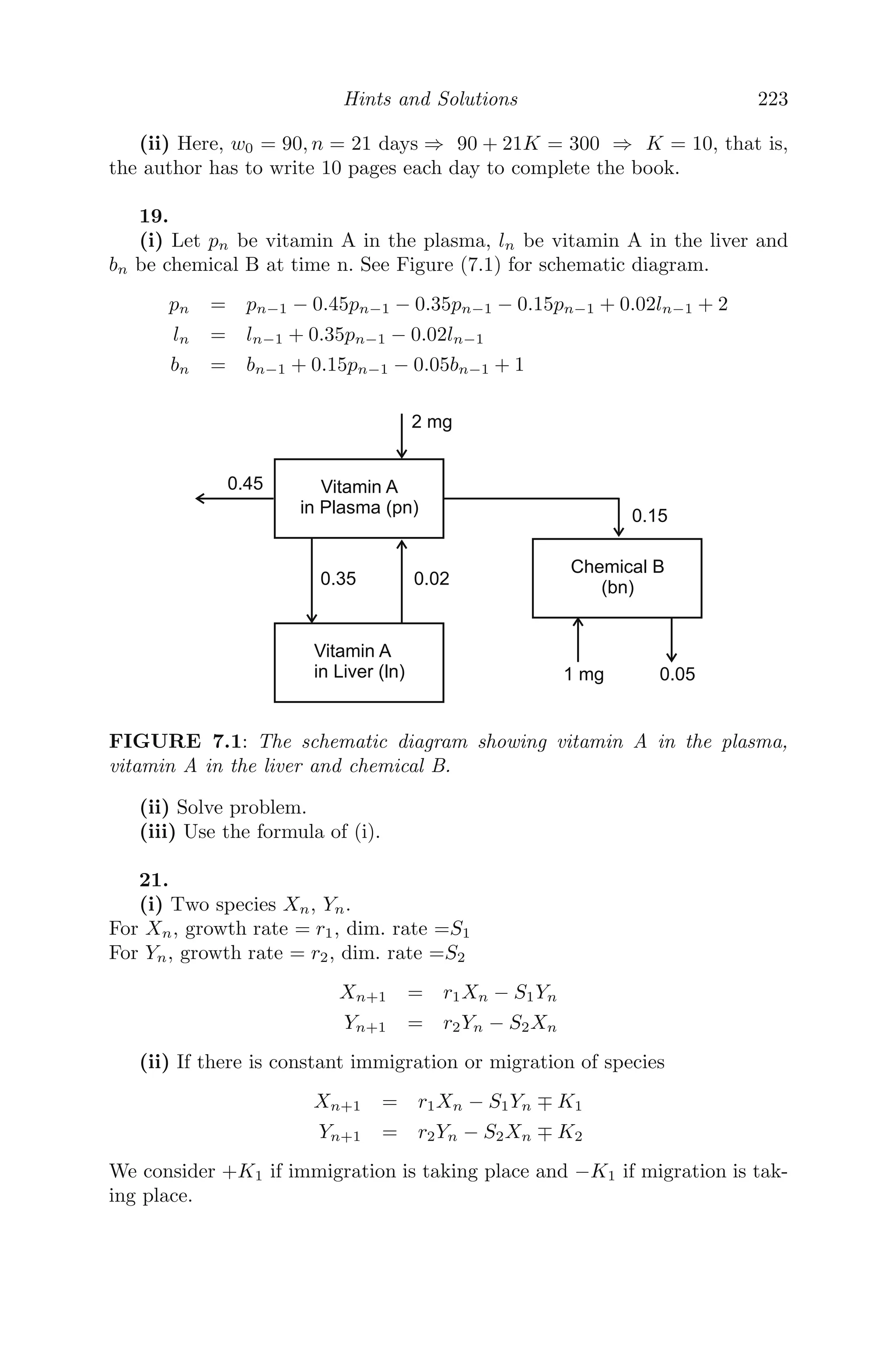

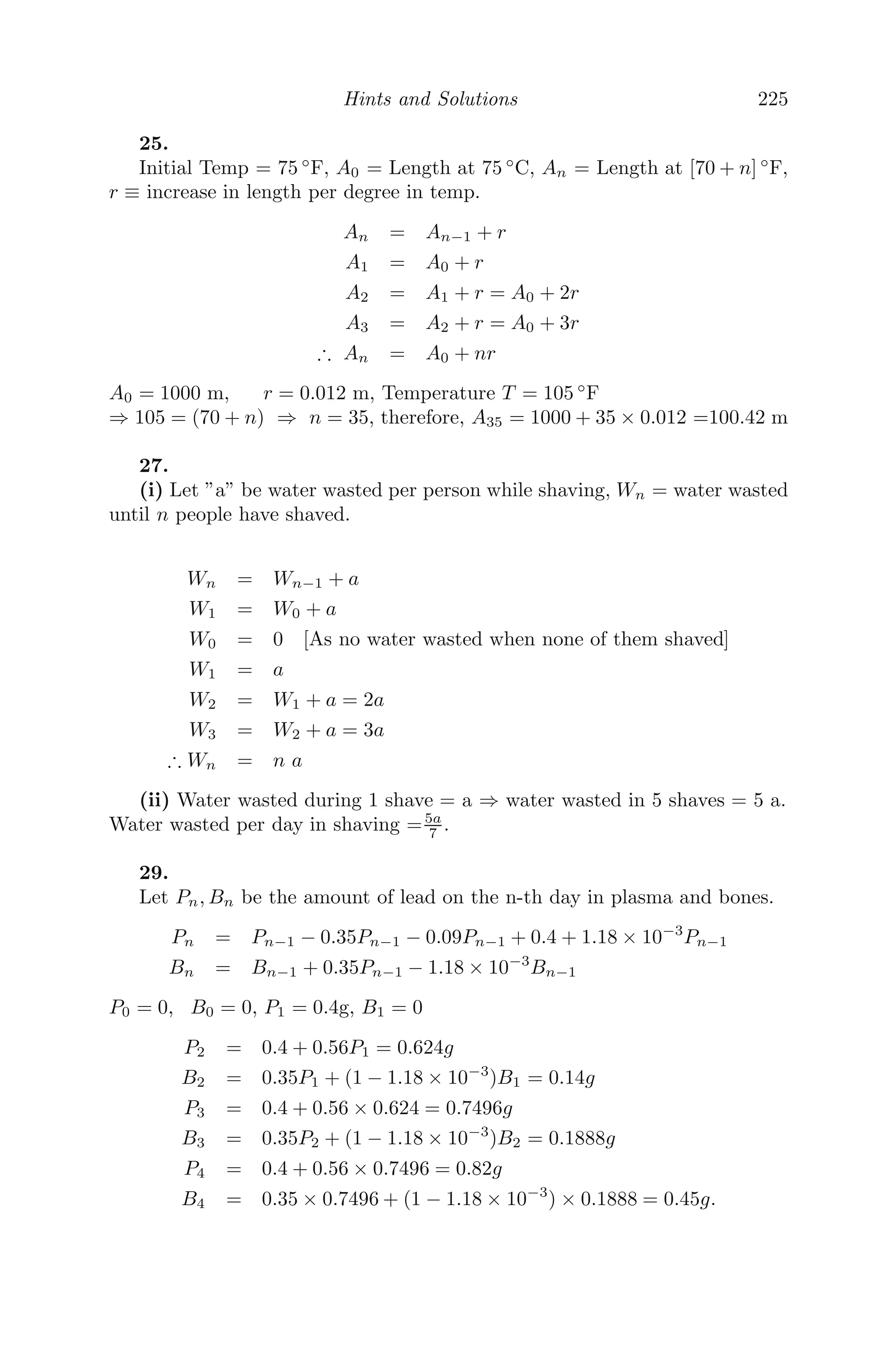
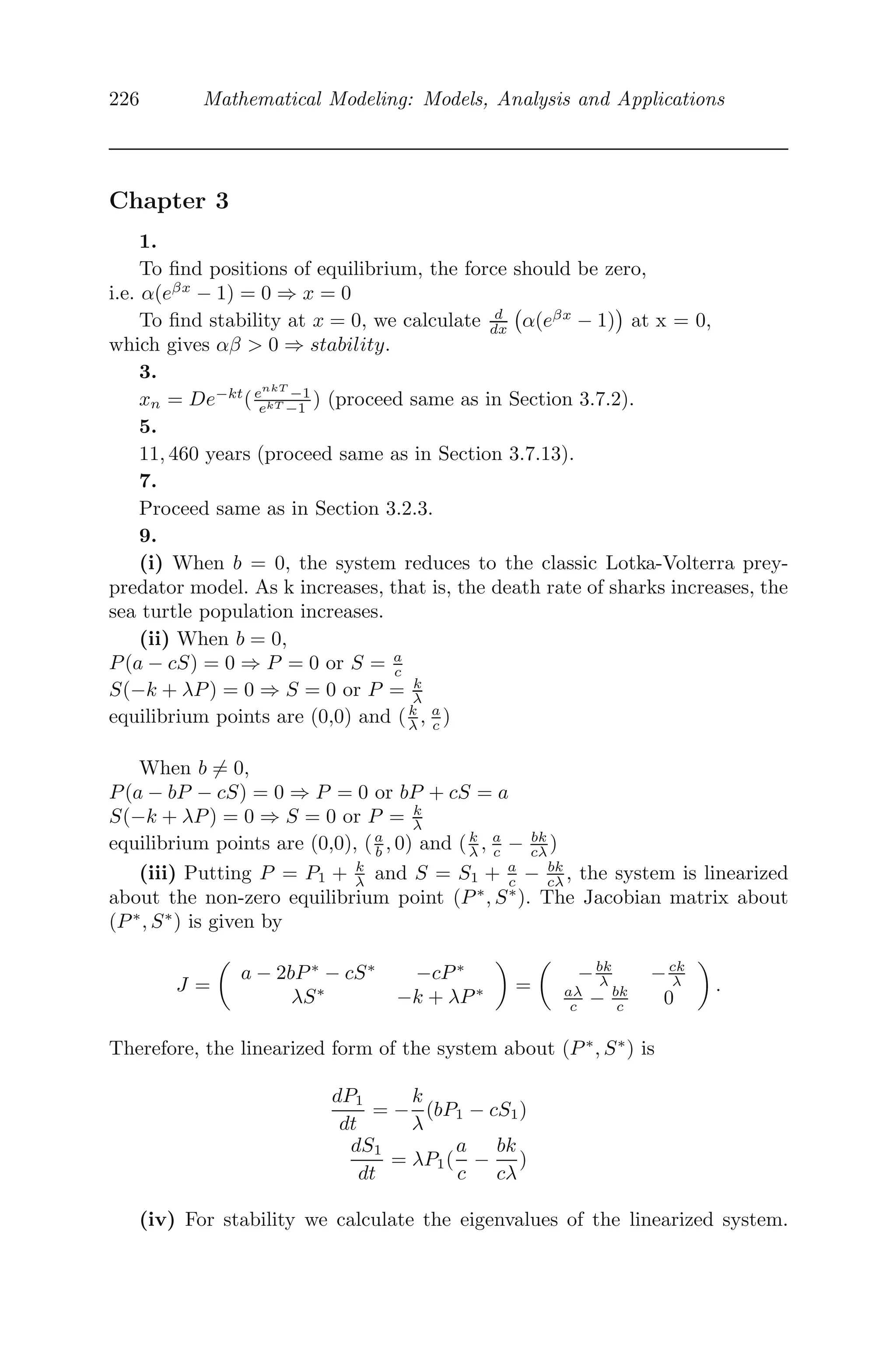
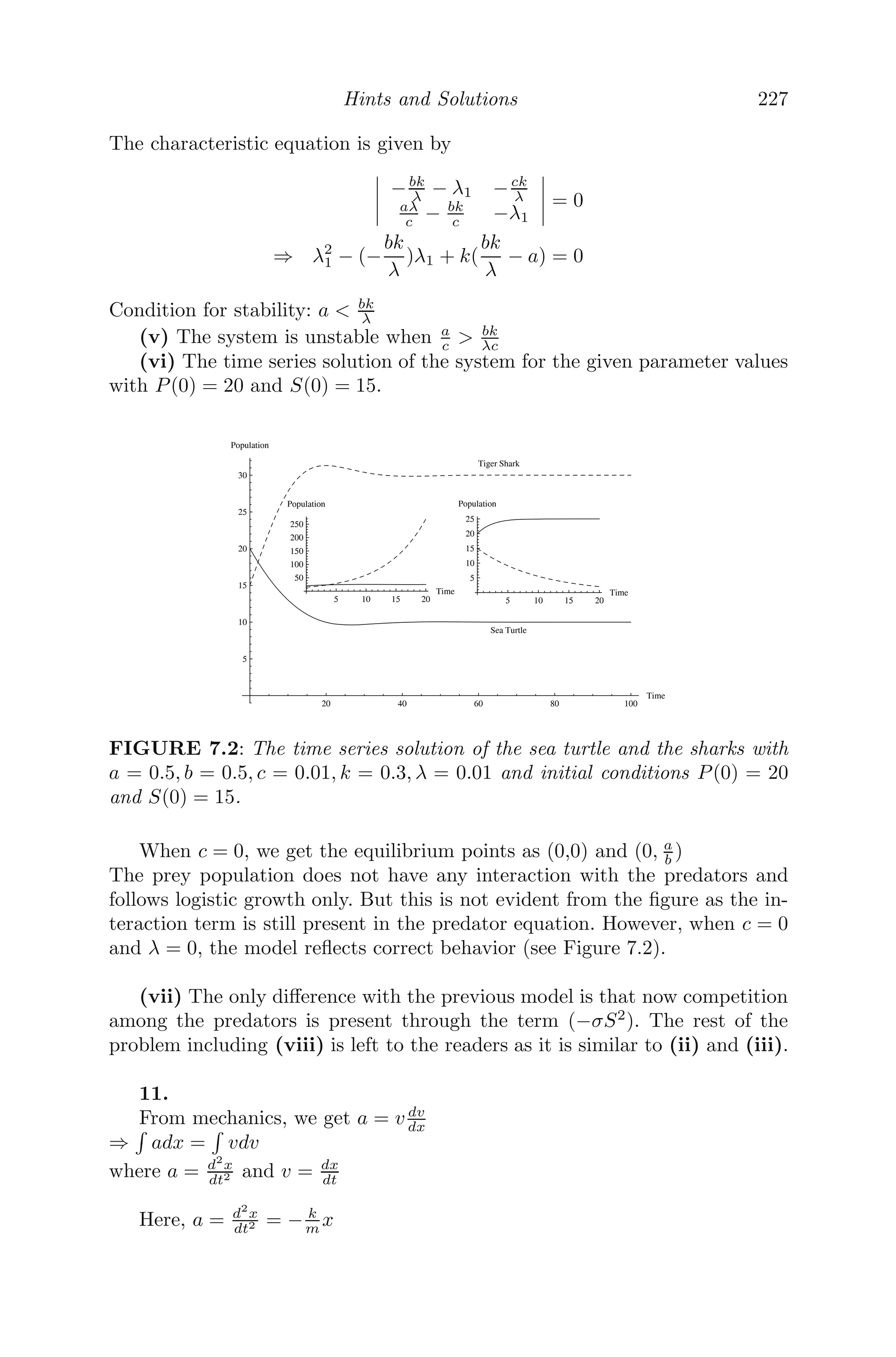
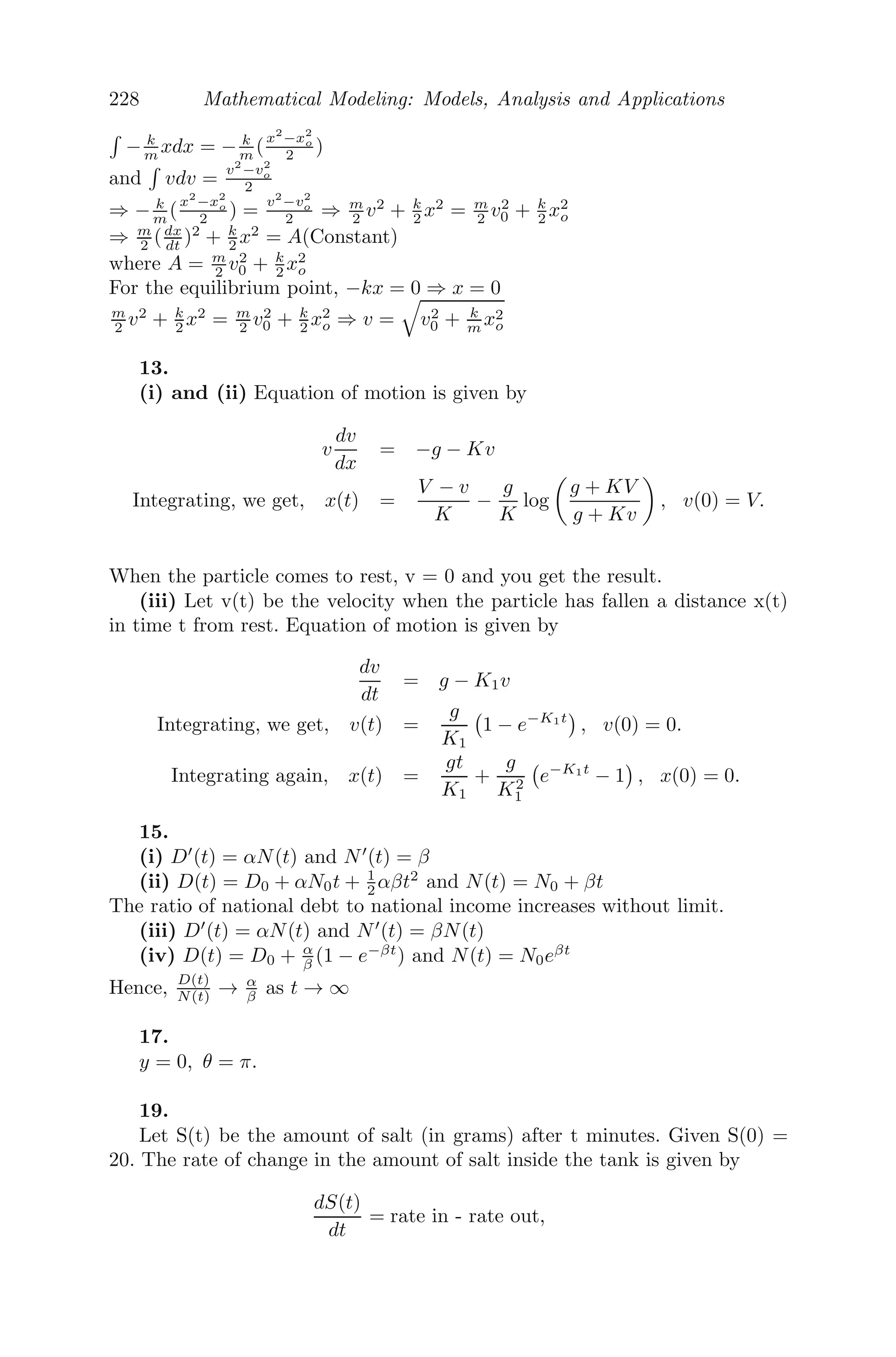

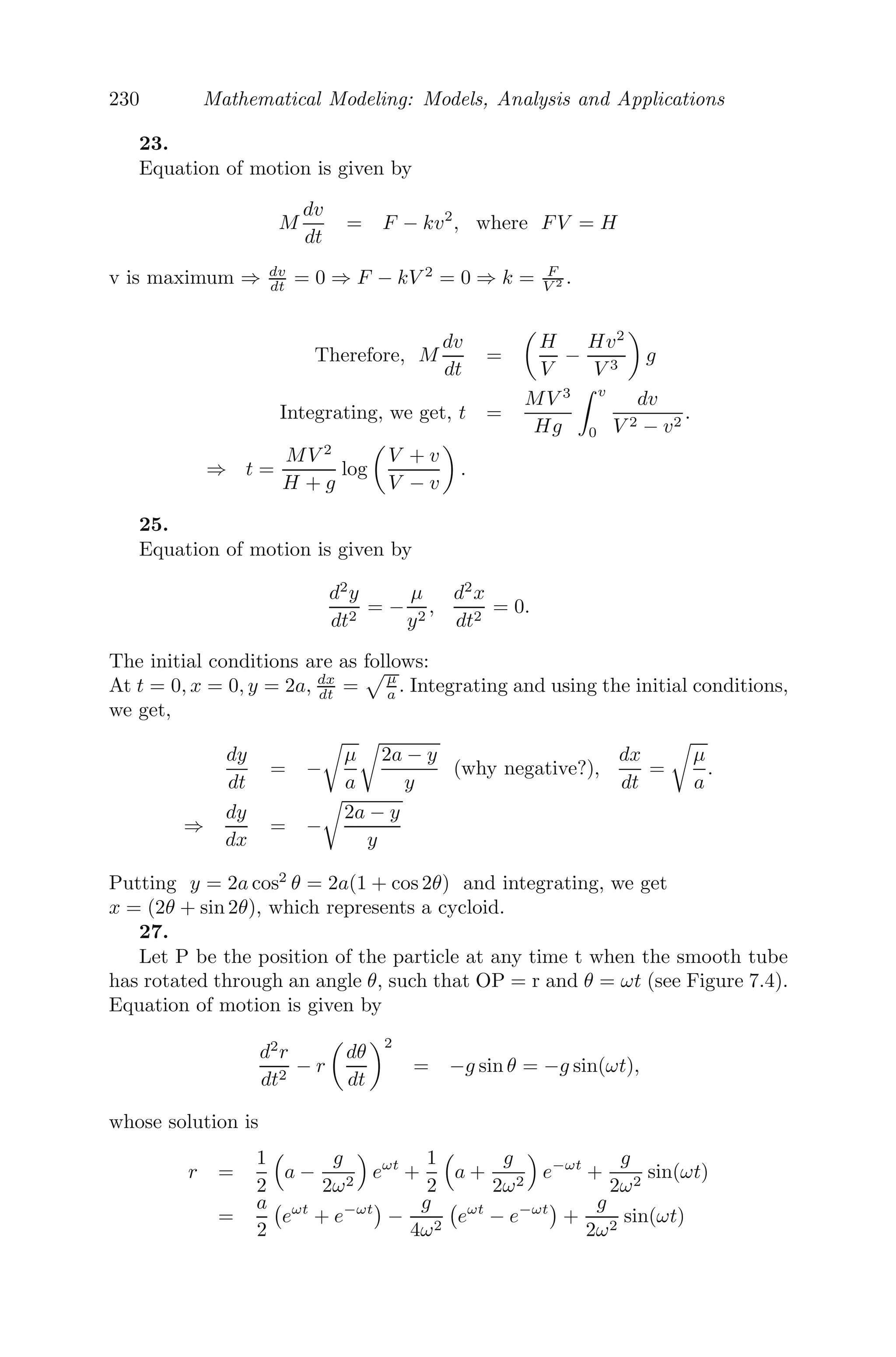
![= 0
This is a transcendental equation, which has infinite many eigenvalues. One
of the eigenvalues is λ = −1. The rest are given by and λ = −1 + me−τ
a+1 e−τλ
.
Using Theorem 5.3.1.1, we get A = −1 and B = me−τ
a+1 . Clearly, B A and
A + B = −1 + me−τ
a+1 . Therefore, the washout state is stable if me−τ
a+1 1 and
unstable if me−τ
a+1 1 (please note that the survival state exists if the washout
state is unstable).
In a similar manner, for the survival state, the characteristic equation is
given by
(λ + 1)
λ + 1 −
me−τ
a + 1
e−τλ
= 0. (5.6)
Using Theorem 5.3.1.1, we conclude that the survival state (S∗
, B∗
) is always
asymptotically stable whenever it exists as A+B = −(1−S∗
)e−τ am
(a+S∗)2 0.
(iii) Numerical simulation is left to the reader (MATLAB code has been pro-
vided).
Problem 5.4.5 The delayed Lotka-Volterra competition system is given by
dx
dt
= x(t)[2 − αx(t) − βy(t − τ)]
dy
dt
= y(t)[2 − γx(t − τ) − δy(t)]
(i) Obtain the steady state solution(s).](https://image.slidesharecdn.com/mathematicalmodelingmodelsanalysisandapplicationspdfdrive-211127122602/75/Mathematical-modeling-models-analysis-and-applications-pdf-drive-254-2048.jpg)
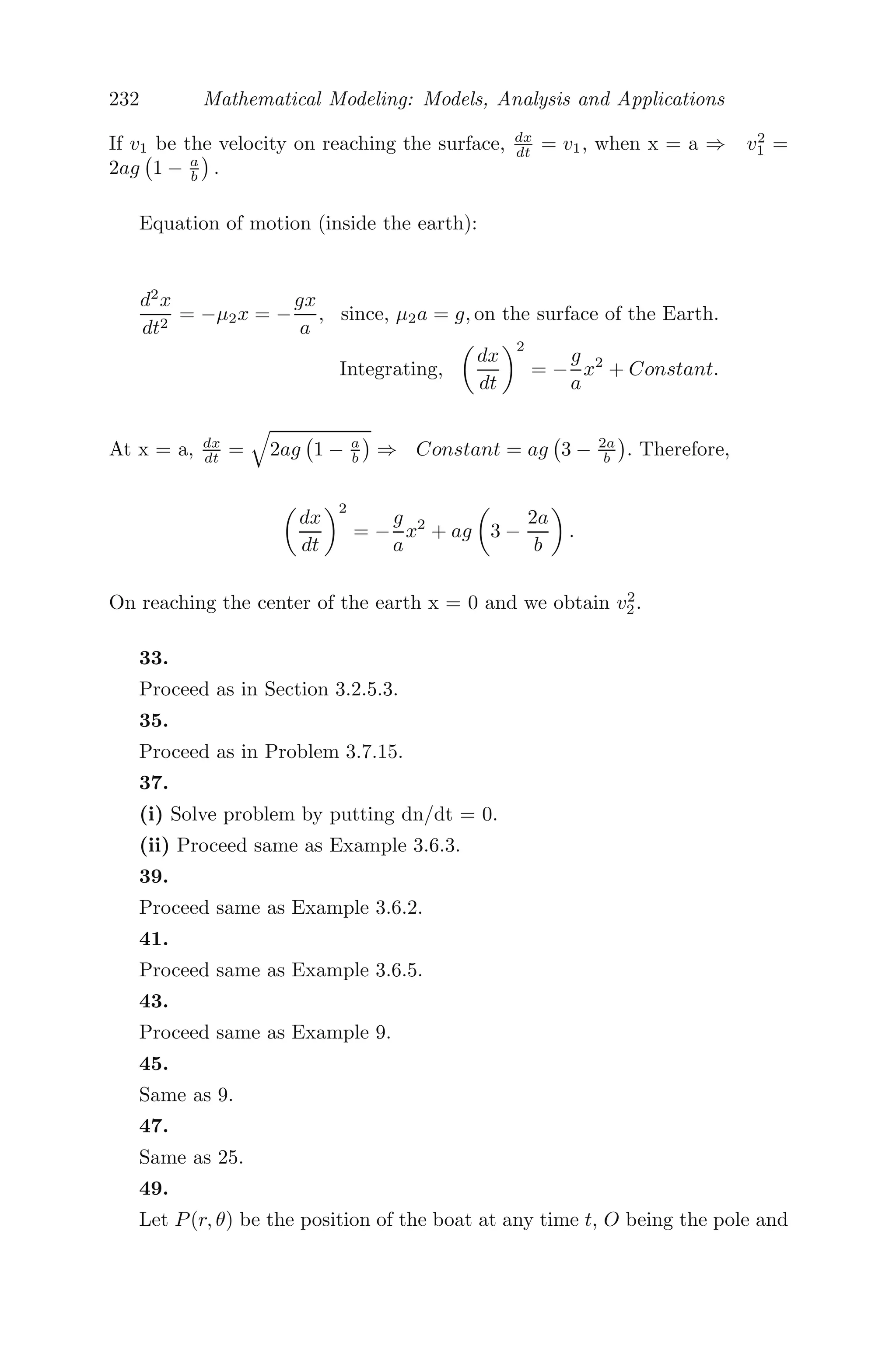


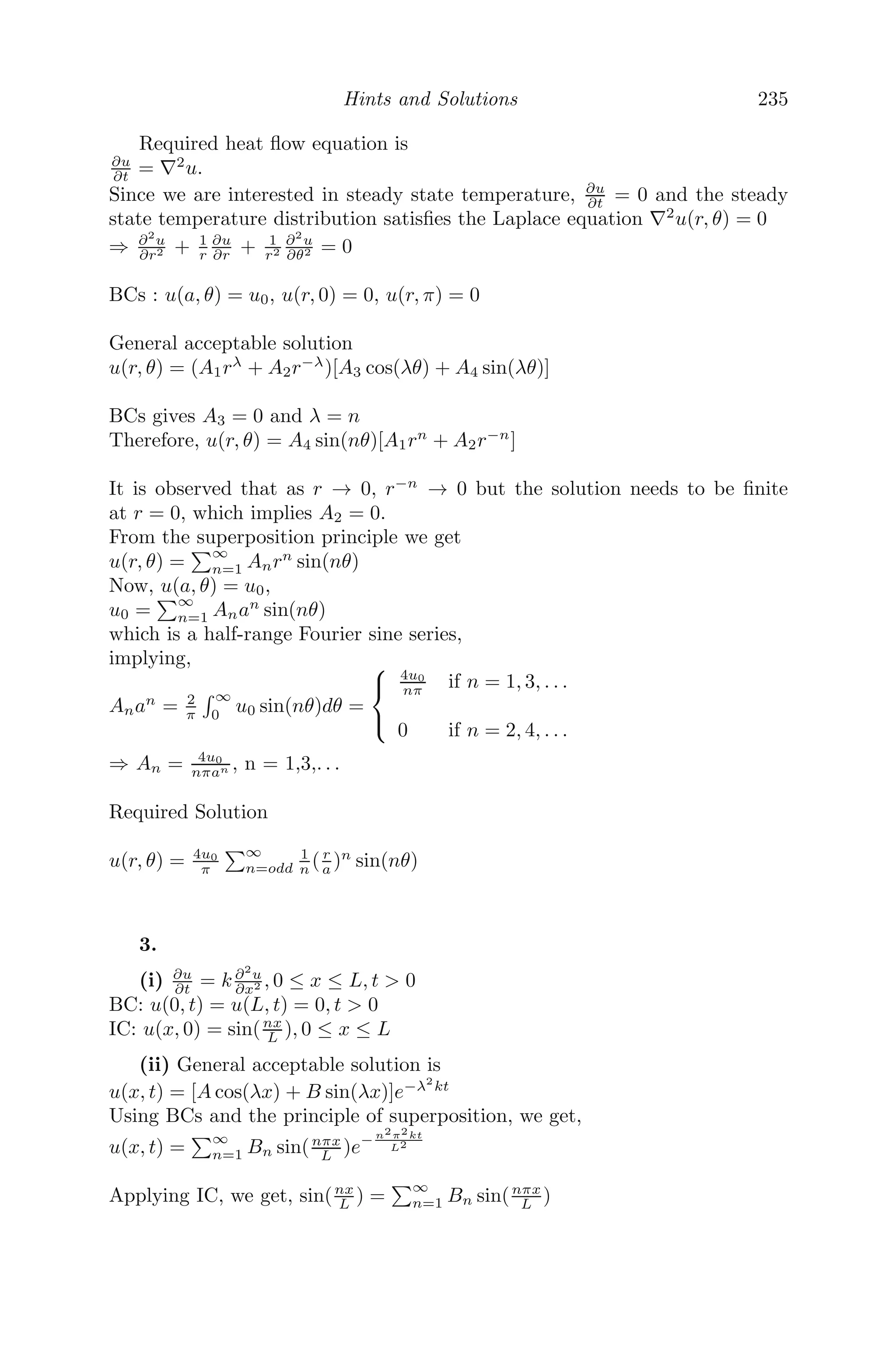
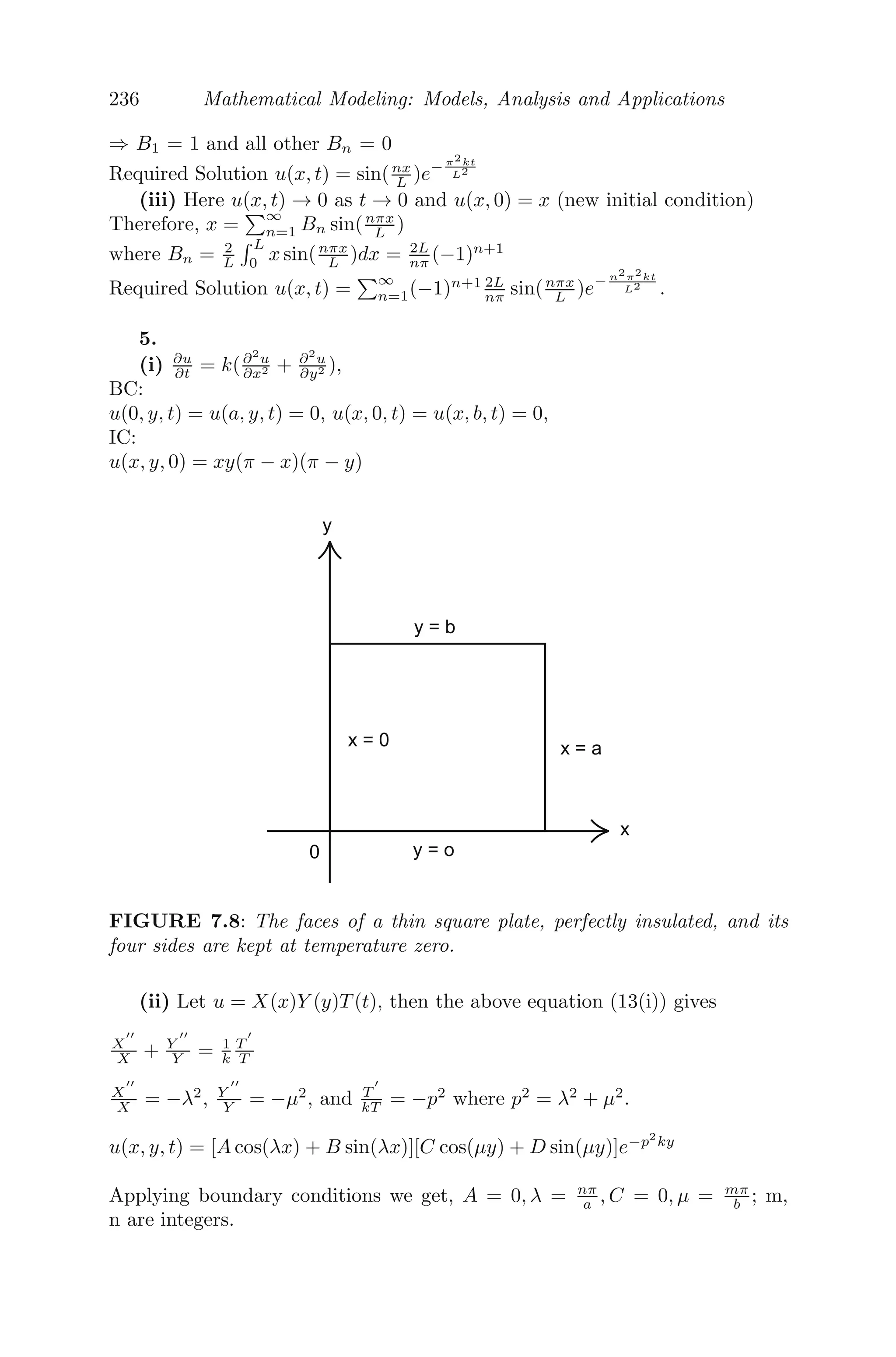

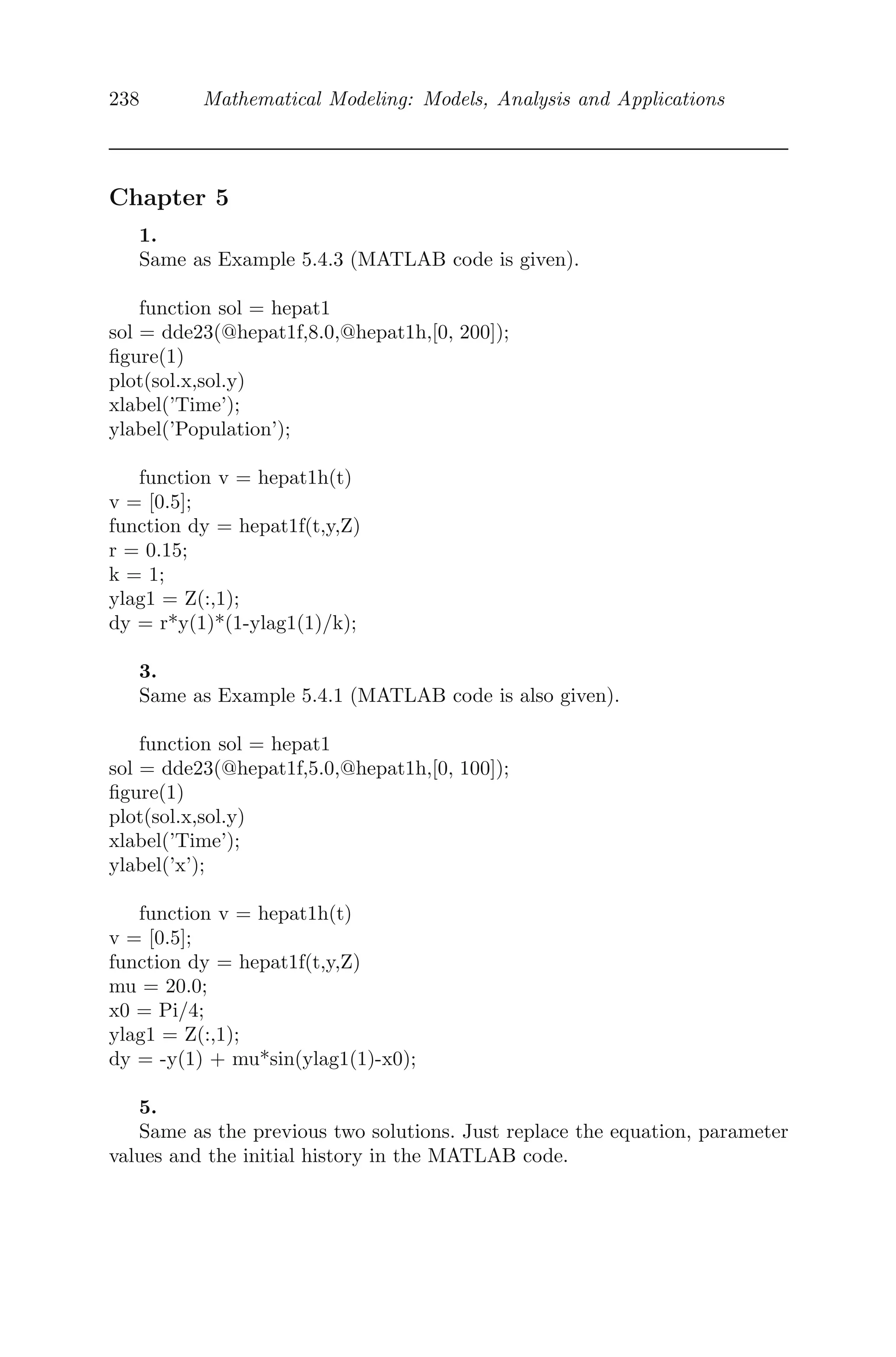
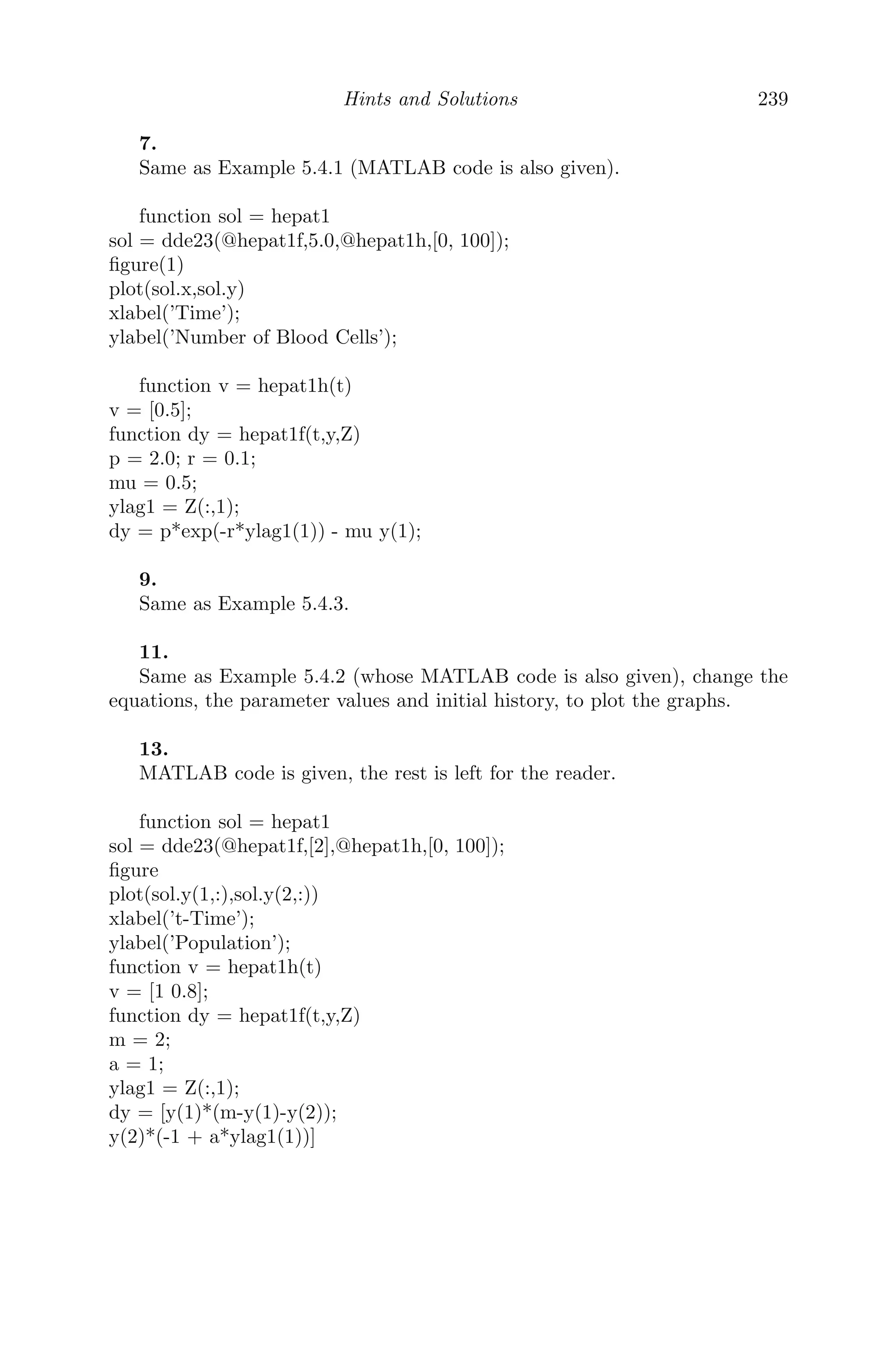
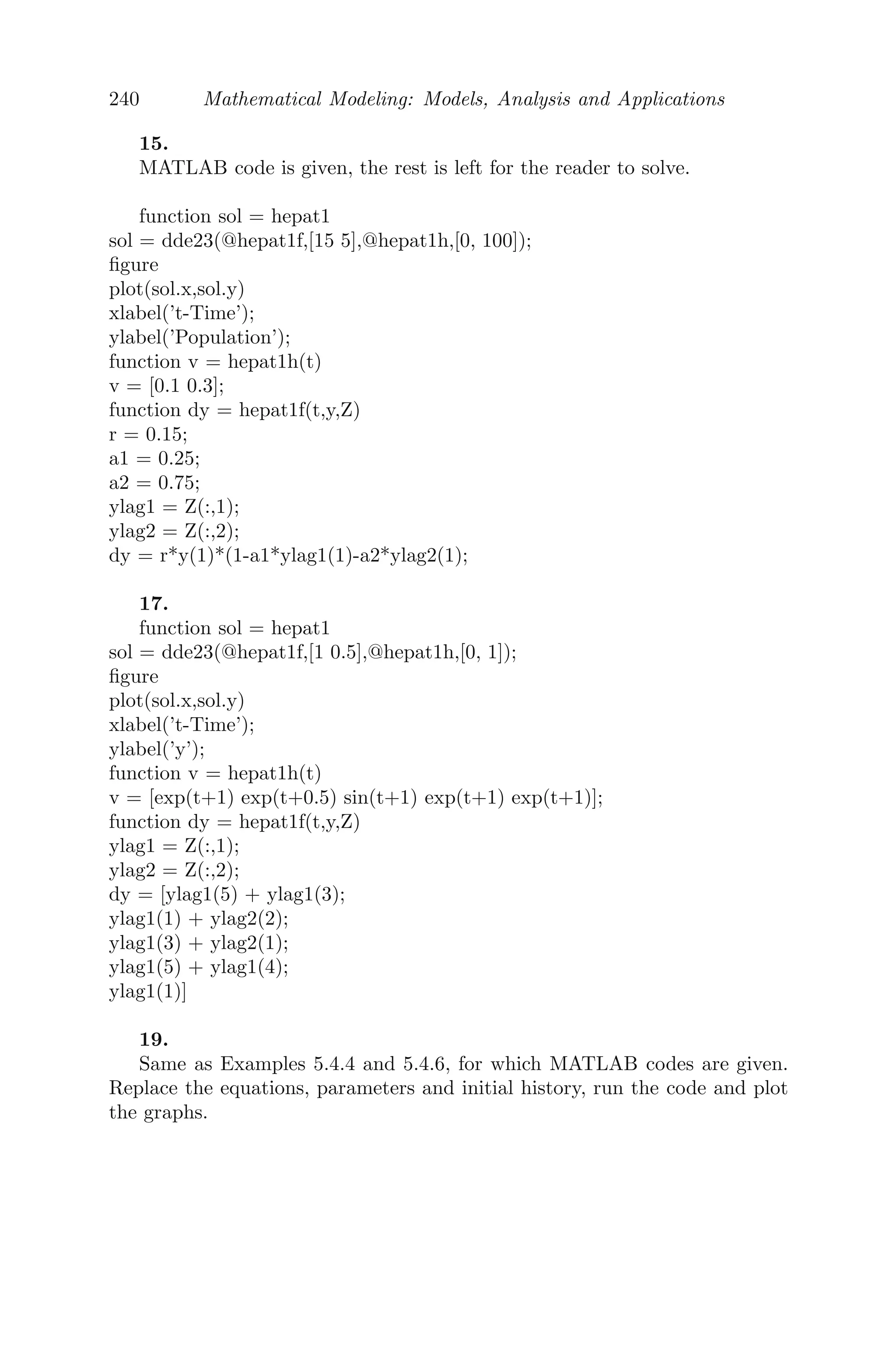
![Modeling with Delay Differential Equations 169
gene regulatory system is described by a system of ODEs as [123]
dR(t)
dt
=
gm
1 +
P (t−τ)
k
n − α1R(t)
dP(t)
dt
= R(t) − α2P(t)
where, R(t) and P(t) represent the intracellular mRNA and the protein product
of the gene respectively. The growth of mRNA follows a Hill function, α1 and
α2 are the rates of degradation of mRNA and the protein product of the gene
respectively. The discrete time delay τ is the time taken by mRNA to leave
the nucleus, undergo protein synthesis in the ribosome, whereupon the protein
re-enters the nucleus and suppresses its own mRNA production.
(i) Solve the system numerically by taking gm = 1, k = 0.5, n = 3, α1 = α2 =
1, τ = 0.5 and represent it graphically.
(ii) By taking large values of the discrete time delay τ = 3.5, what changes do
you observe in the dynamics of the system?
Solution: (i) The model equation is solved numerically and the graphical
representation is shown in Figure 5.10A,B. Both the state variables R(t) and
P(t) converge to equilibrium solutions for τ = 0.5.
(ii) For large τ (= 3.5), we observe sustained oscillations as seen in Figure
5.10C,D.
Problem 5.4.7 Cargo pendulation reduction problem: Bridge cranes or
overload cranes are used in shipyards, railyards and warehouses to lift several
hundred tons of containers and move them to another place. Henry et al. [51]
and Masoud et al. [81] proposed a delay-induced mathematical model for safe
control of the crane pendulation as
d2
θ
dt2
+
dθ
dt
+ sinθ = −kcosθ[θ(t − τ) − θ]
where θ represents the angle due to pendulation. The aim is to stabilize the
system by reducing θ significantly at the end of the motion for safe operation.
(i) Show that for small θ and small τ, the system reduces to
d2
θ
dt2
+ ( − k τ)
dθ
dt
+ θ = 0
(ii) Solve numerically the system for τ = 12, = 0.1, k = −0.15, θ
(0) = 0
and θ(0) = 1 for −τ t 0 and comment on the result.
(iii) How do the dynamics change if θ
(0) = 0 and θ = 1.5 for −τ t 0?
Solution: (i) Clearly, θ = 0 is an equilibrium point. Near the steady state
solution θ = 0, sin(θ) ≈ θ, cos(θ) ≈ 1 and the model becomes
d2
θ
dt2
+
dθ
dt
+ θ = −k[θ(t − τ) − θ)]](https://image.slidesharecdn.com/mathematicalmodelingmodelsanalysisandapplicationspdfdrive-211127122602/75/Mathematical-modeling-models-analysis-and-applications-pdf-drive-264-2048.jpg)
![170 Mathematical Modeling: Models, Analysis and Applications
0 5 10 15 20
0.1
0.2
0.3
0.4
0.5
0.6
0.7
0.8
t−Time
Intercellular
mRNA
R(t)
0 5 10 15 20
0.1
0.2
0.3
0.4
0.5
0.6
t−Time
Protein
product
of
the
gene
P(t)
0 10 20 30 40 50
−0.5
0
0.5
1
1.5
2
t−Time
Intercellular
mRNA
R(t)
0 10 20 30 40 50
−0.2
0
0.2
0.4
0.6
0.8
1
1.2
1.4
t−Time
Protein
product
of
the
gene
P(t)
A B
C D
FIGURE 5.10: The numerical solution of the model equation with parameter
values gm = 1, k = 0.5, n = 3, α1 = α2 = 1, τ = 0.5 and initial history [0.1,
0.1]. (i) Figure 5.10A,B shows convergence to steady state solution for τ = 0.5
and (ii) Figure 5.10C,D shows sustained oscillations for τ = 3.5.
Now, for small τ, θ(t − τ) ≈ θ − τ θ
dt and the above equation reduces to
d2
θ
dt2
+
dθ
dt
+ θ = −k[θ − τ
θ
dt
− θ)]
⇒
d2
θ
dt2
+ ( − k τ)
dθ
dt
+ θ = 0
(ii) Graphical representation of the numerical solution for the given parame-
ters shows that the oscillations are damped (Figure 5.11A) for small amplitude
perturbation of the steady state solution θ = 0.
(iii) When the value of θ(0) is changed from 1.0 to 1.5, graphical represen-
tation of the numerical solution shows that the perturbation is large enough
to make the oscillation of the crane pendulation sustained (Figure 5.11B).](https://image.slidesharecdn.com/mathematicalmodelingmodelsanalysisandapplicationspdfdrive-211127122602/75/Mathematical-modeling-models-analysis-and-applications-pdf-drive-265-2048.jpg)
![Modeling with Delay Differential Equations 171
0 50 100 150 200 250 300
−0.8
−0.6
−0.4
−0.2
0
0.2
0.4
0.6
0.8
1
t−Time
θ(t)
0 50 100 150 200 250 300
−2
−1.5
−1
−0.5
0
0.5
1
1.5
2
t−Time
θ(t)
A B
FIGURE 5.11: The numerical solution of the model equation with parameter
values = 0.1, k = −0.15 and initial history (i) θ
(0) = 0 and θ(0) = 1 (A),
(ii) θ
(0) = 0 and θ(0) = 1.5 (B).
5.4.1 A Research Problem: Immunotherapy with Interleukin-
2, a Study Based on Mathematical Modeling [8]
5.4.1.1 Background of the Problem
The mechanism of establishment and destruction of cancer, one of the
greatest killers in the world, is still a puzzle. Modern treatment involves
surgery, chemotherapy and radiotherapy, yet relapses occur. Hence, the need
for more successful treatment is clear. Developing schemes for immunotherapy
or its combination with other therapy methods are the major focus at present,
and aim at reducing the tumor mass, heightening tumor immunogenicity and
removal of immunosuppression induced in an organism in the process of tumor
growth. Recent progress has been achieved through immunotherapy, which
refers to the use of cytokines (protein hormones that mediate both natural
and specific immunities) usually together with adoptive cellular immunother-
apy (ACI) [37, 66, 108, 109, 118].
The main cytokine responsible for lymphocyte activation, growth and dif-
ferentiation is interleukin-2 (IL-2), which is mainly produced by T helper cells
(CD4+ T-cells) and in relatively small quantities by cytotoxic T-lymphocytes
(CD8+ T-cells). CD4 lymphocytes differentiate into T-Helper 1 and T-Helper
2 functional subjects due to the immune response. IL-2 acts in an autocrine
manner on T-Helper 1 and also induces the growth of T-Helper 2 and CD8
lymphocytes in a paracrine manner. The T-lymphocytes themselves are stim-
ulated by the tumor to induce further growth. Thus the complete biological
assumption of adoptive cellular immunotherapy is that the immune system
is expanded in number artificially (ex vivo) in cell cultures by means of hu-](https://image.slidesharecdn.com/mathematicalmodelingmodelsanalysisandapplicationspdfdrive-211127122602/75/Mathematical-modeling-models-analysis-and-applications-pdf-drive-266-2048.jpg)
![172 Mathematical Modeling: Models, Analysis and Applications
man recombinant interleukin-2. This can be done in two ways, either by (i)
lymphokine-activated killer cell therapy (LAK-therapy), where the cells are
obtained from the in vitro culturing of peripheral blood leukocytes removed
from patients with a high concentration of IL-2, or (ii) tumor-infiltrating lym-
phocyte therapy (TIL), where the cells are obtained from lymphocytes recov-
ered from the patient tumors, which are then incubated with high concentra-
tions of IL-2 in vitro and are comprised of activated natural killer (NK) cells
and cytotoxic T-lymphocyte (CTL) cells. The TIL are then returned into the
bloodstream, along with IL-2, where they can bind to and destroy the tu-
mor cells. It has been established clinically that immunotherapy with IL-2
has enhanced CTL activity at different stages of tumor [108, 109, 118]. Also,
there is evidence of the restoration of the defective NK cell activity as well
as enhancement of polyclonal expansion of CD4+ and CD8+ T cells [110, 127].
Kirschner and Panetta have studied the role of IL-2 in tumor dynamics,
particularly long-term tumor recurrence and short-term oscillations, in math-
ematical perspective [69]. The model proposed there deals with three popu-
lations; namely, the activated immune-system cells (commonly called effector
cells), such as cytotoxic T cells, macrophages and NK cells that are cytotoxic
to the tumor cells, the tumor cells and the concentration of IL-2. The impor-
tant parameters in their study are antigenicity of tumor (c), a treatment term
that represents external source of effector cells (s1) and a treatment term that
represents an external input of IL-2 into the system (s2). Their results can
be summarized as follows: (i) For non-treatment cases (s1 = 0, s2 = 0), the
immune system is not been able to clear the tumor for low-antigenic tumors,
while for highly antigenic tumors, reduction to a small dormant tumor is the
best-case scenario. (ii) The effect of adoptive cellular immunotherapy (ACI)
(s1 0, s2 = 0) alone can yield a tumor-free state for tumors of almost any
antigenicity, provided the treatment concentration is above a given critical
level. However, for tumors with small antigenicity, early treatment is needed
while the tumor is small, so that the tumor can be controlled. (iii) Treatment
with IL-2 alone (s1 = 0, s2 0) shows that if IL-2 administration is low, there
is no tumor-free state. However, if IL-2 input is high the tumor can be cleared
but the immune system grows without bounds, causing problems such as cap-
illary leak syndrome. (iv) Finally, the combined treatment with ACI and IL-2
(s1 0, s2 0) gives the combined effects obtained from the monotherapy
regime. For any antigenicity, there is a region of tumor clearance. These re-
sults indicate that treatment with ACI may be a better option either as a
monotherapy or in conjunction with IL-2. Here I have proposed a modifica-
tion of the model studied by Kirschner and Panetta by adding a discrete time
delay which exists when activated T-cells produce IL-2.](https://image.slidesharecdn.com/mathematicalmodelingmodelsanalysisandapplicationspdfdrive-211127122602/75/Mathematical-modeling-models-analysis-and-applications-pdf-drive-267-2048.jpg)
![Modeling with Delay Differential Equations 173
5.4.1.2 The Model
The proposed model is an extension of the Kirschner-Panetta ordinary
differential equation model [69]
dE
dt1
= cT +
p1EIL
g1 + IL
− μ2E + s1
dT
dt1
= r2(1 − bT )T −
aET
g2 + T
dIL
dt1
=
p2ET
g3 + T
− μ3IL + s2
to a DDE model with proper biological justifications and is given by
dE
dt1
= cT +
p1E(t1 − τ)IL(t1 − τ)
g1 + IL(t1 − τ)
− μ2E + s1
dT
dt1
= r2(1 − bT )T −
aET
g2 + T
dIL
dt1
=
p2ET
g3 + T
− μ3IL + s2
Using the following scaling [69]
x = E
E0
, y = T
T0
, z = IL
IL0
, t = tst1; c̄ = cT0
tsE0
, ¯
p1 = p1
ts
,
¯
g1 = g1
IL0
, ¯
μ2 = μ2
ts
, ¯
g2 = g2
T0
, b̄ = bT0, , ¯
r2 = r2
ts
, ā = aE0
tsT0
,
¯
μ3 = μ3
ts
, ¯
p2 = p2E0
tsIL0
, ¯
g3 = g3
T0
, ¯
s1 = s1
tsE0
, ¯
s2 = s2
tsIL0
,
the given system is non-dimensionalized, given by (after dropping the overbar
notation for convenience)
dx
dt
= cy +
p1x(t − τ)z(t − τ)
g1 + z(t − τ)
− μ2x + s1
dy
dt
= r2(1 − by)y −
axy
g2 + y
(5.7)
dz
dt
=
p2xy
g3 + y
− μ3z + s2
subject to the following initial conditions
x(θ) = ψ1(θ), y(θ) = ψ2(θ), z(θ) = ψ3(θ)
ψ1(θ) ≥ 0, ψ2(θ) ≥ 0, ψ3(θ) ≥ 0; θ ∈ [−τ, 0] (5.8)
ψ1(0) 0, ψ2(0) 0, ψ3(0) 0;
where C+ = (ψ1(θ), ψ2(θ), ψ3(θ)) ∈ C([−τ, 0], R3
+0), the Banach space of con-
tinuous functions mapping the interval [−τ, 0] into R3
+0, where R3
+0 is defined
as
R3
+0 = ((x, y, z) : x, y, z ≥ 0) and R3
+, the interior of R3
+0 as
R3
+ = ((x, y, z) : x, y, z 0)](https://image.slidesharecdn.com/mathematicalmodelingmodelsanalysisandapplicationspdfdrive-211127122602/75/Mathematical-modeling-models-analysis-and-applications-pdf-drive-268-2048.jpg)
![174 Mathematical Modeling: Models, Analysis and Applications
In the system described by (5.7), x(t), y(t) and z(t) respectively represent
the effector cells, the tumor cells and the concentration of IL-2 in the single
site compartment. The first equation of the system (5.7) describes the rate of
change for the effector cell population. The effector cells grow due to the direct
presence of the tumor, given by the term cy, where c is the antigenicity of the
tumor. It is also stimulated by IL-2 that is produced by effector cells in an
autocrine and paracrine manner (the term p1xz
g1+z , where p1 is the rate at which
effector cells grow, and g1 is the half saturation constant). Clinical trials show
that there are immune stimulation effects from treatment with IL-2 [110, 127]
and there is a time lag between the production of IL-2 by activated T-cells and
the effector cell stimulation from treatment with IL-2. Hence, a discrete time
delay is being added to the second term of the first equation of the system
(5.7), which modifies to p1x(t−τ)z(t−τ)
g1+z(t−τ) , where μ2x gives the natural decay of
the effector cells and s1 is the treatment term that represents the external
source of the effector cells such as ACI. A similar type of term was introduced
by Galach [35] in his model equation, where he assumed that the source of the
effector cells is the term x(t − τ)y(t − τ), as the immune system needs some
time to develop a suitable response.
The second equation of the system (5.7) shows the rate of change of the
tumor cells, which follows logistic growth (a type of limiting growth). Due
to tumor-effector cell interaction, there is a loss of tumor cells at the rate a
and which is modeled by Michaelis Menten kinetics to indicate the limited
immune response to the tumor (the term axy
g2+y , where g2 is a half saturation
constant). The third equation of the system (5.7) gives the rate of change for
the concentration of IL-2. Its source is the effector cells that are stimulated by
interaction with the tumor and also has Michaelis Menten kinetics to account
for the self-limiting production of IL-2 (the term p2xy
g3+y , where p2 is the rate
of production of IL-2 and g3 is a half saturation constant), μ3z is the natural
decay of the IL-2 concentration and s2 is a treatment term that represents an
external input of IL-2 into the system.
Proper scaling is needed as the system is numerically stiff, and numerical
routines used to solve these equations will fail without scaling or inappropriate
scaling (in this case, a proper choice of scaling is E0 = T0 = IL0 = 1/b and
ts = r2 [69]). The parameter values have been obtained from [69], which is
put in tabular form (Table 5.1). The units of the parameters are in day−1
,
except of g1, g2, g3 and b, which are in volumes.
The aim of this problem is to study this modified model and to explore any
changes in the dynamics of the system that may occur when a discrete time
delay has been added in the system and to compare with the results obtained
by Kirschner and Panetta in [69].](https://image.slidesharecdn.com/mathematicalmodelingmodelsanalysisandapplicationspdfdrive-211127122602/75/Mathematical-modeling-models-analysis-and-applications-pdf-drive-269-2048.jpg)
![Modeling with Delay Differential Equations 175
TABLE 5.1: Parameter Values Used for Numerical Simulation.
Parameters Values Scales Values
c (antigenicity of tumor) 0 ≤ c ≤ 0.05 0 ≤ c ≤ 0.278
p1 (growth rate of effector cells) 0.1245 0.69167
g1 (half saturation constant) 2 × 107
0.02
μ2 (natural decay rate of effector cells) 0.03 0.1667
r2 (growth rate of tumor cells) 0.18 1
b (1/carrying capacity of tumor cells) 1.0 × 10−9
1
a (decay rate of tumor) 1 5.5556
g2 (half saturation constant) 1 × 105
0.0001
μ3 (natural decay rate of IL-2) 10 55.556
p2 (growth rate of IL-2) 5 27.778
g3 (half saturation constant) 1 × 103
0.000001
5.4.1.3 Positivity of the Solution
The system of equations is now put in a vector form by setting
X = col(M, N, Z) ∈ R3
+0,
F(X) =
⎛
⎝
F1(X)
F2(X)
F3(X)
⎞
⎠ =
⎛
⎜
⎝
cy + p1x(t−τ)z(t−τ)
g1+z(t−τ) − μ2x + s1
r2(1 − by)y − axy
g2+y
p2xy
g3+y − μ3z + s2
⎞
⎟
⎠ ,
where F : C+ → R3
+0 and F ∈ C∞
(R3
+0). Then system (5.7) becomes
Ẋ = F(Xt), (5.9)
where · ≡ d/dt and with Xt(θ) = X(t + θ), θ ∈ [−τ, 0] [50]. It is easy to check
in equation (5.9) that whenever we choose X(θ) ∈ C+ such that Xi = 0, then
we obtain Fi(X)|Xi(t)=0,Xt∈C+
≥ 0, i = 1, 2, 3. Due to the lemma in [134], any
solution of equation (5.9) with X(θ) ∈ C+, say, X(t) = X(t, X(0)), is such
that X(t) ∈ R3
+0 for all t 0.
5.4.1.4 Linear Stability Analysis with Delay
The equilibria for the system (scaled) are as follows: (i) The x − z planar
equilibrium is ( s1(g1μ3+s2)
μ2(g1μ3+s2)−p1s2
, 0, s2
μ3
) and exists if μ2 p1s2
g1μ3+s2
.
(ii) The interior equilibrium is E∗(x∗
, y∗
, z∗
) where x∗
= r2
a (1 − by∗
)(g2 + y∗
),
z∗
= (p2r2(1−by∗
)(g2+y∗
)
aμ3(g3+y∗) + s2
μ3
) and y∗
is given by the equation cy∗
− μ2x∗
+
p1x∗
z∗
g1+z∗ + s1 = 0.
In the case of positive delay, the characteristic equation for the linearized
equation around the point (x∗
, y∗
, z∗
) is given by
P(λ) + Q(λ)e−λτ
= 0 (5.10)](https://image.slidesharecdn.com/mathematicalmodelingmodelsanalysisandapplicationspdfdrive-211127122602/75/Mathematical-modeling-models-analysis-and-applications-pdf-drive-270-2048.jpg)
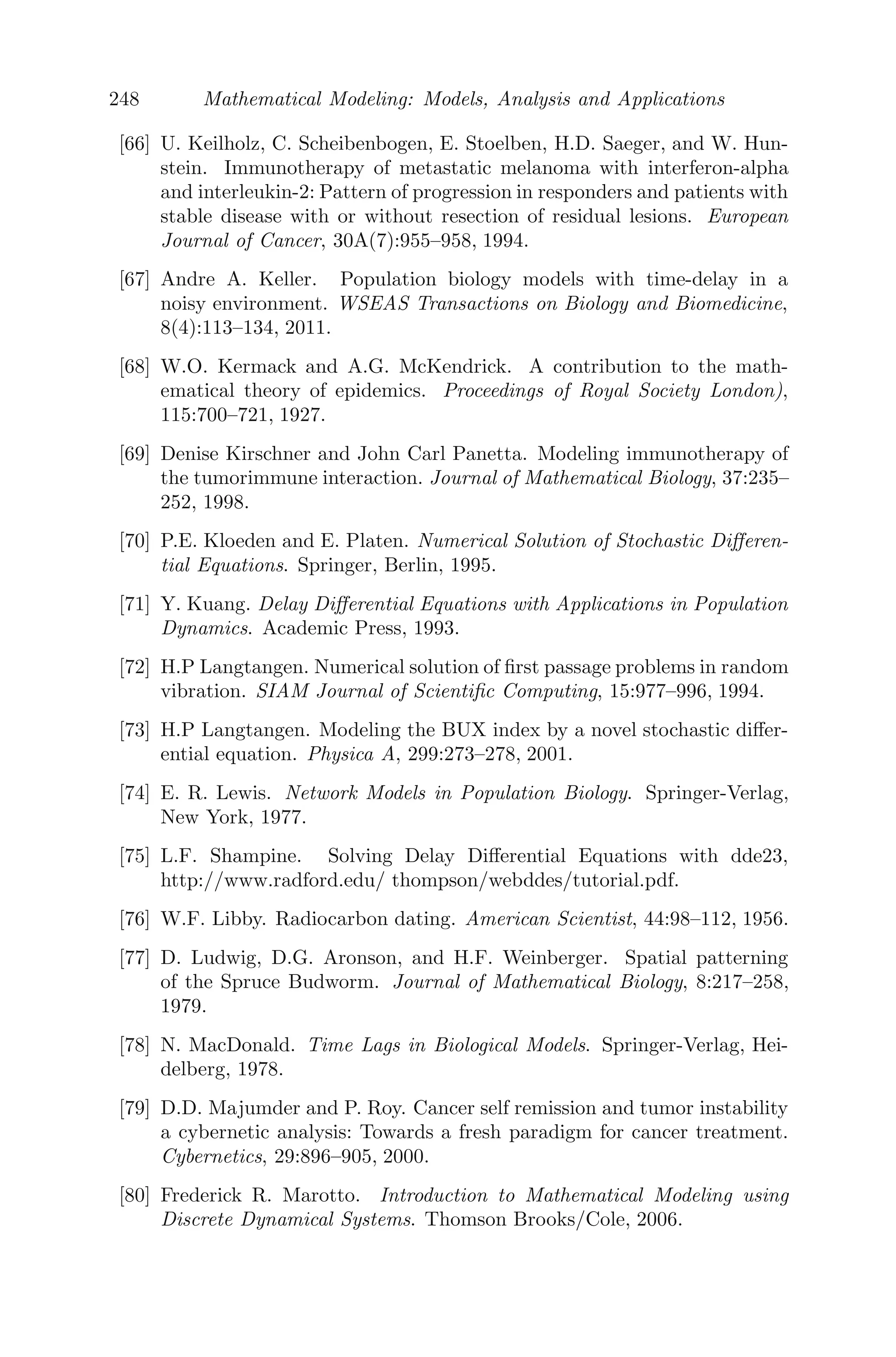
![Modeling with Delay Differential Equations 177
a1ω2
− a3 = (b3 − b1ω2
)cos(ωτ) + b2ωsin(ωτ) (5.12)
ω3
− a2ω = b2ωcos(ωτ) − (b3 − b1ω2
)sin(ωτ) (5.13)
Squaring and adding (5.12) and (5.13) we get,
(b3 − b1ω2
)2
+ b2
2ω2
= (a1ω2
− a3)2
+ (ω3
− a2ω)2
⇒ ρ3
+ A1ρ2
+ A2ρ + A3 = 0, where ρ = ω2
(5.14)
where
A1 = a2
1 − 2a2 − b2
1
= μ2
2 + μ2
3 + b2
r2
2(y∗
)2
+
a2
(x∗
)2
(y∗
)2
(g2 + y∗)4
−
2ay∗
{br2x∗
y∗
+ c(g2 + y∗
)}
(g2 + y∗)2
+
p2
1(z∗
)2
(g1 + z∗)2
−
2μ2p1z∗
g1 + z∗
A2 = a2
2 − b2
2 − 2a1a3 + 2b1b3
=
−g2
1p2
1p2
2(x∗
)2
(y∗
)2
(g3 + y∗)2(g1 + z∗)4
+ {
−aμ3x∗
y∗
(g2 + y∗)2
−
μ3p1z∗
g1 + z∗
+
acy∗
g2 + y∗
+ μ2(μ3
+ br2y∗
−
−ax∗
y∗
(g2 + y∗)2
) +
ap1x∗
y∗
z∗
(g2 + y∗)2(g1 + z∗)
+ br2y∗
(μ3 −
p1z∗
g1 + z
)}2
− 2μ3y∗
[μ2 + μ3 + br2y∗
−
ax∗
y∗
(g2 + y∗)2
−
p1z∗
g1 + z∗
] [br2(μ2 −
p1z∗
g1 + z∗
+
a{−μ2x + c(g2 + y) + μ3p1z∗
g1+z∗ }
(g2 + y∗)2
]
A3 = a2
3 − b2
3 = (a3 + b3)(a3 − b3)
= y∗
[br2{μ2μ3 −
g1p1p2x∗
y∗
(g3 + y∗)(g1 + z∗)2
−
μ3p1z∗
g1 + z∗
} +
a
(g2 + y∗)2
{cμ3
(g2 + y∗
) + x∗
(−μ2μ3 +
p1p2g1x∗
(g2g3 + 2g3y∗
+ (y∗
)2
)
(g3 + y∗)2(g1 + z∗)2
+
μ3p1z∗
g1 + z∗
) } ] × y∗
[br2{μ2μ3 +
g1p1p2x∗
y∗
(g3 + y∗)(g1 + z∗)2
−
μ3p1z∗
g1 + z∗
}
+
a
(g2 + y∗)2
{cμ3(g2 + y∗
) +
μ3p1z∗
g1 + z∗
)
+ x∗
(−μ2μ3 +
−p1p2g1x∗
(g2g3 + 2g3y∗
+ (y∗
)2
)
(g3 + y∗)2(g1 + z∗)2
} ]
Assuming A1 to be positive (this is satisfied with the parameter values
from Table 5.1), the simplest assumption that (5.14) will have a positive root](https://image.slidesharecdn.com/mathematicalmodelingmodelsanalysisandapplicationspdfdrive-211127122602/75/Mathematical-modeling-models-analysis-and-applications-pdf-drive-272-2048.jpg)
![178 Mathematical Modeling: Models, Analysis and Applications
is A3 = a2
3 − b2
3 0. Since (a3 + b3) is positive (from the non-delay case), we
must have (a3 − b3) 0 and this gives
y∗
[br2{μ2μ3 +
p1(g1p2x∗
y∗
g3+y∗ − μ3z∗
(g1 + z∗
))
(g1 + z∗)2
}br2y∗
−
ax∗
y∗
(g2 + y∗)2
−
p1z∗
g1 + z∗
0
p1{
g1p2x∗
y∗
μ3(g3 + y∗)(g1 + z∗)2
+
z∗
g1 + z∗
} μ2
p1{
g1p2x∗
(g2g3 + 2g3y∗
+ (y∗)2
)
μ3(g3 + y∗)2(g1 + z∗)2
+
z∗
g1 + z∗
}
Hence, we can say that there is a positive ω0 satisfying (5.14), that is, the
characteristic equation (5.10) has a pair of purely imaginary roots of the form
± iω0. Eliminating sin(τω) from (5.12) and (5.13), we get,
cos(ωτ) =
(a1ω2
− a3)(b3) + (ω3
− a2ω)(b2ω)
(b3)2 + (b2ω)2
Then τ∗
n corresponding to ω0 is given by
τ∗
n =
1
ω0
arccos[
(a1ω2
0 − a3)(b3) + (ω3
0 − a2ω0)(b2ω0)
(b3)2 + (b2ω0)2
] +
2nπ
ω0
(5.15)
For τ = 0, E∗ is stable. Hence, E∗ will remain stable for τ τ0 where
τ0 = τ∗
0 as n = 0 [33].
5.4.1.5 Estimation of the Length of Delay to Preserve Stability
The linearized form of the system (5.7) is
dx
dt
=
p1z∗
g1 + z∗
− μ2
x +
p1z∗
g1 + z∗
x(t − τ) + cy +
p1g1x∗
(g1 + z∗)2
z(t − τ)
dy
dt
= −
ay∗
g2 + y∗
x +
ax∗
y∗
(g2 + y∗)2
− r2by∗
y
dz
dt
= −
p2y∗
g3 + y∗
x +
p2g3x∗
(g3 + y∗)2
y − μ3z
Taking the Laplace transform of the above linearized system we get,](https://image.slidesharecdn.com/mathematicalmodelingmodelsanalysisandapplicationspdfdrive-211127122602/75/Mathematical-modeling-models-analysis-and-applications-pdf-drive-273-2048.jpg)
![Modeling with Delay Differential Equations 179
s + μ2 −
p1z∗
g1 + z∗
x̄(s) =
p1z∗
g1 + z∗
e−sτ
x̄(s) +
p1z∗
g1 + z∗
e−sτ
K1(s)
+ cȳ(s) +
p1g1x∗
(g1 + z∗)2
e−sτ
z̄(s)
+
p1g1x∗
(g1 + z∗)2
e−sτ
K2(s) + x(0)
s + r2by∗
−
ax∗
y∗
(g2 + y∗)2
ȳ(s) = −
ay∗
g2 + y∗
x̄(s) + y(0) +
(s + μ3z) = −
p2y∗
g3 + y∗
x̄(s) +
p2g3x∗
(g3 + y∗)2
ȳ(s) + z(0)
where,
K1(s) =
0
−τ
e−st
x(t)dt and K2(s) =
0
−τ
e−st
z(t)dt
and x̄(s), ȳ(s) and z̄(s) are the Laplace transforms of x(t), y(t) and z(t) re-
spectively.
Following the lines of [32] and using the Nyquist criterion, it can be shown
that the conditions for the local asymptotic stability of E∗(x∗
, y∗
, z∗
) are given
by
Im H(i η0) 0, (5.16)
Re H(i η0) = 0, (5.17)
where, H(s) = s3
+ a1s2
+ a2s + a3 + e−sτ
(b1s2
+ b2s + b3) and η0 is the
smallest positive root of (5.17). In this case, (5.16) and (5.17) gives
a2η0 − η3
0 −b2η0 cos(η0τ) + b3 sin(η0τ) − b1η2
0 sin(η0τ), (5.18)
a3 − a1η2
0 = b1η2
0 cos(η0τ) − b3 cos(η0τ) − b2η0 sin(η0τ). (5.19)
Now, equations (5.18) and (5.19), if satisfied simultaneously, are sufficient
conditions to guarantee stability, which are now used to get an estimate on
the length of time delay. The aim is to find an upper bound η+ on η0, inde-
pendent of τ and then to estimate τ so that ( 5.18) holds true for all values of
η, 0 ≤ η ≤ η+ and hence in particular at η = η0.
(5.19) is rewritten as
a1η2
0 = a3 + b3 cos(η0τ) − b1η2
0 cos(η0τ) + b2η0 sin(η0τ). (5.20)
Maximizing a3 + b3 cos(η0τ) − b1η2
0 cos(η0τ) + b2η0 sin(η0τ),
subject to |sin(η0τ)| ≤ 1, |cos(η0τ)| ≤ 1, we obtain,](https://image.slidesharecdn.com/mathematicalmodelingmodelsanalysisandapplicationspdfdrive-211127122602/75/Mathematical-modeling-models-analysis-and-applications-pdf-drive-274-2048.jpg)
![180 Mathematical Modeling: Models, Analysis and Applications
|a1|η2
0 ≤ |a3| + |b3| + |b1|η2
0 + |b2|η0. (5.21)
Hence, if
η+ =
1
2(|a1| − |b1|)
[ |b2| +
b2
2 + 4(|a1| − |b1|)(|a3| + |b3|) ], (5.22)
then clearly from (5.21) we have η0 ≤ η+.
From the inequality (5.18) we obtain
η2
0 a2 + b2 cos(η0τ) + b1η0 sin(η0τ) −
b3 sin(η0τ)
η0
. (5.23)
As E∗(x∗
, y∗
, z∗
) is locally asymptotically stable for τ = 0, therefore, for
sufficiently small τ 0, inequality (5.23) will continue to hold. Substituting
(5.20) in (5.23) and rearranging we get,
(b3 − b1η2
0 − a1b2)[cos(η0τ) − 1] + {(b2 − a1b1)η0 +
a1b3
η0
} sin(η0τ)
a1a2 − a3 − b3 + b1η2
0 + a1b2. (5.24)
Using the bounds,
(b3 − b1η2
0 − a1b2)[cos(η0τ) − 1] = (b1η2
0 + a1b2 − b3)2 sin2
(
η0τ
2
)
1
2
|(b1η2
+ + a1b2 − b3)|η2
+τ2
,
and
{(b2 − a1b1)η0 +
a1b3
η0
} sin(η0τ) {|(b2 − a1b1)| η2
+ + |a1||b3|} τ,
we obtain from (5.24),
L1τ2
+ L2τ L3, (5.25)
where,
L1 =
1
2
|(b1η2
+ + a1b2 − b3)|η2
+,
L2 = {|(b2 − a1b1)| η2
+ + |a1||b3|},
L3 = a1a2 − a3 − b3 + b2
1η+ + a1b2](https://image.slidesharecdn.com/mathematicalmodelingmodelsanalysisandapplicationspdfdrive-211127122602/75/Mathematical-modeling-models-analysis-and-applications-pdf-drive-275-2048.jpg)
![Modeling with Delay Differential Equations 181
Hence, if
τ+ =
1
2L1
(−L2 +
L2
2 + 4L1L3), (5.26)
then for 0 ≤ τ τ+, the Nyquist criterion holds true and τ+ estimates the
maximum length of delay preserving the stability.
5.4.1.6 Numerical Results
The model is now studied numerically to see the effect of discrete time
delay on the system. The scaled parameter values have been used for numerical
calculations using MATLAB.
Case 1 (s1 0, s2 = 0): In the model, the time delay has no qualitative
effect on adoptive cellular immunotherapy (ACI). Therefore, the results will
be the same as obtained in [69]. So is the case s1 = 0, s2 = 0. Hence, these
two cases are not discussed thoroughly.
Case 2 (s1 = 0, s2 0): Figure 5.12 explores the input of concentration
IL-2 into the system, if the input of concentration of IL-2 is administered and
the effector cells are stimulated after 0.7227 days = 17.346 hours and 0.529
days = 12.7 hours respectively (obtained by using (5.15) and scaled parameter
values). For a low antigenic tumor and a low input of concentration of IL-2
(c=0.0056, s2=0.05), the tumor cell regresses and the concentration of IL-2
decreases alarmingly to almost zero (Figure 5.12A). For a higher concentration
of IL-2 (c=0.0056, s2=0.2), the same scenario happens, only in this case, the
concentration of IL-2 does not reduce to zero (Figure 5.12B).
For tumors with high antigenicity (c=0.222,s2=0.05), the volume of tumor
increases in the beginning and when there is an input of IL-2 concentration af-
ter 12.7 hours, the tumor volume reduces and ultimately is cleared off (Figure
5.12C); at the same time the concentration of IL-2 decreases alarmingly. But
with high input of IL-2 on tumors with high antigenicity (c=0.222,s2=0.2),
the tumor regresses as well as both the immune system and the concentra-
tion of IL-2 stabilizes (Figure 5.12D). This is a new and interesting positive
result. According to [69], large amounts of administrated IL-2 together with
any degree of antigenicity shows that the tumor is cleared but the immune sys-
tem grows unbounded as the IL-2 concentration reaches a steady state value
(Figure 5.14). This uncontrolled growth of the immune system represents a
situation that is detrimental to the host. However, in our case, due to the time
delay effect, the situation is under control. The tumor is cleared off and the
immune system stabilizes.
Case 3 (s1 0, s2 0): Figure 5.13 shows the effect of immunother-
apy with both ACI and IL-2, if the input of both ACI and the concentration
of IL-2 are administered and the stimulation of effector cells by IL-2 takes
place after 0.7228 days = 17.348 hours and 0.528 days = 12.67 hours respec-
tively. Irrespective of the antigenicity of the tumor, the dynamics of all the
figures (Figure 5.13A,B,C,D) are the same, that is, the volume of the tumor](https://image.slidesharecdn.com/mathematicalmodelingmodelsanalysisandapplicationspdfdrive-211127122602/75/Mathematical-modeling-models-analysis-and-applications-pdf-drive-276-2048.jpg)